
The Project Gutenberg EBook of The New York Obelisk, by Charles E. Moldenke
This eBook is for the use of anyone anywhere in the United States and most
other parts of the world at no cost and with almost no restrictions
whatsoever. You may copy it, give it away or re-use it under the terms of
the Project Gutenberg License included with this eBook or online at
www.gutenberg.org. If you are not located in the United States, you'll have
to check the laws of the country where you are located before using this ebook.
Title: The New York Obelisk
Cleopatra's Needle
Author: Charles E. Moldenke
Release Date: November 3, 2014 [EBook #47273]
Language: English
Character set encoding: ISO-8859-1
*** START OF THIS PROJECT GUTENBERG EBOOK THE NEW YORK OBELISK ***
Produced by Keith Edkins and the Online Distributed
Proofreading Team at http://www.pgdp.net (This file was
produced from images generously made available by The
Internet Archive)
Cleopatra's Needle
WITH A PRELIMINARY SKETCH
OF THE HISTORY
ERECTION, USES, AND SIGNIFICATION
OF OBELISKS
BY
CHARLES E. MOLDENKE, A.M., Ph.D.
NEW YORK
ANSON D. F. RANDOLPH AND CO.
38 West Twenty-Third Street
1891
Copyright, 1891,
By Charles E. Moldenke.
University Press:
PRESSWORK BY
John Wilson and Son, Cambridge.
| Chapter I. Obelisks—where found, and when, and by whom erected. | 1—11 |
| §1. The present site of obelisks. 1-5. §2. By whom obelisks were erected. 5-7. §3. By whom obelisks were transported. 7-8. §4. List of obelisks. 8-11. I. Erect Obelisks. 9-10. II. Prostrate Obelisks. 10-11. | |
| Chapter II. The quarrying, transporting, and raising of obelisks. | 12—17 |
| §1. How obelisks were quarried. 12-15. §2. How obelisks were transported. 15-17. §3. How obelisks were raised. 17. | |
| Chapter III. The form, name, dimensions, invention, material, and use of obelisks. | 18—25 |
| §1. The form of the obelisk and the pyramidion. 18-21. §2. The derivation of the name "obelisk". 21-22. §3. The dimensions of obelisks. 22-23. §4. The material of obelisks. 23-24. §5. The invention of obelisks and the use they were put to. 24-25. | |
| Chapter IV. The signification of the obelisk and the worship of the sun. | 26—34 |
| Chapter V. The history of the New York Obelisk, and its removal from Alexandria. | 35—45 |
| §1. History of the New York Obelisk. 35-40. §2. The removal of the obelisk to New York City. 40-45. | |
| Chapter VI. The inscriptions of the New York Obelisk. | 46—78 |
|
I. Inscriptions of Thothmes III. 46-61. The Pyramidion. 46-55. The Obelisk Proper. 56-61. {iv}II. Inscriptions of Ramses II. 62-71. Vertical columns. 62-70. The base. 71. III. Inscriptions of Osarkon I. 71-72. |
|
| Chapter VII. Notes on the translation and the crabs. | 79—83 |
| §1. Arabic and other translations of the New York Obelisk. 79-81. §2. The crabs of the obelisk and the inscriptions on them. 81-83. | |
| Chapter VIII. Egypt: its geographical divisions and its cities. | 84—92 |
| Upper Egypt. 84-90. Lower Egypt. 90-92. | |
| A Glossary of names and terms occurring in this book and pertaining to Egyptological subjects. | 93—154 |
| List of the Egyptian dynasties. 108-111. The Coptic alphabet. 113. The Demotic alphabet. 116. The Hieratic alphabet. 124. | |
| A Glossary of hieroglyphs occurring in this book, together with their pronunciation and determinative value. | 155—173 |
| A Glossary of the Egyptian words occurring on the New York Obelisk. | 174—190 |
| Index of Proper Names. | 191—202 |
EXPLANATION OF THE VIGNETTES AT THE HEAD OF THE CHAPTERS.
Chapter I. (Page 1.) The goddess of victory in the form of a vulture holding a flabellum or fan of feathers and a signet-ring in each claw.
Chapter II. (Page 12.) The goddess Nekheb, the tutelary deity of kings, represented as a vulture carrying the Atef-crown on its head and holding a flabellum or fan of feathers and a signet-ring in each claw.
Chapter III. (Page 18.) The winged Uræus-snake or cobra, the tutelary goddess of Upper and Lower Egypt.
Chapter IV. (Page 26.) The symbol of the god Horus of Edfu, represented as the winged disk of the sun encircled by two Uræus-snakes or cobras.
Chapter V. (Page 35.) Ancient Alexandria reconstructed.
The oldest nation on the globe sends her greeting to her youngest sister. The "Setting Sun" has shed its last rays on the Old World from Egypt's sunny land and now appears on this western shore as a brilliant "Rising Sun". In the metropolis of the Western Hemisphere one of Egypt's grandest treasures meets our eyes and, though silent, reminds us of her former greatness. Here stands a monument of two of her greatest Pharaohs, lords and conquerors, scourges of their people, and a terror to their foes. It tells the story of serfs and teems with cringing words and the praise of despots. Yet it was a glorious time when this monument was erected and inscribed, a time of power, pride, learning, greatness, conquest for the lords, but for the people a time of abject subjection, misery, and hardships. Pharaoh was master of all. But the sun of his grandeur has set and vanished, and our obelisk, that proud monument of Pharaonic times, now sees a spectacle which the greatest flight of fancy could not have pictured to any man of those by-gone days.
Here in the western land the obsequious adoration of one man is no more. Here the people are not under the lash and miserable; they are, with all their cares and labors, a happy and contented people. The realm is not, as in those former days, the result of a despot's triumphant march, but a grand, harmonious union of friends.
On such a picture our obelisk looks down from its lofty pedestal. Had it a tongue, it could tell us many a tale of the past, when Thothmes III. erected it with pomp and festivities, when Ramses II. engraved his name upon it, and the law-giver Moses, the Israelite, played and studied in its view, how it escaped the fury of the demoniac ravager Cambyses, was transported by the Romans to Alexandria, escaped Mohammedan fanaticism, and was at last conveyed as a precious prize from its sunny home to our fitful climate. It seems oddly out of place here, and its coat of paraffine will not protect it wholly from bleak winds and rain, and winter's ice and snow. It has lived its longest time on earth, and at the advanced age of thirty-four centuries it must decline, until it will totter and fall. Then having so long symbolized the "Rising Sun" in all its beauty, and having greeted its glorious advent with every dawn and break of day, the "Setting Sun" will shroud it for the last time in its light, but the new sun of morning will seek its old friend in vain. It will fade away, but its memory will last much longer than inscriptions on stone which must perish sooner or later. Let us, however, the children of a new era, learn from it the greatness of its authors!
Obelisks—where found, and when, and by whom erected.
§1. Obelisks have been found in various localities of the ancient Egyptian empire. Possibly almost every city of some prominence will have boasted of some, no matter how small, especially such cities as became for a time the residence of the Pharaoh. They would also be placed in cities in which grand temples had been erected for the worship of some prominent deity, and if we can rely upon the reports of travelers, they are even found in the adjacent Sinaitic Peninsula to serve as monuments to the praise of some king's achievements. Unfortunately, however, for any deductions, most of the obelisks which were certainly erected in various places are completely gone either through the violence of foes, the ravages of a Cambyses, or else the internal dissensions of the people and the subsequent ruin, and the ruthless sand of the desert. Of the obelisks, which formerly must have been counted by hundreds, we can scarcely find fifty, and of these only a few are perfect or of purely Egyptian origin.
As far as can be ascertained from the obelisks of the present day, most of them point as the original place of their erection to that city preëminently called the "City of Obelisks" in Lower Egypt, the Heliopolis of the ancients, at present مطريه Matarīyeh, near Cairo. They were here placed around and in front of the temple of the sun, {2}which was the principal sanctuary of the city. From this fact Heliopolis received the name "house of the sun", or בֵּת שֶׁמֶשׁ [bêth shêmesh], as mentioned in the Bible. These obelisks formed the leading attraction at that remote time and undoubtedly remained such until the city's utter destruction. Their fame spread far and wide, for in Jeremiah xliii:13 we find the prophet mentioning the "upright stones" [מַצְבוֹת mazzebhôth] of Heliopolis, which were doomed to perish. Heliopolis, in the days of its power, must have presented a glorious picture to the observer, no less when Joseph wedded a daughter of the high-priest, as when, some centuries later, the law-giver Moses was a student at Egypt's foremost university in this city.
Another city, however, claims our attention as on an almost equal footing with Heliopolis as regards obelisks. Thebes in Upper Egypt, the famous city of one hundred gates, as Homer calls it, the largest city of the ancient world, had besides its many grand temples and palaces a number of the largest obelisks extant. Four of them still tower above the piles of ruins scattered on all sides, while a still larger number must lie buried deep in the ground. It was quite appropriate that here in the metropolis of Upper Egypt, where Pharaoh passed much of his time and where he was crowned with all the pomp and magnificence of a victor, a number of obelisks should proclaim his praise. They were made for the living to gaze upon, and were therefore erected on the eastern bank of the Nile where the city proper stood, while the western bank was wholly surrendered to the dead. The modern villages of Karnak (قرناق) and Luxor (اقصر) now mark the spot where Thebes was situated. However, if we are to believe a traveler, Villiers Stuart, who found two prostrate obelisks of an old dynasty in the necropolis or cemetery on the western bank of the Nile, and take into account that Lepsius found his obelisk at Gizeh, the necropolis of Memphis, also on the western bank of the Nile, we must infer that the oldest obelisks were not always set up with a view to being admired by the living, but simply served as head-stones for the dead.
The majority of all extant obelisks was erected at Heliopolis and Thebes. Others, however, have been discovered in different places: some as far north as Saïs and Tanis, and as far south as the boundary of Egypt on the island of Philæ, called Elephantinê by the ancients. The limit in the opposite directions seems to have been the Fayoom on the west, and the Sinaitic Peninsula on the east. Outside of Egypt and Africa other Egyptian and some pseudo-Egyptian obelisks are to be found. They {5}are the work of Roman emperors. These, jealous of the great achievements of the Pharaohs and desirous of adding to the many Pharaonic obelisks in Rome some of their own making and inscribed with their own name, had the stone quarried in Syene and transported to Rome. Domitian and Hadrian erected such to their honor in the "Eternal City".
§2. The obelisk is certainly a very early invention of the Egyptians. As a matter of fact, it
was at first of small size and could hardly have been used as an ornament of temples, which
purpose it served in later times. We find very little of the commonplace laudatory titles on the
earliest specimens of obelisks, and, as mentioned above, some of them were even found in the
necropolis or cemetery, apparently to serve as mementos or head-stones. A passage on the
monuments, mentioning that a certain Merab ( "love-heart") was priest of
Khufu's obelisk, points to the fact, that as early as the fourth dynasty (about 3100 B. C.) the
form of the obelisk was known. In the inscriptions of the fifth dynasty we meet with the
hieroglyphic sign of the obelisk
"love-heart") was priest of
Khufu's obelisk, points to the fact, that as early as the fourth dynasty (about 3100 B. C.) the
form of the obelisk was known. In the inscriptions of the fifth dynasty we meet with the
hieroglyphic sign of the obelisk  . The XIth dynasty has bequeathed to us three obelisks. It
was not, however, until the XIIth dynasty that the true beauty of the obelisk was fully
appreciated. Usertesen I. (2371 B. C., according to Lepsius) may be considered to have been the
first to erect obelisks of large dimensions, as is well illustrated by the obelisk at present
standing in Matarîyeh near Cairo, though another of his obelisks at Bejij, or the ancient
Crocodilopolis, in the Fayoom has more of the appearance of a stelé with a rounded top.
. The XIth dynasty has bequeathed to us three obelisks. It
was not, however, until the XIIth dynasty that the true beauty of the obelisk was fully
appreciated. Usertesen I. (2371 B. C., according to Lepsius) may be considered to have been the
first to erect obelisks of large dimensions, as is well illustrated by the obelisk at present
standing in Matarîyeh near Cairo, though another of his obelisks at Bejij, or the ancient
Crocodilopolis, in the Fayoom has more of the appearance of a stelé with a rounded top.
From this time until the beginning of the XVIIIth dynasty we possess no obelisks. A new era then began for Egypt. It ushered in its golden age. Thothmes I. was the first to claim for himself equal honor with Usertesen. {6}He erected two magnificent obelisks in Karnak, where they are still conspicuous. Here his daughter, queen Hatasu, co-regent with her brothers Thothmes II. and III., also erected two obelisks. It is true her name does not appear on them, but it is a well established fact, that her great brother Thothmes III., mighty as he was, showed an ignoble jealousy of his valiant sister and, on coming to power, erased her name from the monuments and substituted his own instead. As he had, however, left the feminine pronouns and endings in the inscriptions, his knavery was readily discovered. Notwithstanding this serious defect in his character, he celebrated his many victories by the erection of obelisks of his own. To him belongs the palm in this line of monumental structures. Besides him, one other Pharaoh of this dynasty, Amenophis II., seems to have erected one small obelisk.
After the death of Thothmes III. there was a comparative quiet in the erection of obelisks, although one of his obelisks was finished, inscribed, and then erected by Thothmes IV. The great Pharaoh was praised for his imposing monuments, but none dared emulate him until with a new dynasty a new line of rulers came to Egypt. Of Seti I. two excellent obelisks have come down to us, {7}both being at present in Rome. The name, however, most frequently mentioned on the obelisks is that of Ramses II. (1200 B. C.). Although he erected comparatively few obelisks, he inscribed his name and deeds on those of his predecessors, thereby engaging in no legitimate business. He considered himself the equal of Thothmes III., and therefore chose the obelisks of the latter, which had but one—the central—column inscribed, and put two more columns on each side with vainglorious praise of himself. With him the erection of large obelisks seems to have ceased for a time.
It was not until the reign of king Psametik II. that we come across another large obelisk of superior workmanship. This is at present in Rome. Ptolemy Euergetes II. and Cleopatra II. have left us a fine obelisk on the island of Philæ, and this represents the last of a long line of truly Egyptian monoliths. The Roman emperors who erected obelisks of their own were Hadrian and Domitian. Since their time obelisks with hieroglyphic inscriptions have neither been quarried nor erected.
§3. It fell to the lot of the greater number of Egyptian obelisks to be transported from their native land and to serve as objects of curiosity to the multitudes, which had and still have no conception of what they represent. This was due to foreigners; for there is no case on record where the obelisk of one Pharaoh has been transported to a different place by another. Not until the Romans invaded Egypt and carried off its grain and gold, did it occur to {8}man's mind to despoil it of some of its wonders. The first to adorn Rome and Alexandria with them was the emperor Augustus, who carried off two to Rome and left two in Alexandria,—the London and New York Obelisks. Caligula (40 A. D.) and Claudius (41-54 A. D.) followed his example, and about 90 A. D. Domitian removed two to Rome and two to Benevento in Italy. Constantine the Great (306—337 A. D.), after establishing himself in Byzantium [Constantinople], transported a large obelisk to this city, but left a second one, which he had begun to remove in 330, in Alexandria, until Constantius brought it over to Constantinople in 357. During the Middle Ages and up to the present century the other obelisks still remaining in Egypt were left undisturbed. In 1832-1833 the French removed the Luxor Obelisk to Paris, the English the prostrate Alexandrian Obelisk in 1877-1878 to London, and the Americans the erect Obelisk of Alexandria, commonly called "Cleopatra's Needle" in 1880-1881 to New York.
§4. It would be quite impossible to give an absolutely {9}correct list of all obelisks existing at the present time, since with regard to some of them we must take the word of travelers, who were not acquainted with Egyptian studies and would therefore easily have been imposed upon, or else the books of reference describing them are in some cases very much at variance. The following list is as near correct as it can at present be made.
| I. ERECT OBELISKS. | ||||||
| Where erected: | By whom erected: | Height: | ||||
| In Egypt: | ||||||
| 01. Karnak | Thebes | Thothmes I. | 71 | ft. | 7 | in. |
| 02. Karnak | Thebes | Hatasu | 97 | " | 6 | " |
| 03. Luxor | Thebes | Ramses II. | 82 | " | - | " |
| 04. Heliopolis | Heliopolis | Usertesen I. | 67 | " | - | " |
| 05. Philæ [frag.] | Philæ | Ptolemies | 33 | " | - | " |
| 06. 7. Karnak | Thebes | Thothmes III. | 19 | " | - | " |
| 08. Sarbut-el-Khedem [?] | Sinaitic Peninsula | ? | ? | |||
| 09. Drah-abul-Neggah | Thebes | Antef [XI. dyn.] | 11 | " | - | " |
| In Constantinople: | ||||||
| 10. Atmeidan | Heliopol. ? | Thothmes III. | 55 | " | 4 | " |
| 11. Prioli | ? | Nectanebo I. ? | 35 | " | - | " |
| In Rome: | ||||||
| 12. Lateran | Thebes | Th'th. III. IV. | 105 | " | 6 | " |
| 13. Vatican | not inscribed. | 83 | " | 1½ | " | |
| 14. Flaminian | Heliopolis | Seti I. | 78 | " | 6 | " |
| 15. Campensis | Heliopolis | Psametik II. ? | 71 | " | 5 | " |
| 16. Pamphilian | Rome | Domitian | 54 | " | 3 | " |
| 17. Sa. Maria Magg. | Heliopol. ? | not inscribed. | 48 | " | 5 | " |
| 18. Mt. Cavallo | Heliopol. ? | not inscribed. | 45 | " | - | " |
| 19. Sallustian | Rome | Copy of Seti I. | 43 | " | 6 | " |
| 20. Barberini | Rome | Hadrian | 30 | " | - | " |
| {10}
21. Mahutean |
Heliopolis | Ramses II. | 20 | " | - | " |
| 22. Piazza della Minerva | Sais? | Psametik II.? | 17 | " | 7 | " |
| 23. Villa Mattei | ? | Ramses II. | 8 | " | 3 | " |
| In other parts of Italy and Sicily: | ||||||
| 24. Boboli Gardens, Florence | Heliopolis | Ramses II.? | 16 | " | 1 | " |
| 25. Florence | ? | ? | 7 | " | - | " |
| 26. Florence | ? | ? | 5 | " | 10 | " |
| 27. 28. Benevento | Benevento | Domitian | 9 | " | - | " |
| 29. Borgian, Naples | ? | Domitian? | 6 | " | 7 | " |
| 30. Catania | Catania | Roman copy? | 12 | " | 4 | " |
| In France: | ||||||
| 31. Luxor, [Paris] | Thebes | Ramses II. | 74 | " | 11 | " |
| 32. Arles | Arles | Constantine? | 56 | " | 9 | " |
| In England: | ||||||
| 33. Alexandrian [in London] | Heliopolis | Thothmes III. | 68 | " | 5½ | " |
| 34. Alnwick Castle or Sion House? | ? | Amenophis II. | 7 | " | 3 | " |
| 35. 36. Amyrtæus British Mus. | ? | Amyrtæus [465] | 19 | " | 9 | " |
| 37. Corfe Castle | Philæ | Ptol. Euerg. II. | 22 | " | 1½ | " |
| In Germany: | ||||||
| 38. Albani Munich | ? | Domitian? | ? | |||
| 39. Lepsius Berlin | Memphis | IV. or V. dyn. | 2 | " | 1½ | " |
| In the United States: | ||||||
| 40. Cleopatra's Needle | Heliopolis | Thothmes III. | 69 | " | 6 | " |
| II. PROSTRATE OBELISKS. | ||||||
| 01. Karnak | Thebes | Thothmes I. | ? | |||
| {11}
02. Karnak |
Thebes | Hatasu | ? | |||
| 03. Bejij | Crocodilop. | Usertesen I. | 42 | " | 9 | " |
| 04-7. Sân | Tanis | Ramses II. | ? | |||
| 08. Assuân | still in the quarry. | 95 | " | - | " | |
| 09. Nahasb | Sinaitic Peninsula | ? | 7 | " | 11 | " |
| 10. 11. Drah-abul-Neggah | Thebes | Antef [XI. dyn.] | ? | |||
Besides the above, we are told that there were in Rome in 1676 four fragments of obelisks, which have since disappeared. Another obelisk is said to have been near the Porta del Popolo in Rome, in the burial place of Nero, which was only a Roman imitation, called the Esmeade Obelisk. Zoëga states that a fragment of an obelisk was brought to Wanstead, England. It was 2½ ft. high, and comprised only a part of the pyramidion. Another fragment of an obelisk is mentioned as having been at Cairo, Egypt. Bonomi calls attention to one at Soughton Hall, England. None of these, however, can now be traced.
The quarrying, transporting, and raising of obelisks.
§1. Egypt is undoubtedly in every respect a land of wonders. At the most remote period of its history we observe that it was already in such an advanced state of civilization, as would appear to us to be wholly incompatible with its venerable age. When Greece first began to issue from its times of heroes and demi-gods and advance on a path of civilization, Egypt had already for at least twenty centuries possessed everything that enlightened Greece could boast of. The first objects among the many wonders that still remain in Egypt to catch the eye of a traveler, are the grand monuments set up in honor of various divinities or as proud guide-posts for future generations. Among these obelisks and pyramids rank first. We marvel at the enormous stones which our modern steam-engines would lift with difficulty, yet which the ancient Egyptians quarried, transported, and erected in their proper places, not only setting them on the ground, but even lifting them some hundred feet, as in the case of the Pyramids. We look upon the greater number of obelisks, each made of one unbroken piece of stone, and are forced to admire the workmanship and engineering skill which they exhibit. We may endeavor to grasp this wonderful achievement, but must continually ask: how was it done, and how was it possible to do so at that time, when even now with all our many inventions and {13}contrivances we should perhaps fail. Unfortunately we receive no definite answer. It is so long ago since the Egyptian stone-cutters plied their chisels and the engineers built their machines, and no papyrus or inscription tells us directly how the work was accomplished. A relic of indomitable labor and uncompleted work still lies in the quarry at Assuan. It is an obelisk of 95 feet still cleaving on its fourth side to the native rock. This may throw some light on the mystery.
We notice the nicety and precision with which the stone-cutter went to work in hewing out and polishing the monument. His art was one that had been brought to the highest state of perfection in Egypt; and no wonder, for in a country where timber was scarce and hardly one tree was suitable for wood-work, men had to fall back on their natural supply which the mountains rising on both sides of the valley yielded. Stone was there in abundance. Hence from the earliest times of Egyptian history the stone-cutter receives a prominent place. The implements he employed must have had a wonderful degree of hardness to chip and polish the tenacious rock of Syene.
With regard to the quarrying of the rock, that is, how, after having selected a properly-sized piece of rock without a flaw and having carefully marked it, the stone-cutters were able to detach 50-100 feet of it without a break—that has given rise to many conjectures. Belzoni held, that after a groove of about two inches had been cut along the line, the blow of some machine must have separated the pieces of rock, as glass when cut by a diamond. Others believe that a saw was employed to sever the rock. Sir J. F. Herschel prefers to accept the theory that the separation of the rocks was caused by fire, a method still employed in India. He calls attention to the fact, that after the workmen there have cut a groove into the rock they kindle a small fire on top of this line, and that {14}after the rock is thoroughly heated they suddenly pour cold water on it, causing the rock to split with a clean fracture. It is, however, more probable that the Egyptians made use of wooden wedges to accomplish their purpose. We frequently find not only grooves in the rock but also wedge-holes inside these grooves. Wedges with their slow and steady pressure would insure a good fracture. Possibly, as Wilkinson surmises, the grooves themselves may have carried water to the wooden wedges which, being kept continually moist and thereby expanding, would have caused the rock to split. The saw was undoubtedly used for the last cutting to separate the piece from the native rock.
The blocks having been quarried, the stone-cutters cut them exactly to the required shape and polished them almost as smooth as glass with the chisel and incessant rubbing. The accompanying pictures fully illustrate and explain this. In the accurate chiseling and planing of the angles the Egyptians have never been surpassed. As for the material used in the manufacture of the tools that were to cut the hard Egyptian rock which bends even our iron and steel tools of to-day and makes {15}them useless, we must profess a deep ignorance. Either the Egyptians employed chemical compounds and emery, or else they possessed a wonderful knowledge of tempering bronze and iron tools which has been completely lost. It still remains for our advanced civilization to rediscover what the ancient Egyptians already knew.
§2. We know almost less about the transportation than the quarrying of obelisks. We have only one picture on the monuments, at Bersheh, to guide us. In this the dragging of a colossus by workmen is represented in vivid outlines. The accompanying picture shows the man in charge of the work, the servant greasing the runners of the sledge, and the multitude of toiling people, but it {16}tells us very little about the manner of transportation for a distance of more than one thousand miles between Syene and Lower Egypt. That the removal of such monoliths from the quarry to the place of erection was a matter of some importance is fully brought out by many inscriptions, where this task is intrusted by Pharaoh to a loyal subject, and where the latter expresses his gratification that his mission was completed to the satisfaction of his master, who rewarded him quite handsomely. From some inscriptions it would appear that the blocks, when ready for transportation, were rolled to the river's edge, or perhaps placed on rollers and then pushed or else dragged down on an inclined plane. The Nile, ever ready to extend his welcome help to the children of his soil, aided them again in their efforts. Large barges or rather floats were built where the water of the inundation would reach the blocks, and where they, when once on the floats, would be carried on that great Egyptian highway to any part of the vast empire. Many monuments, however, were transported overland, in which case the aid of the Nile must have been dispensed with. The Colossi at Thebes, the two statues of Amenophis III., and the statue of Ramses II. in the Memnonium at Thebes, which weighed as much as 1,800,000 pounds, are instances of this. Such masses of rock were moved along on sledges by human hands, as shown in the above picture. The inscription of Hammamât makes mention of the men who died while handling such sledges with their enormous loads. Possibly the Egyptians already used besides rollers and levers also pulleys to facilitate their work. At all events the transportation by human hands of obelisks and other monoliths of enormous size and weight without the most powerful appliances of modern times is such a wonderful feat, that we cannot at present fully comprehend it. All we know {17}for certain is the fact that those men of old have succeeded, and therefore accomplished what we would regard as almost impossible.
§3. The method employed by the Egyptians in the erection of obelisks has to this day remained a profound mystery. Of course, just as with regard to the quarrying and transporting them, many conjectures have been advanced which, however plausible they may seem, give us no definite solution of this problem. That the Egyptians must have possessed some mechanical means, with which to lift these colossi into their exact place, cannot be disputed: otherwise the time consumed in setting them up would have been equal to that of quarrying them. They had undoubtedly some unknown facilities for doing work of this kind, and being great mathematicians, they may have constructed agents more powerful than those of the present day.
The form, name, dimensions, invention, material, and use of obelisks.
§1. Obelisks are monoliths, that is, they are made of one piece of rock only. Pieces set up in the form of an obelisk are never considered one. The lofty shaft at Washington, D. C., cannot, therefore, be styled an obelisk. In addition to being composed of one piece only, all obelisks are quadrangular, the sides sloping gradually and perceptibly but right-angled all the way to the top, where they are surmounted by a miniature pyramid or trapezium. They were, as far as we know, commonly erected in pairs at the entrance of the temples, evidently serving there in the capacity of guardians. The stone was polished to a high state of perfection, and the inscriptions added in intaglio-relievo by skilled stone-cutters under the direction of scribes. Whether the figures of these inscriptions were filled out with copper or gold, as some maintain, is extremely doubtful.
With the pyramidion it was different. While its usual dedicatory inscriptions remained undoubtedly as they were chiseled, the point or apex seems to have been surmounted by gold or gilded bronze. The sun would naturally in the early morning first touch with its rays this point and bathe it in splendor. It would appear from extant obelisks that, in order to have the gold added, the {19}stone apex was not brought out to a fine point, but left rugged and incomplete. Yet this unevenness may also have been the result of time and the abrasion caused by the sand of the desert. We know of the Obelisk of Karnak, erected by queen Hatasu, that the apex of its pyramidion was covered with "pure gold", as the inscription on the obelisk itself states. Others, again, were covered with copper; for instance, the two obelisks of Heliopolis, of which but one remains now, which were seen in this condition by St. Ephraim Syrus (308 A. D.), Denys of Telmahre (840 A. D.), and a number of Arabic writers.
It is a very interesting fact, that in the inscriptions of the vth and vith dynasties in Memphis the obelisk has a curious shape, being represented by a short and singularly unproportional shaft on a high and wide pedestal, and crowned at the point of the pyramidion by a large disk of the sun. This figure, in the first place, closely resembles a pyramid or a combination of the pyramid and the obelisk, almost forcing on us the assumption that the obelisk grew out of the pyramid, and, in the second place, the disk of the sun plainly refers to the mystic sun-worship for which the obelisk primarily served as an index finger.
The sides of the obelisk were always intended to be inscribed, for they were to record the deeds and praise of a Pharaoh. That some obelisks have come down to our days without inscriptions is due to the fact, that the monarch who ordered them died, and his successor either would not spend the money on the monument of a predecessor to have it inscribed, or deemed it sacrilegious to put his own name on what did not belong to him. We find filial piety displayed only by Thothmes IV., who would not allow the monument of his great predecessor, Thothmes III., to lie half-finished in the {20}quarry, but erected it, not, however, without succumbing to the sore temptation of adding his own name and using two thirds of the space of the whole obelisk. This is at present the Lateran Obelisk in Rome. Whether the obelisks were inscribed before being erected, or vice versa, cannot now be determined. From some uninscribed specimens we should infer that they were inscribed when in their proper position, while from the Lateran Obelisk we could draw the conclusion that they were first completed in all details before they were erected.
The obelisks, as soon as they had been finished to the satisfaction of Pharaoh, were placed in pairs on pedestals in front of the pylons or lofty entrances of the temples. The pedestals were either, as in the case of the New York Obelisk, composed of one solid block of stone, or else of a foundation of closely fitting blocks or a layer of stones.
One effect of the removal of the obelisks by the Romans was to break off the edges at the bottom, so that {21}there was reason to fear that re-erection would not make them safe. To obviate this danger, they placed bronze crabs at each corner to fill out the gaps. Why they should have hit upon the form of the crab or scorpion is not very evident. Perhaps they chose the crab from a religious point of view, in order to conform to the curious religious doctrines and superstitious notions entertained by the Egyptians under the Ptolemies, and elucidated by the inscriptions and papyri of that time.
§2. The word "obelisk" comes from the Greek signifying a "pointed instrument", and is, in turn,
derived from another Greek word obelos "a spit". Afterwards this name was applied to a
"pointed pillar", on account of the latter's resemblance to a spit. By the Egyptians the obelisk
was called 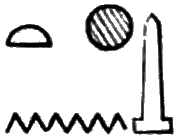 tekhen. This word occurs quite frequently in inscriptions, especially on
the obelisks themselves, where the "determinative"
tekhen. This word occurs quite frequently in inscriptions, especially on
the obelisks themselves, where the "determinative"  alone is given without the literal
complement, that is, the spelling.
alone is given without the literal
complement, that is, the spelling.
The pyramidion of the obelisk, on the other hand, was called benben by the Egyptians.
The prominent part played by it in the mysteries of sun-worship is attested by the inscription of
king Piankhi (about 700 B. C.), for in it is mentioned the 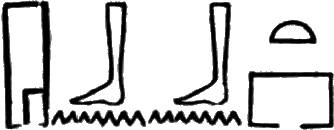 (ha-t benben-t), "the temple
of the pyramidion" in Heliopolis. The inscription tells us in this connection the following story:
"His majesty entered the temple of Rā and his divine sanctuary with profound veneration.
The first high-priest offered up a prayer to god in the star-chamber to ward off misfortune from
the king, placed on his brow the fillet, and purified him with frankincense and holy water.
Flowers of the temple of the pyramidion were brought to him and blossoms were given to him. He
ascended the stairs to the grand niche to see the god Rā in the temple of the pyramidion.
Such was done by the king himself. His {22}chieftains
stood apart, while he drew back the bolt, opened the door, and saw his father Rā in the
temple of the pyramidion resting in the Māād-boat of Rā and the Sektet-boat
of Tum. He then closed the doors and put on them clay and sealed them with the king's own
ring." The frequent mention of the pyramidion and the evident importance attached by the king
to his visit to this sanctuary plainly show that there was a deep signification lying hidden
beneath the strange upper part of the obelisk. In it the Rising Sun, Râ, and the Setting Sun, Tum,
find their mutual points of contact.
(ha-t benben-t), "the temple
of the pyramidion" in Heliopolis. The inscription tells us in this connection the following story:
"His majesty entered the temple of Rā and his divine sanctuary with profound veneration.
The first high-priest offered up a prayer to god in the star-chamber to ward off misfortune from
the king, placed on his brow the fillet, and purified him with frankincense and holy water.
Flowers of the temple of the pyramidion were brought to him and blossoms were given to him. He
ascended the stairs to the grand niche to see the god Rā in the temple of the pyramidion.
Such was done by the king himself. His {22}chieftains
stood apart, while he drew back the bolt, opened the door, and saw his father Rā in the
temple of the pyramidion resting in the Māād-boat of Rā and the Sektet-boat
of Tum. He then closed the doors and put on them clay and sealed them with the king's own
ring." The frequent mention of the pyramidion and the evident importance attached by the king
to his visit to this sanctuary plainly show that there was a deep signification lying hidden
beneath the strange upper part of the obelisk. In it the Rising Sun, Râ, and the Setting Sun, Tum,
find their mutual points of contact.
§3. The dimensions of the obelisks which have come down to us vary very much. By consulting the list on pages 9-11 it will be seen that at present the height ranges between 2 to 105 feet. As has already been mentioned, the largest obelisks date back to the time when Egypt entered upon, or was already in, its golden age, that having been the time when the Pharaohs could erect monuments worthy of their reign. Before that time, when they served as grave-stones, the obelisks were of a comparatively small size. Still we find some very large specimens under later dynasties, as for instance that of Psametik II. on the Monte Citorio in Rome, which is 71 feet high, while that of the Ptolemies in Philæ, which is only a fragment, measures 33 feet. The Romans also erected large monoliths, Domitian's obelisk on the Piazza Navona in Rome being 54 feet, and that of Hadrian on the Monte Pincio 30 feet high. Constantine the Great erected the large obelisk at Arles in France, measuring 56 feet, which may have possibly been taken out of a French quarry.
There must have been some fixed rule for determining the thickness of an obelisk when the length was given. According to a measurement of all the obelisks we may state, that the base was generally 1⁄9 to 1⁄11 of {23}the entire length. Thus the New York Obelisk is 7 ft. 9¼ in. by 7 ft. 8¼ in. at the base, which is about 1⁄9 of the entire length (69½ ft.). The obelisk of Hatasu is of a somewhat different proportion, the thickness at the base being only 1⁄13 of the total length. The obelisk with the thickest base is that which is still in the quarry at Assuan, the base measuring 11 ft. 1½ in. by 11 ft. 1½ in.
That monuments of such height and thickness weigh a great deal is self-evident. Our New York Obelisk would tip an adequate scale at the figure: 448,000 pounds. Eight of the extant obelisks, however, weigh still more, the heaviest being that of Assuan which, if it had ever been erected, would weigh 1,540,000 pounds, having for a second the Lateran Obelisk in Rome with 1,020,000 pounds.
§4. The material of which the obelisks are made is the granite of Syene. It was preferred by the Egyptians on account of its wonderful hardness, durability, lack of flaws (the so-called maladie de granite), and its reddish color. It is really the amphibole-granite, but is commonly called Syenite from the name of the place where it is found. Although flaws in it are of rare occurrence, they nevertheless sometimes appear in the obelisks. Whenever they were discovered after the block was detached from the native rock, they did not render the stone by any means worthless, as the Luxor Obelisk in Paris has proved. This had a crack in it at the base from the day of its erection in Thebes, which, when pinned by the Egyptians with a wooden plug at that early time, has not since then interfered in the least with the strength or stability of the obelisk.
The supply of this hard granite was and is still inexhaustible, being massed up in immense
mountains in various parts of Egypt. It is found in the eastern desert near Thebes. Egyptian
monuments also record the quarrying of stone at Hammamât, on the road to Kossêr. {24}It is, however, found best in the vicinity of the First
Cataract and, as the name "Syenite" indicates, especially at Syene (Assuan). This city, of some
importance under the Pharaohs, was called Syêné by the Romans, and 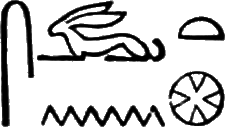 Sun-t by the Egyptians. It is situated opposite the island of Elephantine, called by the
Egyptians
Sun-t by the Egyptians. It is situated opposite the island of Elephantine, called by the
Egyptians 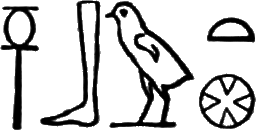 Âbu-t ("the ivory-city"), the most northerly island in the First
Cataract, forming the southern boundary of ancient and modern Egypt. Where the chisel and the
tools of the stone-cutters were kept in constant use, where men formerly battled with the stubborn
rock, and most of Egypt's monuments were cut and embellished—no sound now greets the
traveler. The place is deserted, itself a monument of an ancient people's diligence and
perseverance.
Âbu-t ("the ivory-city"), the most northerly island in the First
Cataract, forming the southern boundary of ancient and modern Egypt. Where the chisel and the
tools of the stone-cutters were kept in constant use, where men formerly battled with the stubborn
rock, and most of Egypt's monuments were cut and embellished—no sound now greets the
traveler. The place is deserted, itself a monument of an ancient people's diligence and
perseverance.
§5. The question as to the invention of that wonderful, simple, yet strange figure we call obelisk, can be answered without hesitation. The invention belongs wholly to the Egyptians. As has been pointed out before, the people of the IVth and Vth dynasties already made use of this form of monument. Perhaps its first appearance dates back even further, although no such old obelisks exist to warrant this assumption.
The next question to be answered is: to what use were the obelisks put? The ancient dynasties did not use them for ornament's sake, as the tomb would hardly be a suitable place for works of art that were to be admired. They originally served as memorial tablets and tomb-stones. Afterwards their surpassing beauty as monuments of art was perceived, and they were placed in pairs in front of the gates and pylons of the temples for ornament. They broke the monotony of the straight and peculiar Egyptian style of building, and by their apparently thin and column-like appearance set off to {25}advantage the massive and ponderous structures round about. A position in front of the temples was certainly the very best which could be assigned to them, and it can therefore be no matter of surprise, that the Pharaoh sought to commemorate his victories and virtues on such splendid tablets. We find the king in most cases use all the available space on the obelisk, and whenever he did not use all of it, another would be sure to add his own glorious name and deeds to those of some predecessor. We consequently find some obelisks that bear the inscriptions of as many as three different rulers; for instance, the Lateran, London, and New York Obelisks. These inscriptions would effectually serve the purpose of history, if they recorded events of vast political importance, but, unfortunately, of obelisk-inscriptions still extant, none are dated after the manner of other historical monuments.
The Romans immediately recognized the artistic merits of the obelisks, though they were perhaps more struck by their grandeur and elegance than anything else, and carried off many of them as trophies to sunny Italy. They adorned Rome with them, where, with all their rents and fractures, and after all the injury by the hand of man and havoc of the elements, the obelisks still baffle the ravages of time in the "City of the Seven Hills". As a "smart" people, however, the Romans tried to utilize them in some way: so they hit upon the idea to make them serve as sun-dials. Augustus experimented to this end with the obelisk now on the Monte Citorio in Rome, but, as he was not successful, this project was entirely abandoned.
The signification of the obelisk and the worship of the sun.
The most interesting point to be touched upon in our further investigation concerning obelisks is undoubtedly that with regard to their meaning and signification, or, in other words, what the mind of the Egyptian priest saw expressed under the figure of an obelisk. This leads us into the religion and mythology of a nation that had some very lofty conceptions of life, death, and eternity. The objects which called forth such thoughts were pre-eminently the obelisk and the pyramid, the former representing life in the sunshine of glory, the latter death in the darkness of passing night.
In the cosmogony of the Egyptians the Sun plays the most important part. Its birth is thus aptly described from the monuments by Prof. Dr. H. Brugsch: "In the beginning there was no heaven or earth. A boundless water, shrouded in dense darkness, made up the universe. This held in its bosom the male and female germs or beginnings of the future world. The divine primeval spirit, inseparable from the matter of the primitive water, felt a longing after creative power, and his word called into being the world, whose figure and variegated form had already manifested themselves to him. Its corporeal outlines and colors corresponded, in consequence of their derivation, to Truth, that is, to the exact intention of the divine spirit with reference to his future work. The {27}first act of creation consisted in the formation out of the primitive water of an egg, from which the light of day (Rā 'the sun') proceeded, which animated everything in the world. In this rising sun is embodied the almighty divinity in its grandest manifestation".
This new-born deity was destined to become greater than its parent, and to receive adoration in
all its many phases. The path of the sun was frequently compared to the life of a man from infancy
to old age. Hence the sun was called a boy in the morning, a youth in the midday,
and an old man in the evening (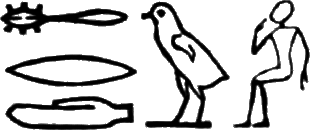 khrud "boy",
khrud "boy", 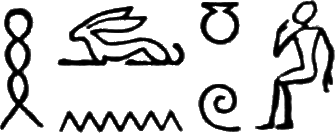 ḥunnu "youth",
ḥunnu "youth",  ȧau "old man"). The most common names of the sun, however, which constantly recur on
the innumerable Egyptian monuments are
ȧau "old man"). The most common names of the sun, however, which constantly recur on
the innumerable Egyptian monuments are 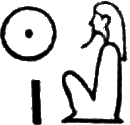 Rā and
Rā and 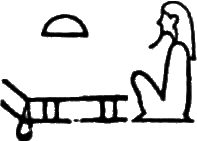 Tum, the former representing
the sun in all its glory in the morning and at noon, the latter the sun when it has completed
[tum] its course and leaves the earth in darkness. Thus the inscriptions frequently speak
of
Tum, the former representing
the sun in all its glory in the morning and at noon, the latter the sun when it has completed
[tum] its course and leaves the earth in darkness. Thus the inscriptions frequently speak
of  (Rā em ubenef) "Râ when he rises" [whence perhaps the royal title in the stelé of
Abusimbel:
(Rā em ubenef) "Râ when he rises" [whence perhaps the royal title in the stelé of
Abusimbel:  (uben) "the glorious rising sun"], and of
(uben) "the glorious rising sun"], and of  (Tum em ḥōtepef) "Tum when he sets".
(Tum em ḥōtepef) "Tum when he sets".
The obelisk was erected in honor of the sun in all its phases, both when rising and when
about to set. The pyramids, on the other hand, symbolizing the sun after it had set, were always
built in the region of darkness and death on the western bank of the Nile, and had only to do with
Tum, the setting sun. Here, in the domain {28}of Tum, the
bodies of the departed were to rest securely until the light of an eternal morning should wake
them again and endow them with the splendor of the rising sun, which also set in the west, entered
the lower regions and bowels of the earth or Hades (the Egyptian 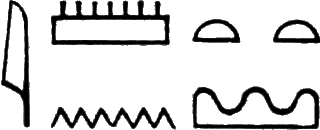 Ȧ-menti), and again victoriously left its dark dungeon to break forth in its usual
glory.
Ȧ-menti), and again victoriously left its dark dungeon to break forth in its usual
glory.
 |
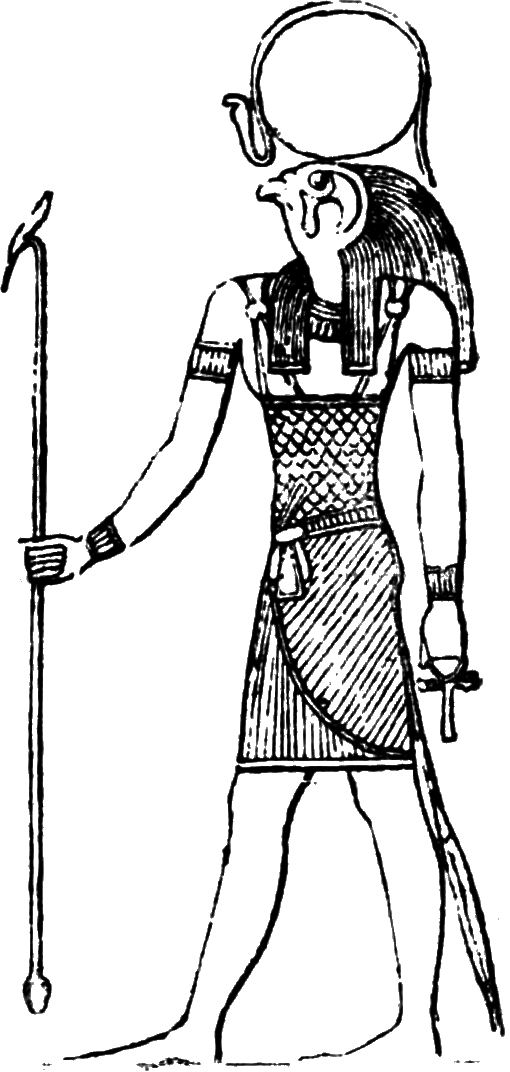 |
|
Kheper, the night-sun: winter solstice. |
Ra-Hor-Khuti, the morning-sun: vernal equinox. |
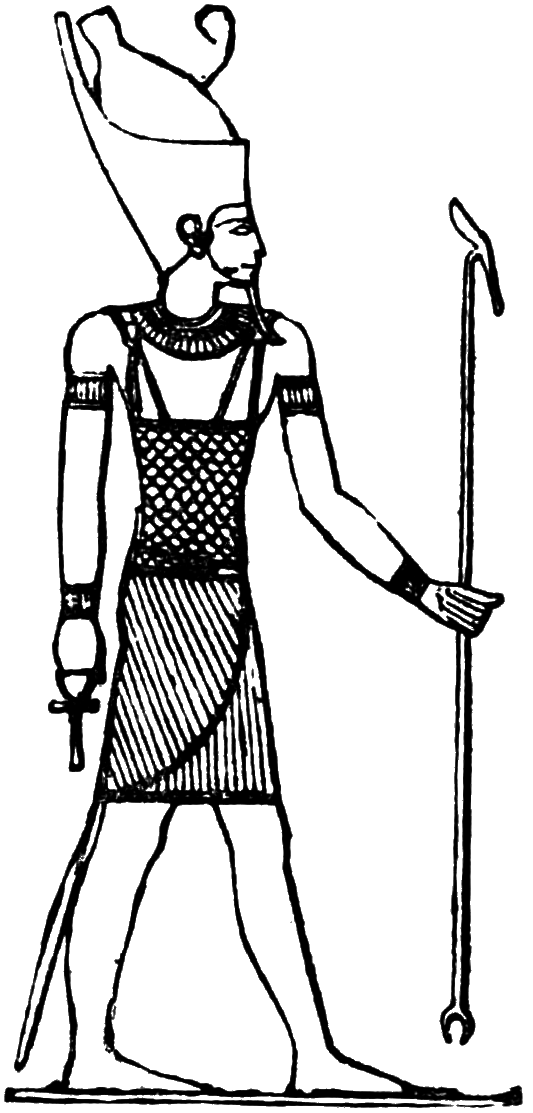 |
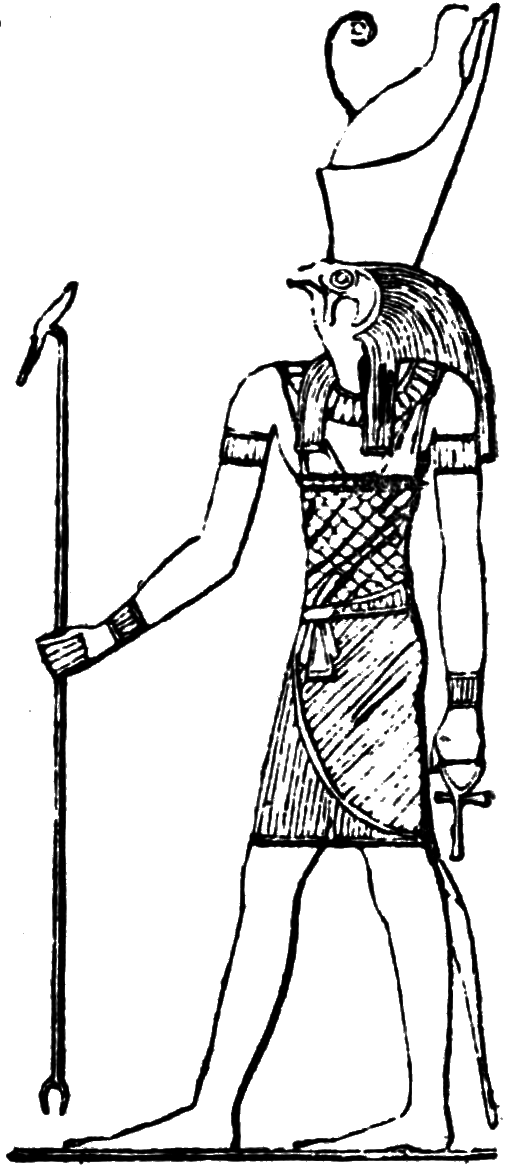 |
|
Tum, the evening-sun: autumnal equinox. |
Horus, the noon-sun: summer solstice. |
The various phases of the sun in its passage over the heavens are even represented by pictures on the monuments. The sun of morning is pictured as a hawk-faced deity (Horus) crowned with the snake-encircled disk of the sun, called Rā-Hor-Khuti; {29}the sun of noon as the same deity wearing the double crown of Egypt, called Hor or Hor-Khuti; the sun of evening as a human-faced deity with the double crown of Egypt, called Tum or Atum; and the invisible sun of night as a human-faced deity with the sacred scarab above it, called Kheper or Ptah-Sokar-Osiris. These four deities also represented the beginning of the four seasons of the year: the vernal equinox, the summer solstice, the autumnal equinox, and the winter solstice. Some other names and forms under which the sun was worshiped are, besides the above, Amen-Rā (in Thebes), Sebek-Rā (in Ombos), and Khnum-Rā (in Elephantine).
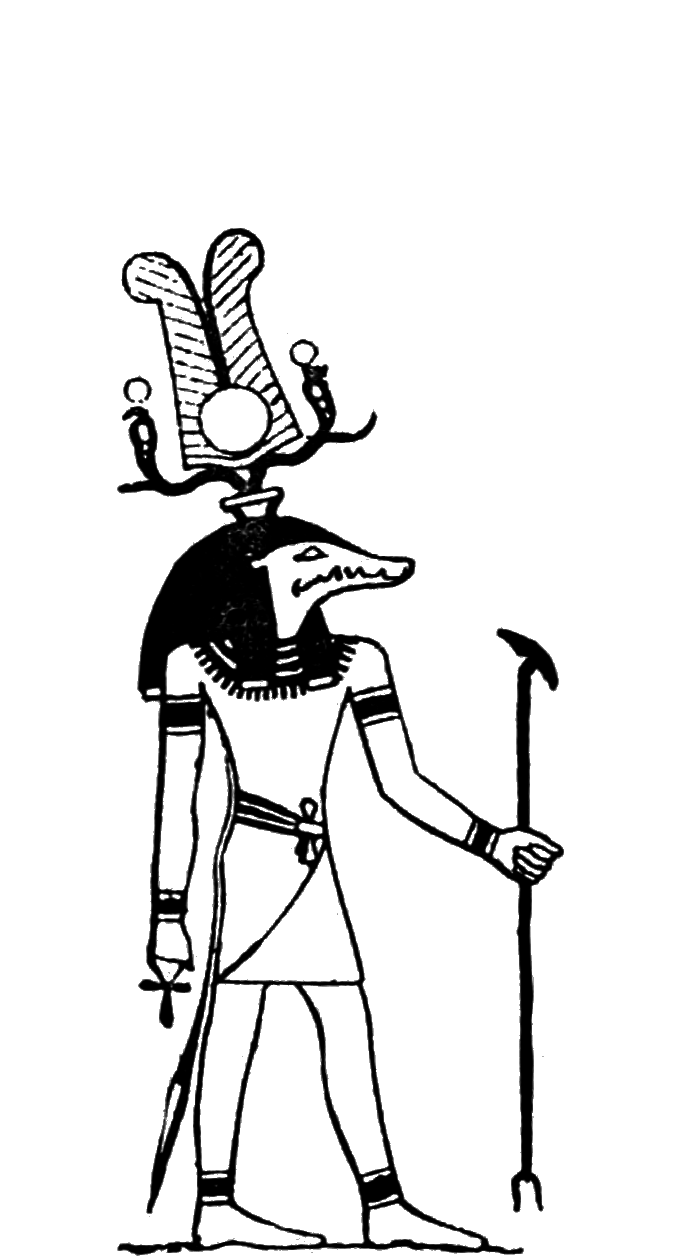 |
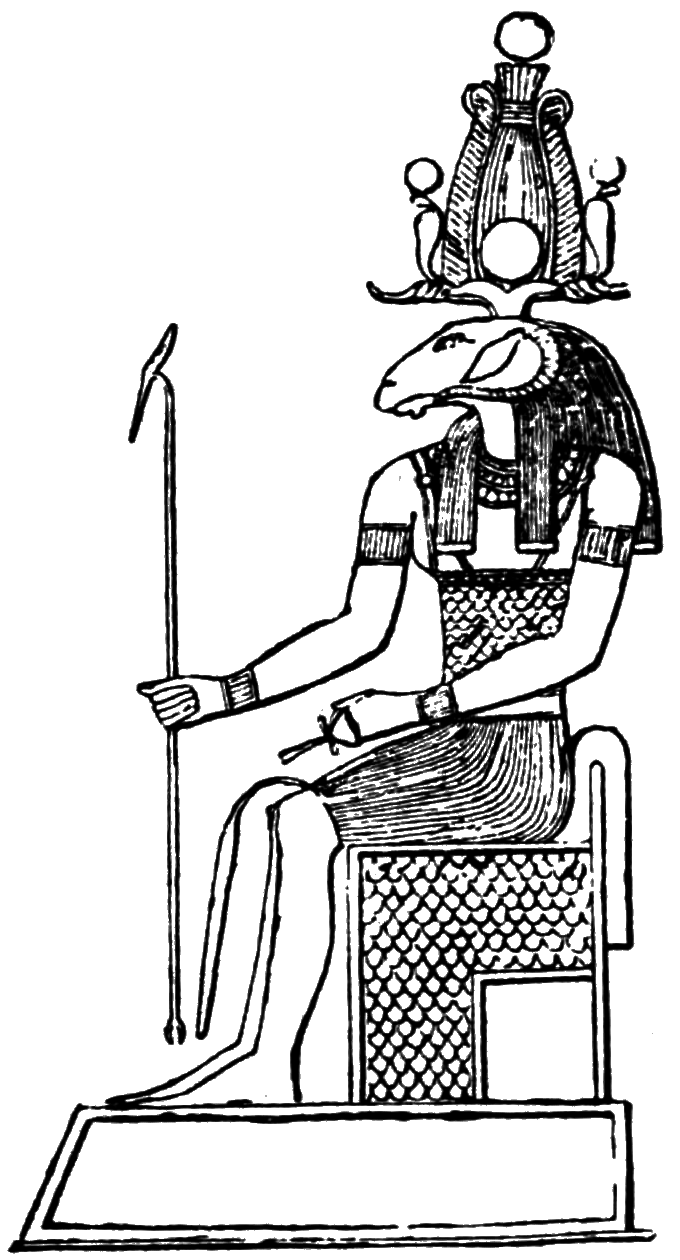 |
|
Sebek-Ra. |
Khnum-Ra. |
All this proves the vast and supreme importance attached to the sun by the ancient Egyptians.
But why should they have selected the sun as their principal deity? All the pictures, in which the
sun or the sun-god is represented, give us the answer. On them it will be noticed that each deity
holds in one of its hands the sign  (ānkh) meaning "life", and in a tomb at
Tel-el-Amarna we find the sun represented with rays terminating in human hands and touching the
lips of Amenophis IV. and his wife with the sign
(ānkh) meaning "life", and in a tomb at
Tel-el-Amarna we find the sun represented with rays terminating in human hands and touching the
lips of Amenophis IV. and his wife with the sign  . As all nature receives its life
from the light of the sun, so all human beings obtain their life and their subsistence from the
same source. Therefore Pharaoh and his people would {30}turn to the heavenly orb each day with prayer and adoration, asking of it
the blessing and gift of life here on earth, and the life to come in Amenti or Hades. The sun is
to them the giver of life, strength, health, existence, and all happiness. It is for this reason,
that the finest productions of the Egyptian scribes are the grand hymns addressed to the sun, the
tutelary god of Egypt.
. As all nature receives its life
from the light of the sun, so all human beings obtain their life and their subsistence from the
same source. Therefore Pharaoh and his people would {30}turn to the heavenly orb each day with prayer and adoration, asking of it
the blessing and gift of life here on earth, and the life to come in Amenti or Hades. The sun is
to them the giver of life, strength, health, existence, and all happiness. It is for this reason,
that the finest productions of the Egyptian scribes are the grand hymns addressed to the sun, the
tutelary god of Egypt.
Having called attention to the belief of the ancient Egyptians in the sun as their guiding and
illuminating deity, it will now be necessary to consider the place the obelisk occupies with
regard to it. The first thing that greets our eyes on most obelisks is the figure of a bird on the
top of each column of hieroglyphs. This represents the god Horus in the form of a sparrow-hawk ( ), and
gives him the usual insignia, namely the crown of Upper and Lower Egypt; thus,
), and
gives him the usual insignia, namely the crown of Upper and Lower Egypt; thus,  .
Horus was a form or hypostasis of Râ, the sun, in his midday power, and is often found in the
mysterious combination as Hor-Râ
.
Horus was a form or hypostasis of Râ, the sun, in his midday power, and is often found in the
mysterious combination as Hor-Râ 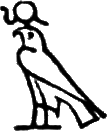 and Râ-Hor-Khuti
and Râ-Hor-Khuti 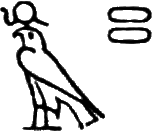 or Hor-em-khuti
or Hor-em-khuti 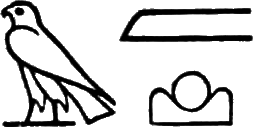 .
.
Why did the Egyptians choose the hawk as the {31}embodiment of their highest god? Perhaps on account of the lofty flight of
the bird, or else because of its keen vision. In the "victory-stelé" of Thothmes III. the deity
says to the king: 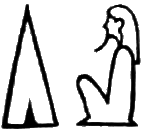
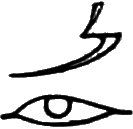
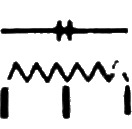
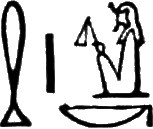
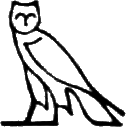
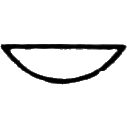
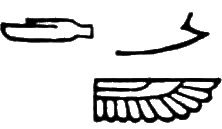
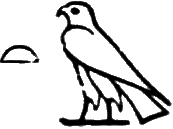
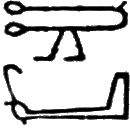
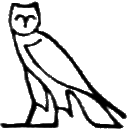
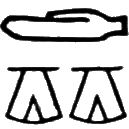
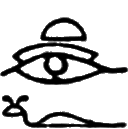

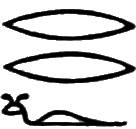 [Pronounced: du·ȧ ma sen
hen·k em neb dema·t thet em degag·t·f er merer·f] "I let them behold your majesty like the lord
of flight (hawk), grasping with his glance whatever he desires", thus combining in one
verse the two explanations given above. The grandest sanctuary in which Horus was worshiped was in
Edfu, where he was called
[Pronounced: du·ȧ ma sen
hen·k em neb dema·t thet em degag·t·f er merer·f] "I let them behold your majesty like the lord
of flight (hawk), grasping with his glance whatever he desires", thus combining in one
verse the two explanations given above. The grandest sanctuary in which Horus was worshiped was in
Edfu, where he was called 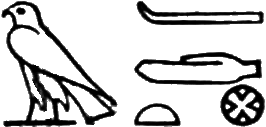 Hor-Hud·t. Horus and Râ were generally united into one
deity and then represented as a hawk-faced man with the disk of the sun on his head (
Hor-Hud·t. Horus and Râ were generally united into one
deity and then represented as a hawk-faced man with the disk of the sun on his head ( ). In
order to proclaim this deity a ruler over the earth as well as the heavens, the picture of the
hawk frequently has the double crown of Egypt (
). In
order to proclaim this deity a ruler over the earth as well as the heavens, the picture of the
hawk frequently has the double crown of Egypt ( being the white crown—
being the white crown— hez—of Upper Egypt and the red crown—
hez—of Upper Egypt and the red crown— desher—of Lower Egypt)
added to it (
desher—of Lower Egypt)
added to it ( ), to signify that Horus is the lord of the universe.
), to signify that Horus is the lord of the universe.
In common with the belief of all the ancient nations, the king was considered by the Egyptians
not only as a mortal but also, by reason of his exalted rank, as a god on earth. He was the
essence of the divinity and styled himself "the offspring of the gods" (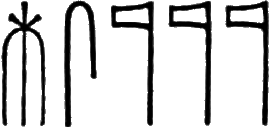 mes nuter·u) or more in particular "Râ's son" or "son of the sun" (
mes nuter·u) or more in particular "Râ's son" or "son of the sun" (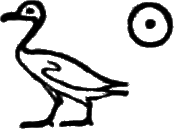 sa
Rā). Being or pretending to be the sun's son, he demanded and received the homage of
his subjects as a {32}god. His person was inviolable, his
command was absolute, his power was unlimited. His first act each day was to offer up sacrifice
and prayer to his father, the sun, and impress this worship on his subjects.
sa
Rā). Being or pretending to be the sun's son, he demanded and received the homage of
his subjects as a {32}god. His person was inviolable, his
command was absolute, his power was unlimited. His first act each day was to offer up sacrifice
and prayer to his father, the sun, and impress this worship on his subjects.
The obelisk which was erected in honor of the sun could therefore also be used by the sun's offspring, the king, to promulgate his own worship. Inscriptions commemorating both the deity in heaven and his deputy on earth continually blend the two, the god and the king, together into one person, that we can easily find in the obelisk traces of a decided king-worship. If the enlightened age of an Alexander the Great or a Divus ("divine") Cæsar Augustus could tolerate such a thing, why should we feign surprise when we find the same thing to have happened some thousand years before their time in Egypt? It is just this one fact, the barefaced king-worship represented by the obelisk, that gives its translation such a repulsive sound to modern ears. No wonder that otherwise well-read and intelligent men turn about in amazement and ask: Can this really be the correct translation of the obelisk, why, this would turn those ancient kings of glorious renown into mere "vainglorious fools"? This conclusion is perfectly true, and consequently it is to be regretted that just such monuments as obelisks, which are a great source of attraction for the multitude, should display the poorest inscriptions that we meet with in the entire Egyptian literature. Under no circumstances must we base our estimate of the Egyptian literature on the inscriptions of the obelisks; for, on looking over the writings of this wonderful people, we would not only find ourselves most agreeably surprised, but would be constrained to admit that there is no ancient people which can boast of an equally grand and sublime literature as the Egyptian.

A portion of the "Book of the Dead" (Chap. I.). Two obelisks represented on a mummy-cloth. From the author's collection.
Summing up, we find the obelisks erected in honor of the sun-god by his son, the king, and used by him to further his own ambitious designs, glorify his own name, and turn the worship of his subjects both to himself and his sire above.
Note. Besides the frequent mention of the obelisk in the countless Egyptian inscriptions on stone, wood, leather, and papyrus, dating back to the earliest dynasties, we find the picture of two obelisks in many copies of the sacred writings of the Egyptians, the so-called "Book of the Dead" or the Egyptian Ritual. It forms part of the vignette of the first division of this book (1-15 chap.), which has mostly to do with hymns, prayers, and incantations addressed to the sun-god. No mention is made of the obelisk in the text of the Ritual. On the preceding page will be found the picture of the two obelisks on a piece of mummy-cloth in the possession of the author. The Hieratic words below the vignette form a portion of the first chapter of the Ritual.
The history of the new york obelisk, and its removal from alexandria.
§1. The obelisk in Central Park antedates our Christian era by more than fifteen centuries. The central columns of the four sides, being the first that were inscribed, record as the author of this monument, Thothmes III., called the Great, the greatest sovereign of that period (about 1600 B. C.). A warrior of wonderful prowess and a ruler of the highest intelligence, he put aside at an early date the leading-strings of his famous sister and co-regent, Hatasu, surnamed Makarâ, and constituted himself sole regent and law-giver. He heads the list of the kings of the xviiith dynasty. From the beginning to the end of his reign the inscriptions record his victories over foreign nations. He claims it as his order from the god Amen to extend the boundaries of Egypt. He subdues the prince of Kadesh in Upper {36}Palestine at Megiddo, and overpowers the Kharu [Syrian] and Kheta [Hittite] tribes. The Rotennu [Syrians of Mesopotamia] are conquered, Damascus falls, and Carkhemish is taken. He reaches Nineveh, the Tigris, and the Orontes, and is everywhere victorious. He claims as his own and in vassalage all of the then known world. It is he whom Pliny calls Mesphres, and of whom he says that he erected a pair of obelisks, commemorating his valiant deeds. These obelisks are at present in London and New York.

Cartouche of Thothmes III. "The king of Upper and Lower Egypt, Men-Kheper-Ra, the son of Ra, Thoth-Meses".
The exact time of the erection of these two obelisks cannot be determined, as they bear no
date, but it must have been in the earlier part of the reign of Thothmes III., which extended from
1591 to 1565 B. C. (according to Lepsius). He ordered them at the quarry in Syene and erected them
in front of the temple of the sun in Heliopolis or the Egyptian 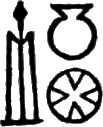 , Ȧn. The site of this
once prosperous city is now at the village of Matarîyeh near Cairo, which has no antiquities to
boast of, except one erect obelisk of Usertesen I., the only vestige of the famous "City of the
Sun". Here the obelisks stood for many centuries amid wonderful surroundings, guarding as it were
the entrance to the sanctuary of the deity, to whom they were sacred.
, Ȧn. The site of this
once prosperous city is now at the village of Matarîyeh near Cairo, which has no antiquities to
boast of, except one erect obelisk of Usertesen I., the only vestige of the famous "City of the
Sun". Here the obelisks stood for many centuries amid wonderful surroundings, guarding as it were
the entrance to the sanctuary of the deity, to whom they were sacred.

Cartouche of Ramses II. "The king of Upper and Lower Egypt, User-Ma-Ra-Sotep-en-Ra, the son of Ra, Amen-Mer-Ra-Meses-Su."
They were not allowed to remain intact for a very long time, for a century is an insignificant matter when we deal with Egyptian history. Almost three centuries had passed, when a new conqueror arose, who was emulous of his great predecessor's deeds, and who envied him his renown. This was Ramses II., surnamed "the Great", {37}the "Pharaoh of the Oppression", who reigned from 1388 to 1322 B. C. (according to Lepsius). Not only in his monuments but also in his deeds he carries off equal honors with Thothmes the Great. We find the wars of former days fought over again, and always successfully, and we see his exploits recorded not only on impassive monuments of stone but also in the writings on fragile papyrus. A second Iliad by the poet Pentaûr recalls some wonderful hymns addressed amid the din of battle to his guardian deities, in particular to Amen-Râ, and gives us such a vivid picture of war as to surpass in many respects even old Homer. Ramses' most stubborn opponents were the Kheta (Hittites) with whom he negotiated a most favorable treaty after many years of war. But with all his good qualities he had one great fault, vainglory. Not satisfied with erecting obelisks, stelé, and temples with his name inscribed on them in large letters, and seeing {38}his works recorded over all the known world, he even appropriated the monuments of his predecessors and, though not guilty of erasing their names and substituting his own instead, as Thothmes III. had done on his sister's obelisk and monuments, yet he crowded his name and the story of his deeds within all the available space left uninscribed on these monuments. He had the two outside columns on each side of our obelisk inscribed, leaving to Thothmes III. besides the pyramidion only about one third of the obelisk's surface. This, of course, gave him an advantage over his predecessors, and he thereby saved the large expense and the time that would have been required for quarrying and erecting monuments of his own. He died at an advanced age after having ruled over Egypt for 67 years. His mummy, discovered in 1881, now rests in the Museum of Bulak at Cairo.

Cartouche of Osarkon I. "The king of Upper and Lower Egypt, Kherp-Kheper-Ra-Sotep-en-Ra, the son of Ra, Amen-Mer-Usarken."

Cartouche of the emperor Augustus Cæsar. "The divine lord of the world, Autokrator, the son of Ra, lord of the diadems, Cæsar-Ankh-Zeta-Ptah-Ast-Mer."
The four sides of the obelisk were now filled, and it would appear impossible for another king to have used any other part of it for his own purpose. Such is, however, not the case. Osarkon I. had chiseled into the stone at the very edges of each side in diminutive characters his own name. He was a Pharaoh of the xxiid dynasty, who lived about 960 B. C., and represents the decline of the ancient Egyptian empire.
Of the history of our obelisk since that time very little would be known except for the inscriptions found on the brass crabs at the base. From them we learn that the obelisk was taken away from its position in front of the temple of Heliopolis in the XVIIIth year of the reign of {39}Augustus Cæsar (12 B. C.) by Pontius during the prefecture of Barbarus. It was then transported to Alexandria and placed in front of the Cæsareum, the temple of the Cæsars, with the obelisk at present in London. During the transportation a large portion of the edges at the base was very badly damaged. Four large bronze crabs were then placed under the obelisk to keep it from falling over. Since this time of their erection in Alexandria tradition has associated one of them, the New York Obelisk, with the name of the monster-queen Cleopatra VI. She had, however, nothing {40}whatever to do with the removal of the obelisks as she and all her predecessors of the same name had been dead long before these were erected in Alexandria. Here both remained for many centuries until one—the present London Obelisk—fell prostrate and was left to lie half-hidden in the ground. It was subsequently taken in 1877 to England, while the other obelisk remained standing in Alexandria until 1880, when it was lowered into the steamer Dessoug, brought over to our country, and presented to New York City through the munificence of the late Mr. William H. Vanderbilt.
§2.[1] At the time of the opening of the Suez Canal in 1869 the Khedive Ishmaël first suggested the removal of {41}the standing obelisk at Alexandria to the United States. This suggestion was soon spread abroad and it was estimated that for $60,000 the obelisk could be removed. As the late Mr. William H. Vanderbilt had agreed to furnish this sum, negotiations were opened with the Egyptian government in 1877 for the definite gift of the obelisk. These proved successful. Bids were then requested for its removal and the bid of the late Commander Henry H. Gorringe, U. S. N., was accepted. Mr. Gorringe went to work immediately but clearly saw that he would not be able to proceed in the same manner as others had done before him in the removal of the Luxor Obelisk to Paris or the Alexandrian to London. These were taken in tow and in this manner reached their destination. This plan could not be adopted for bringing the obelisk across the ocean. When the work of transporting the obelisk to the harbor of Alexandria was accomplished, the steamer Dessoug was purchased from the Egyptian government and in it the obelisk was carried to New York.
As soon as the news of the presentation by the Egyptian government of Cleopatra's Needle to the United States reached the ears of the foreign residents of Alexandria, a most disgraceful agitation was begun against Commander Gorringe. Everything was tried and done to embarrass him in his work, and all sorts of obstacles were put in his way. But the man at the head of the undertaking could not be intimidated. On October 27, 1879 work was begun by the removal of the earth that had accumulated around the base of the obelisk. The latter was next incased to protect its many inscriptions, and on December 6th of the same year everything was ready for turning the great monolith. This was successfully effected. Another difficulty now presented itself, how to get the obelisk to the harbor, this being on the other side of the city. The foreign residents had forbidden the use of the paved streets, by which route the obelisk would have been easily transported, and Commander Gorringe was now obliged to undertake the difficult task of bringing the obelisk around the whole city over the shallow water and the sandbanks. This he accomplished by means of a caisson. However, an unobstructed channel through the water to the dry-dock was first necessary. Divers were hired until March 1880 and employed in removing about 170 tons of granite, being the débris of former Alexandrian monumental structures. While the obelisk was being lowered the spite of the European residents was again painfully felt. Nevertheless, although with vastly increased expenses, Commander Gorringe here succeeded in his work. By this enforced method of transportation he incurred an extra expense of $21,000. When the Egyptian steamer Dessoug had been purchased and, after many delays, brought into the dry-dock, an aperture was made in its side, large enough to admit of the incased obelisk being pushed into the hold of the vessel. The side was then closed, the steamer was ready for its voyage, and the tedious work of the brave and indefatigable Commander was at an end as far as Egypt was concerned. On June 1, 1880 the vessel steamed out of the harbor with the Stars and Stripes floating in the breeze, carrying the obelisk, the pedestal, and the stones for the foundation.
On July 19, 1880 the Dessoug arrived in New York. The site where the obelisk was to stand, namely Graywacke Knoll opposite the Metropolitan Museum of Art in Central Park, had already been selected. The foundation was completed on October 10. The large square pedestal was carted from the North River and 51st St. to the Park, and then pushed on greased planks to the place of erection. The disembarking of the obelisk, however, presented many difficulties, the most humiliating {44}being the greed of certain rich men, who refused to place their dry-docks at the disposal of the Commander for a high price which he offered, and compelled him to try Lawler's Marine Railway on Staten Island. His experiment with this was quite successfully carried out on August 21, 1880. On September 14th the obelisk was once more afloat on pontoons. On September 16th the steamer Manhattan towed the pontoons with the obelisk to the North River and 96th St. Then the land-journey began. The obelisk passed as far as the West Boulevard, down to 86th St., then through the Transverse Road No. 3 in Central Park, issued from the Park at Fifth Avenue and 85th St., and was then taken down to 82d St. Here a trestle-work was built up to Graywacke Knoll, the final resting-place of the obelisk. On December 22, 1880 the point of the obelisk was turned up this trestle-work, and on January 22, 1881 everything was ready for placing it in position on the pedestal. The crabs had been recast in the Brooklyn Navy Yard and perfectly fitted to the uneven base of the obelisk. The latter easily swung and revolved on the turning-structure, and at noon of the same day it stood in the identical position as at Alexandria. On February 22, 1881 the obelisk was formally presented in behalf of the Khedive of Egypt, through the liberality of Mr. William H. Vanderbilt, to the city of New York.
The total cost of the removal of the obelisk was: for material and labor $86,603 and for incidental expenses $15,973, a sum total of $102,576. Mr. W. H. Vanderbilt paid the whole amount out of his own purse. The Congress of the United States took due notice of the wonderful feat of procuring for our country such a grand specimen of Egyptian monuments, and fitting resolutions were passed by both the Senate and the House of Representatives. And certainly a sincere vote of thanks {45}will be given for his munificent gift to our late illustrious fellow citizen, William H. Vanderbilt, by everyone having at heart the honor and advancement of our city and country.
The inscriptions of the new york obelisk.
I. Inscriptions of Thothmes III.
The inscriptions of Thothmes III. comprise the four sides of the pyramidion and the central columns of the four faces of the obelisk.
The Pyramidion.
The pictures of the four sides of the pyramidion here given are reproduced from the
squeezes taken under the direction of Mr. Gorringe as published in his "Egyptian Obelisks". They
are, however, given in their correct form, as the squeezes seem to have been taken by an
inexperienced hand and a person unacquainted with Egyptological subjects. The figures seated in
the squares are the gods Râ-Hor-Khuti and Tum, representing the rising and the setting sun. The
former is the hawk-faced god seated on a throne, holding in his right hand the staff of power  (us "power"), and handing it to the king with the usual sign
(us "power"), and handing it to the king with the usual sign  (ânkh "life"). Besides this the disk of the sun
(ânkh "life"). Besides this the disk of the sun  (râ "sun") reclines
on his head. The god Tum, on the other hand, is represented in his human form, bearded and wearing
a king's head-dress
(râ "sun") reclines
on his head. The god Tum, on the other hand, is represented in his human form, bearded and wearing
a king's head-dress  , and holding in his hands the identical symbols of
, and holding in his hands the identical symbols of  "life" and
"life" and  "power". In front of the gods we find in each case the king represented
as an androsphinx (
"power". In front of the gods we find in each case the king represented
as an androsphinx ( ) in the act of offering libation to the divinity. It must be noted that this
kind of sphinx being human-faced and bearded, is always the representation of Pharaoh as the
essence of the godhead.
) in the act of offering libation to the divinity. It must be noted that this
kind of sphinx being human-faced and bearded, is always the representation of Pharaoh as the
essence of the godhead.
East Face of the Pyramidion.
The three vertical columns to the left above and the two below the sphinx refer to the sphinx-king, the remainder to the god Râ-Ḥor-khuti (i. e. "the sun, Horus in the horizon") and the libation in the hands of the sphinx.
The three columns above the sphinx are:
 |
 |
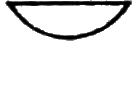 |
 |
 |
 |
 |
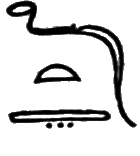 |
| nuter | nefer | neb | taui | Men-kheper-Râ | du | ânkh | zeta |
| The god · good · lord (of · the) two countries · Thothmes III. · giving · life · forever. | |||||||
 |
 |
 |
 |
 |
| nuter | nefer | neb | taui | Men-kheper-Râ |
| The god · good · lord (of · the) two countries · Thothmes III. · | ||||
 |
 |
 |
| du | ânkh | zeta |
| giving · life · forever. | ||
i. e. This is Thothmes III., the gracious god, the lord of the two countries [Egypt], who gives eternal life.
Below the sphinx we read:
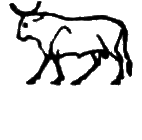 |
 |
 |
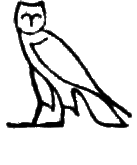 |
 |
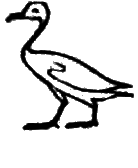 |
 |
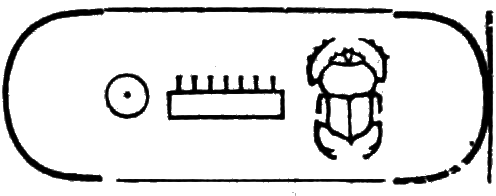 |
| qa | nekht | khâ | em | Us | sa | Râ | Men-kheper-Râ |
| The bull · powerful · glorious · in · Thebes · son (of) · Râ · Thothmes III. | |||||||
i. e. This is the powerful and glorious bull [king] in Thebes, the Sun's offspring, Thothmes III.
The term  neb taui "lord of the two countries" is the usual title of Pharaoh. The
two countries referred to are Upper and Lower Egypt, which are still and have been from time
immemorial the two provinces of Egypt. The word seems, however, to imply still more. In the
pompous wording of the Pharaonic monuments it expresses the grand title of the Roman emperors:
lord of the Universe.—The
neb taui "lord of the two countries" is the usual title of Pharaoh. The
two countries referred to are Upper and Lower Egypt, which are still and have been from time
immemorial the two provinces of Egypt. The word seems, however, to imply still more. In the
pompous wording of the Pharaonic monuments it expresses the grand title of the Roman emperors:
lord of the Universe.—The  du ânkh zeta "who gives eternal life" calls
attention to the king's power over the life and death of all his subjects. As he himself received
life from the gods, so he bestowed it on his people at pleasure.—
du ânkh zeta "who gives eternal life" calls
attention to the king's power over the life and death of all his subjects. As he himself received
life from the gods, so he bestowed it on his people at pleasure.— qa
nekht "the powerful bull" is a truly Oriental expression for "the mighty hero", the bull being
a symbol of strength and power. The same king is addressed by the deity in his victory-stelé,
already alluded to on page 31, in the following words:
qa
nekht "the powerful bull" is a truly Oriental expression for "the mighty hero", the bull being
a symbol of strength and power. The same king is addressed by the deity in his victory-stelé,
already alluded to on page 31, in the following words: 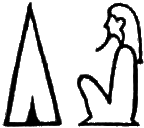
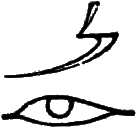
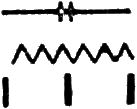
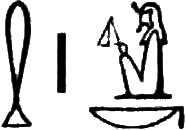
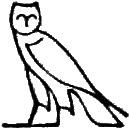
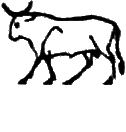
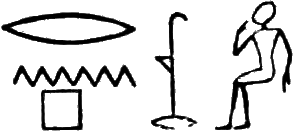



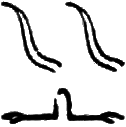
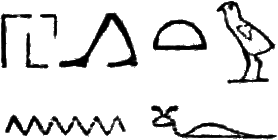 du·ȧ ma sen hen·k em qa
renp men ȧb sput âbui nen han·tu·f "I let them behold your majesty like a young and
stout-hearted bull whetting his horns; none can escape him."—
du·ȧ ma sen hen·k em qa
renp men ȧb sput âbui nen han·tu·f "I let them behold your majesty like a young and
stout-hearted bull whetting his horns; none can escape him."— Us "Thebes" was the capital of Upper Egypt and the seat of government at that
time.—
Us "Thebes" was the capital of Upper Egypt and the seat of government at that
time.— sa Râ "the son of Râ" is the usual title of Pharaoh which has already
been explained on page 31.
sa Râ "the son of Râ" is the usual title of Pharaoh which has already
been explained on page 31.
The four columns to the right above the god bear the following legend:
 |
 |
 |
 |
 |
 |
 |
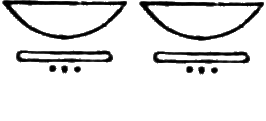 |
| du | ânkh· | f | neb | Râ-Ḥor-khuti | nuter | â | neb taui (neb ta neb ta) |
| giving · life · him · all · Râ-Hor-Khuti · the god · great · lord (of the) two countries. | |||||||
 |
 |
 |
 |
 |
| du | ânkh· | f | neb | Râ-Ḥor-khuti |
| giving · life · him · all · Râ-Hor-Khuti | ||||
 |
 |
 |
| nuter | â | neb taui (neb ta neb ta) |
| the god · great · lord (of the) two countries. | ||
i. e. This is Rā-Hor-Khuti, the great god, the lord of the two countries [Egypt], who gives him [the king] all life.
Between the god and the sphinx-king we read these words referring to the libation brought by the king:
 |
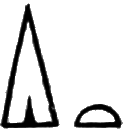 |
 |
| er | du·t | ȧrp |
| for · a gift · wine. | ||
i. e. As a gift (the king brings an offering of) wine.
 Râ-Ḥor-khuti "the sun, the hawk of the horizon" is the name
of the sun-god when in his full power at noon (see page 30).—The names
of all kings are always written in oval rings called cartouches, to distinguish them more
readily from other words and names in the inscriptions. The usual "divine" title of Thothmes III.
is
Râ-Ḥor-khuti "the sun, the hawk of the horizon" is the name
of the sun-god when in his full power at noon (see page 30).—The names
of all kings are always written in oval rings called cartouches, to distinguish them more
readily from other words and names in the inscriptions. The usual "divine" title of Thothmes III.
is 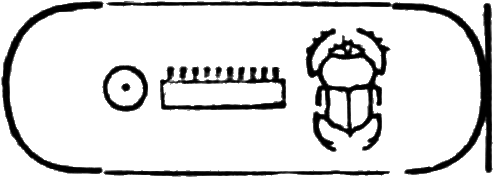 Men-kheper-Râ (the first sign being read last), which means "the stable and
creative sun". His family name, in its simplest form, is
Men-kheper-Râ (the first sign being read last), which means "the stable and
creative sun". His family name, in its simplest form, is 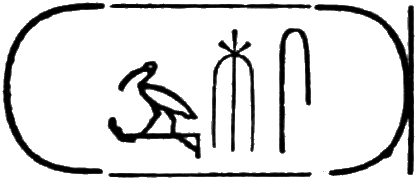 Deḥuti-meses
"child of Thoth". There are as many as 12 variants (or different readings) of this
cartouche, prominent and somewhat odd among them being the following:
Deḥuti-meses
"child of Thoth". There are as many as 12 variants (or different readings) of this
cartouche, prominent and somewhat odd among them being the following:
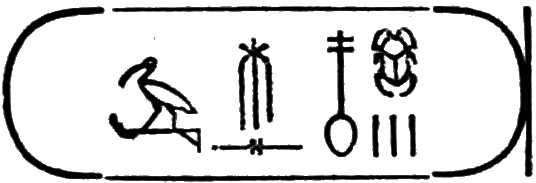 |
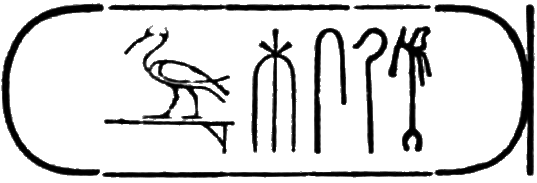 |
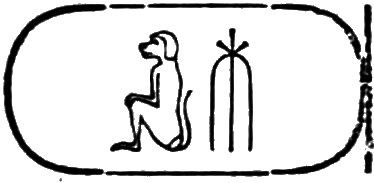 |
| Deḥuti-meses-nefer-kheperu | Deḥuti-meses-ḥeq-Us | Deḥuti-mes |
| Thoth's child, of beautiful form. | Thoth's child, lord of Thebes. | Thoth's child. |
 |
 |
| Deḥuti-meses-nefer-kheperu | Deḥuti-meses-ḥeq-Us |
| Thoth's child, of beautiful form. | Thoth's child, lord of Thebes. |
 |
| Deḥuti-mes |
| Thoth's child. |
The most singular cartouche of Thothmes III., however, is found on our New York Obelisk on the East Face and central column (see page 56).
South Pace of the Pyramidion.
The three columns above to the left refer to the sphinx-king and are identical with those of
the East pyramidion (page 47): 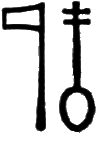
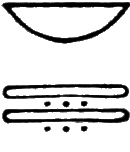

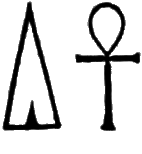
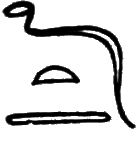 nuter nefer neb taui
Men-kheper-Râ du ânkh zeta "This is Thothmes III., the gracious god, the lord of the two
countries [Egypt], who gives eternal life".
nuter nefer neb taui
Men-kheper-Râ du ânkh zeta "This is Thothmes III., the gracious god, the lord of the two
countries [Egypt], who gives eternal life".
The hieroglyphs below the sphinx-king are totally destroyed, but must have been the same as
those on the East pyramidion (page 48): 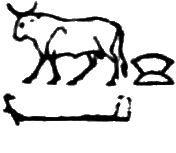
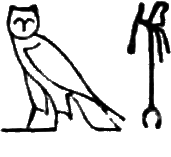

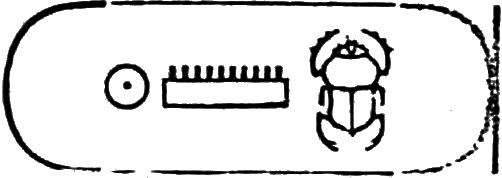 qa nekht khâ em Us sa Râ Men-kheper-Râ "This is
the powerful and glorious bull [king] in Thebes, the Sun's offspring, Thothmes
III".
qa nekht khâ em Us sa Râ Men-kheper-Râ "This is
the powerful and glorious bull [king] in Thebes, the Sun's offspring, Thothmes
III".
The four columns above to the right refer to the god Tum, the setting sun, seated on a throne beneath. The inscription is:
 |
 |
 |
 |
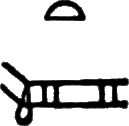 |
 |
 |
 |
 |
 |
 |
 |
 |
| du | ânkh· | f | neb | Tum | neb | taui | ḥeq | Ȧn | nuter | â | neb | ḥa·t |
| Giving · life · him · all · Tum · lord (of · the) two countries · prince (of) · Heliopolis · the god · great · lord (of · the) temple. | ||||||||||||
 |
 |
 |
 |
 |
 |
 |
 |
 |
| du | ânkh· | f | neb | Tum | neb | taui | ḥeq | Ȧn |
| Giving · life · him · all · Tum · lord (of · the) two countries · prince (of) · Heliopolis · | ||||||||
 |
 |
 |
 |
| nuter | â | neb | ḥa·t |
| the god · great · lord (of · the) temple. | |||
i. e. This is Tum, the lord of the two countries [Egypt], the prince of Heliopolis, the great god, the lord of his temple, who gives him [the king] all life.
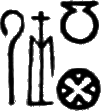 ḥeq Ȧn "the prince of Heliopolis" signifies as much as "the tutelary
divinity of Heliopolis". This famous city was the capital of the XIIIth nome or province of Lower (Northern) Egypt bearing the same
name. The name it received from the Greeks and Romans means "City of the Sun".—
ḥeq Ȧn "the prince of Heliopolis" signifies as much as "the tutelary
divinity of Heliopolis". This famous city was the capital of the XIIIth nome or province of Lower (Northern) Egypt bearing the same
name. The name it received from the Greeks and Romans means "City of the Sun".— Tum "Tum" was the god of the setting sun. The word is derived from the Egyptian verb
Tum "Tum" was the god of the setting sun. The word is derived from the Egyptian verb
 tum "to close, finish", and when referring to the sun "to set" (cf. page 27). A fuller form of the name is Atum.—
tum "to close, finish", and when referring to the sun "to set" (cf. page 27). A fuller form of the name is Atum.— ânkh neb literally "all
life" is a very concise expression for "all manner of life" and embraces every visible
act of life, such as breath, animation, motion, thought, speech, pleasure, &c. The hieroglyph
ânkh neb literally "all
life" is a very concise expression for "all manner of life" and embraces every visible
act of life, such as breath, animation, motion, thought, speech, pleasure, &c. The hieroglyph
 ,
always pronounced neb, has, as can be seen from this sentence, two different meanings,
"all" and "lord", which result from the primitive idea of "possession".
,
always pronounced neb, has, as can be seen from this sentence, two different meanings,
"all" and "lord", which result from the primitive idea of "possession".
The inscription between the god and the sphinx-king is destroyed with the exception
of the letter  [r] at the top. It must have been, however, the same as on the East
pyramidion, namely:
[r] at the top. It must have been, however, the same as on the East
pyramidion, namely:  er du·t ȧrp "As a gift (the king brings an offering of)
wine".
er du·t ȧrp "As a gift (the king brings an offering of)
wine".
West Face of the Pyramidion.
The four columns above to the right (the last one being destroyed) refer to the sphinx-king and read as follows:
 |
 |
 |
 |
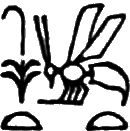 |
 |
| nuter | nefer | ḥeq | Ȧn | suten kaut? | neb |
| The god · | gracious · | prince of · | Heliopolis · | king of Upper and Lower Egypt · | lord (of · |
 |
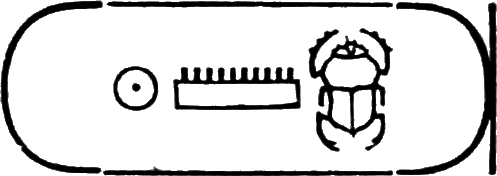 |
 |
 |
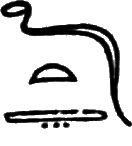 |
| taui | Men-kheper-Râ | du | ânkh | zeta |
| the) two countries · | Thothmes III. · | giving · | life · | forever. |
 |
 |
 |
 |
| nuter | nefer | ḥeq | Ȧn |
| The god · | gracious · | prince of · | Heliopolis · |
 |
 |
 |
| suten kaut? | neb | taui |
| king of Upper and Lower Egypt · |
lord (of · | the) two countries · |
 |
 |
 |
 |
| Men-kheper-Râ | du | ânkh | zeta |
| Thothmes III. · | giving · | life · | forever. |
i. e. This is the gracious god, the prince of Heliopolis, the king of Upper and Lower Egypt, the lord of the two countries [Egypt], Thothmes III., who gives eternal life.
 suten-kaut (pronunciation doubtful!) "the king of Upper and Lower Egypt" is the official
title of the Egyptian kings and conveys the same meaning as the
suten-kaut (pronunciation doubtful!) "the king of Upper and Lower Egypt" is the official
title of the Egyptian kings and conveys the same meaning as the  neb taui "the lord of the
two countries" mentioned so frequently above. Another name of the king, and one that has been
embodied into our language, is
neb taui "the lord of the
two countries" mentioned so frequently above. Another name of the king, and one that has been
embodied into our language, is  per â "Pharaoh", which is, literally
translated, "the great house"; a title bearing the closest resemblance to the modern
"Sublime Porte" of the Turkish sultan.
per â "Pharaoh", which is, literally
translated, "the great house"; a title bearing the closest resemblance to the modern
"Sublime Porte" of the Turkish sultan.
Below the sphinx is the same inscription as on the East pyramidion: 
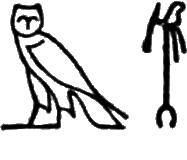
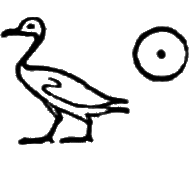
 qa nekht khâ em Us sa Râ
Men-kheper-Râ "This is the powerful and glorious bull [king] in Thebes, the
Sun's offspring, Thothmes III".
qa nekht khâ em Us sa Râ
Men-kheper-Râ "This is the powerful and glorious bull [king] in Thebes, the
Sun's offspring, Thothmes III".
The three columns above to the left refer to the god Tum, who is seated below, and read:
 |
 |
 |
 |
 |
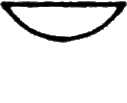 |
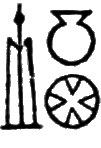 |
 |
 |
| du | ânkh | ded | us | Tum | neb | Ȧn | nuter | nefer |
| Giving · | life · | stability · | strength · | Tum · | lord of · | Heliopolis · | the god · | gracious · |
 |
 |
 |
 |
 |
 |
| du | ânkh | ded | us | Tum | neb |
| Giving · | life · | stability · | strength · | Tum · | lord of · |
 |
 |
 |
| Ȧn | nuter | nefer |
| Heliopolis · | the god · | gracious · |
 |
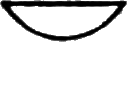 |
 |
 |
| â | neb | en | ḥa·t |
| great · | lord · | of · | the temple. |
i. e. This is Tum, the lord of Heliopolis, the gracious and great god, the lord of his temple, who gives life, stability, and strength.
The inscription between the god and the sphinx-king differs from that of the preceding pyramidions; it is:
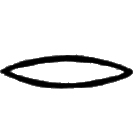 |
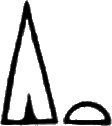 |
 |
 |
 |
 |
 |
| er | du·t | qebeḥ | ȧr | ef | du | ânkh |
| For · | a gift · | libation · | to make · | him · | give · | life. |
i. e. The king pours out a libation of water in order to receive from him [the god] life.
North Face of the Pyramidion.
The four columns above to the left refer to the sphinx-king and read:
 |
 |
 |
 |
 |
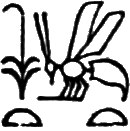 |
 |
| nuter | nefer | neb | ȧr | khet | suten kaut? | neb |
| The god · | gracious · | lord · | maker of · | things · | king of Upper and Lower Egypt · | lord (of · |
 |
 |
 |
 |
 |
| taui | Men-kheper-Râ | du | ânkh | zeta |
| the) two countries · | Thothmes III. · | giving · | life · | forever. |
 |
 |
 |
 |
 |
| nuter | nefer | neb | ȧr | khet |
| The god · | gracious · | lord · | maker of · | things · |
 |
 |
 |
| suten kaut? | neb | taui |
| king of Upper and Lower Egypt · |
lord (of · | the) two countries · |
 |
 |
 |
 |
| Men-kheper-Râ | du | ânkh | zeta |
| Thothmes III. · | giving · | life · | forever. |
i. e. This is the gracious god, the lord and maker of everything, the king of Upper and Lower Egypt, the lord of the two countries [Egypt], Thothmes III., who gives eternal life.
The inscription below the sphinx is identical with the one on the East pyramidion; namely, 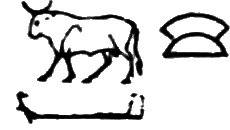
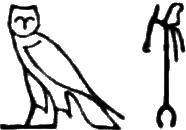
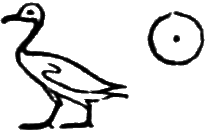
 qa nekht khâ em Us sa Râ Men-kheper-Râ "This is
the powerful and glorious bull [king] in Thebes, the Sun's offspring, Thothmes
III".
qa nekht khâ em Us sa Râ Men-kheper-Râ "This is
the powerful and glorious bull [king] in Thebes, the Sun's offspring, Thothmes
III".
The three columns above to the right refer to the sun-god Râ seated below, and read:
 |
 |
 |
 |
 |
 |
 |
 |
| du | ânkh | ef | neb | Râ-Ḥor- | khuti | neb | taui |
| Giving · | life · | him · | all · | Râ-Horus | in the horizon · | lord (of · | the) two countries. |
 |
 |
 |
 |
 |
 |
| du | ânkh | ef | neb | Râ-Ḥor- | khuti |
| Giving · | life · | him · | all · | Râ-Horus | in the horizon · |
 |
 |
| neb | taui |
| lord (of · | the) two countries. |
i. e. This is Rā-Hor-khuti, the lord of the two countries [Egypt], who gives him [the king] all life.
 Râ-Ḥor-khuti "Râ-Horus in the horizon" is the title of the morning-sun, to which
attention has already been called on page 30. The last sign is very
frequently written
Râ-Ḥor-khuti "Râ-Horus in the horizon" is the title of the morning-sun, to which
attention has already been called on page 30. The last sign is very
frequently written  khu·t, the
khu·t, the  showing the disk of the sun between two mountains and in
the act of rising, and the
showing the disk of the sun between two mountains and in
the act of rising, and the  signifying "a house" or "a place". The whole group means
"the house of the rising sun" or "the source of light", which is usually translated by the general
term "horizon". The whole title, therefore, stands for the rising or eastern sun (cf. the picture
on page 28).
signifying "a house" or "a place". The whole group means
"the house of the rising sun" or "the source of light", which is usually translated by the general
term "horizon". The whole title, therefore, stands for the rising or eastern sun (cf. the picture
on page 28).
The inscription between the god and the sphinx-king is partially destroyed,
leaving, however, enough traces to show that it must have been identical with the one on the West
pyramidion: 
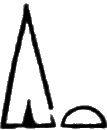


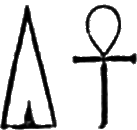 er du·t qebeḥ ȧr·f du ânkh "The king pours out a
libation of water in order to receive from him [the god] life".
er du·t qebeḥ ȧr·f du ânkh "The king pours out a
libation of water in order to receive from him [the god] life".
The Obelisk Proper.
On the obelisk proper the inscriptions of Thothmes III. are contained in the
central column of each face. At the top of each column, immediately below the pyramidion, we find
the sign  , literally pet "heaven", which may either be taken with the next sign
, literally pet "heaven", which may either be taken with the next sign  Ḥor "Horus" so as to signify "the heavenly Horus", or else it may be regarded to
express the wish of the Pharaoh, that heaven would protect his obelisk and proclaim its
inscriptions as of heavenly origin.
Ḥor "Horus" so as to signify "the heavenly Horus", or else it may be regarded to
express the wish of the Pharaoh, that heaven would protect his obelisk and proclaim its
inscriptions as of heavenly origin.
East Face [central column].
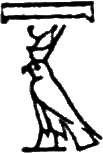 |
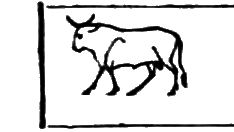 |
 |
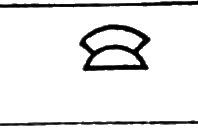 |
 |
 |
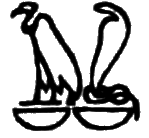 |
| Ḥor-pet | qa | nekht | khâ | em | Us | neb mut or sheta neb ârâ or meḥen·t |
| The heavenly Horus · | bull · | powerful · | glorious · | in · | Thebes · | lord of the Vulture diadem lord of the Uræus-snake diadem · |
 |
 |
 |
 |
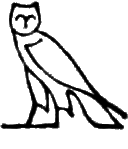 |
 |
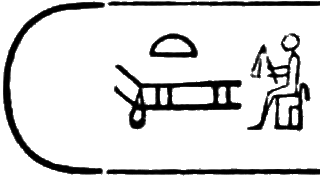 |
 |
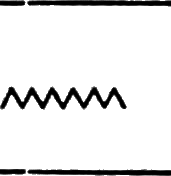 |
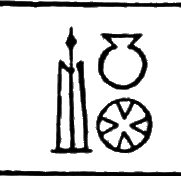 |
| ûaḥ | suten | ma | Râ | em | pet | Tum | neb·t | en | Ȧn |
| placed · | king · | like · | Râ · | in · | heaven · | Tum · | lord · | of · | Heliopolis · |
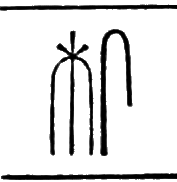 |
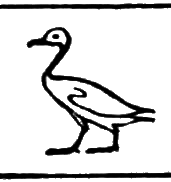 |
 |
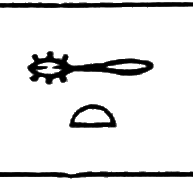 |
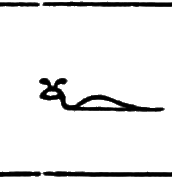 |
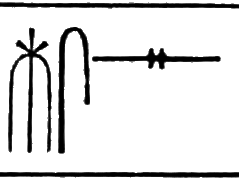 |
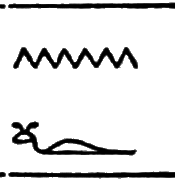 |
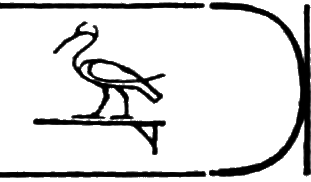 |
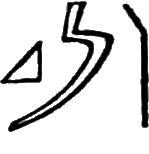 |
 |
| meses | sa | en | kha·t | ef | meses | nef | Deḥuti | qema | en |
| begotten · | son · | of · | womb · | his · | born · | him · | Thoth · | created · | by · |
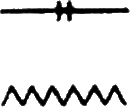 |
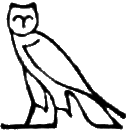 |
 |
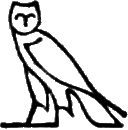 |
 |
 |
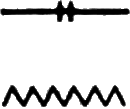 |
 |
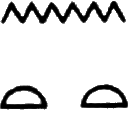 |
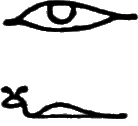 |
| sen | em | ḥat-â | em | neferu | ḥâu | sen | rekh | enti | ȧr·f |
| them · | in · | great-temple · | in · | beauty of · | limbs · | their · | knowing · | what · | he should do · |
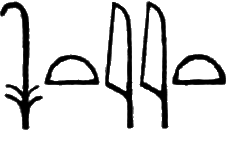 |
 |
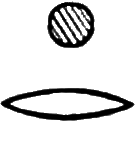 |
 |
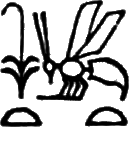 |
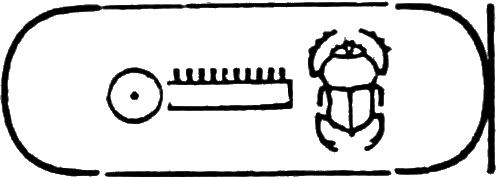 |
| sutenî·t | ûaḥ | kher | neḥeḥ | suten-kaut? | Men-kheper-Râ |
| kingdom · | placed · | for · | eternity · | king of Upper and Lower Egypt · | Thothmes III. |
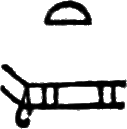 |
 |
 |
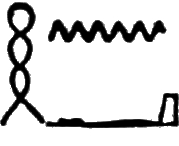 |
 |
 |
 |
 |
 |
 |
| Tum | nuter | â | ḥenâ | pau·t | nuteru· | f | merî | du | ânkh |
| Tum · | god · | great · | with · | circle · | (of) gods · | his · | beloved · | giving · | life · |
 |
 |
 |
 |
 |
 |
| ded | us | neb | ma | Râ | zeta |
| stability · | strength · | all · | like · | Râ · | forever. |
 |
 |
 |
 |
 |
 |
| Ḥor-pet | qa | nekht | khâ | em | Us |
| The heavenly Horus · |
bull · | powerful · | glorious · | in · | Thebes · |
 |
 |
 |
 |
 |
 |
| neb mut or sheta neb ârâ or meḥen·t |
ûaḥ | suten | ma | Râ | em |
| lord of the Vulture diadem lord of the Uræus-snake diadem · |
placed · | king · | like · | Râ · | in · |
 |
 |
 |
 |
 |
 |
| pet | Tum | neb·t | en | Ȧn | meses |
| heaven · | Tum · | lord · | of · | Heliopolis · | begotten · |
 |
 |
 |
 |
 |
 |
 |
| sa | en | kha·t | ef | meses | nef | Deḥuti |
| son · | of · | womb · | his · | born · | him · | Thoth · |
 |
 |
 |
 |
 |
 |
 |
 |
| qema | en | sen | em | ḥat-â | em | neferu | ḥâu |
| created · | by · | them · | in · | great- temple · |
in · | beauty of · |
limbs · |
 |
 |
 |
 |
 |
 |
| sen | rekh | enti | ȧr·f | sutenî·t | ûaḥ |
| their · | knowing · | what · | he should do · | kingdom · | placed · |
 |
 |
 |
 |
| kher | neḥeḥ | suten-kaut? | Men-kheper-Râ |
| for · | eternity · | king of Upper and Lower Egypt · |
Thothmes III. |
 |
 |
 |
 |
 |
 |
 |
| Tum | nuter | â | ḥenâ | pau·t | nuteru· | f |
| Tum · | god · | great · | with · | circle · | (of) gods · | his · |
 |
 |
 |
 |
 |
 |
| merî | du | ânkh | ded | us | neb |
| beloved · | giving · | life · | stability · | strength · | all · |
 |
 |
 |
| ma | Râ | zeta |
| like · | Râ · | forever. |
i. e. Behold Pharaoh! He is the heavenly Horus, the powerful and glorious bull [king] in Thebes.[2] He is the lord of the Vulture and Uræus diadems[3], and his kingdom is established as firmly as the sun in the heavens. His name is[4]: "He whom Tum, the lord of Heliopolis, has begotten, and who is the son of his loins, whom Thoth has brought forth"[5], who was created by them [the gods] in the great temple of Heliopolis in the beauty of their limbs, and who knew beforehand what he would do to establish for himself an eternal kingdom. He is Thothmes III., the king of Upper and Lower Egypt, beloved of the great god Tum and his circle of gods, who gives all life, stability, and strength now and for ever!
South Face [central column].
Almost the entire column on this side is in a very poor condition, the hieroglyphs being hardly discernible. The following, however, may prove to be a correct restoration of the inscription.
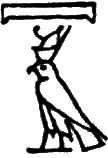 |
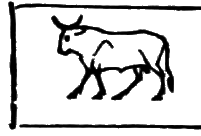 |
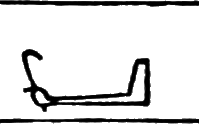 |
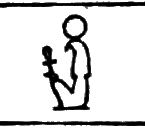 |
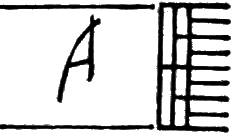 |
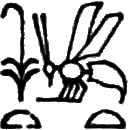 |
| Ḥor-pet | qa | nekht | Râ | mer | suten-kaut? |
| The heavenly Horus · | bull · | powerful · | Râ · | beloved · | king of Upper and Lower Egypt · |
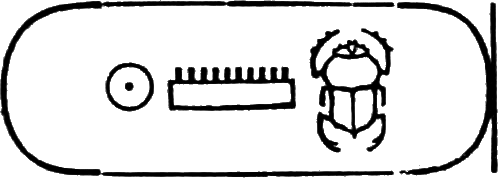 |
 |
 |
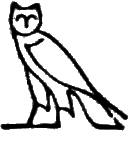 |
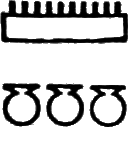 |
 |
 |
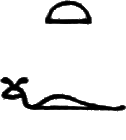 |
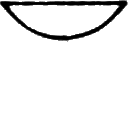 |
| Men-kheper-Râ | ȧr | nef | em | mennu· | f | en | tef | neb |
| Thothmes III. · | made · | by him · | for · | monument · | his · | for · | father · | lord of · |
 |
 |
 |
 |
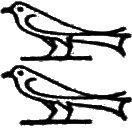 |
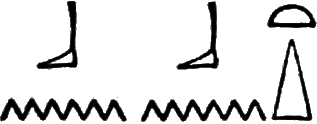 |
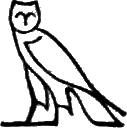 |
| Ȧn | s·âḥâ | nef | tekhenui | ûrui | benben·t | em |
| Heliopolis · | caused to erect · | by him · | two obelisks · | large · | the pyramidion · | of · |
 |
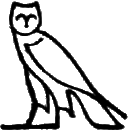 |
 |
 |
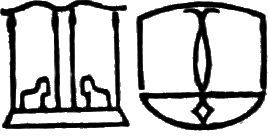 |
 |
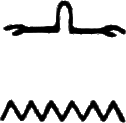 |
| usem | em | sep | tep | sed-ḥeb | .......... | nen |
| gold-metal · | at · | time · | first (of) · | the thirty-year-period · | ... illegible! ... · | not · |
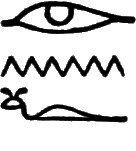 |
 |
 |
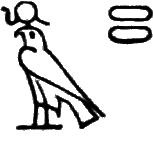 |
 |
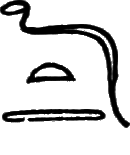 |
| ȧr nef | sa Râ | Deḥuti-meses-nefer-kheperu | Râ-Ḥor-khuti | merî | zeta |
| (as) done by him · | the son of Râ · | Thothmes III. · | Râ-Hor-Khuti · | beloved · | forever. |
 |
 |
 |
 |
 |
| Ḥor-pet | qa | nekht | Râ | mer |
| The heavenly Horus · | bull · | powerful · | Râ · | beloved · |
 |
 |
 |
 |
 |
| suten-kaut? | Men-kheper-Râ | ȧr | nef | em |
| king of Upper and Lower Egypt · |
Thothmes III. · | made · | by him · | for · |
 |
 |
 |
 |
 |
 |
| mennu· | f | en | tef | neb | Ȧn |
| monument · | his · | for · | father · | lord of · | Heliopolis · |
 |
 |
 |
 |
 |
| s·âḥâ | nef | tekhenui | ûrui | benben·t |
| caused to erect · |
by him · | two obelisks · | large · | the pyramidion · |
 |
 |
 |
 |
 |
| em | usem | em | sep | tepb |
| of · | gold-metal · | at · | time · | first (of) · |
 |
 |
 |
 |
| sed-ḥe | .......... | nen | ȧr nef |
| the thirty-year-period · | ... illegible! ... · | not · | (as) done by him · |
 |
 |
| sa Râ | Deḥuti-meses-nefer-kheperu |
| the son of Râ · | Thothmes III. · |
 |
 |
 |
| Râ-Ḥor-khuti | merî | zeta |
| Râ-Hor-Khuti · | beloved · | forever. |
i. e. Behold Pharaoh! He is the heavenly Horus, the powerful bull, beloved of Rā. He is Thothmes III., the king of Upper and Lower Egypt, who has made this to be his monument in honor of his father Tum, the lord of Heliopolis, and who has set up for him two[6] large obelisks, the pyramidion being covered with gold-metal,[7] on the first day[8] of the thirty-year festival[9] ..........[10] No one has ever done what he did, the Sun's offspring, {59}Thothmes III., the beloved of Rā-Hor-Khuti, who lives forever.
West Face [CENTRAL COLUMN].
The abrasion caused by the sand of the Libyan desert has effaced almost every hieroglyph on this side of the obelisk. All that can be seen is given below.
 |
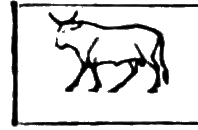 |
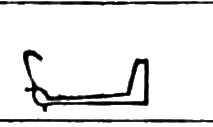 |
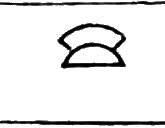 |
 |
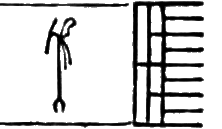 |
 |
| Ḥor-pet | qa | nekht | khâ | em | Us | suten-kaut? |
| The heavenly Horus · | bull · | powerful · | glorious · | in · | Thebes · | king of Upper and Lower Egypt · |
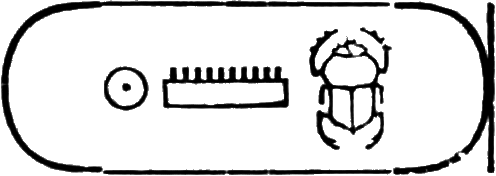 |
 |
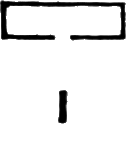 |
 |
 |
 |
 |
| Men-kheper-Râ | s·menkh | per | en | meses | ȧm · | f |
| Thothmes III. · | causing to be adorned · | the house · | of · | birth · | there · | his · |
 |
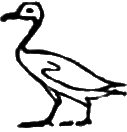 |
 |
| .......... | sa | Râ |
| ..........illegible!.......... · | the son of Râ · | |
 |
 |
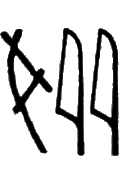 |
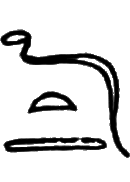 |
| Deḥuti-meses-nefer-kheperu | Râ-Ḥor-khuti | merî | zeta |
| Thothmes III. · | Râ-Hor-Khuti · | beloved · | forever. |
 |
 |
 |
 |
 |
 |
| Ḥor-pet | qa | nekht | khâ | em | Us |
| The heavenly Horus · |
bull · | powerful · | glorious · | in · | Thebes · |
 |
 |
 |
 |
| suten-kaut? | Men-kheper-Râ | s·menkh | per |
| king of Upper and Lower Egypt · |
Thothmes III. · | causing to be adorned · |
the house · |
 |
 |
 |
 |
 |
| en | meses | ȧm · | f | .......... |
| of · | birth · | there · | his · | ..........illegible!.......... · |
 |
 |
 |
| sa | Râ | Deḥuti-meses-nefer-kheperu |
| the son of Râ · | Thothmes III. · | |
 |
 |
 |
| Râ-Ḥor-khuti | merî | zeta |
| Râ-Hor-Khuti · | beloved · | forever. |
i. e. Behold Pharaoh! He is the heavenly Horus, the powerful and glorious bull [king] in Thebes. He is the king of Upper and Lower Egypt, Thothmes III., who has embellished the house where he was born, .........., the Sun's offspring, Thothmes III., the beloved of Rā-Hor-Khuti, who lives forever.
North Face [CENTRAL COLUMN].
 |
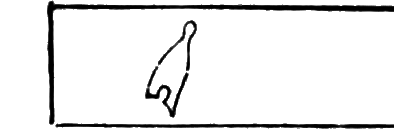 |
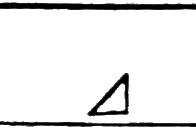 |
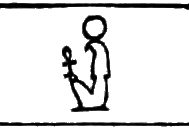 |
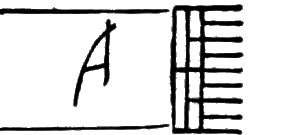 |
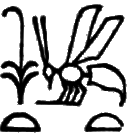 |
| Ḥor-pet | ḥez | qa | Râ | mer | suten-kaut? |
| The heavenly Horus · | the white crown · | lifting · | Râ · | beloved · | king of Upper and Lower Egypt · |
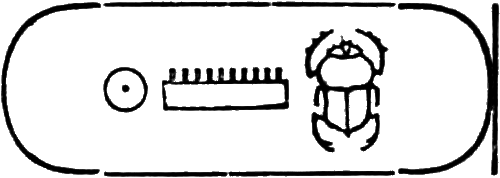 |
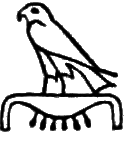 |
 |
 |
| Men-kheper-Râ | Ḥor-nub | har | nekht |
| Thothmes III. · | the golden Horus · | rejoicing in · | strength · |
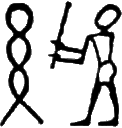 |
 |
 |
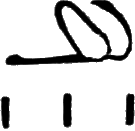 |
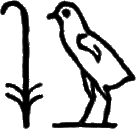 |
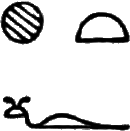 |
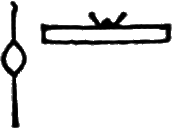 |
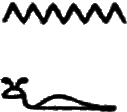 |
| ḥu | ḥequ | men·tu? | peḥu | su | khatf | utu | nef |
| smiting · | the princes (of) · | the countries · | distant · | they · | because · | ordered · | for him · |
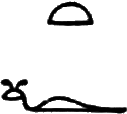 |
 |
 |
 |
 |
 |
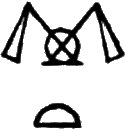 |
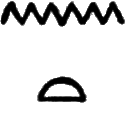 |
 |
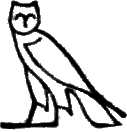 |
| tef | Râ | nekhtu | er | ta | neb | dem·t | ent | khepesh | em |
| father · | Râ · | victories · | over · | land · | all · | completeness · | of · | power · | at · |
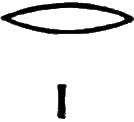 |
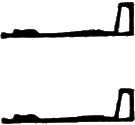 |
 |
 |
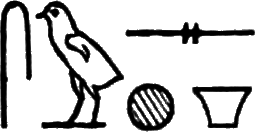 |
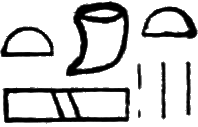 |
| ru | dedui· | f | er | s·usekh | tash·tu |
| the end of · | the two hands · | his · | in order to · | cause to be extended · | the boundaries of · |
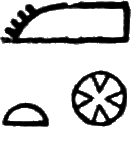 |
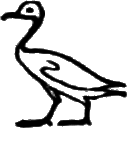 |
 |
 |
 |
 |
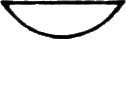 |
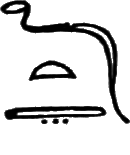 |
| Qem·t | sa | Râ | Deḥuti-meses-nefer-kheperu du | ânkh | neb | zeta | |
| Egypt · | the son of · | Râ · | Thothmes III. · | giving · | life · | all · | forever. |
 |
 |
 |
 |
 |
| Ḥor-pet | ḥez | qa | Râ | mer |
| The heavenly Horus · |
the white crown · | lifting · | Râ · | beloved · |
 |
 |
 |
| suten-kaut? | Men-kheper-Râ | Ḥor-nub |
| king of Upper and Lower Egypt · |
Thothmes III. · | the golden Horus · |
 |
 |
 |
 |
 |
| har | nekht | ḥu | ḥequ | men·tu? |
| rejoicing in · | strength · | smiting · | the princes (of) · |
the countries · |
 |
 |
 |
 |
 |
 |
 |
| peḥu | su | khatf | utu | nef | tef | Râ |
| distant · | they · | because · | ordered · | for him · | father · | Râ · |
 |
 |
 |
 |
 |
 |
 |
| nekhtu | er | ta | neb | dem·t | ent | khepesh |
| victories · | over · | land · | all · | completeness · | of · | power · |
 |
 |
 |
 |
 |
| em | ru | dedui· | f | er |
| at · | the end of · | the two hands · | his · | in order to · |
 |
 |
 |
 |
 |
| s·usekh | tash·tu | Qem·t | sa | Râ |
| cause to be extended · |
the boundaries of · | Egypt · | the son of · | Râ · |
 |
 |
 |
 |
 |
| Deḥuti-meses-nefer-kheperu du | ânkh | neb | zeta | |
| Thothmes III. · | giving · | life · | all · | forever. |
i.e. Behold Pharaoh! He is the heavenly Horus, who has crowned[11] himself with the white crown[12], beloved of Rā. He is Thothmes III., the king of Upper and Lower Egypt, the golden Horus[13], rejoicing in his strength, the vanquisher of the princes of the countries which are distant. He did this because his father Rā had so commanded him, and had then given him victories over the entire world, and had placed an abundance of power on his arm, so that he [the king] might enlarge the boundaries of Egypt. This was done by the Sun's offspring, Thothmes III., who gives all life forever.
II. Inscriptions of Ramses II.
The inscriptions of Ramses II. are found in the two vertical columns to the right and left of the central column of each face and the two horizontal lines at the base of each face of the obelisk. The inscriptions are in a much better condition than those of Thothmes III., and can be more readily deciphered. They were engraved on the stone not quite three centuries after the pyramidions and the central columns were inscribed. Even a casual observer will notice that the hawk at the top of each central column is larger than those to the right and left of it, these being crowded into the remaining space.
East Face [NORTHERN COLUMN].
 |
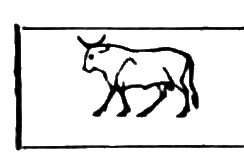 |
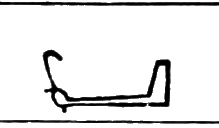 |
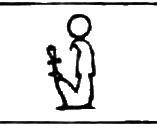 |
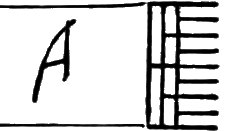 |
 |
| Ḥor-pet | qa | nekht | Râ | mer | suten-kaut? |
| The heavenly Horus · | bull · | powerful · | Râ · | beloved · | king of Upper and Lower Egypt · |
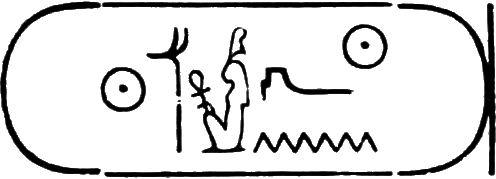 |
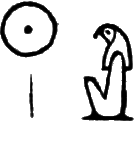 |
 |
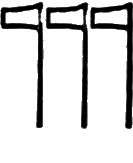 |
 |
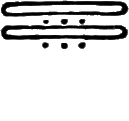 |
| User-Mâ-Râ-sotep-en-Râ | Râ | meses | nuteru | ger | taui |
| Ramses II. · | the Sun · | born of · | the gods · | possessing · | the two worlds · |
 |
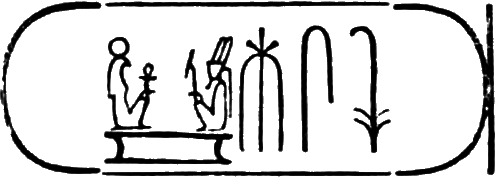 |
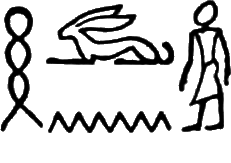 |
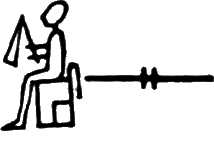 |
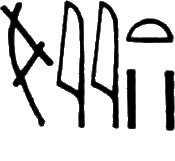 |
 |
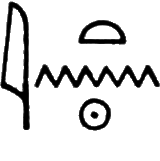 |
| sa Râ | Ȧmen-mer-Râ-meses-su | ḥun | shepes | merîti | mȧ | Ȧten |
| the son of Râ · | Ramses II. · | a child · | glorious · | beloved · | like · | Aten · |
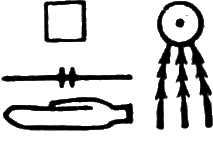 |
 |
 |
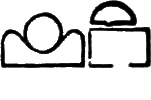 |
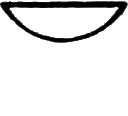 |
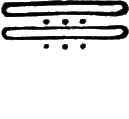 |
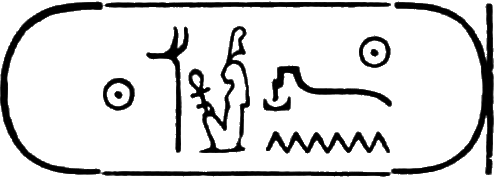 |
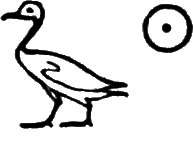 |
| pesed· | f | em | khu·t | neb | taui | User-Mâ-Râ-sotep-en-Râ | sa Râ |
| shines · | he · | in · | the horizon · | lord · | of the two countries · | Ramses II. · | son of Râ · |
 |
 |
 |
 |
 |
| Ḥor-pet | qa | nekht | Râ | mer |
| The heavenly Horus · |
bull · | powerful · | Râ · | beloved · |
 |
 |
 |
| suten-kaut? | User-Mâ-Râ-sotep-en-Râ | Râ |
| king of Upper and Lower Egypt · |
Ramses II. · | the Sun · |
 |
 |
 |
 |
 |
| meses | nuteru | ger | taui | sa Râ |
| born of · | the gods · | possessing · | the two worlds · |
the son of Râ · |
 |
 |
 |
 |
| Ȧmen-mer-Râ-meses-su | ḥun | shepes | merîti |
| Ramses II. · | a child · | glorious · | beloved · |
 |
 |
 |
 |
 |
 |
 |
| mȧ | Ȧten | pesed· | f | em | khu·t | neb |
| like · | Aten · | shines · | he · | in · | the horizon · | lord · |
 |
 |
 |
||||||
| taui | User-Mâ-Râ-sotep-en-Râ | sa Râ | Ȧmen-mer-Râ-meses-su | khu | en | Râ | du | ânkh |
| of the two countries · | Ramses II. · | son of Râ · | Ramses II. · | the glory · | of · | Râ · | giving · | life. |
 |
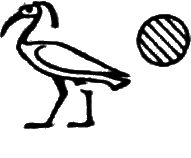 |
 |
 |
 |
 |
| Ȧmen-mer-Râ-meses-su | khu | en | Râ | du | ânkh |
| Ramses II. · the glory · | of · | Râ · | giving · | life. | |
i. e. Behold Pharaoh! He is the heavenly Horus, the powerful bull, beloved of Rā. He is Ramses II.[14], the king of Upper and Lower Egypt, the Sun himself, and the child of the gods. He is master of the two countries [Egypt], the Sun's offspring, Ramses II.[15] He is a youth glorious and beloved like Aten[16], when he shines in the horizon. He is the lord of the two countries [Egypt], Ramses II.[14], the Sun's offspring, Ramses II.[15], the glorious image of Rā, who gives life.
East Face [SOUTHERN COLUMN].
 |
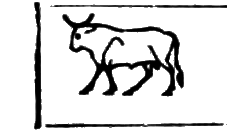 |
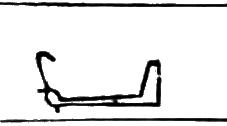 |
 |
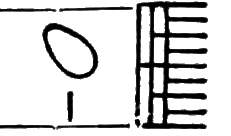 |
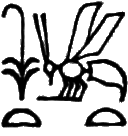 |
| Ḥor-pet | qa | nekht | kheperȧ | sa | suten-kaut? |
| The heavenly Horus · | bull · | powerful · | Khepera's · | son · | king of Upper and Lower Egypt · |
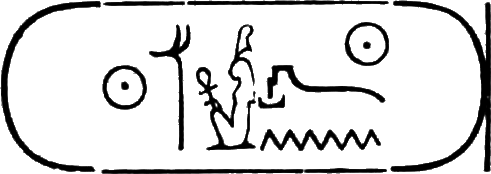 |
 |
 |
 |
 |
 |
| User-Mâ-Râ-sotep-en-Râ | Ḥor-nub | user | renpe·tu | â | en |
| Ramses II. · | the golden Horus · | abounding in · | years · | great · | in · |
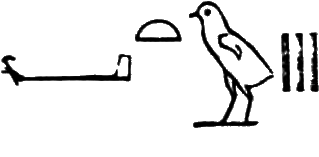 |
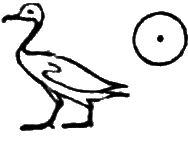 |
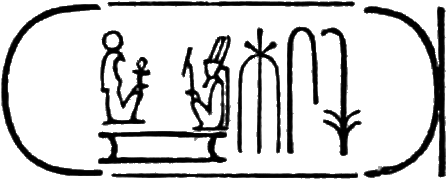 |
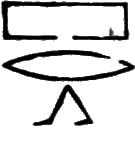 |
 |
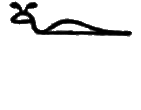 |
 |
| nekhtu | sa Râ | Ȧmen-mer-Râ-meses-su | per | en | ef | em |
| victories · | the son of Râ · | Ramses II. · | going out · | by · | him · | from · |
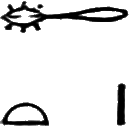 |
 |
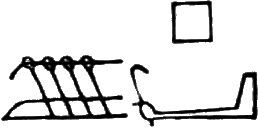 |
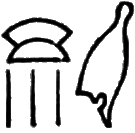 |
 |
 |
 |
 |
 |
 |
 |
| kha·t | er | shep | khâu | en | Râ | meses | su | er | neb | uâ |
| womb · | to · | obtain · | diadems · | of · | Râ · | begetting · | himself · | as · | lord · | only · |
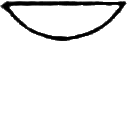 |
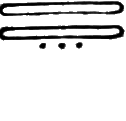 |
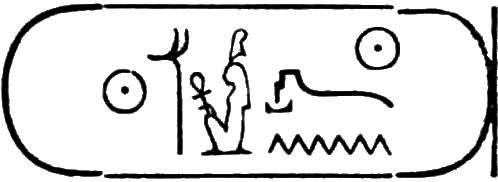 |
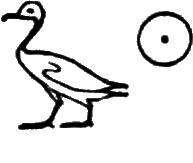 |
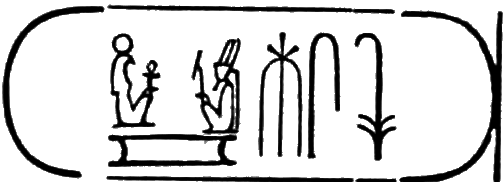 |
| neb | taui | User-Mâ-Râ-sotep-en-Râ | sa Râ | Ȧmen-mer-Râ-meses-su |
| lord of · | the two countries · | Ramses II. · | son of Râ · | Ramses II. |
 |
 |
 |
 |
 |
| Ḥor-pet | qa | nekht | kheperȧ | sa |
| The heavenly Horus · |
bull · | powerful · | Khepera's · | son · |
 |
 |
 |
| suten-kaut? | User-Mâ-Râ-sotep-en-Râ | Ḥor-nub |
| king of Upper and Lower Egypt · |
Ramses II. · | the golden Horus · |
 |
 |
 |
 |
 |
 |
| user | renpe·tu | â | en | nekhtu | sa Râ |
| abounding in · | years · | great · | in · | victories · | the son of Râ · |
 |
 |
 |
 |
 |
| Ȧmen-mer-Râ-meses-su | per | en | ef | em |
| Ramses II. · | going out · | by · | him · | from · |
 |
 |
 |
 |
 |
 |
 |
| kha·t | er | shep | khâu | en | Râ | meses |
| womb · | to · | obtain · | diadems · | of · | Râ · | begetting · |
 |
 |
 |
 |
 |
 |
| su | er | neb | uâ | neb | taui |
| himself · | as · | lord · | only · | lord of · | the two countries · |
 |
 |
 |
||
| User-Mâ-Râ-sotep-en-Râ | sa Râ | Ȧmen-mer-Râ-meses-su | ||
| Ramses II. · | son of Râ · |
Ramses II. | the glory · | of · |
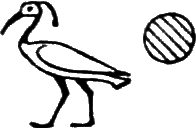 |
 |
 |
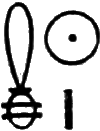 |
| khu | en | Râ | ma Râ |
| the glory · | of · | Râ · | to-day (literally: like Râ). |
i. e. Behold Pharaoh! He is the heavenly Horus, the powerful bull, the son of Khepera[17]. He is Ramses II., the king of Upper and Lower Egypt, the golden Horus, who abounds in years and is great in victories. He is the Sun's offspring, Ramses II., who issued from the Sun's loins to receive the diadems of Rā. It is he who brought forth himself[18] as sole ruler and lord of the two countries [Egypt], Ramses II., the Sun's offspring, Ramses II., the glorious image of Rā, now and forever.
South Face [EASTERN COLUMN].
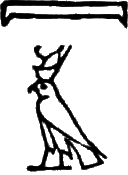 |
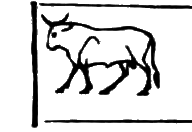 |
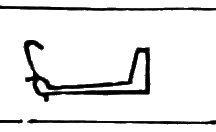 |
 |
 |
 |
| Ḥor-pet | qa | nekht | Mâ | mer | suten-kaut? |
| The heavenly Horus · | bull · | powerful · | Truth · | beloved · | king of Upper and Lower Egypt · |
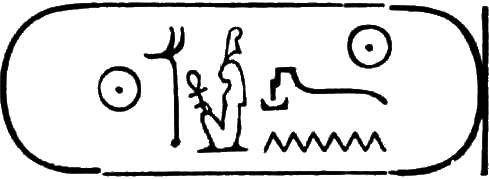 |
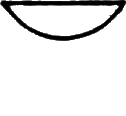 |
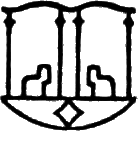 |
 |
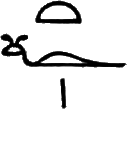 |
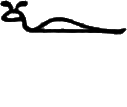 |
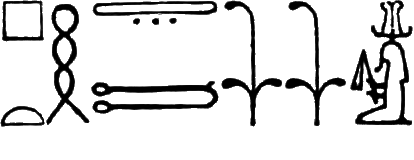 |
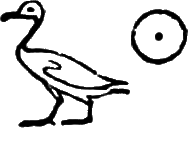 |
| User-Mâ-Râ-sotep-en-Râ | neb | ḥeb | mȧ | tef · | f | Ptaḥ-tathunen | sa Râ |
| Ramses II. · | lord of · | festival · | like · | father · | his · | Ptah-tatunen · | the son of Râ · |
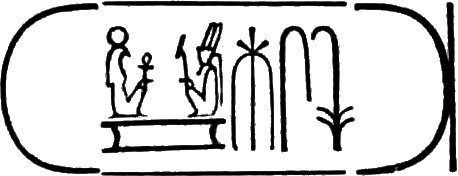 |
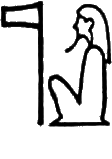 |
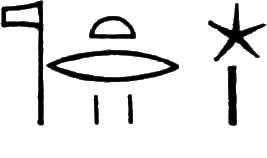 |
 |
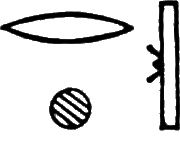 |
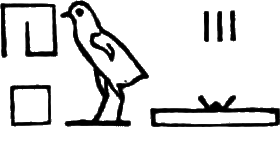 |
| Ȧmen-mer-Râ-meses-su | nuter | nuteri dûa | taui | rekh | hapu |
| Ramses II. · | god · | morning star of · | the two countries · | knowing · | the laws · |
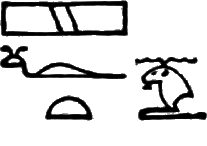 |
 |
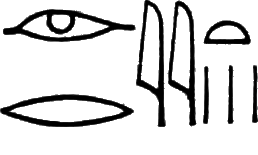 |
 |
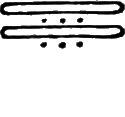 |
 |
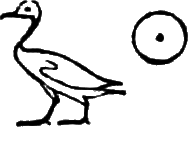 |
| shef·t | em | ȧrî·tu | neb | taui | User-Mâ-Râ-sotep-en-Râ sa Râ | |
| awe inspiring · | in · | (his) works · | the lord of · | the two countries · Ramses II. · son of Râ · | ||
 |
 |
 |
 |
 |
| Ḥor-pet | qa | nekht | Mâ | mer |
| The heavenly Horus · | bull · | powerful · | Truth · | beloved · |
 |
 |
| suten-kaut? | User-Mâ-Râ-sotep-en-Râ |
| king of Upper and Lower Egypt · | Ramses II. · |
 |
 |
 |
 |
 |
 |
| neb | ḥeb | mȧ | tef · | f | Ptaḥ-tathunen |
| lord of · | festival · | like · | father · | his · | Ptah-tatunen · |
 |
 |
 |
| sa Râ | Ȧmen-mer-Râ-meses-su | nuter |
| the son of Râ · | Ramses II. · | god · |
 |
 |
 |
 |
| nuteri dûa | taui | rekh | hapu |
| morning star of · | the two countries · | knowing · | the laws · |
 |
 |
 |
 |
 |
| shef·t | em | ȧrî·tu | neb | taui |
| awe inspiring · | in · | (his) works · | the lord of · | the two countries · |
 |
 |
| User-Mâ-Râ-sotep-en-Râ | sa Râ |
| Ramses II. · | son of Râ · |
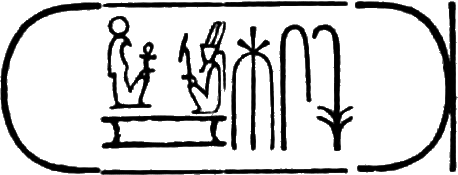 |
 |
 |
| Ȧmen-mer-Râ-meses-su | du | ânkh |
| Ramses II. · | giving · | life. |
i. e. Behold Pharaoh! He is the heavenly Horus, the powerful bull, beloved of Mā.[19] He is Ramses II., the king of Upper and Lower Egypt, the lord of festivals, who is like his father Ptah of Memphis.[20] He is the Sun's offspring, Ramses II., a god himself, the morning-star of the two countries, who is well versed in the laws and awe inspiring in his works. He is the lord of the two countries [Egypt], Ramses II., the Sun's offspring Ramses II., who gives life.
South Face [WESTERN COLUMN].
 |
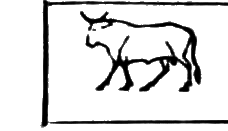 |
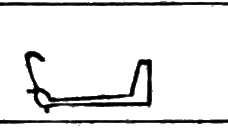 |
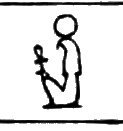 |
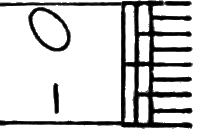 |
 |
| Ḥor-pet | qa | nekht | Râ | sa | suten-kaut? |
| The heavenly Horus · | bull · | powerful · | Râ's · | son · | king of Upper and Lower Egypt · |
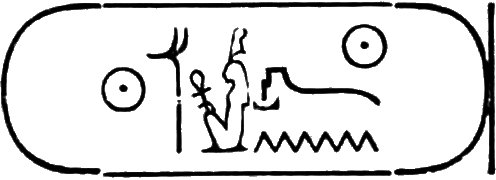 |
 |
 |
| User-Mâ-Râ-sotep-en-Râ neb mut or sheta | neb ârâ or meḥen·t | |
| Ramses II. · lord of the Vulture diadem · | lord of the Uræus-snake diadem · | |
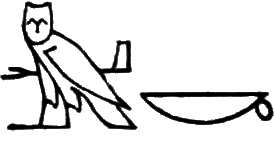 |
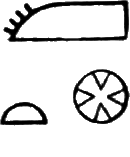 |
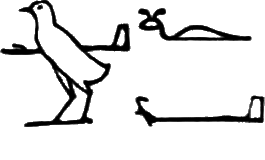 |
 |
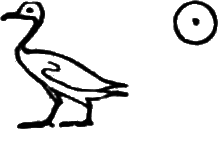 |
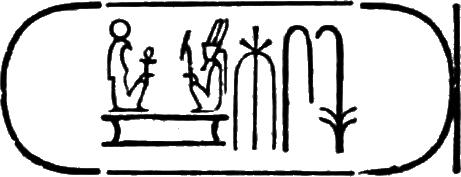 |
| mâk | Qem·t | uâf | men·tu? | sa Râ Ȧmen-mer-Râ-meses-su | |
| protector of · | Egypt · | smiter of · | the countries · | the son of Râ · | Ramses II. · |
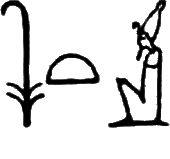 |
 |
 |
 |
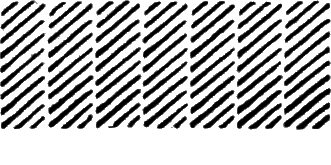 |
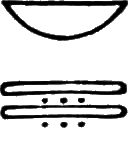 |
 |
| suten | menkh | mȧ | Râ | .......... | neb taui | User-Mâ-Râ-sotep-en-Râ |
| king · | kind · | like · | Râ · | illegible! · lord of the two countries · Ramses II. · | ||
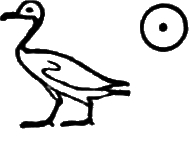 |
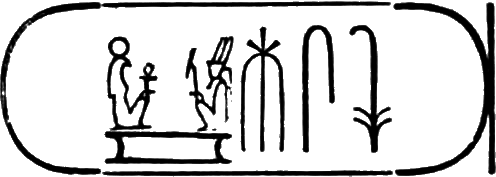 |
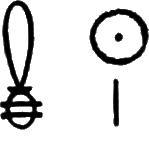 |
| sa Râ | Ȧmen-mer-Râ-meses-su | ma Râ |
| the son of Râ · Ramses II. · to-day (literally: like Râ). | ||
 |
 |
 |
 |
 |
| Ḥor-pet | qa | nekht | Râ | sa |
| The heavenly Horus · | bull · | powerful · | Râ's · | son · |
 |
 |
 |
| suten-kaut? | User-Mâ-Râ-sotep-en-Râ | neb mut or sheta |
| king of Upper and Lower Egypt · |
Ramses II. · lord of the Vulture diadem · | |
 |
 |
 |
 |
| neb ârâ or meḥen·t | mâk | Qem·t | uâf |
| lord of the Uræus-snake diadem · |
protector of · | Egypt · | smiter of · |
 |
 |
 |
 |
| men·tu? | sa Râ Ȧmen-mer-Râ-meses-su | suten | |
| the countries · | the son of Râ · | Ramses II. · | king · |
 |
 |
 |
 |
 |
| menkh | mȧ | Râ | .......... | neb taui |
| kind · | like · | Râ · | illegible! · | lord of the two countries · |
 |
 |
| User-Mâ-Râ-sotep-en-Râ | sa Râ |
| Ramses II. · | the son of Râ · |
 |
 |
| Ȧmen-mer-Râ-meses-su | ma Râ |
| Ramses II. · | to-day (literally: like Râ). |
i. e. Behold Pharaoh! He is the heavenly Horus, the powerful bull, the son of Rā. He is Ramses II., the king of Upper and Lower Egypt, the lord of the Vulture and Uræus diadems, who protects Egypt and smites the foreign nations. He is the Sun's offspring, Ramses II., a kind ruler like Rā, .......... the lord of the two countries [Egypt], Ramses II., the Sun's offspring, Ramses II., now and forever.
West Face [NORTHERN COLUMN].
 |
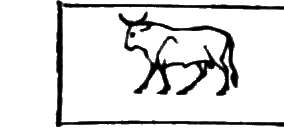 |
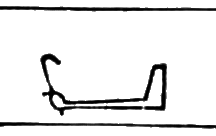 |
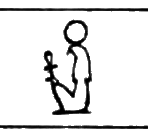 |
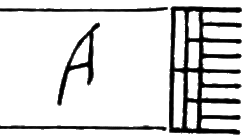 |
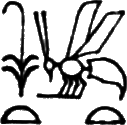 |
| Ḥor-pet | qa | nekht | Râ | mer | suten-kaut? |
| The heavenly Horus · | bull · | powerful · | Râ · | beloved · | king of Upper and Lower Egypt · |
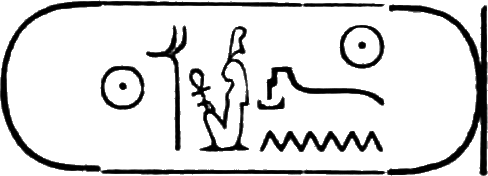 |
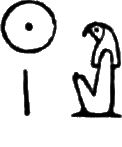 |
 |
 |
 |
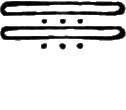 |
| User-Mâ-Râ-sotep-en-Râ | Râ | meses | nuteru | ger | taui |
| Ramses II. · | the Sun · | born of · | the gods · | possessing · | the two countries · |
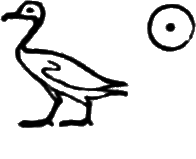 |
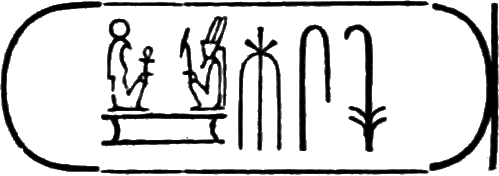 |
 |
| sa Râ | Ȧmen-mer-Râ-meses-su | .......... |
| the son of Râ · | Ramses II. · | .......... illegible! .......... |
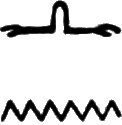 |
 |
 |
 |
 |
 |
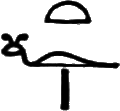 |
 |
 |
 |
| nen | ȧr | ȧr· | f | em | per | tef· | f | neb | taui |
| not · | (was) done · | (what) did · | he · | in · | the house of · | father · | his · | lord of · | the two countries · |
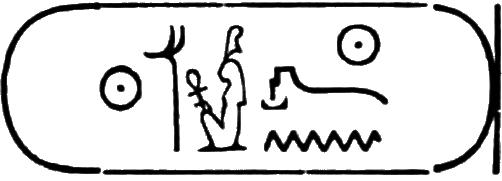 |
 |
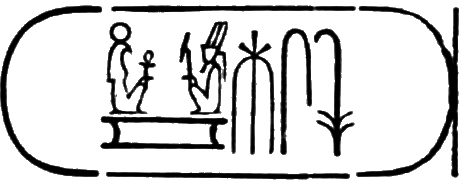 |
 |
 |
| User-Mâ-Râ-sotep-en-Râ sa Râ Ȧmen-mer-Râ-meses-su | du | ânkh | ||
| Ramses II. · | son of Râ · | Ramses II. · | giving · | life. |
 |
 |
 |
 |
 |
| Ḥor-pet | qa | nekht | Râ | mer |
| The heavenly Horus · | bull · | powerful · | Râ · | beloved · |
 |
 |
 |
| suten-kaut? | User-Mâ-Râ-sotep-en-Râ | Râ |
| king of Upper and Lower Egypt · |
Ramses II. · | the Sun · |
 |
 |
 |
 |
 |
| meses | nuteru | ger | taui | sa Râ |
| born of · | the gods · | possessing · | the two countries · |
the son of Râ · |
 |
 |
| Ȧmen-mer-Râ-meses-su | .......... |
| Ramses II. · | .......... illegible! .......... |
 |
 |
 |
 |
 |
 |
| nen | ȧr | ȧr· | f | em | per |
| not · | (was) done · | (what) did · | he · | in · | the house of · |
 |
 |
 |
 |
 |
| tef· | f | neb | taui | User-Mâ-Râ-sotep-en-Râ |
| father · | his · | lord of · | the two countries · |
Ramses II. · |
 |
 |
 |
 |
| sa Râ | Ȧmen-mer-Râ-meses-su | du | ânkh |
| son of Râ · | Ramses II. · | giving · | life. |
i. e. Behold Pharaoh! He is the heavenly Horus, the powerful bull, beloved of Rā. He is Ramses II., the king of Upper and Lower Egypt, who is the Sun himself and child of the gods. He is master of the two countries [Egypt], the Sun's offspring, Ramses II. .......... No one has done what he did in his father's [Tum's] house. He is the lord of the two countries [Egypt], Ramses II., the Sun's offspring, Ramses II., who gives life.
West Face [SOUTHERN COLUMN].
 |
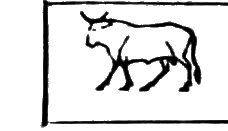 |
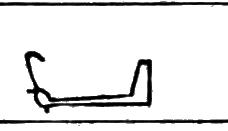 |
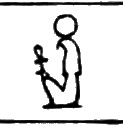 |
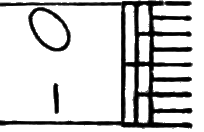 |
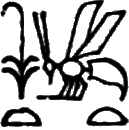 |
| Ḥor-pet | qa | nekht | Râ | sa | suten-kaut? |
| The heavenly Horus · | bull · | powerful · | Râ's · | son · | king of Upper and Lower Egypt · |
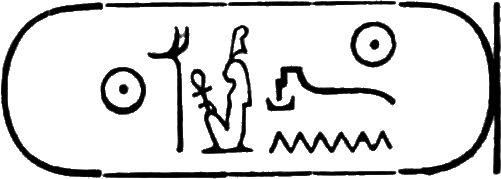 |
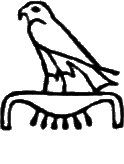 |
 |
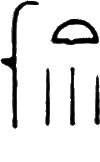 |
 |
 |
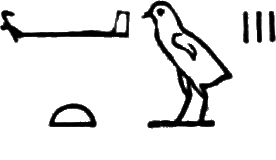 |
| User-Mâ-Râ-sotep-en-Râ | Ḥor-nub | user | renpe·tu | â | en | nekhtu |
| Ramses II. · | the golden Horus · | abounding in · | years · | great · | in · | victories · |
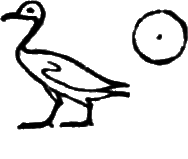 |
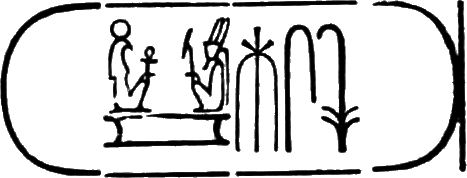 |
 |
| sa Râ | Ȧmen-mer-Râ-meses-su | .......... |
| son of Râ · | Ramses II. · | .......... illegible! .......... |
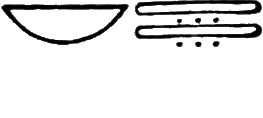 |
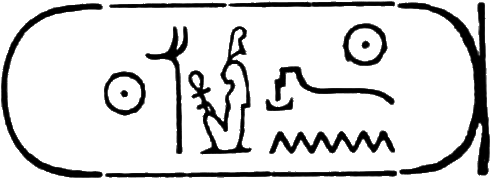 |
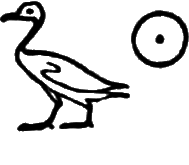 |
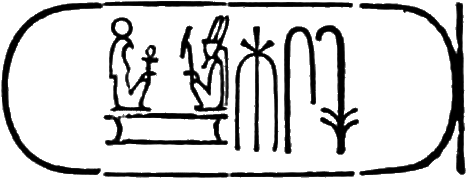 |
 |
| neb taui | User-Mâ-Râ-sotep-en-Râ sa Râ Ȧmen-mer-Râ-meses-su ma Râ | |||
| lord of the two countries · Ramses II. · | son of Râ · | Ramses II. · | to-day. | |
 |
 |
 |
 |
 |
| Ḥor-pet | qa | nekht | Râ | sa |
| The heavenly Horus · | bull · | powerful · | Râ's · | son · |
 |
 |
 |
| suten-kaut? User-Mâ-Râ-sotep-en-Râ | Ḥor-nub | |
| king of Upper and Lower Egypt · |
Ramses II. · | the golden Horus · |
 |
 |
 |
 |
 |
 |
| user | renpe·tu | â | en | nekhtu | sa Râ |
| abounding in · | years · | great · | in · | victories · | son of Râ · |
 |
 |
| Ȧmen-mer-Râ-meses-su | .......... |
| Ramses II. · | .......... illegible! .......... |
 |
 |
| neb taui | User-Mâ-Râ-sotep-en-Râ |
| lord of the two countries · | Ramses II. · |
 |
 |
 |
| sa Râ | Ȧmen-mer-Râ-meses-su | ma Râ |
| son of Râ · | Ramses II. · | to-day. |
i. e. Behold Pharaoh! He is the heavenly Horus, the powerful bull, the son of Rā. He is Ramses II., the king of Upper and Lower Egypt, the golden Horus, who abounds in years and is great in victories. He is the Sun's offspring, Ramses II., .......... He is the lord of the two countries [Egypt], Ramses II., the Sun's offspring, Ramses II., now and forever.
North Face [EASTERN COLUMN].
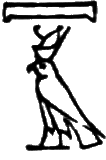 |
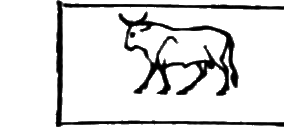 |
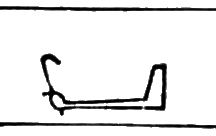 |
 |
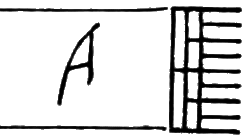 |
 |
| Ḥor-pet | qa | nekht | Mâ | mer | suten-kaut? |
| The heavenly Horus · | bull · | powerful · | Mâ · | beloved · | king of Upper and Lower Egypt · |
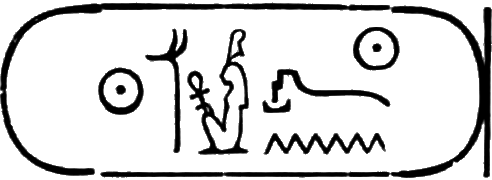 |
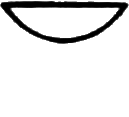 |
 |
 |
 |
 |
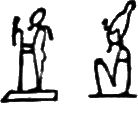 |
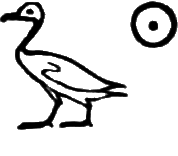 |
| User-Mâ-Râ-sotep-en-Râ | neb | ḥebu | mȧ | tef· | f | Ptaḥ | sa Râ |
| Ramses II. · | lord of · | festivals · | like · | father · | his · | Ptah · | son of Râ · |
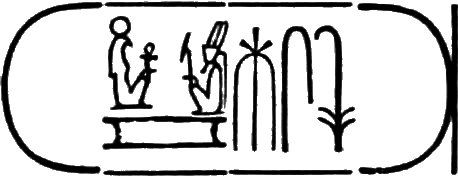 |
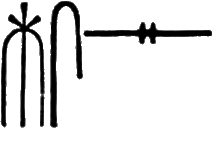 |
 |
 |
 |
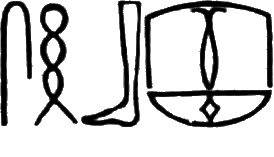 |
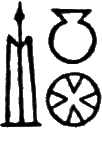 |
| Ȧmen-mer-Râ-meses-su | meses | en | Râ | er | s·ḥeb | Ȧn |
| Ramses II. · | begotten · | by · | Râ · | in order to · | cause to be glad · | Heliopolis · |
 |
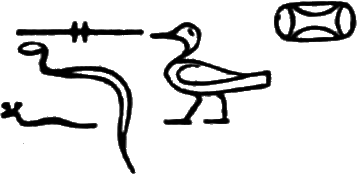 |
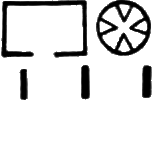 |
 |
 |
 |
 |
| er | s·zef | peru | meses | su | neb | taui |
| in order to · | cause to be filled · | the sanctuaries · | begetting · | himself · | lord of · | the two countries · |
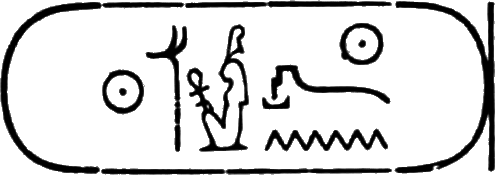 |
 |
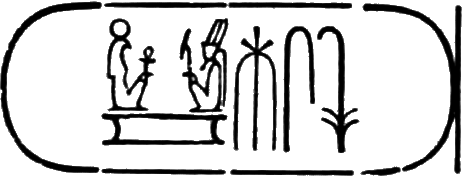 |
 |
| User-Mâ-Râ-sotep-en-Râ sa Râ Ȧmen-mer-Râ-meses-su | du | ||
| Ramses II. · | the son of Râ · | Ramses II. · | giving · |
 |
 |
 |
| ânkh | neb | ma Râ |
| life · | all · | to-day (literally: like Râ). |
 |
 |
 |
 |
 |
| Ḥor-pet | qa | nekht | Mâ | mer |
| The heavenly Horus · | bull · | powerful · | Mâ · | beloved · |
 |
 |
 |
| suten-kaut? | User-Mâ-Râ-sotep-en-Râ | neb |
| king of Upper and Lower Egypt · |
Ramses II. · | lord of · |
 |
 |
 |
 |
 |
 |
| ḥebu | mȧ | tef· | f | Ptaḥ | sa Râ |
| festivals · | like · | father · | his · | Ptah · | son of Râ · |
 |
 |
 |
 |
 |
| Ȧmen-mer-Râ-meses-su | meses | en | Râ | er |
| Ramses II. · | begotten · | by · | Râ · | in order to · |
 |
 |
 |
 |
| s·ḥeb | Ȧn | er | s·zef |
| cause to be glad · | Heliopolis · | in order to · | cause to be filled · |
 |
 |
 |
 |
 |
| peru | meses | su | neb | taui |
| the sanctuaries · | begetting · | himself · | lord of · | the two countries · |
 |
 |
 |
| User-Mâ-Râ-sotep-en-Râ sa Râ Ȧmen-mer-Râ-meses-su | ||
| Ramses II. · | the son of Râ · | Ramses II. · |
 |
 |
 |
 |
| du | ânkh | neb | ma Râ |
| giving · | life · | all · | to-day (literally: like Râ). |
i. e. Behold Pharaoh! He is the heavenly Horus, the powerful bull, beloved of Mā [Truth]. He is Ramses II., the king of Upper and Lower Egypt, the lord of the festivals like his father Ptah. He is the Sun's offspring, Ramses II., whom Rā has begotten in order to gladden Heliopolis and fill her sanctuaries with treasures. It is he who brought forth himself as lord of the two countries [Egypt], Ramses II., the Sun's offspring, Ramses II., who gives all life now and forever.
North Face [WESTERN COLUMN].
 |
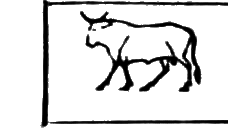 |
 |
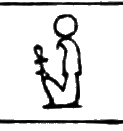 |
 |
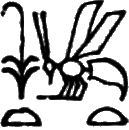 |
| Ḥor-pet | qa | nekht | Râ | sa | suten-kaut? |
| The heavenly Horus · | bull · | powerful · | Râ's · | son · | king of Upper and Lower Egypt · |
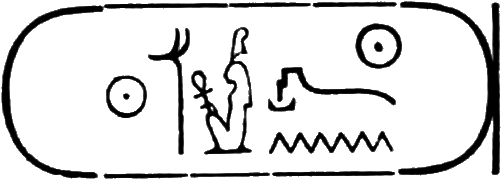 |
 |
 |
| User-Mâ-Râ-sotep-en-Râ | neb mut or sheta | neb ârâ or meḥen·t |
| Ramses II. · | lord of the Vulture diadem · | lord of the Uræus-snake diadem · |
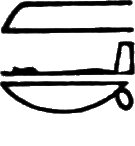 |
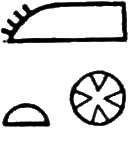 |
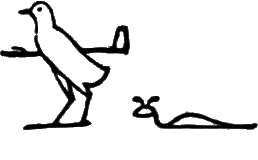 |
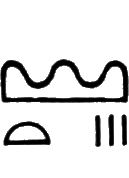 |
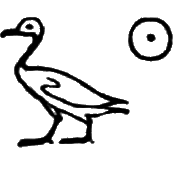 |
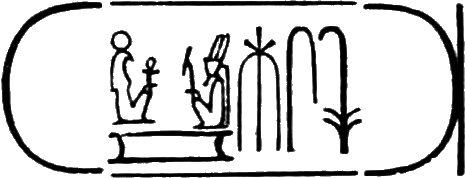 |
| mâk | Qem·t | uâf | men·tu? | sa Râ | Ȧmen-mer-Râ-meses-su |
| protector of · | Egypt · | smiter of · | the countries · | son of Râ · | Ramses II. · |
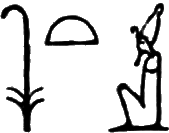 |
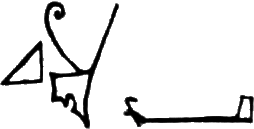 |
 |
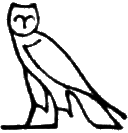 |
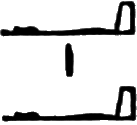 |
 |
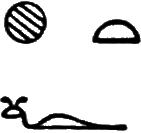 |
 |
 |
 |
| suten | qen | ȧr | em | dedui· | f | khatf | ḥer | ta | neb |
| king · | triumph · | made · | at · | the two hands · | his · | in · | the face of · | the land · | all · |
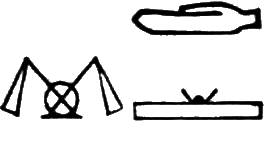 |
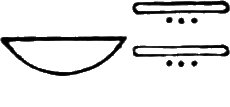 |
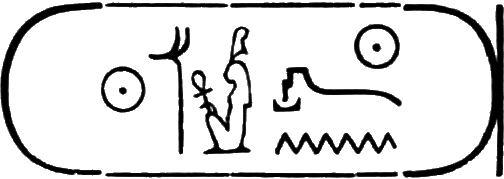 |
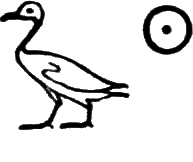 |
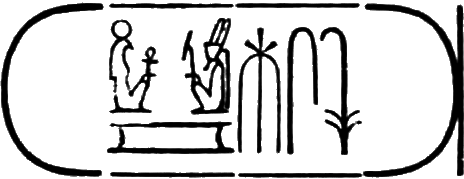 |
| dem | neb taui | User-Mâ-Râ-sotep-en-Râ sa Râ Ȧmen-mer-Râ-meses-su | ||
| entire · | lord of the two countries · Ramses II. · | son of Ra · | Ramses II. · | |
 |
 |
 |
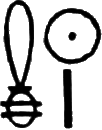 |
| du | ânkh | neb | ma Râ |
| giving · | life · | all · | to-day (literally: like Râ). |
 |
 |
 |
 |
 |
| Ḥor-pet | qa | nekht | Râ | sa |
| The heavenly Horus · | bull · | powerful · | Râ's · | son · |
 |
 |
| suten-kaut? | User-Mâ-Râ-sotep-en-Râ |
| king of Upper and Lower Egypt · | Ramses II. · |
 |
 |
 |
| neb mut or sheta | neb ârâ or meḥen·t | mâk |
| lord of the Vulture diadem · |
lord of the Uræus-snake diadem · |
protector of · |
 |
 |
 |
 |
| Qem·t | uâf | men·tu? | sa Râ |
| Egypt · | smiter of · | the countries · | son of Râ · |
 |
 |
 |
 |
 |
| Ȧmen-mer-Râ-meses-su | suten | qen | ȧr | em |
| Ramses II. · | king · | triumph · | made · | at · |
 |
 |
 |
 |
 |
 |
| dedui· | f | khatf | ḥer | ta | neb |
| the two hands · | his · | in · | the face of · | the land · | all · |
 |
 |
 |
 |
| dem | neb taui | User-Mâ-Râ-sotep-en-Râ | sa Râ |
| entire · | lord of the two countries · Ramses II. · | son of Ra · | |
 |
 |
 |
 |
 |
| Ȧmen-mer-Râ-meses-su | du | ânkh | neb | ma Râ |
| Ramses II. · | giving · life · all · | to-day (literally: like Râ). |
||
i. e. Behold Pharaoh! He is the heavenly Horus, the powerful bull, the son of Rā. He is Ramses II., the king of Upper and Lower Egypt, the lord of the Vulture and Uræus diadems, who protects Egypt and smites the foreign nations. He is the Sun's offspring, Ramses II., a king whose hands have done warlike deeds in full view of the entire world. He is the lord of the two countries [Egypt], Ramses II., the Sun's offspring, Ramses II., who gives all life now and forever.
The Base [EAST, SOUTH, WEST, NORTH].
At the bottom of each of the four faces of the obelisk are two horizontal lines of almost totally destroyed hieroglyphs. They bear the cartouches of Ramses II., and are so written as to read from the centre each way. The inscription is
i. e. Long life to the gracious god, Ramses II.!
i. e. Long life to the gracious god, Ramses II.!
i. e. Long life to the gracious god, Ramses II.!
i. e. Long life to the gracious god, Ramses II.!
III. Inscriptions of Osarkon I.
Besides the three columns of hieroglyphs on each face of our obelisk, all chiseled in large and bold characters, we find at the lower end of each face near each edge inscriptions by a later king. The hieroglyphs of these inscriptions are so minute and so mutilated as to be scarcely legible. They seem to have started at the first of the lower cartouches and to have extended to the two {72}horizontal lines at the bottom of the obelisk. As each face has two of these columns, there are eight of these inscriptions on the obelisk. The last half of the inscriptions is destroyed in each case and may have been different on every column. The eastern column on the south face is the most legible one and presumably reads thus
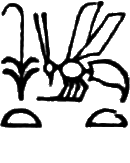 |
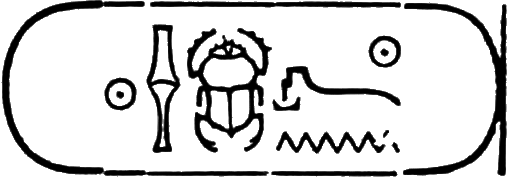 |
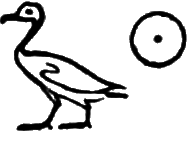 |
| suten-kaut? | kherp-kheper-Râ-sotep-en-Râ | sa Râ |
| The king of Upper and Lower Egypt · |
Osarkon I. · | the son of Râ · |
 |
 |
| Ȧmen-mer-Ûsarken | .......... |
| Osarkon I. · | ..........illegible!.......... |
i. e. The king of Upper and Lower Egypt, Osarkon I., the Sun's offspring, Osarkon I., ..........
IV. Inscriptions of Augustus.
There is no name of any other Egyptian ruler, except the three mentioned above, inscribed on our obelisk. When the emperor Augustus, however, had the London and New York Obelisks transported to Alexandria in 12 B. C., he caused his name to be engraved on the crabs which supported them. Only two of these crabs have come down to us and are preserved in the Metropolitan Museum of Art in Central Park. On the only remaining claw of one of the crabs are two inscriptions; on the one side in Greek and on the other in Latin, which give the names of the emperor, prefect or governor, and architect. Prof. Augustus Merriam of Columbia College has devoted some time to the study of these inscriptions and has made some very remarkable discoveries, which fix {73}the eighteenth year of the reign of Augustus as the time of the reërection of the London and New York Obelisks in Alexandria. The inscriptions are herewith given in fac-simile.
The Greek inscription reads
which looks like this in regular Greek types:
| L ΙΗ
ΚΑΙΣΑΡΟΣ ΒΑΡΒΑΡΟΣ ΑΝΕΘΗΚΕ ΑΡΧΙΤΕΚΤΟΝΟΥΝΤΟΣ ΠΟΝΤΙΟΥ |
In the year · 18 · of Cæsar Barbarus · erected (it). The architect being Pontius. |
i. e. The governor Barbarus erected this obelisk in the eighteenth year of the reign of the emperor Augustus (12 B. C.). Pontius was the architect.
The Latin inscription reads
which is in regular Latin types:
| ANNO XVIII CÆSARIS BARBARVS PRÆF ÆGYPTI POSVIT ARCHITECTANTE PONTIO |
In the year · 18 · of Cæsar Barbarus · the prefect of Egypt · erected (it). The architect being · Pontius. |
i. e. Barbarus, governor of Egypt, erected this obelisk in the eighteenth year of the reign of the emperor Augustus (12 B. C.). Pontius was the architect.
The Greek letter Psi (Ψ) in the first line of the Latin text seems to have been the initial of the engraver's name, who must have been a Greek, if we can draw this inference from the beautiful Greek and the poor Latin form of the letters in the inscriptions.
The full translation of the obelisk.
As a recapitulation of the translation of the Egyptian inscriptions on our obelisk, which has been given in the preceding pages, we now place the complete translation of each face of the obelisk in a very compact and simple form before our readers. The English translation will be found to correspond to the hieroglyphs, and each word can be easily picked out on the three columns of the original. All the words in Italics are to be found in the Egyptian text, while those in common Roman types are supplied so as to render the inscriptions intelligible to the reader.
Notes on the translation and the crabs.
§1. On looking over the translation of our obelisk, as set forth in the preceding pages, the reader will perhaps feel disappointed in the substance of its inscriptions. These contain, as has already been stated, only laudatory phrases and vainglorious titles, and furnish us with no historical data nor anything that would be of value to scholars. People have for many centuries suspected them of an utterly different meaning, and have given them the most fanciful and ludicrous explanations. For instance, Athanasius Kircher in his "Œdipus" (published in 1650), when speaking of our obelisk, says: "It [the New York Obelisk] sets forth the activity and functions of the twelve solar genii in the world's government, which result from their protection and presence, and with what rites and ceremonies each of them must be propitiated; for each in his tour around each of the four sides keeps watch over his particular quarter of the world, which he both guards against the attack of the evil genii and preserves". All this, of course, is sheer nonsense. Besides this ridiculous explanation Kircher mentions that at the base of our obelisk were engraved the words مسلة فرعون "Pharaoh's Needle", which is both improbable and impossible, though, as a matter of fact, the obelisk always went by that name among the Arabs.
The most silly guess at a translation, however, is probably that of the Mohammedan writer Ibn-el-Vardi, who visited Alexandria and saw our obelisk there in 1340. He writes of it as follows:
"This is on it [the obelisk]: 'I, Yaﻋmer-ben-Shaddād, have founded this city, when old age did not yet overtake nor death disturb nor gray hairs trouble me, when stones were here in abundance, and men did not acknowledge masters. I have built its porticoes, and dug its canals, and planted its trees, and desired to embellish it with wonderful monuments and amazing structures. I have sent my servant El·Thabūt-ben-Marrat, the ﻋAdite, and Maqdām-ibn-El·ﻋAmr-ben-abī-Reﻋāl, the Thamūdite, the caliph, to Mount Tarīm, the red mountain, and they cut out of it two rocks and carried them both on their shoulders. Then one of the ribs of El·Thabūt having been crushed, I caused the people of my kingdom to make reparation. Now these two [obelisks] were erected for me by El·Fatan-ibn-Jārūd, the Mūtafakite, on an auspicious day.'"
The same writer then states: "And this is the very obelisk which is in the corner of the city looking toward the East, while the other is seen further in the interior of the city."
This translation of our obelisk reads very strange and was, of course, only drawn by that ancient author from his own fertile imagination. Still it shows how much importance was even at that early time attached to our monolith. Almost every traveler of note mentions it and gives a description of it. All their scattered notices help us to trace the history of our obelisk through the last few centuries, without, however, our gaining any new or important knowledge from them.
Note. It may be of some interest to know that all the old writers agree in calling the erect obelisk in Alexandria "Cleopatra's Needle"; in other words, this epithet was only applied to the New York Obelisk in Central Park. The claim of the English that their obelisk in London was ever named after the famous queen rests on no foundation whatever.
§2. When the Romans transported our obelisk to Alexandria, its base was badly damaged. That it
might still be erected without planing off the surface of the stone, they filled up the cavities
with lead and put bronze crabs in the corners. The reason why they should have selected the crab
or scorpion ( ) cannot be definitely given. It may have been due to the strange superstition of
the Egyptians of the Ptolemaic period. The figure of the scorpion, the evil genius, plays an
important part in the astrological and mythological inscriptions of that time. From what the
Romans heard of this evil deity, and from a desire to propitiate it, they thought the crab the
most appropriate ornament for the obelisk. They wished to convey a double meaning; first, that the
obelisk, the emblem of the good god of light, should restrain and keep down the evil deity of
darkness, and secondly, they made it appear, in order to flatter the evil genius, as though it was
he who sustained the good god's throne and kept his {82}monument in proper position. Still, whatever the reason may have been, the
crabs are altogether out of place beneath our monolith.
) cannot be definitely given. It may have been due to the strange superstition of
the Egyptians of the Ptolemaic period. The figure of the scorpion, the evil genius, plays an
important part in the astrological and mythological inscriptions of that time. From what the
Romans heard of this evil deity, and from a desire to propitiate it, they thought the crab the
most appropriate ornament for the obelisk. They wished to convey a double meaning; first, that the
obelisk, the emblem of the good god of light, should restrain and keep down the evil deity of
darkness, and secondly, they made it appear, in order to flatter the evil genius, as though it was
he who sustained the good god's throne and kept his {82}monument in proper position. Still, whatever the reason may have been, the
crabs are altogether out of place beneath our monolith.
The crabs at present supporting the obelisk are new, and were cast at the Brooklyn Navy Yard. What is left of the old ones is preserved in the Metropolitan Museum of Art in Central Park (cf. page 72). The following inscriptions were engraved on the eight claws:
First crab, first claw:
| L. Η
ΚΑΙΣΑΡΟΣ ΒΑΡΒΑΡΟΣ ΑΝΕΘΗΚΕ ΑΡΧΙΤΕΚΤΟΝ ΟΥΝΤΟΣ ΠΟΝΤΙΟΥ |
ANNO VIII AVGVSTI CAESARIS BARBARVS PRAEF AEGYPTI POSVIT ARCHITECTANTE PONTIO |
First crab, second claw:
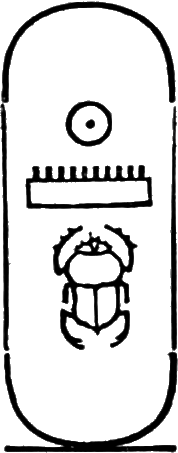 |
QUARRIED AT SYENE, EGYPT; ERECTED AT HELIOPOLIS, EGYPT, BY THOTHMES III IN THE SIXTEENTH CENTURY B. C. |
Second crab, first claw:
REMOVED TO ALEXANDRIA, EGYPT, AND ERECTED
THERE B. C. 22 BY THE ROMANS.
[The date should be B. C. 12. Cf. page 73.]
Second crab, second claw:
REMOVED TO THE UNITED STATES OF AMERICA A. D.
1880, AND ERECTED IN NEW YORK CITY JANUARY 22,
1881.
Third crab, first claw:
PRESENTED TO THE UNITED STATES GOVERNMENT
BY ISMAIL, KHEDIVE OF EGYPT.
Third crab, second claw:
RUTHERFORD BURCHARD HAYES, PRESIDENT; WILLIAM
MAXWELL EVARTS, SECRETARY OF STATE OF THE
UNITED STATES.
Fourth crab, first claw:
THE COST OF REMOVING FROM EGYPT AND PLACING
ON THIS SPOT THIS OBELISK, PEDESTAL, AND BASE,
WAS BORNE BY WILLIAM H. VANDERBILT.
Fourth crab, second claw:
LIEUTENANT-COMMANDER HENRY H. GORRINGE,
UNITED STATES NAVY, DESIGNED THE PLANS FOR AND
SUPERINTENDED THE REMOVAL AND RE-ERECTION.
Egypt: its geographical divisions and its cities.
Egypt, called by its former inhabitants  Qem·t, "the black
land", on account of the richness and color of its soil, and by the Greeks Αἴγυπτος
[Aiguptos], has been correctly and appropriately described by the ancients as "a gift of the river
Nile", which flows throughout its entire length. Lying between two vast tracts of desert land, and
encompassed by immense ranges of mountains, the Nile is its only source of life and means of
support. The country was divided from time immemorial into two large sections, Upper and Lower
Egypt. The Hebrew name of Egypt, מִצְרַיִם [Mizrayim],
being a dual form, forcibly reminds us of this division. These two sections were at various times
of Egyptian history independent principalities, and governed by different Pharaohs. Whenever the
two sections had one and the same ruler, he was always called
Qem·t, "the black
land", on account of the richness and color of its soil, and by the Greeks Αἴγυπτος
[Aiguptos], has been correctly and appropriately described by the ancients as "a gift of the river
Nile", which flows throughout its entire length. Lying between two vast tracts of desert land, and
encompassed by immense ranges of mountains, the Nile is its only source of life and means of
support. The country was divided from time immemorial into two large sections, Upper and Lower
Egypt. The Hebrew name of Egypt, מִצְרַיִם [Mizrayim],
being a dual form, forcibly reminds us of this division. These two sections were at various times
of Egyptian history independent principalities, and governed by different Pharaohs. Whenever the
two sections had one and the same ruler, he was always called  suten-kaut?, "the king of
Upper and Lower Egypt", Upper Egypt as the more important of the two always being mentioned
first. These sections were again subdivided into "nomes" (from the Greek word νομός [nomos] "a province"),
and each of them had its capital, governor, local deities, sacred animals, and sacred trees.
suten-kaut?, "the king of
Upper and Lower Egypt", Upper Egypt as the more important of the two always being mentioned
first. These sections were again subdivided into "nomes" (from the Greek word νομός [nomos] "a province"),
and each of them had its capital, governor, local deities, sacred animals, and sacred trees.
Upper Egypt, called by the Egyptians  pa ta res "the land of
the South", began in the south at the island of Philæ and extended as far as the Delta in the
north. It is called "Upper", being bounded by mountains and highlands, as opposed to the low land
of the north or "Lower" Egypt. This section of the country comprised 22 nomes. Following the
course of the Nile some of the principal places and cities are:
pa ta res "the land of
the South", began in the south at the island of Philæ and extended as far as the Delta in the
north. It is called "Upper", being bounded by mountains and highlands, as opposed to the low land
of the north or "Lower" Egypt. This section of the country comprised 22 nomes. Following the
course of the Nile some of the principal places and cities are:
Philæ, in Egyptian  Aareq·t or
Aareq·t or  Pireq, one of the southern
islands of the First Cataract, with the ruins of the magnificent temple of the goddess Isis, the
fragment of an obelisk, and other monumental structures.
Pireq, one of the southern
islands of the First Cataract, with the ruins of the magnificent temple of the goddess Isis, the
fragment of an obelisk, and other monumental structures.
Elephantine, in Egyptian 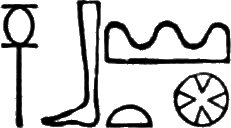 Âb·t "the ivory-island", the northernmost
island in the First Cataract, opposite the modern Assuân. On it was situated the capital bearing
the same name, Âb, with the famous Nilometer and a splendid temple of Khnum, the local
deity of the island.
Âb·t "the ivory-island", the northernmost
island in the First Cataract, opposite the modern Assuân. On it was situated the capital bearing
the same name, Âb, with the famous Nilometer and a splendid temple of Khnum, the local
deity of the island.
Syēne, in Egyptian  Sun·t, now Assuân, which was the site of the vast
quarries, from which were taken most of the obelisks and statues scattered throughout Egypt.
Sun·t, now Assuân, which was the site of the vast
quarries, from which were taken most of the obelisks and statues scattered throughout Egypt.
Ombos, in Egyptian 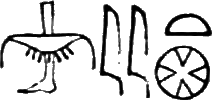 Nubi·t, "the gold-city", with the road
leading to the Nubian gold mines, was noted for its temple of the crocodile-headed god Sebek-Râ,
its local deity. The modern name is Kôm-Omboo.
Nubi·t, "the gold-city", with the road
leading to the Nubian gold mines, was noted for its temple of the crocodile-headed god Sebek-Râ,
its local deity. The modern name is Kôm-Omboo.
Silsilis, the old Egyptian  Khennu, "the sailor-city", is known for its
tombs which are cut into the mountain-side, its quarries, and its annual festivals in honor of
the rise of the Nile at the time of inundation. The modern name of this part of the country is
Jebel Selseleh.
Khennu, "the sailor-city", is known for its
tombs which are cut into the mountain-side, its quarries, and its annual festivals in honor of
the rise of the Nile at the time of inundation. The modern name of this part of the country is
Jebel Selseleh.
Redesieh, a modern village, was formerly the starting-point of an important road
leading to Asia and the Red Sea. On this road is a temple of Seti I. and a {87}famous well, 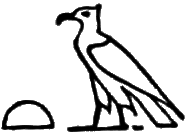
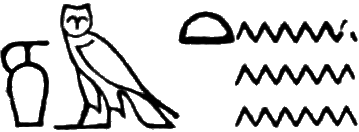
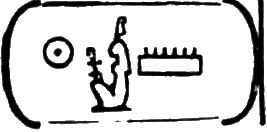 ta khnum·t Mâ-men-Râ "the well of Seti I.", constructed by order of the same
Pharaoh.
ta khnum·t Mâ-men-Râ "the well of Seti I.", constructed by order of the same
Pharaoh.
Edfu, in Egyptian  Deb·t, "the city of transfixion" (referring
to the legend of the battle between Horus and Set, the devil, in which the latter was pierced by
the avenging spear of the son of Osiris), was the renowned city of the sun-god Horus. Because of
his supreme worship it was also called
Deb·t, "the city of transfixion" (referring
to the legend of the battle between Horus and Set, the devil, in which the latter was pierced by
the avenging spear of the son of Osiris), was the renowned city of the sun-god Horus. Because of
his supreme worship it was also called  Ḥud·t "the city of the winged
sun-disk [
Ḥud·t "the city of the winged
sun-disk [ ]". Here are to be found in a tolerably good state of preservation some of the
grandest temple-buildings of Egypt. The temple of the hawk-faced sun-god, Horus, rivals in
magnificence that of any other god.
]". Here are to be found in a tolerably good state of preservation some of the
grandest temple-buildings of Egypt. The temple of the hawk-faced sun-god, Horus, rivals in
magnificence that of any other god.
El-Kab, near the ancient city of  Nekheb·t, the
Eileithyiapolis of the Greeks, contains the many dedicatory inscriptions to Nekheb, an otherwise
rarely mentioned goddess, and a number of tombs.
Nekheb·t, the
Eileithyiapolis of the Greeks, contains the many dedicatory inscriptions to Nekheb, an otherwise
rarely mentioned goddess, and a number of tombs.
Esneh, in Egyptian  Seni·t, was the seat of the Khnum-worship, and
still contains the ruins of the temple of the ram-headed god (
Seni·t, was the seat of the Khnum-worship, and
still contains the ruins of the temple of the ram-headed god ( ).
).
Heṙmonthis, in Egyptian 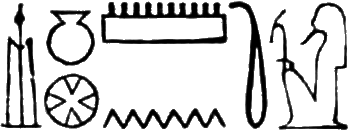 Ȧn-menth, the
modern village of Erment, was at one time a most important city of Egypt, surpassing even
Thebes. Now we find here only a few ruins of the temple of the sun-god Menthu, the local deity
of the place.
Ȧn-menth, the
modern village of Erment, was at one time a most important city of Egypt, surpassing even
Thebes. Now we find here only a few ruins of the temple of the sun-god Menthu, the local deity
of the place.
Thebes, in Egyptian  Us·t "the city of the Us-sceptre", or
Us·t "the city of the Us-sceptre", or 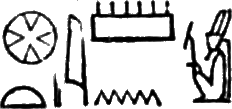 Nu·t Ȧmen "the city of the god Amen", was situated on the land
occupied at present by {88}the villages of Karnak and
Luxor on the east, and Drah-abul-Neggah, Dêr-el-baheri, Qurnah, Medinet-Habu, and others on the
west bank of the Nile. It was undoubtedly the largest city of the ancient world, and the
principal seat of the worship of Amen or Amen-Râ. During the greater part of Egyptian history it
was the capital of all Egypt. Nowhere on the face of the earth are so many ancient monuments
gathered together as here. Suffice it to mention the wonderful temples of Karnak and Luxor in
the city proper, which was called
Nu·t Ȧmen "the city of the god Amen", was situated on the land
occupied at present by {88}the villages of Karnak and
Luxor on the east, and Drah-abul-Neggah, Dêr-el-baheri, Qurnah, Medinet-Habu, and others on the
west bank of the Nile. It was undoubtedly the largest city of the ancient world, and the
principal seat of the worship of Amen or Amen-Râ. During the greater part of Egyptian history it
was the capital of all Egypt. Nowhere on the face of the earth are so many ancient monuments
gathered together as here. Suffice it to mention the wonderful temples of Karnak and Luxor in
the city proper, which was called  Ȧpiu·t "the city of thrones" (from
which with the prefixed feminine article ta the word "Thebes" is derived) and a number of
obelisks, and the Tombs of the Kings with their mausolea, especially the Memnonium of Ramses
II., the monster statues of Amenophis III., and many other monuments in western Thebes.
Ȧpiu·t "the city of thrones" (from
which with the prefixed feminine article ta the word "Thebes" is derived) and a number of
obelisks, and the Tombs of the Kings with their mausolea, especially the Memnonium of Ramses
II., the monster statues of Amenophis III., and many other monuments in western Thebes.
Coptos, in Egyptian  Qebti·t, the modern Kuft, at the end of the road
leading from Kossêr on the Red Sea, was formerly a place of great commercial activity, and
became a mart for the products of Arabia and the far East. On this road to Kossêr are the
extensive quarries of Hammamât, the ancient
Qebti·t, the modern Kuft, at the end of the road
leading from Kossêr on the Red Sea, was formerly a place of great commercial activity, and
became a mart for the products of Arabia and the far East. On this road to Kossêr are the
extensive quarries of Hammamât, the ancient 
 du en Bekhen "the
mountain of the bekhen-stone".
du en Bekhen "the
mountain of the bekhen-stone".
Denderah, in Egyptian  Ȧn·t, "the city of pillars", or
Ȧn·t, "the city of pillars", or  Ta-en-ta-rer·t, with the grand and well-preserved temple of Hathor,
Ta-en-ta-rer·t, with the grand and well-preserved temple of Hathor,  .
.
Abydos, in Egyptian  Ȧbdu or
Ȧbdu or 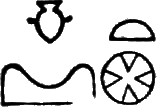 Ȧbdu·t, was especially famous for the temple of Seti I. Here also was said to be
the tomb of the god Osiris near which it was the highest honor to be buried.
Ȧbdu·t, was especially famous for the temple of Seti I. Here also was said to be
the tomb of the god Osiris near which it was the highest honor to be buried.
El-Khargeh, in Egyptian 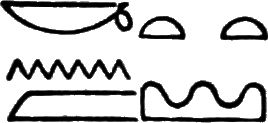 Kenem·ti, an oasis to the west of Thebes, at one
time belonging to the VIIth nome of Upper Egypt.
Kenem·ti, an oasis to the west of Thebes, at one
time belonging to the VIIth nome of Upper Egypt.
Thinis, in Egyptian 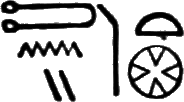 Theni·t, was according to tradition the home of
the first Egyptian Pharaoh, Menes. Its site is now probably occupied by the village of
El-Tineh.
Theni·t, was according to tradition the home of
the first Egyptian Pharaoh, Menes. Its site is now probably occupied by the village of
El-Tineh.
Panopolis, the Greek designation for the city called  Per-khem·t, "the city
of the temple of the god Khem", the modern Akhmîm, was the seat of the worship of Khem whose
festivals were conducted with various gymnastic exercises, especially that of climbing smooth
poles represented thus:
Per-khem·t, "the city
of the temple of the god Khem", the modern Akhmîm, was the seat of the worship of Khem whose
festivals were conducted with various gymnastic exercises, especially that of climbing smooth
poles represented thus:  .
.
Sioot, the modern name of the ancient  Saîu·t, is at present the
largest city of Upper Egypt. A number of rock-tombs are in the neighborhood. Its local deity was
the jackal-headed god Anubis.
Saîu·t, is at present the
largest city of Upper Egypt. A number of rock-tombs are in the neighborhood. Its local deity was
the jackal-headed god Anubis.
Tel-el-Amarna is the present site of a city founded by Amenophis IV., which he named
 khu en Ȧten, "the glorious house of the sun-god Aten". It was this king who
introduced the sole worship of the sun-disk and was ever after considered a heretic. Cf. the
picture on page 30.
khu en Ȧten, "the glorious house of the sun-god Aten". It was this king who
introduced the sole worship of the sun-disk and was ever after considered a heretic. Cf. the
picture on page 30.
Bersheh is a modern village with the remnants of some tombs. In one of them is the picture showing the mode of transporting a colossus (cf. page 15).
Beni-Hassan is noteworthy for its beautiful sepulchral grottoes of the XIIth dynasty.
The Fayoom is a large tract of fertile land {90}extending into the Libyan desert. It was called  ta sheti, "the land of the sea", and the present name is derived from the Coptic
word
ta sheti, "the land of the sea", and the present name is derived from the Coptic
word  [phiyom], "a
sea". In it was the world-famous Lake Mœris, which the Egyptians named
[phiyom], "a
sea". In it was the world-famous Lake Mœris, which the Egyptians named  mer ûr, "the great sea" (whence the name "Mœris"). This was really a large
reservoir constructed by Amenemhât III. Besides this we find here the ruins of the so-called
Labyrinth, the palace of the same king, not far from the pyramid of El-Lahoon. The Greeks called
the place Crocodilopolis from the crocodile-headed god Sebek, who was its local deity.
mer ûr, "the great sea" (whence the name "Mœris"). This was really a large
reservoir constructed by Amenemhât III. Besides this we find here the ruins of the so-called
Labyrinth, the palace of the same king, not far from the pyramid of El-Lahoon. The Greeks called
the place Crocodilopolis from the crocodile-headed god Sebek, who was its local deity.
Meydoom is situated on the site of the ancient  Mer-Tum·t, "the favorite city of the god Tum", and is famous for its quaintly
terraced pyramid.
Mer-Tum·t, "the favorite city of the god Tum", and is famous for its quaintly
terraced pyramid.
Lower Egypt, called by the Egyptians  ta meḥî·t, "the
land of the flax plant" or only simply
ta meḥî·t, "the
land of the flax plant" or only simply  meḥ·t, "the
north", comprises the so-called Delta from the city of Cairo to the Mediterranean Sea. The
Delta, intersected by the seven arms of the river Nile, was called
meḥ·t, "the
north", comprises the so-called Delta from the city of Cairo to the Mediterranean Sea. The
Delta, intersected by the seven arms of the river Nile, was called  pa
ta merȧ·t, "the land of the inundation", and was so named from its resemblance
to the Greek letter Delta, Δ, our D. It was composed of
20 nomes or provinces.
pa
ta merȧ·t, "the land of the inundation", and was so named from its resemblance
to the Greek letter Delta, Δ, our D. It was composed of
20 nomes or provinces.
The following are the principal cities of Lower Egypt:
Memphis, in Egyptian  Men-nefer·t, "the good place of rest",
which became in Coptic
Men-nefer·t, "the good place of rest",
which became in Coptic  [Memphi], has left us hardly any vestige of its former greatness. It was the capital of Lower
Egypt and the main seat of the worship of the god Ptah. Nothing remains to mark the site of the
famous Memphis of old {91}except the colossus of Ramses
II. at the village of Mîtrahîneh and the mighty pyramids. The latter consist of the following
groups: 1) the three great Pyramids, namely, the Great Pyramid, "the Splendid", of king Kheops;
the Second Pyramid, "the Great", of king Khefren; the Third Pyramid, "the Superior", of king
Mycerinus: all these being at Gizeh: 2) the Pyramids of Abûsîr, four in number; 3) the Pyramids
of Saccarah, the largest of which is called the Pyramid of the Steps on account of its strange
form; 4) the Pyramids of Lisht and Dashûr. These pyramids served as mausolea or tombs of the
kings who erected them. The stones of ancient Memphis were converted into building-stones for
modern Cairo.
[Memphi], has left us hardly any vestige of its former greatness. It was the capital of Lower
Egypt and the main seat of the worship of the god Ptah. Nothing remains to mark the site of the
famous Memphis of old {91}except the colossus of Ramses
II. at the village of Mîtrahîneh and the mighty pyramids. The latter consist of the following
groups: 1) the three great Pyramids, namely, the Great Pyramid, "the Splendid", of king Kheops;
the Second Pyramid, "the Great", of king Khefren; the Third Pyramid, "the Superior", of king
Mycerinus: all these being at Gizeh: 2) the Pyramids of Abûsîr, four in number; 3) the Pyramids
of Saccarah, the largest of which is called the Pyramid of the Steps on account of its strange
form; 4) the Pyramids of Lisht and Dashûr. These pyramids served as mausolea or tombs of the
kings who erected them. The stones of ancient Memphis were converted into building-stones for
modern Cairo.
Tura, the present site of the quarries of Memphis from which the stone for the pyramids was taken. It received the name of Troja [Troy] from the Greeks.
Heliopolis, the ancient  Ȧn and the modern Matarîyeh, was the famous
city of the Sun or the "City of Obelisks". Here stood the New York Obelisk in front of the
temple of the Sun [Râ]. The only monument to be seen there still is the obelisk of Usertesen
I.
Ȧn and the modern Matarîyeh, was the famous
city of the Sun or the "City of Obelisks". Here stood the New York Obelisk in front of the
temple of the Sun [Râ]. The only monument to be seen there still is the obelisk of Usertesen
I.
Alexandria, the famous city founded by Alexander the Great on the site of the ancient
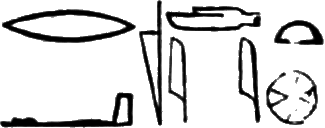 Râqedî·t, the Rhakôtis of the Greeks, is situated near the north-west corner of Egypt. To
the south of it is the Lake Mareotis, in Egyptian
Râqedî·t, the Rhakôtis of the Greeks, is situated near the north-west corner of Egypt. To
the south of it is the Lake Mareotis, in Egyptian 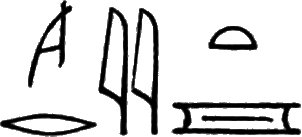 Merî·t. Alexandria can
boast of no ancient monument whatever, as its two obelisks have been conveyed to London and New
York, and Pompey's Pillar is not of Egyptian workmanship.
Merî·t. Alexandria can
boast of no ancient monument whatever, as its two obelisks have been conveyed to London and New
York, and Pompey's Pillar is not of Egyptian workmanship.
Rosetta is a considerable town at the mouth of the Rosetta branch of the Nile. Its world-wide fame is due {92}to the fact that here a French engineer, Boussard, discovered in 1799 the stone which furnished the key for the interpretation of the Egyptian hieroglyphs.
Sais, in Egyptian 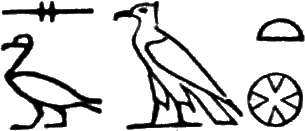 Sa·t, whose site is at present marked by the lofty
mounds of Sa-el-Hajar, was the seat of the worship of the goddess Neith, and the capital of all
Egypt under three dynasties of kings.
Sa·t, whose site is at present marked by the lofty
mounds of Sa-el-Hajar, was the seat of the worship of the goddess Neith, and the capital of all
Egypt under three dynasties of kings.
Busiris, in Egyptian 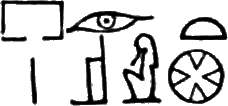 Per-Usȧr·t, "the house of Osiris",
now Abu-Sîr, was situated on the Damietta branch of the Nile and had Osiris for its local
deity.
Per-Usȧr·t, "the house of Osiris",
now Abu-Sîr, was situated on the Damietta branch of the Nile and had Osiris for its local
deity.
Tanis, in Egyptian  Zân·t, was situated to the south of Lake Menzaleh.
At present there are only a few remnants of the many magnificent temples left to mark the site
of that ancient city. It was the favorite residence of the Shepherd Kings or Hyksos.
Zân·t, was situated to the south of Lake Menzaleh.
At present there are only a few remnants of the many magnificent temples left to mark the site
of that ancient city. It was the favorite residence of the Shepherd Kings or Hyksos.
Mendes, in Egyptian  Per-ba-neb-ded·t, "the house of the ram, the
lord of stability", was the seat of government under one dynasty of kings. Its sacred animal
was the ram, which was the Egyptian emblem of the soul.
Per-ba-neb-ded·t, "the house of the ram, the
lord of stability", was the seat of government under one dynasty of kings. Its sacred animal
was the ram, which was the Egyptian emblem of the soul.
Bubastis, in Egyptian 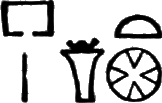 Per-Bas·t, was the principal seat of the worship
of the lion-faced goddess Bast or Pasht (
Per-Bas·t, was the principal seat of the worship
of the lion-faced goddess Bast or Pasht ( ). The ruins of her grand temple
can still be partially seen near the present Tel-Basta.
). The ruins of her grand temple
can still be partially seen near the present Tel-Basta.
Pelusium lies at the mouth of the most easterly branch of the Nile and was
built either on or else near the site of the ancient Avaris, the Egyptian  Ḥa·t-ûar·t. This was the last stronghold of the Hyksos before they were driven out
of Egypt.
Ḥa·t-ûar·t. This was the last stronghold of the Hyksos before they were driven out
of Egypt.
A GLOSSARY
OF NAMES AND TERMS OCCURRING IN THIS BOOK AND PERTAINING TO EGYPTOLOGICAL SUBJECTS.
The small numerals at the end of each item refer to the pages of the book.
Aareq·t. The Egyptian name of the island of Philæ. 86
Âb, Âb·t, or Âbu·t. The Egyptian name of the city and island of Elephantine. 24 86
Ȧbdu or Ȧbdu·t. The Egyptian name of Abydos. 88
Abusimbel. Also called Ipsambul. The ancient Aboccis or Abuncis. A place in Nubia, situated on the Nile, and famous for its stupendous rock-temple of Ramses II., the largest in the world. Each of the four statues at the entrance represents the king himself, and is about seventy feet high. 27
Abûsîr. A village near the site of ancient Memphis. Here we find four pyramids, one built by Sahurâ, and another by Userenrâ, kings of the vth dynasty. This place must not be confounded with that of the same name in the Delta. 91
Abu-Sîr. The modern name of the ancient Busiris. 92
Abydos [pronounced ábĭdos]. The capital of the VIIIth nome of Upper Egypt. 88
A. D. The Latin Anno Domini "in the year of our Lord".
ﻋÂdite. A person belonging to the ancient Arabic tribe of Âd. [The first sign ﻋ is an Arabic gutteral which cannot be pronounced in English.] 80
Akhmîm. The present site of the ancient Panopolis. 89
Albani Obelisk. A small obelisk of Roman workmanship, formerly in the Villa Albani near
Rome, and at {94}present preserved in the
Glyptothek at Munich, Germany. On it and its companion in Naples, the Borgian Obelisk, we
read the Roman names Tacitus (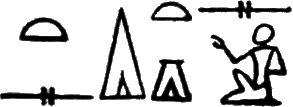 ), Sextus (
), Sextus (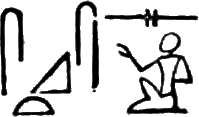 ), and Africanus (
), and Africanus ( ). It
was probably erected in the time of Domitian. 10
). It
was probably erected in the time of Domitian. 10
Alexander the Great, or Alexander III. The son of Philip II., king of Macedon. He was born B. C. 356 and died B. C. 323, and was one of the greatest military conquerors the world has ever seen. His triumphant entry into Egypt took place in 332, when he was welcomed by the Egyptians as their liberator from the Persian yoke. He died while preparing for an expedition against Arabia. His name in Egyptian is 32 91
 |
 |
 |
 |
| suten-kaut? | Ȧmen-mer-sotep-en-Râ | sa Râ | Aleksāndres |
| The king of Upper and Lower Egypt, |
"The beloved of Amen, the chosen of the Sun", |
the Sun's offspring, |
Alexander. |
 |
 |
| suten-kaut? | Ȧmen-mer-sotep-en-Râ |
| The king of Upper and Lower Egypt, |
"The beloved of Amen, the chosen of the Sun", |
 |
 |
| sa Râ | Aleksāndres |
| the Sun's offspring, |
Alexander. |
Alexandria. The modern name of Rhakôtis, founded by Alexander the Great in B. C. 332. Its main attractions were the tomb of Alexander, the palace of the Ptolemies, a museum, the temple of Serapis (a Græco-Egyptian deity, a combination of Osiris and the bull Apis), the world-famous Library, and the Pharos or light-house, which was 400 feet high and one of the seven wonders of the world. The city flourished until the Mohammedans gained possession of it A. D. 650. On December 22d of that year the Library was burned by Amru, the general of the caliph Omar. All antiquities in the city were then destroyed except the two obelisks and Pompey's Pillar, which have come down to us, the latter, however, being the only object of interest still in Alexandria. The city at present has nothing to attract the antiquarian as it is altogether too modern in appearance. 8 39 40 41 42 43 72 73 79 81 82 91
Alexandrian Obelisk. The former name of the obelisk at present in London. It was the prostrate one at Alexandria, which had been presented to the English as early as 1820, but was removed in 1877, arriving in London on January 20, 1878. The money for its removal, amounting to £10 000, was furnished by Prof. Erasmus Wilson, of London. 8 10 41 81
Alnwick Castle Obelisk. Perhaps the same as the Sion House Obelisk. It was erected by Amenophis II., and only one face bears an inscription. It was brought to England in 1840.—Alnwick Castle is situated to the north-west of the town of Alnwick in Northumberland, England. 10
Ȧmen. In Egyptian  Ȧmen, "the hidden god". The Latinized
form is Ammon. He was the tutelary god of Thebes, and was addressed as "the king of the
gods". As such the Romans identified him with their Jupiter. He was worshiped only in Upper
Egypt, and is represented on the monuments with a head-dress of two plumes or feathers, called
shenti; thus
Ȧmen, "the hidden god". The Latinized
form is Ammon. He was the tutelary god of Thebes, and was addressed as "the king of the
gods". As such the Romans identified him with their Jupiter. He was worshiped only in Upper
Egypt, and is represented on the monuments with a head-dress of two plumes or feathers, called
shenti; thus 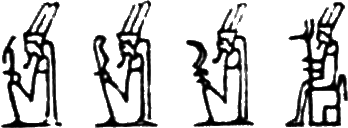 . Although at first the invisible or hidden deity, he was afterwards merged into
Amen-Râ (which see). 35 63 87 88
. Although at first the invisible or hidden deity, he was afterwards merged into
Amen-Râ (which see). 35 63 87 88
Ȧmenemḥât III. A powerful king of the XIIth dynasty. To guard against a time of drought and excessive inundation, he converted the Fayoom into a vast reservoir of fresh water, which was known to the ancients as Lake Mœris. Besides this he built two pyramids and a palace, the so-called Labyrinth, near this lake. His name in Egyptian is 90
 |
 |
 |
 |
| suten-kaut? | Râ-en-Mâ·t | sa Râ | Ȧmen-em-ḥâ·t |
| The king of Upper and Lower Egypt, |
"The Sun of Truth", |
the Sun's offspring, |
"Resolute of purpose". |
 |
 |
| suten-kaut? | Râ-en-Mâ·t |
| The king of Upper and Lower Egypt, |
"The Sun of Truth", |
 |
 |
| sa Râ | Ȧmen-em-ḥâ·t |
| the Sun's offspring, |
"Resolute of purpose". |
Ȧmen-mer-Râ-meses-su. The family name of Ramses II. 7 62 63 64 65 66 67 68 69 70 71
Ȧmen-mer-Ûsarken. The family name of Osarkon I. 38 72
Ȧmenôphis II. A king of the XVIIIth dynasty, the son and successor of Thothmes III. He reigned for about seven years, at one time besieged Nineveh, made an expedition into Mesopotamia, and conquered the desert-tribes of Asia. His tomb is at Abd-el-Qurnah in Thebes. In Egyptian his name reads 6 10
 |
 |
| suten-kaut? | Râ-â-kheperu |
| The king of Upper and Lower Egypt, |
"The Sun, great in transformations", |
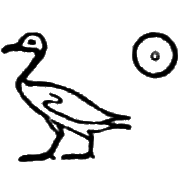 |
 |
| sa Râ | Ȧmen-ḥotep-nuter-ḥeq-Ȧn |
| the Sun's offspring, |
"The peace of Amen, the god, the prince of Heliopolis". |
Ȧmenôphis III. The successor of Thothmes IV, a king of the XVIIIth dynasty, a great warrior, a bold lion-hunter, and the builder of the two large figures (colossi) of himself in the desert to the west of Thebes, one of which was called by the Greeks the Vocal Memnon. His name in Egyptian is written 16 88
 |
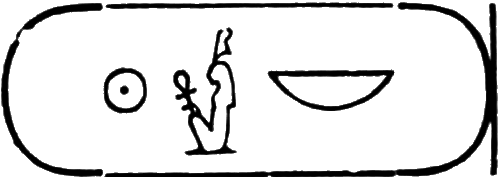 |
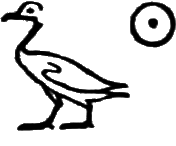 |
 |
| suten-kaut? | Râ-Mâ-neb | sa Râ | Ȧmen-ḥotep-ḥeq-Us |
| The king of Upper and Lower Egypt, |
"The Sun, the lord of Truth", |
the Sun's offspring, |
"The peace of Amen, the prince of Thebes". |
 |
 |
| suten-kaut? | Râ-Mâ-neb |
| The king of Upper and Lower Egypt, |
"The Sun, the lord of Truth", |
 |
 |
| sa Râ | Ȧmen-ḥotep-ḥeq-Us |
| the Sun's offspring, |
"The peace of Amen, the prince of Thebes". |
Ȧmenôphis IV. A king of the xviiith dynasty, the son and successor of Amenophis III. The worship of the Sun under the form of Ȧten or Ȧten-Râ was forcibly introduced by him. His temple at Tel-el-Amarna was torn down by his successors, who considered him a heretic. His name in Egyptian is 29 30
 |
 |
| suten-kaut? | Râ-nefer-kheperu-uâ-en-Râ |
| The king of Upper and Lower Egypt, |
"The Sun, beautiful in transformations, the one Sun", |
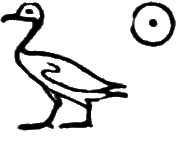 |
 |
| sa Râ | Ȧmen-ḥotep-nuter-ḥeq-Us |
| the Sun's offspring, |
"The peace of Amen, the god, the prince of Thebes." |
This he changed, after introducing the Aten-worship, to
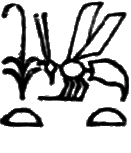 |
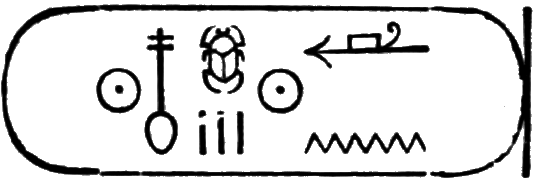 |
 |
 |
| suten-kaut? | Râ-nefer-kheperu-uâ-en-Râ | sa Râ | Khu-en-Ȧten |
| The king of Upper and Lower Egypt, |
"The Sun, beautiful in transformations, the one Sun", |
the Sun's offspring, |
"The glory of Aten". |
 |
 |
| suten-kaut? | Râ-nefer-kheperu-uâ-en-Râ |
| The king of Upper and Lower Egypt, |
"The Sun, beautiful in transformations, the one Sun", |
 |
 |
| sa Râ | Khu-en-Ȧten |
| the Sun's offspring, |
"The glory of Aten". |
Ȧmen-Râ. In Egyptian 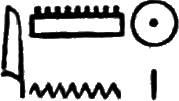 Ȧmen-Râ, "the hidden Sun". The supreme
deity of the Egyptians and really identical with the sun-god Râ. Before the time of the XVIIIth dynasty he was worshiped as Ȧmen simply, and
especially at Thebes. Some of the grandest hymns in the Egyptian literature are addressed to this
god. In painted inscriptions his body is generally colored light-blue. Cf. above under Amen.
29 37 88
Ȧmen-Râ, "the hidden Sun". The supreme
deity of the Egyptians and really identical with the sun-god Râ. Before the time of the XVIIIth dynasty he was worshiped as Ȧmen simply, and
especially at Thebes. Some of the grandest hymns in the Egyptian literature are addressed to this
god. In painted inscriptions his body is generally colored light-blue. Cf. above under Amen.
29 37 88
Ȧmenti. In Egyptian  Ȧmenti, "the concealed land", and
undoubtedly related to
Ȧmenti, "the concealed land", and
undoubtedly related to 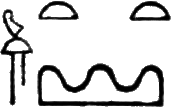 Ȧmenti, "the West", as the Egyptians
thought that the Lower World lay toward the west where the sun set. It is the region below the
earth or Hades, where the departed spirits assembled, and was said to be the dominion of the god
Osiris. It was divided into "the field of the blessed", called
Ȧmenti, "the West", as the Egyptians
thought that the Lower World lay toward the west where the sun set. It is the region below the
earth or Hades, where the departed spirits assembled, and was said to be the dominion of the god
Osiris. It was divided into "the field of the blessed", called  Ȧanuru or
Ȧaḥlu (the Greek Elysium), "the place of rest", called
Ȧanuru or
Ȧaḥlu (the Greek Elysium), "the place of rest", called 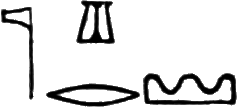 Kher-nuter, and "the place of the condemned", called
Kher-nuter, and "the place of the condemned", called  Ruseti. In "the hall of the
two Truths" the deceased was brought before Osiris, his heart weighed, and judgment pronounced on
him. Besides the various gods, such as Osiris, Horus, Thoth, and Anubis, we also find here the
four genii of Hades,
Ruseti. In "the hall of the
two Truths" the deceased was brought before Osiris, his heart weighed, and judgment pronounced on
him. Besides the various gods, such as Osiris, Horus, Thoth, and Anubis, we also find here the
four genii of Hades,  Ȧmseth (with the head of a man),
Ȧmseth (with the head of a man),  Ḥepi (with the head
of a monkey),
Ḥepi (with the head
of a monkey), 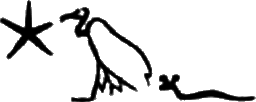 Dûamutf (with the head of a jackal),
Dûamutf (with the head of a jackal), 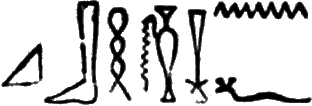 Qebeḥsenef (with the
head of a hawk). To these were attached "the forty-two assessors", generally represented with the
heads of various animals, who typified the negation of the forty-two {98}sins [cf. Negative Confession] of the Egyptian moral code. The book which
treats in full of everything pertaining to the Egyptian Hades is the so-called Book of the Dead or
the Ritual, which has been found in innumerable copies in the tombs and with the mummies. 28 30
Qebeḥsenef (with the
head of a hawk). To these were attached "the forty-two assessors", generally represented with the
heads of various animals, who typified the negation of the forty-two {98}sins [cf. Negative Confession] of the Egyptian moral code. The book which
treats in full of everything pertaining to the Egyptian Hades is the so-called Book of the Dead or
the Ritual, which has been found in innumerable copies in the tombs and with the mummies. 28 30
Amyrtaeus Obelisks. Two small obelisks of a king of the XXVIIIth dynasty, who revolted against Artaxerxes I., the king of Persia, but was conquered and driven into the Delta. His two obelisks, which are made of dark green basalt, are at present in the British Museum. His name in Egyptian is 10
 |
 |
 |
 |
| nuter nefer | User-mâ·t-Râ-sotep-en-Ȧmen | neb taui | Ȧmen-rud-Ȧmen-mer |
| The gracious god, |
"Strong in Truth, the Sun, chosen of Amen", |
the lord of the two countries, |
"Amyrtæus, beloved of Amen". |
 |
 |
| nuter nefer | User-mâ·t-Râ-sotep-en-Ȧmen |
| The gracious god, |
"Strong in Truth, the Sun, chosen of Amen", |
 |
 |
| neb taui | Ȧmen-rud-Ȧmen-mer |
| the lord of the two countries, |
"Amyrtæus, beloved of Amen". |
Ȧn. The Egyptian name of Heliopolis. 51 52 53 56 58 69 91
Androsphinx. A Greek word (Ἀνδρόσφιγξ), which means
"man-sphinx". This is the figure of a lion with the head of a man, and typifies the Pharaoh as the
incarnation of divine wisdom. The Egyptian figure of the androsphinx is  .
46
.
46
Animals, sacred. Zoölotria or animal-worship was carried on extensively in Egypt from the earliest times down to the Christian era. The Apis-bull was sacred to Ptah, the Mnevis-bull to Osiris, the cat to Bast, the cobra or Uræus-snake to all deities, the cow to Hathor, the crocodile to Sebek, the cynocephalus-monkey and the ibis to Thoth, the eel to Tum, the latus-fish to Isis, the frog to Heqet, the hippopotamus to Taûrt, the jackal to Anubis, the lapwing to Osiris, the lion to Sekhet, the ram to Ptah and Khnum, the scarabæus-beetle to Kheper-Râ, the scorpion to Selq, the sparrow-hawk to Horus, the shrew-mouse to Buto, and the vulture to {99}Mut. The worship of these animals was in some instances, however, confined to a province or city, for while an animal would be worshiped in one district, it would be hunted down and killed in another. Some of these sacred animals were also embalmed as mummies, especially the Apis-bull, the ibis, and the cat.
Ânkh. The Egyptian word for "life", written  . This refers to terrestrial as well
as celestial life and carries with it our notion of "eternal life". The sign resembles the St.
Anthony's cross, and is called the crux ansata "the cross with a handle"). It occurs in
almost every Egyptian inscription and is represented as the most precious gift of the gods to man.
29 46
. This refers to terrestrial as well
as celestial life and carries with it our notion of "eternal life". The sign resembles the St.
Anthony's cross, and is called the crux ansata "the cross with a handle"). It occurs in
almost every Egyptian inscription and is represented as the most precious gift of the gods to man.
29 46
Ȧn-menth. The Egyptian name of Hermonthis. 87
Ȧn·t. The Egyptian name of Denderah. 88
Ȧntef the Great. A king of the XIth dynasty of whom we know almost nothing. He erected a few small obelisks and was buried at El-Assasîf in Thebes. He was a great hunter and delighted in dogs. His name in Egyptian, according to Lepsius, is 9 11
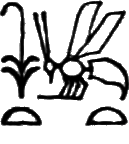 |
 |
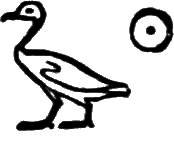 |
 |
| suten-kaut? | Sekhem-Râ-ap-mâ·t | sa Râ | Ȧntef-ân |
| The king of Upper and Lower Egypt, |
"The image of the Sun, the proclaimer of Truth", |
the Sun's offspring, |
"Antef the Great". |
 |
 |
| suten-kaut? | Sekhem-Râ-ap-mâ·t |
| The king of Upper and Lower Egypt, |
"The image of the Sun, the proclaimer of Truth", |
 |
 |
| sa Râ | Ȧntef-ân |
| the Sun's offspring, |
"Antef the Great". |
Anubis. In Egyptian  Ȧnpu. He was one of the chief gods in the
Lower World and was represented as a jackal-headed man. He was the deity of the embalmers and the
guardian of the mummies of the dead and their tomb, whence his picture
Ȧnpu. He was one of the chief gods in the
Lower World and was represented as a jackal-headed man. He was the deity of the embalmers and the
guardian of the mummies of the dead and their tomb, whence his picture 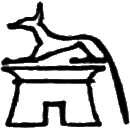 . The
Book of the Dead in the chapter on the "last judgment" portrays him in the act of weighing a
person's heart on a scale with reference to Truth (
. The
Book of the Dead in the chapter on the "last judgment" portrays him in the act of weighing a
person's heart on a scale with reference to Truth ( mâ). If it was found {100}wanting, the person was condemned to return to the earth
as an unclean beast; if found truthful, he enters into "the fields of the blessed". The sacred
animal of Anubis was the jackal. 89
mâ). If it was found {100}wanting, the person was condemned to return to the earth
as an unclean beast; if found truthful, he enters into "the fields of the blessed". The sacred
animal of Anubis was the jackal. 89
Apis. In Egyptian 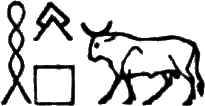 Ḥep. This bull was the sacred animal of Ptah
[others say Osiris], and was worshiped in Memphis. Its color was black, but on the forehead was a
white spot, on its back a mark like a sickle, and under its tongue a lump of flesh similar to the
sacred beetle (
Ḥep. This bull was the sacred animal of Ptah
[others say Osiris], and was worshiped in Memphis. Its color was black, but on the forehead was a
white spot, on its back a mark like a sickle, and under its tongue a lump of flesh similar to the
sacred beetle ( ) or scarab. It was worshiped for twenty-five years, when it was drowned and
another Apis sought. When found, it was escorted to the temple by the priests and the rejoicing
multitudes. The Apeium was the name of the temple in which it was worshiped, and the Serapeum that
of the building where its sarcophagi were stored.
) or scarab. It was worshiped for twenty-five years, when it was drowned and
another Apis sought. When found, it was escorted to the temple by the priests and the rejoicing
multitudes. The Apeium was the name of the temple in which it was worshiped, and the Serapeum that
of the building where its sarcophagi were stored.
Ȧpiu·t. The Egyptian designation of the eastern part of Thebes or "the
throne" of Amen-Râ. It was the city proper, while the western part was given up totally to the
dead. Out of this word, with the prefixed feminine article  ta [ta
Ȧpiu·t], the Greeks formed the word Thebes. 88
ta [ta
Ȧpiu·t], the Greeks formed the word Thebes. 88
Arabia. This country was well known to the ancient Egyptians, especially the southern
part, which they called  Pun·t. In the inscriptions of queen Mâkarâ,
published by Dümichen, we find the country and its precious product of spices mentioned. An active
trade was carried on between it and Egypt from the earliest times. 88
Pun·t. In the inscriptions of queen Mâkarâ,
published by Dümichen, we find the country and its precious product of spices mentioned. An active
trade was carried on between it and Egypt from the earliest times. 88
Arles Obelisk. This obelisk at Arles, a city in southern France, is uninscribed. Zoëga conjectures that it was brought to Arles by order of Constantine the Great in A. D. 315. It is very doubtful, whether this obelisk is {101}of Egyptian workmanship at all, as the rock resembles that of the quarries near by. It is now in front of the City Hall at Arles, and only contains inscriptions in honor of Louis XIV. and Napoleon III. 10 22
Asia. This has no Egyptian name. The Asiatic tribes, however, gave no end of trouble to the Egyptian kings, and a continual warfare was kept up against them. Prominent among them were the Kharu, the Rotennu, the Zahi, and the Kheta or Hittites. The Hyksos were perhaps also Asiatics. 86
Assuân. The modern name of the ancient Syene, near the southern boundary of Egypt, and
situated on the First Cataract. Most of the Egyptian granite was taken from its famous quarries.
Its Egyptian name is  Sun·t which may be rendered "the city which gives entrance into
Egypt". 11 13 23 24 86
Sun·t which may be rendered "the city which gives entrance into
Egypt". 11 13 23 24 86
Assuân Obelisk. The monster-obelisk still in the quarry of Syene and not yet detached from its native rock. It would have been the largest obelisk in existence. Three of its sides are finished, but have no inscriptions. 11
Ȧten or Ȧten-Râ. In Egyptian  Ȧten, "the sun's
disk". This deity was represented as the sun stretching out many hands which carried the symbol of
life,
Ȧten, "the sun's
disk". This deity was represented as the sun stretching out many hands which carried the symbol of
life,  ânkh. At one time, under Amenhotep IV. and his queen Thiî, it became for
a short time the supreme deity of Egypt, but after that was worshiped as only a form of Râ, and
sank back to a secondary place. 62 63 89
ânkh. At one time, under Amenhotep IV. and his queen Thiî, it became for
a short time the supreme deity of Egypt, but after that was worshiped as only a form of Râ, and
sank back to a secondary place. 62 63 89
Atmeidan Obelisk. It was erected by Thothmes III., perhaps in Heliopolis. A single column of hieroglyphs extends down each face, and the lower end is broken off. Constantine the Great [A. D. 306-337] seems to have had it removed to Alexandria, where it remained until its transportation to Constantinople in the reign of {102}Theodosius the Great [A. D. 379-395]. It is now in the Atmeidan or Hippodrome in Constantinople. 9
Ȧtum. In Egyptian 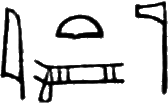 Ȧtum (the last sign being here only a
determinative). Another form of Tum. 29 51
Ȧtum (the last sign being here only a
determinative). Another form of Tum. 29 51
Augustus Caesar. The first Roman emperor whose full name was Caius Julius Cæsar Octavianus. He reigned from B. C. 30 to A. D. 14, and, besides his many grand achievements, ordered the two obelisks in Heliopolis (at present in London and New York) to be erected in Alexandria. His name in Egyptian is 8 25 32 39 72 73 74 82
 |
 |
| nuter neb taui | Auteqreder |
| The god, the lord of the two countries, |
"Autocrator," |
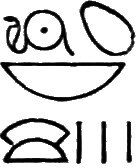 |
 |
| sa Râ neb khâu | Qîsers-ânkh-zeta-Ptaḥ-Ȧs·t-mer |
| the Sun's offspring, the lord of diadems, |
"Cæsar, living forever, beloved of Ptah and Isis". |
Autocrator. The Greek Ἀυτοκράτωρ "absolute
ruler". This was a title of the Roman emperors and is our "autocrat". The Egyptians placed the
word in either of the two cartouches of the emperors, and wrote it in many different ways; for
instance,  (Augustus, Tiberius, and Claudius),
(Augustus, Tiberius, and Claudius),  (Caligula),
(Caligula),  (Nero),
(Nero), 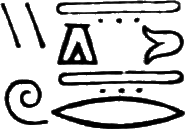 (Trajan),
(Trajan), 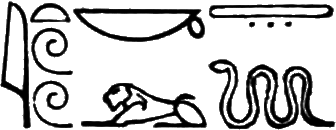 (Caracalla), &c. 39
(Caracalla), &c. 39
Avaris. A city on the Bubastic branch of the Nile in the Delta, near the ancient
Pelusium. Its Egyptian name was  Ḥa·t-ûar·t. It was the last fortified
stronghold of the Hyksos which was besieged and taken by Aahmes I., a king of the XVIIth dynasty. 92
Ḥa·t-ûar·t. It was the last fortified
stronghold of the Hyksos which was besieged and taken by Aahmes I., a king of the XVIIth dynasty. 92
Banner-shield. The oblong that contains the one established royal title and which, in
all inscriptions of importance, must precede the cartouches, 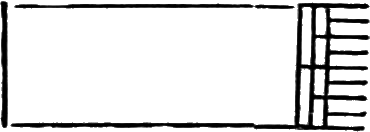 . It occurs twelve times on our
obelisk. 56 57 58 59 60 62 63
65 66 67 68 70
. It occurs twelve times on our
obelisk. 56 57 58 59 60 62 63
65 66 67 68 70
Barbarus. A prefect or governor of Egypt. According to Prof. Merriam his full name is Publius Rubrius Barbarus. History is silent about him. 39 73 74 82
Barberini Obelisk. Other designations for it are: Monte Pincio Obelisk, Veranian Obelisk, and the Obelisk della Passeggiata. It was cut in Egypt by order of Hadrian [A. D. 118-138] and erected in honor of Antinoüs, who drowned himself in the Nile in order to avert the fulfillment of an evil oracle from the emperor. Pope Urban VIII. (Barberini) found it broken in three pieces, and it was placed in its present position on the Monte Pincio in Rome by Pius VII. in 1822. It has two columns of hieroglyphs on each face. 9
Bast. The Egyptian lion-headed goddess of love, also called Pasht or Sekhet (which see). 92
B. C. An abbreviation for "Before (the birth of) Christ".
Bejij. Also called Ebjij. A city in the western half of the XXIst nome of Upper Egypt, whose Egyptian name was  Ḥa-Sebek, "the home of the god Sebek", the Crocodilopolis of the Greeks and
Romans. 5 11
Ḥa-Sebek, "the home of the god Sebek", the Crocodilopolis of the Greeks and
Romans. 5 11
Bejij Obelisk. A prostrate and broken obelisk of Usertesen I. at Bejij in the Fayoom. It resembles more a stelé than an obelisk, as it has two large and two small faces and a rounded top, which is the usual form of a stelé. 11
Belzoni, Giovanni Battista. One of the most successful Egyptian explorers [died Dec. 3, 1823]. He was the first to penetrate the second large pyramid of Gizeh. 13
Benevento. A city of Italy, north-east of Naples. Its Egyptian spelling on the obelisks
erected by the emperor Domitian is  Benemthesti. 8 10
Benemthesti. 8 10
Benevento Obelisks. Two obelisks bearing the cartouche of the emperor Domitian [A. D. 81-96]. One of {104}them, having only a single column of hieroglyphs on each face, is erected in a public square, while the other is imbedded in the wall of a house in Benevento. The names of Domitian, Titus, and Lucilius Lupus appear in the inscriptions. 10
Beni-Hassan. The present name of the place where the sepulchral grottoes of the XIIth dynasty were situated. These rock-tombs were in the XVIth nome of Upper Egypt, the most famous one of them being that of  Khnum-ḥotep. 89
Khnum-ḥotep. 89
Bersheh. The modern name of a place in the XVth nome of Upper Egypt, the site of many rock-tombs. 15 89
Boboli Gardens Obelisk. A small obelisk at present in the Boboli Gardens at Florence, Italy. It was probably erected in Heliopolis by Ramses II. and removed to Rome by the emperor Claudius [A. D. 41-54]. How it got to Florence is not known. 10
Bonomi, Joseph. An English Egyptologist [died 1808]. 11
Book of the Dead. Also called the Egyptian Ritual. A collection of chapters treating of the future state of the blessed in the realm of eternal life. It is also in part a catechism with questions and answers. Innumerable copies of it have been found written on papyrus and linen, some of them displaying beautifully executed pictures and vignettes. The first complete copy (of Turin, Italy) was published by Lepsius in 1842, the last by Naville in 1886. 33 34
Borgian Obelisk. A small obelisk in the Museum of Naples, Italy, bearing a single column of hieroglyphs. It was perhaps erected by Domitian, and had an inscription similar to that of the Albani Obelisk (which see). It was found at Præneste near Rome in 1791 and was formerly in the Borgian Museum at Velletri. 10
Boussard. A French engineer in the army of Napoleon I., who discovered the Rosetta Stone at Fort St. Julien in 1799. 92
Brugsch, Heinrich. The greatest living Egyptologist and disciple of Lepsius. He was born in Berlin on Feb. 18, 1827, and is at present Professor of Egyptology in the same city. 26
Bubastis. Now Tel-Basta. The capital of the XVIIIth nome of
Lower Egypt, the פִּי־בֶסֶת,
Pī-Bēseth, of the Bible (Ezek. xxx: 17), and called by the Egyptians  Per-Bas·t, "the home of the goddess Bast". The temple of this deity, the goddess of
love, is now a mass of ruins. 92
Per-Bas·t, "the home of the goddess Bast". The temple of this deity, the goddess of
love, is now a mass of ruins. 92
Bûlâk. The port of Cairo. Here is the famous "Musée Boulaq", the national Egyptian Museum, founded by the French Egyptologist Mariette (died 1881). 38
Busiris. Now Abu-Sîr, situated about half-way down the Damietta branch of the Nile. The
capital of the IXth nome of Lower Egypt, called in Egyptian 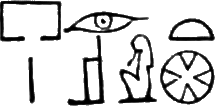 Per-Usȧr·t, "the house of Osiris", and by the Copts
Per-Usȧr·t, "the house of Osiris", and by the Copts  [Pûsiri], whence the Greek
Busiris. 92
[Pûsiri], whence the Greek
Busiris. 92
Byzantium. An ancient Greek city on the Bosphorus, now occupied by the city of Constantinople. It was founded about B. C. 667, and was for a long time the capital of the Eastern Greek Empire. 8
Caesar. At first the surname of the Roman gens (or house) Julia, but after the time of Augustus the title of the Roman emperors. The word was applied indiscriminately to all the emperors, but stands for Augustus on our obelisk-crab. 73 74 82
Caesar-ânkh-zeta-Ptaḥ-Ȧs·t-mer. The family name of the emperor Augustus (which see). 39
Caesareum. A temple in Alexandria dedicated to the {106}Roman emperors, where divine honors were paid them. 39
Cairo. The capital of Egypt, situated twelve miles above the place where the Nile resolves itself into its seven branches. It was founded about A. D. 973 on the site of the former town of Fostât (الفسطاط). The stones of ancient Memphis helped to build up the city. The Arabic name of Cairo is El-Kâhira (القاهرة "the victorious city"). 1 5 11 36 38 90 91
Cairo Obelisk. This is said to have formed part of a gate-way in Cairo. It has now disappeared, but may be identical with one of the Amyrtæus Obelisks. 11
Caligula, Caius Cæsar. The third Roman emperor (A. D. 37-41), whose name in Egyptian is 8
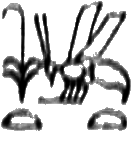 |
 |
 |
| suten-kaut? | ḥeq-ḥequ-Autegreder-Ptaḥ-Ȧs·t-mer | sa Râ |
| The king of Upper and Lower Egypt, |
"The lord of lords, Autocrator, the beloved of Ptah and Isis", |
The Sun's offspring, |
 |
 |
| suten-kaut? | ḥeq-ḥequ-Autegreder-Ptaḥ-Ȧs·t-mer |
| The king of Upper and Lower Egypt, |
"The lord of lords, Autocrator, the beloved of Ptah and Isis", |
 |
| sa Râ |
| The Sun's offspring, |
 |
| Qaîs-Kaîseres-Kermanîqis-ânkh-zeta |
| "Caius Cæsar Germanicus, living forever". |
Caliph. A title of a high dignitary among the Mohammedans. The Arabic form is خليفة Khalīfa, which means "the successor of the Prophet (Mohammed)". 80
Cambyses. A king of Persia who conquered Egypt in 527 B. C., overthrowing and putting to death Psametik III. He was a ruthless destroyer of Egyptian monuments and acted like a demoniac. His name is 1
 |
 |
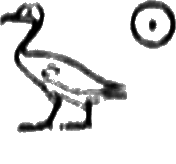 |
 |
| suten-kaut? | Mesuth-Râ | sa Râ | Kembȧthet |
| The King of Upper and Lower Egypt, |
"The son of Ra", |
the Sun's offspring, |
"Cambyses". |
 |
 |
| suten-kaut? | Mesuth-Râ |
| The King of Upper and Lower Egypt, |
"The son of Ra", |
 |
 |
| sa Râ | Kembȧthet |
| the Sun's offspring, |
"Cambyses". |
Campensis Obelisk. Also called the Monte Citorio {107}Obelisk in Rome. It stood formerly on the Campus Martius, whence its name. Erected by Psametik II. in Heliopolis, and removed by the emperor Augustus in 20 B. C. to Rome, it was found broken in five pieces in 1748, and was re-erected by Pius VI. in 1792. Unlike the other obelisks it has two columns of hieroglyphs on each face. 9 (25)
Carkhemish. A city on the Euphrates and the capital of the vast Hittite empire, now
called Jerablûs. It is also mentioned in the Bible (Isa. x:9; Jer. xlvii:2; II Chron. xxxv:20).
Many important battles were fought at this place. On the Egyptian monuments it is called 
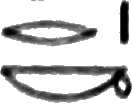
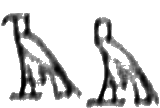
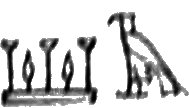 Karukamsha. 36
Karukamsha. 36
Cartouche [pronounced kartoósh]. An oval ring or seal containing the Pharaoh's name. The
Egyptian figure of it is  ren, which means "a name". Every king had two such
cartouches, the first being his royal or divine name which he adopted on his accession to the
throne, and the second being the family name which he bore as prince. The first is generally
introduced by the phrase "The king of Upper and Lower Egypt", and the second by "The son
of Rā". The cartouches may be written in vertical or horizontal lines; thus
ren, which means "a name". Every king had two such
cartouches, the first being his royal or divine name which he adopted on his accession to the
throne, and the second being the family name which he bore as prince. The first is generally
introduced by the phrase "The king of Upper and Lower Egypt", and the second by "The son
of Rā". The cartouches may be written in vertical or horizontal lines; thus 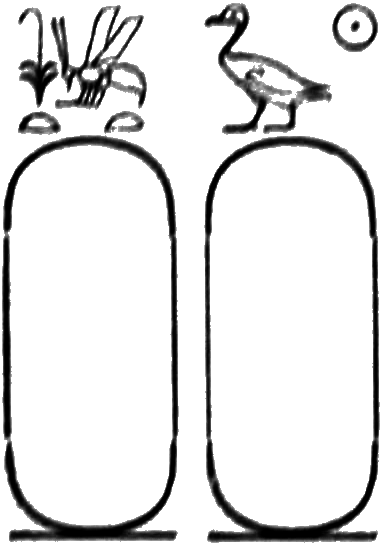 or
or 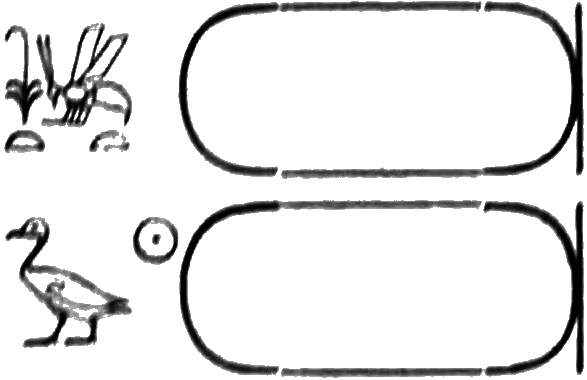 This
is the usual form though variants are not of infrequent occurrence. These cartouches would also
sometimes contain the names of gods, goddesses, queens, princes, and princesses, when the phrases
introducing them were changed accordingly. [Also spelled cartouch.] 36 37 38 39
49 57 71
This
is the usual form though variants are not of infrequent occurrence. These cartouches would also
sometimes contain the names of gods, goddesses, queens, princes, and princesses, when the phrases
introducing them were changed accordingly. [Also spelled cartouch.] 36 37 38 39
49 57 71
Catania Obelisk. A small obelisk standing on a stone elephant and set up in front of the Cathedral in {108}Catania, Sicily. It is only a Roman imitation, having eight sides and four columns of hieroglyphs in all. 10
Cataracts of the Nile. There are a number of cataracts formed by the Nile, where it passes over rocks and boulders, the largest and longest being the First Cataract. This forms the southern boundary of Egypt, and lies between Syene and Philæ. 24 86
Chronology, Egyptian. The ancient Egyptian chronology is hopelessly tangled. Some of the dates may be correct, especially those of the later dynasties, but when we turn to the early history of Egypt we are confronted by such a confusion of facts and dates, that makes the fixing of dates for the earlier dynasties an impossibility. There is a difference of more than 3000 years between the dates assigned by various Chronologists to the reign of the first king of Egypt, Menes; Böckh setting it down as B. C. 5702, Unger as 5613, Mariette and Lenormant as 5004, Brugsch as 4455, Lauth as 4157, Lepsius as 3892, Bunsen as 3059, Poole as 2717, and Wilkinson as 2691. No scheme of chronology can be deduced from the monuments, for the ancient Egyptians cared nothing about history, a fact that is proved by the carelessness with which they recorded historical events. The big numbers above result from the supposition that the various dynasties reigned in succession, while some were undoubtedly contemporaneous. An important list of kings together with their dates, written in the third century B. C. by Manetho, an Egyptian priest, has come down to us. We herewith give his list as systematized by Lepsius.
MYTHOLOGICAL PERIOD.
Two Dynasties of Gods. 13 870 years.
One Dynasty of Demi-gods. 3 650 years.
One Dynasty of Prehistoric Kings of Thinis. 350 years.
HISTORICAL PERIOD.
I. OLD EMPIRE. 1.-11. DYNASTIES. B. C. 3892-2380.
1st Dynasty of Thinis, 3892 to 3639.
Kings: Mena (Menes). Teta. Ateth (Athothis). Ata. Hesepti (Usaphaïs). Merbapen (Miëbis). Semenptah (Semempses). Qebeh.
2d Dynasty of Thinis, 3639 to 3338.
Kings: Bazaü (Boëthos). Kakaü (Kaiëkhos). Baënnuter (Binothris). Uaznes. Senda (Sethenes). Perabsen. Neferkarâ (Nepherkheres). Neferkaseker (Sesokhris). Hezef.
3d Dynasty of Memphis, 3338 to 3124.
Kings: Zazaî. Nebka. Zeser (Tosorthros). Teta. Sezes. Zeserteta (Tosertasis). Ahtes (Akhes). Nebkarâ. Neferkarâ (Nekherophes).
4th Dynasty of Memphis, 3124 to 2840.
Kings: Snefru (Soris). Khufu (Suphis or Kheops). Khâfrâ (Sophris or Khephren). Menkaürâ (Menkheres, Mycerinus). Dedefrâ. Shepseskaf. Sebekkarâ (Seberkheres).
5th Dynasty of Memphis, 2840 to 2592.
Kings: Userkaf (Userkheres). Sahurâ (Sephres). Neferarikarâ (Nepherkheres). Shepseskarâ (Sisires). Neferkhârâ (Kheres). Rânuser (Rathures). Menkaüher (Menkheres). Dedkarâ (Tankheres). Unas (Onnos).
6th Dynasty of Elephantine, 2744 to 2546.
Contemporaneous with the fifth dynasty. Kings: Teta. Atî (Othoës). Pepî (Phiops I.). Heremsaf. Pepî (Phiops II.). Netaqerti (Nitokris).
7th Dynasty of Memphis, 2592 to 2522.
8th Dynasty of Memphis, 2522 to 2380.
9th Dynasty of Heracleopolis, 2674 to 2565.
10th Dynasty of Heracleopolis, 2565 to 2380.
The kings of these four dynasties were more or less contemporaneous. The exact position of their names in the lists cannot be given. Kings: Neferka. Neferseh.... Ab. Neferkaürâ. Kharthî (Akhthoës). Neferkarâ. Neferkarânebî. Neferkarâkhendu. Merenher. Seneferka. Kanrâ. Neferkarâtererel. Neferkaher. Neferkarâpepîseneb. Neferkarâânnu. Neferarkarâ.
11th Dynasty of Thebes, 2423 to 2380.
Contemporaneous with the eighth and tenth dynasties. Kings: Antef I. Menthuhotep I. Antef II. Antef III. Antef IV. Antef V. Sarâanâ. Antuf. Antufâ. Antef the Great. Anantef. Seneferkarâ. Userenrâ. Nebnemrâ. Menthuhotep II. Menthuhotep III. Menthuhotep IV.
II. MIDDLE EMPIRE. 12.-17. DYNASTIES. B. C. 2380-1591.
12th Dynasty of Thebes, 2380 to 2167.
Kings: Amenemhât I. (Ammenemes I). Usertesen I. (Sesortasis I.). Amenemhât II. (Ammenemes II.). Usertesen II. (Sesortasis II.). Usertesen III. (Sesortasis III.). Amenemhât III. (Ammenemes III.). Amenemhât IV. (Ammenemes IV.). Sebekneferurâ (Sebeknophris).
13th Dynasty of Thebes, 2136 to 1684.
14th Dynasty of Xois, 2167 to 1684.
The kings of these two dynasties reigned contemporaneously. Kings: Sebekhotep I. Sebekhotep II. Sebekhotep III. Sebekhotep IV. Neferhotep. Sebekhotep V. Sebekhotep VI. Sebekhotep VII. Aï. Sebekhotep VIII.
15th Dynasty, the Hyksos, 2101-1842.
Contemporaneous with the thirteenth and fourteenth dynasties. Kings: Apehutiset. ...banân (Banon). Abehenkhepesh. Apepa (Apophis).
16th Dynasty, the Hyksos, 1842 to 1591.
Contemporaneous with the thirteenth and fourteenth dynasties. Kings: Apepa. Aqenenrâ.
17th Dynasty of Thebes, 1684 to 1591.
Contemporaneous with the sixteenth dynasty. Kings: Seqenenrâ I. Seqenenrâ II. Seqenenrâ III. Kames. Aähhotep. Aähmessapaär.
III. NEW EMPIRE. 18.-30. DYNASTIES. B. C. 1591-340.
18th Dynasty of Thebes, 1591 to 1443.
Kings: Aähmes I. (Amosis). Aähmesnefertari (Nephris). Amenhotep I. (Amenophis I.). Thothmes I. (Tûthmosis I.). Thothmes II. (Tûthmosis II.). Mâkarâ (Mephre). Thothmes III., the Great (Tûthmosis III.). Amenhotep II. (Amenophis II.). Thothmes IV. (Tûthmosis IV.). Amenhotep III. (Amenophis III.). Amenhotep IV. Sâqanekhtkheperurâ. Tutânkhamen. Aî. Heremheb (Horos).
19th Dynasty of Thebes, 1443 to 1269.
Kings: Ramses I. (Ramésses I.). Setî I. (Sethos I.). Ramses II., the Great (Ramésses Miammûn). Merenptah I. (Menephthes). Amenmeses. Setî II. (Sethos II.). Merenptah II. (Menephthes Siphthas). Setnekht (Sethnekhthes).
20th Dynasty of Thebes, 1269 to 1091.
Kings: Ramses III. (Ramésses III.). Ramses IV. (Ramésses IV.). Ramses V. (Ramésses V.). Ramses VI. (Ramésses VI.). Ramses VII. (Ramésses VII.). Ramses VIII. (Ramésses VIII.). Ramses IX. (Ramésses IX.). Ramses X. (Ramésses X.). Ramses XI. (Ramésses XI.). Ramses XII. (Ramésses XII.). Ramses XIII. (Ramésses XIII.). (Ramésses XIV.)
21st Dynasty of Tanis, 1091 to 961.
Kings: Samenthu (Smendes). Pasebkhânu I. (Phusemes). Asehrâ (Osokhor). Amenemapt (Amenophis). Pasebkhânu II. (Psinakhes). Opposition-kings of Thebes: Herher. Païnezem I. Païnezem II. Païnezem III.
22d Dynasty of Bubastis, 961 to 787.
Kings: Sheshenq I. (Sesonkhis I. or Shishak). Osarkon I. (Osorkhon I.). Takelot I. (Takelothis I.). Osarkon II. (Osorkhon II.). Sheshenq II. (Sesonkhis II.). Takelot II. (Takelothis II.). Sheshenq III. (Sesonkhis III.). Pamaî. Sheshenq IV. (Sesonkhis IV.).
23d Dynasty of Tanis, 787 to 729.
Kings: Pedusabast (Petsybastis). Osarkon III. (Osorkhon).
24th Dynasty of Sais, 729 to 685.
King: Bakenrenf (Bokkhoris). Opposition-kings of Ethiopia: Piânkhî I. Piânkhî II.
25th Dynasty of Ethiopia, 716 to 664.
Contemporaneous with the twenty-fourth and twenty-sixth dynasties. Kings: Shabaka (Sebikhos). Shabataka (Sebitikhos). Taharqa (Teärkhos). Amenrud.
26th Dynasty of Sais, 685 to 525.
Partly contemporaneous with the twenty-fifth dynasty. Kings: Psametik I. (Psametikhos I). Nekaü (Nekhao II.). Psametik II. (Psametikhos II.). Uahabrâ or Apries (Uaphris). Aähmes II. (Amosis). Psametik III. (Psametikhos III.).
27th Dynasty, the Persians, 525 to 405.
Contemporaneous with the twenty-eighth dynasty. Kings: Kembathet or Cambyses (Kambyses). Antarîush or Darius I. (Dareios Hystaspes). Khshîarush or Xerxes I. (Xerxes the Great). Artakhshashs (Artaxerxes). Anthrîsh or Darius II. (Dareios Xerxes).
28th Dynasty of Sais, 525 to 399.
Kings: Amenrud or Amyrtæus (Amyrteos I.). Khabbash.
29th Dynasty of Mendes, 399 to 378.
Kings: Niafâurud (Nephorites I.). Hager (Akhoris). Psimut (Psamuthis).
30th Dynasty of Sebennytus, 378 to 340.
Kings: Nekhtherheb or Nectanebo I. (Nekhtharebes). Taher (Teos). Nekhtnebef or Nectanebo II. (Nekhthanebos).
Manetho's list ends with this dynasty, the names of the following dynasty having been added by some other writer. All the names here given in parentheses are from his list.
IV. EGYPT UNDER FOREIGN RULE, B. C. 340-A. D. 395.
31st Dynasty, the Persians, B. C. 340 to 332.
Kings: (Okhos). (Arses). (Dareios). These names do not occur on the Egyptian monuments.
32d Dynasty, the Macedonians, B. C. 332 to 305.
Kings: Aleksandres or Alexander the Great. Phîulîupûs or Philippus Aridæus. Aleksandres or Alexander II.
33d Dynasty, the Ptolemies, B. C. 305 to 30.
Kings: Ptolemy I. Soter I. Ptolemy II. Philadelphus. Ptolemy III. Euergetes I. Ptolemy IV. Philopator I. Ptolemy V. Epiphanes. Ptolemy VI. Eupator. Ptolemy VII. Philometor. Ptolemy VIII. Philopator II. Ptolemy IX. Euergetes II. Cleopatra III. Ptolemy X. Soter II. Ptolemy XI. Alexander I. Berenice III. Ptolemy XII. Alexander II. Ptolemy XIII. Neos Dionysios. Cleopatra VI. Ptolemy XVI. Cæsarion.
34th Dynasty, the Romans, B. C. 30 to A. D. 395.
Emperors: Augustus. Tiberius. Caligula. Claudius. Nero. Galba. Otho. Vespasian. Titus. Domitian. Nerva. Trajan. Hadrian. Antoninus Pius. Aurelius. Verus. Commodus. Severus. Caracalla. Geta. Decius. .......... A. D. 251.
Egyptian history ends here as far as the monuments are concerned, for Decius is the last Roman emperor mentioned by them. Prominent among the succeeding emperors are Gallienus, Aurelian, Probus, Diocletian, Constantine the Great, Constantius, and Theodosius the Great. The emperors of the Eastern Roman Empire, called the Byzantines, rule over Egypt from A. D. 395 to 638. The Mohammedans then conquer the country in 638, and have remained in possession until now. One of the best of these rulers or Khedives was the late Ishmael Pasha.
"City of Obelisks." A designation of Heliopolis. 1 91
"City of the Seven Hills." A designation of Rome which was originally built on seven hills. 25
"City of the Sun." The translation of the Greek word Ἡλιούπολις [Hêliûpolis], which is An or Heliopolis. 36 51
Claudius. The fourth Roman emperor (A. D. 41-54). His full name is Tiberius Claudius Drusus Nero Germanicus. In the Egyptian inscriptions he is called 8
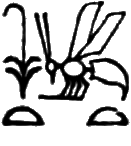 |
 |
 |
 |
| suten-kaut? | Auteqreder-Kîsers | sa Râ | Qertus-Dȧbȧrsa |
| The King of Upper and Lower Egypt, |
"Autocrator Cæsar", | the Sun's offspring, |
"Claudius Tiberius". |
 |
 |
| suten-kaut? | Auteqreder-Kîsers |
| The King of Upper and Lower Egypt, |
"Autocrator Cæsar", |
 |
 |
| sa Râ | Qertus-Dȧbȧrsa |
| the Sun's offspring, |
"Claudius Tiberius". |
Cleopatra II. The sister and wife of Ptolemy VII. Philometor, and afterwards wife of her brother Ptolemy IX. Euergetes II. She reigned with them at intervals, {112}but all by herself from B. C. 130 to 127. Her name and that of Ptolemy IX. on the Obelisk of Philæ were the first that were read after the discovery of the Egyptian alphabet by François Champollion. Her Egyptian name is 7
 |
 |
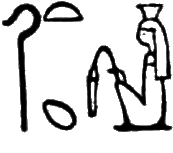 |
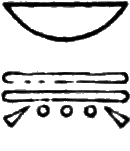 |
 |
| sen·t·f | ḥim·t·f | ḥeq·t | neb taui | Qlûapedra·t |
| His sister, | his wife, | mistress, | lord of the two countries, | "Cleopatra". |
 |
 |
 |
 |
| sen·t·f | ḥim·t·f | ḥeq·t | neb taui |
| His sister, | his wife, | mistress, | lord of the two countries, |
 |
| Qlûapedra·t |
| "Cleopatra". |
Cleopatra VI. The famous and infamous queen after whom the New York Obelisk is named, though incorrectly. She was born B. C. 69, married her brother Ptolemy XIV. in 52, combined with Julius Cæsar in 49, and dethroned her brother who was soon after that drowned. In 47 she married her second brother Ptolemy XV. whom she poisoned in 44. She then made her own son by Julius Cæsar, Ptolemy XVI. Cæsarion, co-regent with herself, but, falling in love with Mark Antony, killed her son and placed her lover on the throne in 37. At the very height of her power she was vanquished by Octavius, who became afterwards the emperor Augustus, and died with Mark Antony in 30 B. C. Her Egyptian name is 39 40
 |
 |
 |
| ḥeq·t | neb taui | Qlûpeter |
| The mistress, | lord of the two countries, |
"Cleopatra". |
"Cleopatra's Needle." The usual designation of the New York Obelisk. 8 10 41 42 81
Colossus. A Greek word Κολοσσός, "a gigantic statue". 15 Colossi of thebes. The two colossal statues of Amenophis III., one of them being the Vocal Memnon. Besides them there are at Thebes several others, notably of Ramses II. (Luxor and Karnak) and of Ramses III. {113}(Medînet-Habu). Other colossal figures of Ramses II. are found at Mitrahîneh [Memphis] and, wrought into the rock, at Abusimbel. 16 89
Constantine the Great. The first Roman emperor of that name and the introducer of Christianity into the whole empire. He was sole ruler of the Eastern and Western Roman Empires from 323 to 337 A. D. 8 10 22
Constantinople. The capital of the Turkish Empire, founded by Constantine the Great 330 A. D. on the site of the ancient Byzantium. It is called in Turkish Istambûl استانبول. 8
Constantius II. A son of Constantine the Great who was sole ruler of the Roman Empire from 351 to 361 A. D. 8
Coptic Language. The name given to the Egyptian language [Coptic being an abbreviation for Egyptic] in use at the time of the Romans and spoken until the seventeenth century of our era. There were three dialects, the Sahidic (of Upper Egypt) and the Memphitic and Bashmuric (of Lower Egypt). The language was almost exclusively used by the Christian Copts. The alphabet is the Greek with some changes in the form of the letters and six additions from the Hieroglyphic. This is the alphabet: 90
| Coptic: |  |
 |
 |
 |
 |
 |
 |
 |
 |
 |
 |
 |
 |
 |
 |
 |
 |
 |
 |
 |
 |
 |
 |
 |
| Greek: | α | β | γ | δ | ε | ζ | η | θ | ι | κ | λ | μ | ν | ξ | ο | π | ρ | ς | τ | υ | φ | χ | ψ | ω |
| a | b | g | d | e | z | ê | th | i | k | l | m | n | x | o | p | r | s | t | u | ph | kh | ps | ô |
| Coptic: |  |
 |
 |
 |
 |
 |
 |
 |
 |
 |
 |
 |
| Greek: | α | β | γ | δ | ε | ζ | η | θ | ι | κ | λ | μ |
| a | b | g | d | e | z | ê | th | i | k | l | m | |
| Coptic: |  |
 |
 |
 |
 |
 |
 |
 |
 |
 |
 |
 |
| Greek: | ν | ξ | ο | π | ρ | ς | τ | υ | φ | χ | ψ | ω |
| n | x | o | p | r | s | t | u | ph | kh | ps | ô |
| Additions: |  |
 |
 |
 |
 |
 |
| Hieroglyphic: |  |
 |
 |
 |
 |
 |
| sh | f | kh | h | j | g |
and the syllabic sign  ti.
ti.
Coptos. The capital of the Vth nome of Upper Egypt, {114}the modern Kuft قفط. Its Egyptian name was  Qebti·t. 88
Qebti·t. 88
Corfe Castle Obelisk. This was one of the two obelisks in front of the temple of Isis at Philæ and was erected by Cleopatra II. and Ptolemy IX. It has one column of inscriptions on each face and the cartouches of these sovereigns. Below is a very long Greek inscription which enabled Champollion to read these cartouches. The obelisk was removed in 1815 by Belzoni to England, and is at present in Corfe Castle, Isle of Purbeck, Dorsetshire. 10
Crab. In reality the scorpion, which was the symbol of the goddess Selq, a form of the
goddess Isis. Its name in Egyptian is  serk or
serk or  serq. It must have been
quite extensively worshiped in Dakkeh, Nubia, which received from it the name
serq. It must have been
quite extensively worshiped in Dakkeh, Nubia, which received from it the name  Peserk·t, the ancient Pselcis. In Ptolemaic times the crab or scorpion seems to have been
identified with the evil genius. 21 38 39 81
Peserk·t, the ancient Pselcis. In Ptolemaic times the crab or scorpion seems to have been
identified with the evil genius. 21 38 39 81
Crocodilopolis. The capital of the western half of the XXIst nome of Upper Egypt, the Ḥa-Sebek of the Egyptians, now Bejij in the Fayoom (which see). 5 11 90
Crowns of Egypt. To correspond with the divisions of Egypt there were two crowns; the
one called ḥez "the white one" ( ), signifying Upper Egypt, and the
other desher "the red one" (
), signifying Upper Egypt, and the
other desher "the red one" ( ), signifying Lower Egypt. Whenever the king ruled over all
Egypt these two crowns were joined into one
), signifying Lower Egypt. Whenever the king ruled over all
Egypt these two crowns were joined into one  , which was called
, which was called 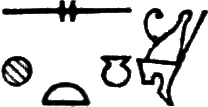 sekhen·t in Hieroglyphic, but in Demotic, with the prefixed article pe,
pskhent, or the Greek word ψχὲντ [pskhent]. This crown was worn by kings and gods.
31 60
sekhen·t in Hieroglyphic, but in Demotic, with the prefixed article pe,
pskhent, or the Greek word ψχὲντ [pskhent]. This crown was worn by kings and gods.
31 60
Damascus. The capital of Syria. It is called in the Bible דַּמֶּשֶׂק
[Dammêseq], in Arabic دمشق
[Dimashku], {115}and in Egyptian 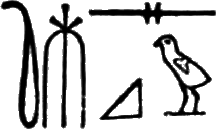 Themesqu, and was the extreme limit of the conquest of Thothmes III. in northern Palestine.
36
Themesqu, and was the extreme limit of the conquest of Thothmes III. in northern Palestine.
36
Damietta. A small town situated between the Damietta branch of the Nile and Lake
Menzaleh, and at present called Dumyât. It is perhaps the site of the ancient Egyptian 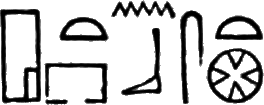 Ḥa·t-nebes·t. 92
Ḥa·t-nebes·t. 92
Dashûr. A village near the site of the ancient Memphis and only a short distance from a number of small and two large pyramids. 91
Deb·t. The Egyptian name of Edfu. 87
Deḥuti. The ibis-faced god whose name is written in Egyptian 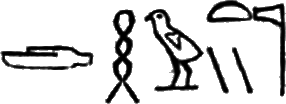 Deḥuti. The usual way of writing this god's name is Thoth (which see). 56
Deḥuti. The usual way of writing this god's name is Thoth (which see). 56
Deḥuti-meses. The family name of Thothmes III. in its simplest form. 49 58 60 61
Deḥuti-meses-nefer-kheperu. One of the variants of the family name of Thothmes III., which means "the child of Thoth, beautiful in his transformations". 58 60 61
Delta. The northern part of Egypt or Lower Egypt lying around the seven branches of the
Nile. This part of the country forms a vast triangle and, because of its resemblance to their
letter D [Δ Delta], was called by the Greeks "the Delta".
Its Egyptian name is  pa ta merâ·t, "the land of the inundation". 84 90
pa ta merâ·t, "the land of the inundation". 84 90
Demotic. The third kind of Egyptian writing which was formerly also called
"enchorial" or indigenous. It was the simplest form in which the Egyptian
picture-characters were written, and was introduced in the reign of Psametik I. [7th century B.
C.]. Being read from right to left like the Hieratic, it was employed for the same class of
literary work as this. The ease, however, {116}with
which it could be written made it most suitable for every-day use, and it supplanted the Hieratic
almost completely. It was itself superseded in the time of the Roman emperors by the Coptic (which
see). It was called in Hieroglyphics (on the Rosetta Stone)  sekhi en shâî "writing of
the books".
sekhi en shâî "writing of
the books".
The Demotic alphabet is here subjoined.
Denderah. The capital of the VIth nome of Upper Egypt,
called in Egyptian  or
or 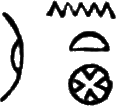 Ȧn·t, "the city of pillars", or
Ȧn·t, "the city of pillars", or  Ta-en-ta-rer·t, "the city of {117}the province
encompassed by a wall" or
Ta-en-ta-rer·t, "the city of {117}the province
encompassed by a wall" or  ,
,  ,
,  ,
,
 ,
, 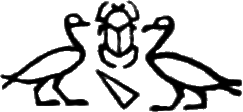 , &c., Ta-rer·t, the Greek Tentyra. The goddess
Hathor or Venus was worshiped here in one of the most magnificent temples of Egypt. 88
, &c., Ta-rer·t, the Greek Tentyra. The goddess
Hathor or Venus was worshiped here in one of the most magnificent temples of Egypt. 88
Denys of Telmahre. Or Dionysius Tell-Mahrâyâ. A native of Tell-Mahrê, a village near the junction of the rivers Euphrates and Balîkh in Syria, not far from Antioch. He was patriarch of the Jacobites (818-845 A. D.) and a great Syriac writer. 19
Dêr-el-baheri. "The northern monastery." A place opposite Thebes on the western bank of the Nile, famous for the magnificent temple of queen Hatasu. Here were discovered in 1881 the mummies of many kings and queens, and among them those of the great Pharaohs Thothmes III., Seti I., Ramses II., and Ramses III. 88
Diadems. Besides the crowns (cf. page 114) there are two diadems
always specially mentioned, which also refer to the Pharaoh's power and rule over Upper and Lower
Egypt, the diadems of the Vulture and the Uræus snake or cobra, expressed thus:  [pronunciation very uncertain!]. Some other forms of royal head-gear or diadems were the helmet
[pronunciation very uncertain!]. Some other forms of royal head-gear or diadems were the helmet  kheperesh, the
kheperesh, the  or the simple head-dress, and most of the crowns with which
the gods are represented. 56 57 70
or the simple head-dress, and most of the crowns with which
the gods are represented. 56 57 70
Domitian. The eleventh Roman emperor (81-96 A. D.), whose name in Egyptian is 5 7 8 9 10 22
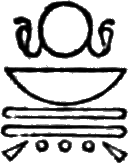 |
 |
| nuter neb taui |
Autugretur Kîsers |
| The divine lord of the two countries, |
"Autocrator Cæsar". |
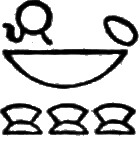 |
 |
| Râ sa neb khâu |
Tumtînes ent khu |
| the Sun's offspring, the lord of diadems, |
"Domitianus, the glorious" or, Augustus. |
Drah-abul-Neggah. The modern name of a portion of the necropolis of ancient Thebes on the western bank {118}of the Nile with many royal tombs of the XIth, XVIIth, and beginning of the XVIIIth dynasties. 9 11 88
Drah-abul-Neggah Obelisks. Two obelisks found at this place, near Thebes, in 1878, each broken into several pieces. They belong, perhaps, to the XIth dynasty, and would then be next to the Lepsius Obelisk the oldest in existence. 9 11
Dümichen, Johannes. One of the triad of the greatest living Egyptologists [the two others being Brugsch and Ebers]. He is at present Professor of Egyptian in the University of Strassburg, Alsace. (The author's teacher.) 61 100
Dynasty. A set of kings belonging to one family. For a list of the thirty-four Egyptian dynasties, see under: Chronology.
Edfu. Modern name of the Apollinopolis of the Greeks and Romans, or the Egyptian  ,
Deb·t, "the city of transfixion" or
,
Deb·t, "the city of transfixion" or  , Ḥud·t, "the city
of the winged sun-disk". It was the capital of the IId nome of
Upper Egypt, its local deity being Horus, who was identified by the Greeks with Apollo, the
sun-god; whence the city's name. 31 87
, Ḥud·t, "the city
of the winged sun-disk". It was the capital of the IId nome of
Upper Egypt, its local deity being Horus, who was identified by the Greeks with Apollo, the
sun-god; whence the city's name. 31 87
Egypt. The oldest empire of the world, comprising the north-east corner of Africa and
extending from the First Cataract to the Mediterranean Sea. Its modern name is مصر [Misr], and some of its Egyptian names are  ,
Qem·t,
,
Qem·t,  or
or 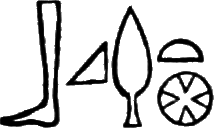 , Beq·t,
, Beq·t, 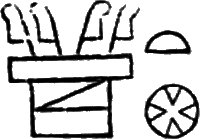 or
or 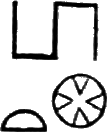 , Mer·t, &c. It was the seat of the first
civilization and in its golden age—in the time of the XIXth
dynasty—the mistress of the world. At present it has lost all its prestige and is being
ruined by Mohammedan misrule. For its divisions, &c., see pages 84 to 92.
, Mer·t, &c. It was the seat of the first
civilization and in its golden age—in the time of the XIXth
dynasty—the mistress of the world. At present it has lost all its prestige and is being
ruined by Mohammedan misrule. For its divisions, &c., see pages 84 to 92.
Egyptian Ritual. See under: Book of the Dead. 34
Eileithyiapolis. The Greek name of the Egyptian city  Nekheb·t, "the city
of the goddess Nekheb", a deity whom the Greeks identified with their Eileithyia (the
goddess of childbirth) and the Romans with their Lucina. It was the capital of the IIId nome of Upper Egypt. 87
Nekheb·t, "the city
of the goddess Nekheb", a deity whom the Greeks identified with their Eileithyia (the
goddess of childbirth) and the Romans with their Lucina. It was the capital of the IIId nome of Upper Egypt. 87
Electrum. The name given by the ancients to an alloy of gold (4 parts) and silver (1
part). Some consider the so-called Egyptian gold-metal 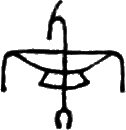 , usem, to be identical with
it. 59
, usem, to be identical with
it. 59
Elephantine. [Pronounced Elefanteenay.] The Greek name of the town and island in the
first nome of Upper Egypt, opposite Assuân. The Egyptian name (which the Greeks only translated)
is 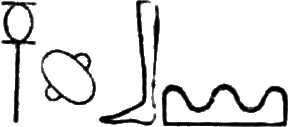 or
or  , Âb or Âb.t [Âbu·t], "the ivory island or city". The
cataracts of Elephantine, called
, Âb or Âb.t [Âbu·t], "the ivory island or city". The
cataracts of Elephantine, called  , qerti, were regarded by the ancient Egyptians as
the source of the Nile. 4 24 29 86
, qerti, were regarded by the ancient Egyptians as
the source of the Nile. 4 24 29 86
El-Kab. The modern name of Nekhebt or Eileithyiapolis, which see. 87
El-Khargeh. The present name of the oasis to the west of Thebes, called in the
inscriptions 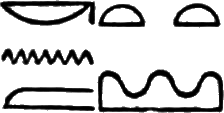 , Kenemti, "the wine-land". It formed at one time a part of the
VIIth nome of Upper Egypt. In it stood a large temple of Amen-Râ.
89
, Kenemti, "the wine-land". It formed at one time a part of the
VIIth nome of Upper Egypt. In it stood a large temple of Amen-Râ.
89
El-Lahoon. A village close to the Fayoom, the site of the pyramid of Amenemhât III.
(according to Lepsius) or Usertesen II. (according to Brugsch). The modern name is derived from
the Egyptian  , Ruḥun·t, "the mouth of the canal." 90
, Ruḥun·t, "the mouth of the canal." 90
El-Thabût-ben-Marrat. A mythical person. 80
El-Tineh. The modern name of the ancient Thinis, the {120}Egyptian 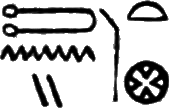 , Theni·t, the first capital of the VIIIth nome of Upper Egypt, which was at one time a very important city and
the home of the first two Egyptian dynasties. 89
, Theni·t, the first capital of the VIIIth nome of Upper Egypt, which was at one time a very important city and
the home of the first two Egyptian dynasties. 89
Elysium. The Greek Ἠλύσιον [êlûsion]. The abode of the blessed or the "Elysian Fields", called in Egyptian Ȧanuru or Ȧaḥlu (see page 97).
Erment. The present name of the ancient Hermonthis or the Egyptian 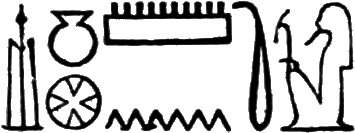 Ȧn-menth, "the city of the pillar of the god Menthu", the capital of
an independent district to the west of the IVth nome of Upper Egypt.
87
Ȧn-menth, "the city of the pillar of the god Menthu", the capital of
an independent district to the west of the IVth nome of Upper Egypt.
87
Esmeade Obelisk. An obelisk formerly in the Esmeade garden near the Porta del Popolo in Rome and only a Roman imitation. 11
Esneh. The present name of the capital of the IIId nome of
Upper Egypt, called in Egyptian  Ȧnî·t or
Ȧnî·t or  Seni·t. Its sacred animal
according to Strabo, a Greek geographer, was the fish Latus (cf. page 98),
and its chief deities were Khnum and Neith. The ancients named the city Latopolis. 87
Seni·t. Its sacred animal
according to Strabo, a Greek geographer, was the fish Latus (cf. page 98),
and its chief deities were Khnum and Neith. The ancients named the city Latopolis. 87
"Eternal City." A classical expression for the city of Rome, which was said to have been founded by the gods and to be under their constant protection. 5
Ethiopia. See under Nubia.
Fayoom. The modern name of the tract of land which lay formerly in the XXth and XXIst nomes of Upper Egypt, south-west of the Pyramids. Its local deity was the crocodile-faced god Sebek, whence its name among the ancients, Crocodilopolis. In it is the famous Lake Mœris, as well as the Labyrinth and the pyramids of El-Lahoon and Meydoom. In Arabic the name is written الفيوم [el-fayûm]. 4 5 89
Flaminian Obelisk. Also called the obelisk of the Piazza del Popolo, in Rome. It was erected in Heliopolis by Seti I., and re-erected by the emperor Augustus in the Circus Maximus in Rome. After it had fallen Pope Sixtus V. removed the pieces of the obelisk and set them up in the present position [in 1589]. The inscriptions are by Seti I. and Ramses II.; the latter having appropriated the greater portion. From this obelisk the priest Hermapion (4th century A. D.) made the first attempt to decipher the Egyptian hieroglyphs. The result of his investigations appears extremely ridiculous to us at the present day. 9
Florence Obelisks. Two small obelisks with two columns of hieroglyphs on each face. They are at present in the Egyptian Museum at Florence. 10
Gizeh. The site of the monster-pyramids and the Sphinx. It is situated in the former Ist nome of Lower Egypt, and was the necropolis of ancient Memphis. 4 91
Greece. The first mention of the Greeks in history is in the inscriptions of the temple
of Karnak, in which an incursion by them into Egypt at the time of Menephthah I. [XIXth dynasty] is described. The tribes mentioned there are the Akaüsha
(Achæans), the Tursha (Etruscans), the Luku (Lycians), the Sharutana (Sardinians), and the
Shakalusha (Sicilians). On the Rosetta Stone the Greeks are called 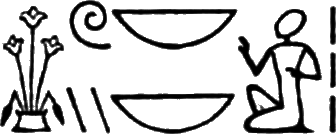 Ḥauinebu.
Ḥauinebu.
Hades. The Lower World, the abode of the departed spirits. The Egyptian Amenti, which see. 28 30
Hadrian. The fourteenth Roman emperor [117-138 A. D.]. On the Barberini
Obelisk occur the names of his wife  Sâbina·t, Sabina, and of his {122}favorite page
Sâbina·t, Sabina, and of his {122}favorite page  Ândînes, Antinoüs. The emperor's name in Egyptian is
5 7 9 22
Ândînes, Antinoüs. The emperor's name in Egyptian is
5 7 9 22
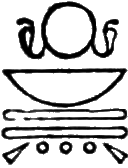 |
 |
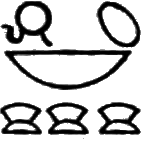 |
 |
| neb taui | Autukerter Kîsers Terînus | neb khâu | Atrînes enti khu |
| The divine lord of the two countries, |
"Autocrator Cæsar Trajanus", |
the Sun's offspring, the lord of diadems, |
"Hadrianus Augustus". |
 |
 |
| neb taui | Autukerter Kîsers Terînus |
| The divine lord of the two countries, |
"Autocrator Cæsar Trajanus", |
 |
 |
| neb khâu | Atrînes enti khu |
| the Sun's offspring, the lord of diadems, |
"Hadrianus Augustus". |
Hammamât. In the Vth nome of Upper Egypt, near Panopolis and on the road leading from this city to Kossêr, on the Red Sea. The Greeks called it πορφυρίτης ὄρος [porphurîtês óros] "the porphyry-mountain" on account of the excellent stone that was quarried here. 16 23 88
Harmachis. The Greek transcription of the Egyptian  Ḥor-em-khuti,
"Horus in the two horizons". This deity represents the sun at noon. Its symbolic
representation was the sphinx, and its principal sanctuary was built between the paws of the Great
Sphinx at Gizeh in front of the Pyramid of Kheops. (30)
Ḥor-em-khuti,
"Horus in the two horizons". This deity represents the sun at noon. Its symbolic
representation was the sphinx, and its principal sanctuary was built between the paws of the Great
Sphinx at Gizeh in front of the Pyramid of Kheops. (30)
Hatasu. Or Ḥashepes. A famous queen of the XVIIIth dynasty, the sister of Thothmes III. and at first co-regent with him. She despatched the first fleet mentioned in history to Arabia and the Somali Coast, where she obtained spices, perfumes, trees, &c. Her name in Egyptian (with masculine titles!) is 6 9 11 19 23 35
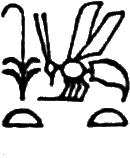 |
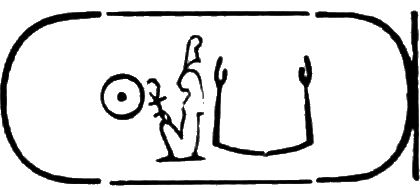 |
 |
 |
| suten-kaut? | Mâkarâ | sa Râ | Ȧmen-khnum·t-ḥâ·t-shepesu |
| The king of Upper and Lower Egypt, |
"Truth, the image of the Sun", |
the Sun's offspring, |
"Filled with Amen, chief of the nobles". |
 |
 |
| suten-kaut? | Mâkarâ |
| The king of Upper and Lower Egypt, |
"Truth, the image of the Sun", |
 |
 |
| sa Râ | Ȧmen-khnum·t-ḥâ·t-shepesu |
| the Sun's offspring, |
"Filled with Amen, chief of the nobles". |
Hatasu Obelisks. The two largest obelisks in Egypt, erected by queen Hatasu in Karnak. Only one of them is erect. One line of hieroglyphs extends down on each {123}of their faces, while their pyramidia were originally capped with "gold-metal". These obelisks were quarried at Assuân, removed, polished, inscribed, and erected in the incredibly short space of seven months, as their inscriptions record. 19 23
Hathor. An Egyptian goddess who was represented in many ways; viz., like Isis with the
disk of the sun between two horns, or with a cow's head with the disk between the horns, or as a
spotted cow with plumes and the sun's disk, or as a hawk with a female face and surmounted by the
horns and the disk. The Greeks identified her with their Aphrodité and the Romans with their
Venus, the goddess of love. She was the special guardian of the Egyptian queens. Her hieroglyphic
name is  or
or  ḥa·t-Ḥer, "the house of Horus".
88
ḥa·t-Ḥer, "the house of Horus".
88
Ḥa·t-ûar·t. The Egyptian name of Avaris or Pelusium. 92
Heliopolis. The Greek name of the Egyptian 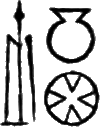 Ȧn, at present
Matarîyeh, near Cairo, the biblical אוֹן [ôn]. It was the capital of the XIIIth nome of Lower Egypt, and one of the most famous cities of antiquity.
It was sacred to the sun-gods Râ and Tum. 1 2 4 9 10 19 21 36 51 52
53 56 57 58 69 82 91
Ȧn, at present
Matarîyeh, near Cairo, the biblical אוֹן [ôn]. It was the capital of the XIIIth nome of Lower Egypt, and one of the most famous cities of antiquity.
It was sacred to the sun-gods Râ and Tum. 1 2 4 9 10 19 21 36 51 52
53 56 57 58 69 82 91
Heliopolis Obelisk. The only remaining and erect obelisk at Heliopolis. It has one column of hieroglyphs on each face and was erected by Usertesen I. of the XIIth dynasty. Its companion fell in 1160 A. D. and has completely disappeared. Its apex was originally covered with a capping of gilded bronze, which was still seen by the Arabic physician Abd-el-Latîf in the thirteenth century A. D. 9
Hermonthis. See under Erment. 87
Herschel, Sir John Fred. William. A famous English astronomer. Died May 11, 1871. 13
Hieratic. A more cursive form of the Hieroglyphic script, with fewer characters, and signs drawn only in outline. It was mostly used for state documents, letters, and scientific and religious papyri. The form of the characters varies according to the individual handwriting of the scribe. The Hieratic, like the Demotic, is always written from right to left. It was the second kind of Egyptian writing, and its alphabet is as follows. 34
Hieroglyphic. The name for the monumental language of ancient Egypt. The words are composed of hieroglyphs or "sacred carvings", which were at first quite simple but in the time of the Ptolemies became very complicated and enigmatical. The alphabet is given above under: Hieratic. Besides the simple letters there are also some two thousand syllabic signs and ideographs. The characters were written either {125}horizontally from left to right [thus in the hieroglyphic type of this book] or from right to left [thus on pages 71, 75, and 76], or else vertically, with the characters below each other, from left to right or from right to left. Hieroglyphic was the writing of the priests.
Hittites. The biblical name of an Asiatic people, the hereditary foes of the Egyptians. They were called by them Kheta, which see. 36 37
Homer. The famous Greek poet, author of the Iliad and the Odyssey. 2 37
Ḥor-Ḥud·t. The name of Horus as he was worshiped at Edfu. 31
Ḥor-khuti, or Ḥor-em-khuti. The sun-god at his appearance in the horizon in the morning and at noon. From this word, which means "Horus of the two horizons", the Greeks coined the word Harmachis. 29 30
Ḥor-nub. "The golden Horus." This title may also be translated "the victorious Horus", referring in the first place to the victory of this god over the devil, Set (cf. page 87), and then to the personal bravery of his representative on earth, the king. 60 64 68
Ḥor-Râ. A form of the solar deity, a combination of Râ and Horus. 30
Horus. One of the greatest of the Egyptian deities, the son of Osiris and Isis. He
personified the Sun in his midday power, and his sacred bird was the hawk. He was the divine
representation of the Pharaoh himself. On the monuments we find him pictured in many ways; viz.,
 ,
,  ,
, 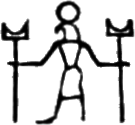 ,
,  ,
,
 ,
,  ,
,  ,
,  ,
,
 ,
,  ,
, 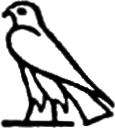 ,
, 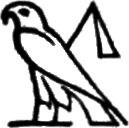 ,
,
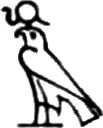 ,
,  ,
, 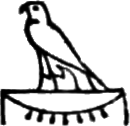 ,
,  ,
,
 ,
,  ,
, 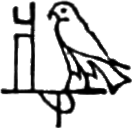 ,
,  ,
&c. 28 29 30 31 57 58 69
60 61 62 63 64 65 66
67 68 69 70 87
,
&c. 28 29 30 31 57 58 69
60 61 62 63 64 65 66
67 68 69 70 87
"House of the Sun." An appellation of Heliopolis. 2
Ḥud·t. The Egyptian name of Edfu, which see. 87
Hyksos. Syrian invaders who conquered Egypt and founded the XVth and XVIth dynasties. According to Manetho
(cf. page 108) the word signifies "shepherd-kings" and is probably the
Egyptian  ḥeq, "prince"
ḥeq, "prince" 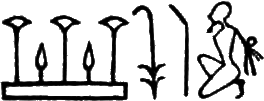 shasu, "the
Bedouins", whence "Bedouin prince(s)". They introduced the sole worship of the ass-headed
deity Set or Sutekh (which see). They were cruel masters and were finally driven out of the
country by Aahmes I. of the XVIIth dynasty (cf. page 102). 92
shasu, "the
Bedouins", whence "Bedouin prince(s)". They introduced the sole worship of the ass-headed
deity Set or Sutekh (which see). They were cruel masters and were finally driven out of the
country by Aahmes I. of the XVIIth dynasty (cf. page 102). 92
Ibn-el-Vardi. An Arabic historian who died in the year 750 of the Hégira [the flight of Mohammed from Mecca to Medîna], about 1350 A. D. The passage from this author on page 80 is also given by the Arabic geographer Edrisi (1153 A. D.). 79
Iliad. The famous Greek epic of Homer, recounting the story of the siege and capture of Troy, in Asia Minor. 37
Intaglio-relievo. The usual mode of carving employed by the Egyptians, where the figures were cut altogether into the stone, that is, all below the surface of the stone. 18
Ishmaël or Ismaïl. Ex-Khedive of Egypt, an able but extravagant ruler, who did much for the prosperity of that downtrodden country. In his reign the Suez Canal was completed. 40 82
Isis. The great Egyptian goddess in the triad: Osiris, Isis, and Horus. She was the
queen of heaven and the wife of Osiris, whose members she gathered after Set, the devil, had slain
him. Her name in Egyptian is 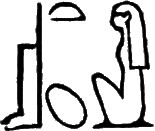 Ȧs·t, and she is represented with a throne on
the head; thus,
Ȧs·t, and she is represented with a throne on
the head; thus,  ,
,  ,
,  . 86
. 86
Jebel Selseleh. "The mountain of the chain." The modern name of that part of the country where the ancient {127}Silsilis was situated. An Arabic legend states, that at one time a chain was stretched across the Nile at this point to ward off the approach of the enemy's ships, whence the name. 86
Joseph. The biblical patriarch. His name has not yet been discovered on the monuments, though there is much in the Egyptian literature to remind us of his story; viz., in the Ameni inscription, describing the years of famine, and the "Tale of the Two Brothers", setting forth the great temptation and the wicked accusation. 2
Kadesh. A town in Syria where Ramses II. defeated the Hittites. In Egyptian 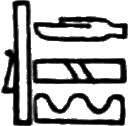 Qedesh. 35
Qedesh. 35
Karnak. A modern village on the east side of the Nile, marking the site of ancient northern Thebes. 2 3 6 9 10 11 19
Karnak Obelisks. There are still at Karnak six obelisks: two large ones of Thothmes I., one of them being prostrate and broken; two of queen Hatasu (which see); and two small ones, resembling stelé and bearing the name of Thothmes III. 9 10 11 19
Kenemti. The Egyptian name of the oasis El-Khargeh, which see. 89
Kharu. A Syrian tribe subdued by Seti I. 36
Khedive. The Persian word خديف [khedîf] signifying "the monarch". This is the title of the governor of Egypt. 40 44 82
Khefren. The Greek form of the Egyptian Khâfrâ, a king of the fourth dynasty, and
the builder of the second Great Pyramid of Memphis (Gizeh). His name in Egyptian is 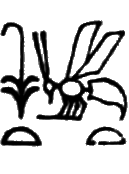
 suten-kaut? Khâ·f Râ, "The king of Upper and Lower Egypt, His glory is
Rā". 91
suten-kaut? Khâ·f Râ, "The king of Upper and Lower Egypt, His glory is
Rā". 91
Khennu. The ancient name of Silsilis, in Egyptian 
 and at present Jebel Selseleh,
which see. 86
and at present Jebel Selseleh,
which see. 86
Kheops. The Greek form of Khufu, which see. 91
Kheper. An Egyptian deity symbolizing the creative energy of the sun, which is the
source of all life. The deity is frequently represented as a man with the scarab or beetle on his
shoulders, instead of a head. His name in Egyptian is  , which is derived from the verb
, which is derived from the verb  kheper, "to create". 28 29
kheper, "to create". 28 29
Kheperȧ. The same as the above. In Egyptian 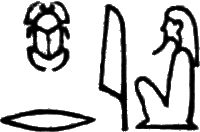 Kheperȧ. 63 64
Kheperȧ. 63 64
Kherp-kheper-Râ-sotep-en-Râ. The royal name of the king Osarkon I. 38 72
Kheta. An Asiatic people, the Hittites of the Bible, where they are called חִתִּים
[khittîm]. They are constantly mentioned in the Egyptian inscriptions, especially in those that
treat of the wars of Seti I. and Ramses II. Their Egyptian name is  ,
Kheta. 36 37
,
Kheta. 36 37
Khnum. The spirit of Amen-Râ, represented as a ram-headed deity; thus,  ,
, 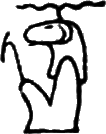 ,
,  . He
was especially worshiped at Elephantine, and his figure was painted a bright green. His Egyptian
name is
. He
was especially worshiped at Elephantine, and his figure was painted a bright green. His Egyptian
name is 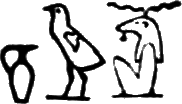 Khnumu. 86 87
Khnumu. 86 87
Khnum-Râ. A form of the solar deity, a combination of Râ and Khnum. 29
Khufu. A king of the fourth dynasty, the builder of the Great Pyramid at Gizeh, the
Kheops of the Greeks. His name in Egyptian is written 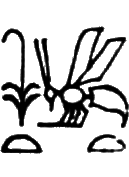
 suten-kaut? Khufu, "The king of Upper and Lower Egypt, Khufu". 5
suten-kaut? Khufu, "The king of Upper and Lower Egypt, Khufu". 5
Kircher, Athanasius. A German scholar and mathematician, who endeavored to solve the mysteries of the Egyptian language, but signally failed in the attempt. He died in 1680. 79
Kôm-Omboo. "The hill of Omboo." The modern name of the Egyptian 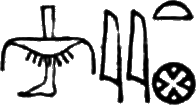 nubî·t, "the gold-city", called Ombos by the ancients, a city in the first nome of
Upper Egypt. The crocodile-headed god Sebek was worshiped here. 86
nubî·t, "the gold-city", called Ombos by the ancients, a city in the first nome of
Upper Egypt. The crocodile-headed god Sebek was worshiped here. 86
Kossêr. "Small castle." A town in Egypt situated on the Red Sea, to which a road led in ancient times from Coptos by way of Hammamât. The Greeks called it Leukos-Limen, "the white harbor". 23 88
Kuft. The modern name of Coptos, which see. 88
Labyrinth. The grand palace of Amenemhât III. in the Fayoom, described by the Greek
geographer Strabo. At one corner of it was the Pyramid of Howara, which is built of brick. The
name Labyrinth seems to be derived from the Egyptian  rupu ruḥun, "the
temple at the mouth of the canal" (see under El-Lahoon). 90
rupu ruḥun, "the
temple at the mouth of the canal" (see under El-Lahoon). 90
Lateran Obelisk. The largest of all the erect obelisks, in front of the church of St. Giovanni in Laterano, in Rome. It was ordered to be made by Thothmes III., but was completed by Thothmes IV., who added the outer vertical lines and erected the obelisk in front of the temple of Amen in Thebes. It was removed to Alexandria by Constantine the Great, but was taken to Rome by Constantius in 357. After its fall it was re-erected by Sixtus V. in 1588. 9 20 23 25
Lepsius, Richard K. The so-called "father of Egyptology", the teacher of the great Egyptologists of the present day. His greatest work was the Denkmäler {130}aus Ægypten und Æthiopien. He was born Dec. 23, 1810, and died July 10, 1884. 4 5 36 37
Lepsius Obelisk. A small obelisk discovered by Lepsius in a tomb at Gizeh in 1843. It is the smallest obelisk known and at present in the Berlin Museum. 4 10
Libyan Desert. The large tract of barren country to the west of Egypt, containing seven oases (see under El-Khargeh). 59 90
Lisht, Pyramid of. A small pyramid between those of Dashûr and Meydoom, situated near the Fayoom. 91
London Obelisk. The present name of the Alexandrian Obelisk, which see. 25 39 40 59 72 73 81 91
Lower Egypt. The northern part of Egypt, comprising the Delta. 16 31 51 65 90
Luxor. A village in the southern part of ancient Thebes on the east side of the Nile. 2 4 9 10 88
Luxor Obelisks. There are two obelisks of this name. One was brought to Paris in the reign of Louis Philippe of France, and erected on the Place de Concorde on Oct. 24, 1836. The cost of its removal was about $500 000. The other is now standing in Luxor.—Both obelisks stood originally, side by side, in front of the temple of Amenophis III. in Thebes, and are the most artistic obelisks extant. They were erected by Ramses II. 8 9 10 23 41
Mâ. An Egyptian deity, called the daughter of Râ. Her name signifies "Truth", and she
plays an important part in the theology of the ancient Egyptians. She represents the truth and
justice of the supreme god. Hence the Pharaohs received her attributes and were called "truthful
and just", or, as the inscriptions express it  Mâ mer, "the beloved of
Mā". Her name is written
Mâ mer, "the beloved of
Mā". Her name is written  Mâ [really Maâ] or
Mâ [really Maâ] or 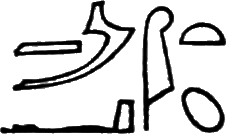 Maâ·t. 65 68 69
Maâ·t. 65 68 69
Mââd Boat. The boat of Râ, in which he was thought to travel over the expanse of heaven,
changing to the Sekti boat as Tum in the latter part of his journey. The word is written  mââd. 22
mââd. 22
Mahutean Obelisk, or the Pantheon Obelisk. It was erected by Ramses II. in Heliopolis. Clement XI. re-erected it in front of the Pantheon in Rome in 1711. A single column of hieroglyphs is inscribed on each of its faces. 10
Mâkarâ. The royal name of queen Hatasu, which see. 6 35
Mâ-men-Râ. The royal name of Seti I., which see. 87
Maqdâm-ibn-El·ﻋAmr-ben-abi-Reﻋâl. A mythical person. 80
Mars. The Roman god of war, the Arês of the Greeks, and the Menthu (which see) of the Egyptians. 61
Mareotis. The large lake south of Alexandria, called by the ancient Egyptians 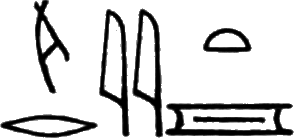 Merî·t, "the lake". 91
Merî·t, "the lake". 91
Matarîyeh. The modern name of Heliopolis, a short distance from Cairo. 1 5 36 91
Medînet-Habu. The modern name of a part of the necropolis of ancient Thebes, and the site of many ruins, especially those of the temples of Thothmes II. and Ramses III. 88
Mediterranean Sea. This was well known to the ancient Egyptians and traversed by the
fleets of many Pharaohs, who, at one time, even subjugated the islands in it. Its name in Egyptian
is 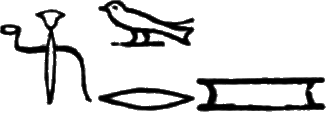 Ûaz-ûr, "the great sea". 90
Ûaz-ûr, "the great sea". 90
Megiddo. A town of the Kharu [Syrians] in Palestine, on the border of the great plain of
Esdraëlon, the scene of the battles between Thothmes III. and the Syrians, and between Neco and
the Jewish king Josiah. The {132}town was also taken by
Sheshonq I. in his war against Rehoboam, king of Judah. Its name in Egyptian is  Mâkethȧ. 36
Mâkethȧ. 36
Memnonium. Or Rameseum. The incorrect name given by the Greeks to the temple of Ramses II. in Shekh-abd-el-Qurnah, in the necropolis of ancient Thebes. It is called by the Greek geographer Diodorus the "tomb of Osymandyas". There is one colossal statue of Ramses II. still in its ruins. 16 88
Memphis. The Greek form of the Egyptian 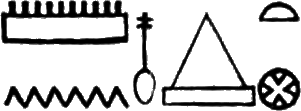 Men-nefer·t, "the good
place of rest", the biblical מֹף
[môf] or נֹף [nôf]. It was the
capital of the first nome of Lower Egypt, and its present site is the village Mîtrahîneh. The
whole district was a large necropolis with the famous pyramids from Gizeh to Saccarah. It is the
"white wall" of the Greek historian Herodotus, or the Egyptian
Men-nefer·t, "the good
place of rest", the biblical מֹף
[môf] or נֹף [nôf]. It was the
capital of the first nome of Lower Egypt, and its present site is the village Mîtrahîneh. The
whole district was a large necropolis with the famous pyramids from Gizeh to Saccarah. It is the
"white wall" of the Greek historian Herodotus, or the Egyptian 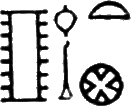 Ȧnbu-ḥez·t,
"the white wall". Its chief deity was Ptah. 4 10 19 65 90
91
Ȧnbu-ḥez·t,
"the white wall". Its chief deity was Ptah. 4 10 19 65 90
91
Mendes. The capital of the XVIth nome of Lower Egypt. 92
Menes. According to tradition the first Egyptian king, the founder of the Egyptian
empire, and the builder of Memphis. In Egyptian his name is written 
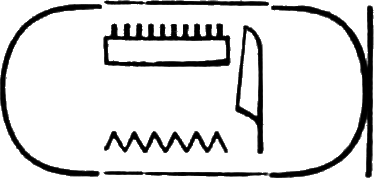 or
or  (as
on the necklace in the possession of the New York Historical Society) suten-kaut?
Menȧ, "the King of Upper and Lower Egypt, Menes". 89
(as
on the necklace in the possession of the New York Historical Society) suten-kaut?
Menȧ, "the King of Upper and Lower Egypt, Menes". 89
Men-kheper-Râ. The royal name of Thothmes III. 36 47 48 49 50 52 53 54 55 56 58 59 60
Menthu. The Egyptian god of war, identified by the Romans with their Mars. He is usually
represented with the head of a hawk surmounted by the disk of the sun and two feathers ( ). He
was only a form {133}of Amen-Râ, and was worshiped in
the district round about Thebes. His name in Egyptian is
). He
was only a form {133}of Amen-Râ, and was worshiped in
the district round about Thebes. His name in Egyptian is  Menthu. 87
Menthu. 87
Menzaleh Lake. A large and shallow tract of water in the north-east corner of Egypt, extending from Damietta to the Suez Canal. 92
Mer-ȧb. A son of Khufu of the fourth dynasty. The architect and builder of the Great Pyramid. 5
Merì·t. The Egyptian name of the Mareotis Lake. 91
Mer-Tum·t. The Egyptian name of the modern Meydoom, which see. 90
Mesopotamia. "The land between the rivers (Euphrates and Tigris)." The
eastern part of ancient Syria [Assyria], called in the Bible Padan-aram or Aram-nahara-yim (Gen.
xxiv:10), which means "Aram of the two rivers", whence the Egyptian designation 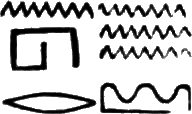 Nahar. The country was frequently invaded and subjugated by the Egyptian kings, notably by
Thothmes III., Amenôphis II., and Seti I. 36
Nahar. The country was frequently invaded and subjugated by the Egyptian kings, notably by
Thothmes III., Amenôphis II., and Seti I. 36
Mesphres. Pliny's name for Thothmes III. It is in reality, however, the name of his great sister, queen Hatasu, which see. 36
Meydoom. Or Meydoon [Mêdûn]. The modern name of the Egyptian  Mer-Tum·t, "the favorite city of the god Tum", situated in the XXIst nome of Upper Egypt, and famous for its quaintly terraced pyramid,
ascribed by Dümichen to king Snefru of the fourth dynasty. 90
Mer-Tum·t, "the favorite city of the god Tum", situated in the XXIst nome of Upper Egypt, and famous for its quaintly terraced pyramid,
ascribed by Dümichen to king Snefru of the fourth dynasty. 90
Mîtrahîneh. The present site of ancient Memphis. 91
Mizrayim. The Hebrew name of Egypt, really "the two Egypts". The Arabic is مصر [misr]. 84
Mnevis-bull. The sacred bull of Heliopolis, the incarnation of Râ. (98)
Moeris Lake. The so-called lake, or rather reservoir, in the Fayoom, constructed by Amenemhât III. to receive the excess of the waters of the inundation, and keep the water for the times of drought. 90
Monolith. A monument made of one stone only. 7 18
Monte Cavallo Obelisk. This is at present in front of the Quirinal in Rome, and is the companion of the Sta. Maria Maggiore Obelisk. As it is uninscribed, it is impossible to tell by whom or when it was erected. Perhaps the emperor Claudius [41-54 A. D.] had it removed to Rome. It was re-erected by Pius VI. in 1789. 9
Monte Citorio Obelisk, or the Campensis Obelisk, which see. 22 25
Monte Pincio Obelisk, or the Barberini Obelisk, which see. 22
Moses. The Jewish law-giver, who studied at the university in Heliopolis, was brought up at the court of the Pharaohs, and afterwards led the Israelites out of Egypt. He lived in the time of Ramses II., and departed with his people under Menephthah I. His name has not yet been found on the Egyptian monuments or in the papyri. 2
Mummies. The bodies of the Egyptian dead which were preserved in a mixture of salt, bitumen, cedar oil, &c. The bodies were prepared for embalming by the parakhistæ or tarakheutæ, who disemboweled them, wound linen bandages around them, placed with them chapters from the Book of the Dead (which see), and then deposited them in a sarcophagus of stone or wood, according to the means of the deceased. The purpose of this embalming was that the soul, on its return to the earth, would again find its body and reanimate it. Everything was, therefore, done by the ancient {135}Egyptians to protect their mummies against decomposition and robbers, some of the Pharaohs even building the monster-pyramids for their reception. 8 33 34
Mycerinus. The Greek form of the Egyptian Men-kau-Râ, a king of the fourth
dynasty and the builder of the third Great Pyramid. His sarcophagus and a part of his mummy are in
the British Museum. His name is written 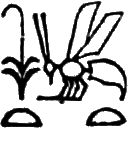
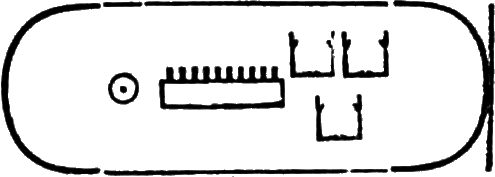 suten-kaut? Men-kau-Râ, "The king of Upper and Lower Egypt, The Sun, mighty in his
works". 91
suten-kaut? Men-kau-Râ, "The king of Upper and Lower Egypt, The Sun, mighty in his
works". 91
Nahasb Obelisk. A small and prostrate obelisk about 70 miles south-east of Suez, in the Sinaitic Peninsula. It was discovered by a German traveler in 1817, but nothing further is known of it. The place where it is standing is also called Wâdi Nasb. 11
Naples Obelisk. It is also called the Borgian Obelisk, having been for a time in the Borgian Museum at Velletri, and was discovered at Prænesté, Italy, in 1791, broken in four pieces. The inscription on it coincides with that of the Albani Obelisk (which see). It is now in the Museo Nazionale at Naples. 10
Necropolis. A Greek word meaning "the city of the dead", our "cemetery". In Egypt
the necropolis was generally a collection of rock-hewn tombs, but always situated to the west of a
city toward the setting sun, this being the first station on the road to the Lower World. It is
expressed in Egyptian by the sign  ȧa. 2 4 5
ȧa. 2 4 5
Nectanebo I. The Greek name of a king of the XXXth dynasty, who forced the Persian king Artaxerxes II. to relinquish his hold on Egypt and reigned for eighteen years. His Egyptian name is 9
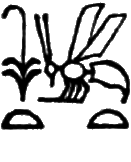 |
 |
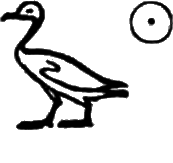 |
 |
| suten-kaut? | Senezem-ȧb-sotep-en-Ȧmen-Râ | sa Râ | Ȧmen-mer-nekht-Ḥer-ḥeb·t |
| The king of Upper and Lower Egypt, |
"Benevolent, chosen of Amen-Râ", |
the Sun's offspring, |
"Beloved of Amen, Nekht-Her-Heb." |
 |
 |
| suten-kaut? | Senezem-ȧb-sotep-en-Ȧmen-Râ |
| The king of Upper and Lower Egypt, |
"Benevolent, chosen of Amen-Râ", |
 |
 |
| sa Râ | Ȧmen-mer-nekht-Ḥer-ḥeb·t |
| the Sun's offspring, |
"Beloved of Amen, Nekht-Her-Heb." |
Negative Confession. A passage in the 125th chapter of the Book of the Dead, where the deceased gives an account of his life and begs to be admitted into paradise. To that end he states that he has not committed the forty-two great sins. (98)
Neith. The Egyptian goddess of the lower heavens, the sister of Isis and Nephthys. She
is generally represented holding a bow and arrows in her hand. The Greeks identified her with
their Athêné (Minerva). In Egyptian her name is  Net. 92
Net. 92
Nekheb. The goddess of Eileithyia and identified by the ancients with their Lucina, the
goddess of childbirth. Little is known of her. The Egyptian form of her name is 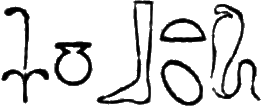 Nekheb·t. 87
Nekheb·t. 87
Nekheb·t. The Egyptian name of Eileithyiapolis, which see. 87
Nero. The fifth Roman emperor [54-68 A. D.]. His full name is Nero Claudius Cæsar Drusus Germanicus. On the Egyptian monuments he is called 11
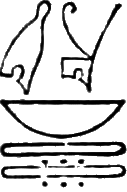 |
 |
| ḥez-desher neb taui |
ḥeq-ḥequ-sotep-en-Ptaḥ-mer-Ȧs·t |
| The possessor of the red and white crowns, lord of the two countries, |
"The prince of princes, chosen of Ptah,beloved of Isis", |
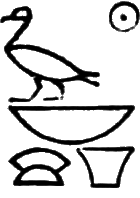 |
 |
| sa Râ neb khâu |
Autugreder Narȧni |
| the Sun's offspring, lord of diadems. |
"Autocrator Nero." |
New York Obelisk. It is usually, but incorrectly, called "Cleopatra's Needle". 20 23 25 49 72 73 81 91
Nile. The ancient Egyptians venerated it as a special deity, giving him the epithet  s·ânkh, "he who produces life". He was generally represented thus
s·ânkh, "he who produces life". He was generally represented thus 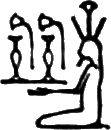 , and
his name was
, and
his name was  Ḥâp. 2 4 16 27 84 86
88 90 92
Ḥâp. 2 4 16 27 84 86
88 90 92
Nilometer. This was erected by the Pharaohs on the island of Elephantine, to enable them
to measure the height of the inundation. It was restored in 1870 by the Khedive Ishmaël. Another
Nilometer is at present on the island of Rhôda at Cairo. The Egyptian sign of the Nilometer is  ded, which means "stability". 86
ded, which means "stability". 86
Nineveh. The capital of the Assyrian empire. It was taken by several Pharaohs in their Asiatic campaigns, especially by Thothmes III., Amenôphis II., and Seti I. 36
Nome. The Greek word for "province". There were 22 nomes in Upper and 20 nomes in Lower
Egypt. The Egyptian word is  ḥesp, "the province". 84 90
ḥesp, "the province". 84 90
Nubia. It is also called Ethiopia, and was incorporated into the Egyptian empire at the
time of the XVIIIth dynasty. Its capital was Napata, now Jebel
Barkal, which even became the capital of the whole empire during the XXVIth dynasty. The Egyptian name of Nubia is  Kush,
the biblical כּוּשׁ
[kûsh]. 86
Kush,
the biblical כּוּשׁ
[kûsh]. 86
Nubî·t. The Egyptian name of Ombos, at present Kôm-Omboo (which see). 86
Oasis. There were seven oases in the Libyan desert, to the west of Egypt. The Egyptian
word is 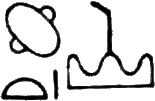 ut, "the oasis". 89
ut, "the oasis". 89
Ombos. The modern Kôm-Omboo, which see. 29 86
Orontes. The principal river of Syria, called in Egyptian  Ȧrunuth. 36
Ȧrunuth. 36
Osarkon I. A king of the XXIId dynasty, whose name in Egyptian is 38 71 72
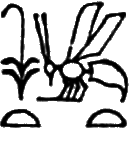 |
 |
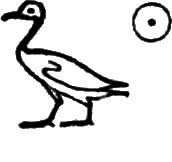 |
 |
| suten-kaut? | Kherp-kheper-Râ-sotep-en-Râ | sa Râ | Ȧmen-mer-Ûsarken |
| The king of Upper and Lower Egypt, |
"Made governor by Ra, chosen of Ra", |
the Sun's offspring, |
"Beloved of Amen, Osarkon." |
 |
 |
| suten-kaut? | Kherp-kheper-Râ-sotep-en-Râ |
| The king of Upper and Lower Egypt, |
"Made governor by Ra, chosen of Ra", |
 |
 |
| sa Râ | Ȧmen-mer-Ûsarken |
| the Sun's offspring, |
"Beloved of Amen, Osarkon." |
Osiris. One of the oldest of the Egyptian gods and the judge of the dead in the Lower
World. His worship was universal throughout Egypt at all times. His Egyptian name is  Usȧr. The great Osiris-myth is this. Osiris was, at one time, a king, and reigned
over Egypt. Going on travels he left Isis, his sister and wife, to conduct the government. The
devil, Set, then revolted against him, killed him, cut his body into fourteen pieces, and
scattered them over the country. Isis collected them, erecting a temple where a piece of his body
was found, and called on her son Horus to avenge his father. Horus met Set in combat at Edfu. In
this encounter Set was "transfixed". The inscriptions in the temple of Edfu give a glowing
description of this battle. Osiris is generally represented with his whole body shrouded in a
covering and his head surmounted by the atef-crown; thus,
Usȧr. The great Osiris-myth is this. Osiris was, at one time, a king, and reigned
over Egypt. Going on travels he left Isis, his sister and wife, to conduct the government. The
devil, Set, then revolted against him, killed him, cut his body into fourteen pieces, and
scattered them over the country. Isis collected them, erecting a temple where a piece of his body
was found, and called on her son Horus to avenge his father. Horus met Set in combat at Edfu. In
this encounter Set was "transfixed". The inscriptions in the temple of Edfu give a glowing
description of this battle. Osiris is generally represented with his whole body shrouded in a
covering and his head surmounted by the atef-crown; thus,  . He has a peculiar beard curving
outward at the end. He was considered to be the author of all animal and vegetable life, and the
god of agriculture. All those that died were called by his name, "the Osirian", that is, "amenable
to Osiris in his judgment-hall". 61 87 88 92
. He has a peculiar beard curving
outward at the end. He was considered to be the author of all animal and vegetable life, and the
god of agriculture. All those that died were called by his name, "the Osirian", that is, "amenable
to Osiris in his judgment-hall". 61 87 88 92
Palestine. Many Pharaohs, especially Thothmes III., subjugated this country in their
Asiatic conquests. The names of most of its cities and provinces occur on the Egyptian monuments.
One of its Egyptian names is  Kanâna, "Canaan". 36
Kanâna, "Canaan". 36
Pamphilian Obelisk, or the Obelisk of the Piazza Navona in Rome. This is a pseudo-Egyptian obelisk, cut by the Romans in the quarry of Syene. It was erected by the emperor Domitian, and re-erected by Innocent X. (Pamphili) in 1651 in its present position. There is a single column of poorly executed hieroglyphs on each face of it. 9
Panopolis. The Greek name of the capital of the IXth nome
of Upper Egypt, called in Egyptian  Per-Khem·t, "the city of the temple of (the god)
Khem". It was the seat of the worship of Khem, whom the Greeks identified with their Pan.
89
Per-Khem·t, "the city of the temple of (the god)
Khem". It was the seat of the worship of Khem, whom the Greeks identified with their Pan.
89
Pantheon Obelisk. The same as the Mahutean Obelisk, which see.
Papyrus. The Egyptian paper, made of thin slices of the papyrus plant, called in
Egyptian 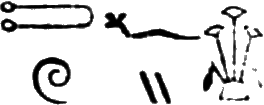 thufi. On it were written works on almost all subjects. The finest papyri
are at present in the British Museum and the Museum of Bulak. 34
thufi. On it were written works on almost all subjects. The finest papyri
are at present in the British Museum and the Museum of Bulak. 34
Pasht. The Greek name of the Egyptian goddess Sekhet, which see. 92
Pelusium. The classical name of a city near the site of the ancient Egyptian Avaris, which see. 92
Pentaûr. The Egyptian Homer, who described the exploits of Ramses II. in his war with
the Hittites. His name is written  Pen-ta-ûr. 37
Pen-ta-ûr. 37
Per-ba-neb-ded·t. The Egyptian name of Mendes, which see. 92
Per-Bas·t. The Egyptian name of Bubastis, which see. 92
Per-Khem·t. The Egyptian name of Panopolis, which see. 89
Per-Usȧr·t. The Egyptian name of Busiris, which see. 92
Pharaoh. The Hebrew form of the Egyptian  per-â, "the great
house", or more correctly, as the Hieratic generally has it,
per-â, "the great
house", or more correctly, as the Hieratic generally has it, 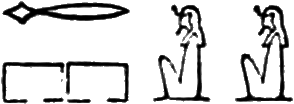 Per-â, "he of the great
double house". This was the official title of the Egyptian kings. 1
2 5 6 7 16 19 20 22
25 29 37 38 46 48 53
57 58 60 61 63 64 65
66 67 68 69 70 79 84
87 89
Per-â, "he of the great
double house". This was the official title of the Egyptian kings. 1
2 5 6 7 16 19 20 22
25 29 37 38 46 48 53
57 58 60 61 63 64 65
66 67 68 69 70 79 84
87 89
"Pharaoh of the Oppression." All Egyptologists are agreed that this was Ramses II. 37 63
"Pharaoh's Needle." The Arabic rendering for "obelisk". 79
Philae. An island in the Nile near the Nubian boundary, belonging to the first nome of Upper Egypt. 4 7 9 10 22 84 86
Philae Obelisk. A fragment of an obelisk which was erected, together with its companion, the Corfe Castle Obelisk (which see), in front of the temple of Isis by Ptolemy IX. Euergetes II. and his sister Cleopatra II. It has one column of hieroglyphs on each face, and is at Philæ. 9
Piânkhî. An Ethiopian king, of the XXIVth dynasty, who conquered Egypt at the close of the XXIId dynasty, when it was divided into thirteen petty kingdoms. His name in Egyptian is 21
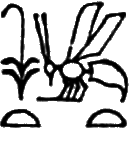 |
 |
 |
 |
| suten-kaut? | Men-kheper-Râ | sa Râ | P-ânkhî |
| The king of Upper and Lower Egypt, |
"The stable and creative Sun", |
the Sun's offspring, |
"He who lives." |
 |
 |
| suten-kaut? | Men-kheper-Râ |
| The king of Upper and Lower Egypt, |
"The stable and creative Sun", |
 |
 |
| sa Râ | P-ânkhî |
| the Sun's offspring, |
"He who lives." |
Piazza della Minerva Obelisk. A small obelisk in Rome. It has only a single column of hieroglyphs on each face, and was probably erected by Psametik II. in Saïs. It was removed by the Romans and re-erected by Pope Alexander VII. in 1667, who had it placed on a marble elephant. 10
Piazza del Popolo Obelisk. Another name of the Flaminian Obelisk, which see.
Piazza Navona Obelisk. Another name for the Pamphilian Obelisk, which see. 22
Pliny, surnamed "the Elder". A famous Roman naturalist and author (23-79 A. D.). 36
"Pompey's Pillar." The only important monument of antiquity at present in Alexandria. It is a shaft of granite from the quarry of Syene rising, with the pedestal, to the height of 104 ft., and erected by the Roman prefect Pompeius in honor of the emperor Diocletian. 91
Pontius. The architect who transported the two obelisks of Heliopolis to Alexandria in 12 B. C. He may have possibly also removed the Flaminian and Campensis Obelisks (which see) to Rome for the emperor Augustus in 20 B. C. 39 73 74 82
Porta del Popolo Obelisk. Another name of the Esmeade Obelisk, which see. 11
Prioli Obelisk. A small obelisk in the gardens of the Sultan in Constantinople. Nothing is known of it, as its inscriptions have never been published. 9
Psametik II. A king of the XXVIth dynasty, the son of Psametik I. He conquered Ethiopia and reigned for six years. His son Hophra is mentioned in the Bible. His name in Egyptian is 7 9 10 22
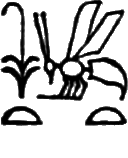 |
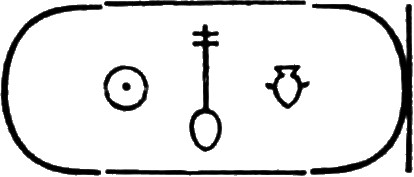 |
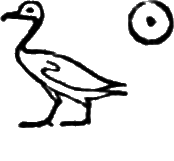 |
 |
| suten-kaut? | Nefer-ȧb-Râ | sa Râ | Psemthek |
| The king of Upper and Lower Egypt, |
"the kind-hearted Sun", |
the Sun's offspring, |
"Psametik." |
 |
 |
| suten-kaut? | Nefer-ȧb-Râ |
| The king of Upper and Lower Egypt, |
"the kind-hearted Sun", |
 |
 |
| sa Râ | Psemthek |
| the Sun's offspring, |
"Psametik." |
Pseudo-Egyptian, that is, having the appearance of being Egyptian, but not so in reality. A number of the extant obelisks belong in this category. 4
Pthah [pronounced tá]. The chief deity of Lower Egypt, an emanation of Râ. He is
generally represented as a deformed child holding two serpents and stepping on two crocodiles. In
Upper Egypt he was worshipped under the form of an upright mummy ( ). His name in Egyptian is
). His name in Egyptian is  Ptaḥ. 65 69 90
Ptaḥ. 65 69 90
Ptaḥ-Sokar-Osiris. A form of Ptah, peculiar to Memphis, and represented as a
deformed child. His Egyptian name is 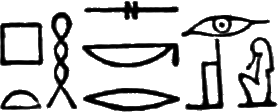 Ptaḥ-Seker-Usȧr. 29
Ptaḥ-Seker-Usȧr. 29
Ptaḥ-tathunen. A title of Ptah of Memphis. The Egyptian form of the word is  Ptaḥ-tathunen, meaning perhaps "Ptah of the stable earth". 65
Ptaḥ-tathunen, meaning perhaps "Ptah of the stable earth". 65
Ptolemies. The descendants of Ptolemy Sôtêr, a general of Alexander the Great, and forming the XXXIIId dynasty of Egyptian kings. Each of them married his sister. Their reign extended from 305 to 30 B. C., and was characterized by infamy, tyranny, murder, and poisoning. 9 21 22
Ptolemy IX. Euergetes II. A weak king of the XXXIIId dynasty, married to and reigning for a time with his sister Cleopatra II. and his niece Cleopatra III. His name in Egyptian is 7 10
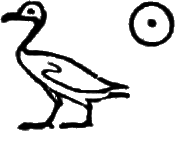 |
 |
| sa Râ | Ptûlmîs-ânkh-zeta-Ptaḥ-mer |
| the Sun's offspring, |
"Ptolemy, living forever, beloved of Ptah." |
Punt. The Egyptian name of the southern part of Arabia, which see.
Pylon. The large mass of masonry of an Egyptian temple, resembling two truncated
pyramids with the gate between them. A picture of one is given on page 20.
Its hieroglyph is perhaps  . 20 24
. 20 24
Pyramidion. The apex of an obelisk which resembles a miniature pyramid. It was sometimes inscribed with pictures and hieroglyphs, and covered with a capping of gold-metal or electrum (which see). 18 19 21 22 26 47 50 51 52 53 54 55
Pyramids. The enormous masses of stone built by various kings, especially those of the
fourth dynasty, and serving as their tombs. There are quite a number of them in and near ancient
Memphis, the largest being that of Khufu, called the Great Pyramid, which is 480 ft. high. The
usual Egyptian word for "pyramid" is 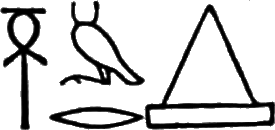 ȧbmer. 12 27 91
ȧbmer. 12 27 91
Qebti·t. The Egyptian name of Coptos, which see. 88
Qem·t. The common Egyptian designation of Egypt, which see. 61 66 70 84
Qurnah. A modern village marking the site of a part of the necropolis of ancient Thebes, situated on the west shore of the Nile. Here are the ruins of the grand temple begun by Seti I., and completed by Ramses II. 88
Râ. The Sun, the Supreme Being, and the organizer of the world according to Egyptian
mythology. He was worshipped in the entire country, but especially in Heliopolis. He is always
represented with the face of a hawk. With the fifth dynasty the Pharaohs began to call themselves
the incarnation of Râ, or 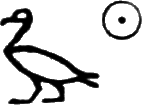 sa Râ, "the son of the Sun", which title they
retained until the time of the Roman emperors. The Egyptian name of the sun is
sa Râ, "the son of the Sun", which title they
retained until the time of the Roman emperors. The Egyptian name of the sun is  Râ. 21 22 27 30 31 36 37
38 39 46 47 48 49 50
52 53 54 55 56 57 58
59 60 61 62 63 64 65
66 67 68 69 70 71 72
82 91
Râ. 21 22 27 30 31 36 37
38 39 46 47 48 49 50
52 53 54 55 56 57 58
59 60 61 62 63 64 65
66 67 68 69 70 71 72
82 91
Râ-Ḥor-Khuti. A name of the sun-god, written in Egyptian 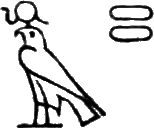 or
or  Râ-Ḥor-khuti, "the Sun, the hawk of the two horizons". 28 29 30 46
47 49 55 58 59 60
Râ-Ḥor-khuti, "the Sun, the hawk of the two horizons". 28 29 30 46
47 49 55 58 59 60
Ramses II. One of the greatest monarchs the world ever saw, the son of Seti I., and a king of the XIXth dynasty. He conquered most of the then known world, built magnificent temples, erected obelisks, and perpetuated his name on almost every Egyptian monument. His Egyptian name is 7 8 9 10 16 36 37 62 63 64 65 66 67 68 69 70 71 88 91
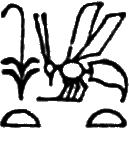 |
 |
| suten-kaut? | User-Mâ-Râ-sotep-en-Râ |
| The king of Upper and Lower Egypt, |
"Strong in truth, the Sun, chosen of the Sun", |
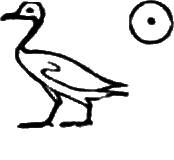 |
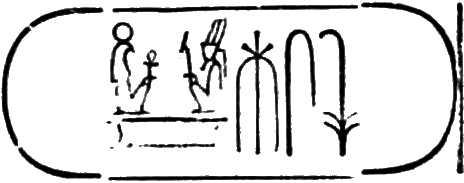 |
| sa Râ | Ȧmen-mer-Râ-meses-su |
| the Sun's offspring, |
"Beloved of Amen, the Sun, begetting himself." |
Ramses III. A famous king of the XXth dynasty, who conquered the Hittites, Syrians, and the tribes of Palestine. His name in Egyptian is 112 131
 |
 |
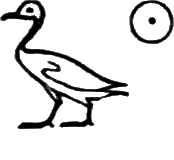 |
 |
| suten-kaut? | User-mâ-Râ-Ȧmen-mer | sa Râ | Râ-meses-ḥeq-Ȧn |
| The king of Upper and Lower Egypt, |
"Strong in truth, the Sun, beloved of Amen", |
the Sun's offspring, |
"The Sun's child, prince of Heliopolis." |
 |
 |
| suten-kaut? | User-mâ-Râ-Ȧmen-mer |
| The king of Upper and Lower Egypt, |
"Strong in truth, the Sun, beloved of Amen", |
 |
 |
| sa Râ | Râ-meses-ḥeq-Ȧn |
| the Sun's offspring, |
"The Sun's child, prince of Heliopolis." |
Râqedî·t. The Egyptian name of Alexandria (which see), called Rhakôtis by the ancients. 91
Redesieh. A modern village in what was formerly the first nome of Upper Egypt. 68
Red Sea. This was called in Egyptian  muqed·t. 86 88
muqed·t. 86 88
Rhakotis. The Greek name of the town on whose site Alexander the Great built Alexandria (which see). 91
Rising Sun. The god Râ. 22
Rome. The capital of the ancient world. Its Egyptian name occurs on the Barberini
Obelisk as  Harmâ·t. 5 7 9 20 22 23 25
Harmâ·t. 5 7 9 20 22 23 25
Rosetta. A modern town at the mouth of the Bolbitinic arm of the Nile. It was the ancient Bolbitiné. 91
Rosetta Stone. Without a doubt this is the most important monument of antiquity that has come down to us. It is a stelé of black basalt, bearing an inscription in Hieroglyphic, Demotic, and Greek. It contains a decree of the priests in honor of Ptolemy V. Epiphanes, which was issued on March 27, 195 B. C. This stone, discovered in 1799, furnished the key for deciphering the hieroglyphs, and is now preserved in the British Museum. 92
Rotennu. A Syrian people who were repeatedly defeated and subjugated by kings of the
XVIIIth and later dynasties. They were subdivided into the Upper and
Lower Rotennu, and their Egyptian name was  Rethennu. 36
Rethennu. 36
Saccarah. A modern village near the site of ancient Memphis with a number of famous pyramids. The name is undoubtedly derived from that of the god Ptah-Sokar-Osiris. 91
Sa-el-Hajar. The modern name of Saïs. 92
Saïs. The capital of the fifth nome of Lower Egypt, the Egyptian 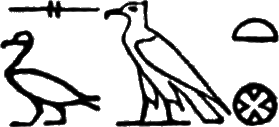 Sa·t, and the Coptic
Sa·t, and the Coptic  [saï]. Nothing now remains but a mass of débris. 4 10 92
[saï]. Nothing now remains but a mass of débris. 4 10 92
Saîu·t. The Egyptian name of Sioot, which see. 89
Sallustian Obelisk. An obelisk in Rome standing opposite the church of Santa Trinita dei Monti. It is a poor Roman copy of the Piazza del Popolo Obelisk, and has three columns of hieroglyphs on it, together with the cartouches of Seti I. and Ramses II. It was re-erected by Pius VI. in 1789. 9
Sân. The modern name of Tanis, which see. 11
Sân Obelisks. As many as thirteen fragments of perhaps four obelisks are still at Tanis (Sân). These obelisks appear to have been erected by Ramses II. 11
Sarbut-el-Khedem Obelisk. An erect obelisk in the Sinaitic Peninsula, on the way from Suez to Mount Sinai. The hieroglyphs on it are partially obliterated. 9
Sa·t. The Egyptian name of Saïs, which see. 92
Sebek. The crocodile-headed deity and a form of Râ. He was specially worshiped in the
Fayoom, and his Egyptian name was  Sebek. 90
Sebek. 90
Sebek-Râ. A combination of the gods Sebek and Râ, the local deity of Ombos. 29
Sekhet. A lion-headed goddess and the wife of Ptah. As a destroying deity her name is  Sekhet, but as a goddess of love it was
Sekhet, but as a goddess of love it was 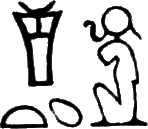 Bast, or, as the Greeks
called her, Pasht. She was usually identified with Diana. (92 98 103)
Bast, or, as the Greeks
called her, Pasht. She was usually identified with Diana. (92 98 103)
Sektet Boat. The boat of the evening-sun Tum, in which he was thought to pass over the
heavens. In Egyptian the word is written  sektet. 22
sektet. 22
Seni·t. The Egyptian name of Esneh, which see. 87
Set or Sutekh. The national god of the Hyksos or the Shepherd kings of Asia,
whose worship was forced on the Egyptians. He was the personification of evil, and was represented
as an ass-headed deity with the usual divine insignia. He was the sworn enemy of Horus, whose
father (Osiris) he had slain, and is identified with the devil. His picture,  , was
afterwards completely erased by the Egyptians from their monuments. His Egyptian name is
, was
afterwards completely erased by the Egyptians from their monuments. His Egyptian name is  Set or
Set or 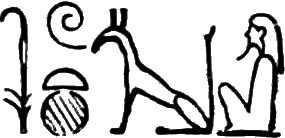 Sutekh. 87
Sutekh. 87
Seti I. A famous king of the XIXth dynasty and the father of Ramses II. He was an intense worshipper of Set, the devil, and forced his adoration on the people. His many wars carried him into Arabia Felix, Palestine, the Hittite territory, and beyond the Orontes and Euphrates. Out of him and his two successors the ancients fabricated the name Sesostris. His Egyptian name is 6 9 86 87 88
 |
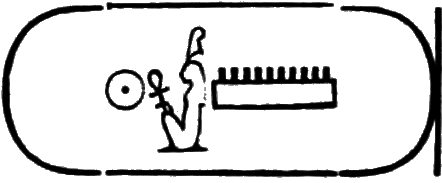 |
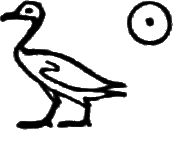 |
 |
| suten-kaut? | Mâ-men-Râ | sa Râ | Setî-mer-en-Ptaḥ |
| The king of Upper and Lower Egypt, |
"Truth, the stable Sun", |
the Sun's offspring, |
"Seti, the beloved of Ptah." |
 |
 |
| suten-kaut? | Mâ-men-Râ |
| The king of Upper and Lower Egypt, |
"Truth, the stable Sun", |
 |
 |
| sa Râ | Setî-mer-en-Ptaḥ |
| the Sun's offspring, |
"Seti, the beloved of Ptah." |
Setting Sun. The god Tum, which see. 22
Shepherd Kings. See under Hyksos. 92
Silsilis. The Egyptian Khennu, which see. 86
Sinaitic Peninsula. That part of western Asia lying between Syria and Egypt, and playing an important part in the forty years' sojourn there of the Israelites under Moses. 1 4 9 11
Sion House Obelisk. Perhaps the same as the Alnwick Castle Obelisk, which see.—Sion House is the country-seat of the Duke of Northumberland. 10
Sioot. The modern name of the capital of the XIIIth nome of
Upper Egypt, called in Egyptian  Saìu·t. Its local deity was the jackal-headed god
Anubis. 89
Saìu·t. Its local deity was the jackal-headed god
Anubis. 89
Soughton Hall Obelisk. An obelisk mentioned by Bonomi, which may be identical with one of those at present in England. 11
Sphinx. There are three kinds of sphinxes: Androsphinxes, having the head of a man; Criosphinxes, having that of a ram; and Hieracosphinxes, having that of a {148}hawk. A few are also found with the form of a woman. "The Sphinx" is the monster figure in front of the Pyramid of Khufu, but older than it. It was cut out of a solid mountain, and had between its paws a temple of Harmachis, to whom it was dedicated. The sphinx represents the incarnation of the divine wisdom of the Pharaoh 32 46 47 49 50 51 52 53 54 55
Stele. A slab rounded off on top and covered with inscriptions. It was made either of
wood or of stone. The word comes from the Greek στήλη [stêlê]. The Egyptian word for it is 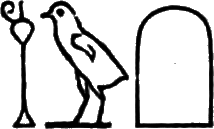 utu. 5 31 37 48
utu. 5 31 37 48
St. Ephraim Syrus. A Christian writer of the Syrian church, who died 373 A. D. 19
Sta. Maria Maggiore Obelisk. The companion of the Monte Cavallo Obelisk, at present in front of the basilica (church) of Santa Maria Maggiore in Rome. It has no inscriptions, and was removed to Rome by the emperor Claudius. Sixtus V. re-erected it on its present site in 1587. 9
Stuart, Villiers. A traveler and author. 2
"Sublime Porte." The name of the place where the Sultan administers justice, and, with us, a designation for the Sultan himself. The Turkish term for it is باب عالی [bâbi 'âlî], "the high gate". 53
Suez Canal. The first attempt to construct it was made by Seti I., of the XIXth dynasty. It then only connected the Nile with the Red Sea, and was finished by Ramses II. Traces of it still remain. The present Canal was planned and completed by Lesseps in 1869. 40
Sun·t. The Egyptian name of Syêné. 86
Syêné. The Greek name of the modern Assuân, which was in the first nome of Upper Egypt,
and called  {149}Sun·t by the Egyptians.
The famous quarries, from which most of the obelisks were taken, were located here. The biblical
name is סְוֵנֵה
[s'vênêh, cf. Ezekiel xxix:10, xxx:6], which is the same as the Coptic
{149}Sun·t by the Egyptians.
The famous quarries, from which most of the obelisks were taken, were located here. The biblical
name is סְוֵנֵה
[s'vênêh, cf. Ezekiel xxix:10, xxx:6], which is the same as the Coptic  [sûan], and the Arabic اسوان [aswân]. 5 13 16 23 24 35 82 86
[sûan], and the Arabic اسوان [aswân]. 5 13 16 23 24 35 82 86
Syenite. The reddish amphibole-granite of Syêné, which was taken for all the Egyptian obelisks. 23
Syria. A large tract of country in western Asia, bordering on Egypt. It was inhabited by many different tribes, with whom the Pharaohs of the XVIIIth and XIXth dynasties carried on extensive wars. 36
Ta-en-ta-rer·t. The Egyptian name of Denderah, which see. 88
Tanis. The Greek name of the Egyptian  Zân·t the capital of the
XIVth nome of Lower Egypt, now Sân. It was the main seat of the
Hyksos, who embellished it in every possible way. 4 11 45 92
Zân·t the capital of the
XIVth nome of Lower Egypt, now Sân. It was the main seat of the
Hyksos, who embellished it in every possible way. 4 11 45 92
Tathunen. See under Ptah-tathunen. 65
Tel-Basta. The modern name of Bubastis, which see. 92
Tel-el-Amarna. The present site of a city founded by the heretic king Amenôphis IV. in honor of the sun-disk Aten, in the XVth nome of Upper Egypt. It was totally destroyed after his death. 29 89
Thebes. The largest and most famous city of the ancient world, the capital of the fourth
nome of Upper Egypt and of the whole empire. Its usual Egyptian name was  Us·t, or
Us·t, or 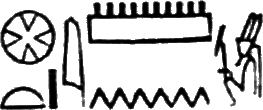 nu·t Ȧmen, which was sometimes shortened into
nu·t Ȧmen, which was sometimes shortened into  nu·t â·t, "the great city", or
nu·t â·t, "the great city", or  nu·t, "the City"
simply, the biblical נא [nô]. Its site is
now occupied by several villages, such as Karnak, {150}Luxor, &c. The local deity was Amen. 2 3 4 9 10 11 16 28 29
48 50 53 55 56 57 59
60 87 88 89
nu·t, "the City"
simply, the biblical נא [nô]. Its site is
now occupied by several villages, such as Karnak, {150}Luxor, &c. The local deity was Amen. 2 3 4 9 10 11 16 28 29
48 50 53 55 56 57 59
60 87 88 89
Theni·t. The Egyptian name of Thinis. 89
Thinis or This. The capital of the eighth nome of Upper Egypt, the reputed home
of the first king of Egypt, Menes. Its Egyptian name is 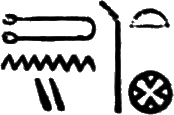 Theni·t, at present
El-Tineh, which see. 89
Theni·t, at present
El-Tineh, which see. 89
Thoth [pronounced tót]. The Egyptian god of writing, learning, and medicine. He
was thought to introduce the soul of the deceased into the Lower World and to read off its sins
before the judgment-seat of Osiris. He was afterwards identified with the moon. His sacred animal
was the cynocephalus-ape ( or
or  ), and he himself is represented with the head of the ibis,
), and he himself is represented with the head of the ibis,
 .
His name in Egyptian is
.
His name in Egyptian is 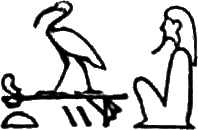 or
or 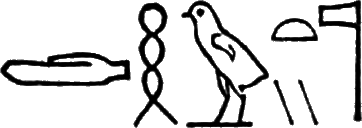 Deḥuti. 49 56 57
Deḥuti. 49 56 57
Thothmes I. [tótmees]. A king of the XVIIIth dynasty and the son of Aahmes I. He was a mighty warrior, and his conquests were very extensive. His name in Egyptian is 5 9 10
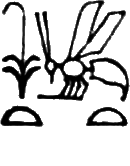 |
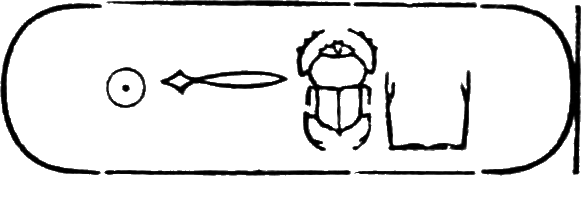 |
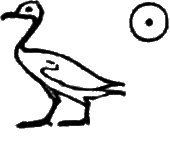 |
 |
| suten-kaut? | Râ-â-kheper-ka | sa Râ | Râ-Deḥuti-khâ-ma-meses |
| The king of Upper and Lower Egypt, |
"The great Sun, producing works", |
the Sun's offspring, |
"Glorious like the Sun, child of Thoth." |
 |
 |
| suten-kaut? | Râ-â-kheper-ka |
| The king of Upper and Lower Egypt, |
"The great Sun, producing works", |
 |
 |
| sa Râ | Râ-Deḥuti-khâ-ma-meses |
| the Sun's offspring, |
"Glorious like the Sun, child of Thoth." |
Thothmes II. [tótmees]. A king of the XVIIIth dynasty and a son of Thothmes I. He was a weak monarch and altogether under the influence of his great sister Hatasu. His name in Egyptian is 6
 |
 |
 |
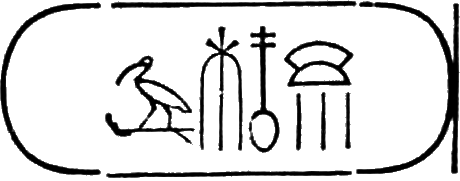 |
| suten-kaut? | Â-kheper-en-Râ | sa Râ | Deḥuti-mes-nefer-khâu |
| The king of Upper and Lower Egypt, |
"Formed by the great Sun", |
the Sun's offspring, |
"The child of Thoth, beautiful in his appearances." |
 |
 |
| suten-kaut? | Â-kheper-en-Râ |
| The king of Upper and Lower Egypt, |
"Formed by the great Sun", |
 |
 |
| sa Râ | Deḥuti-mes-nefer-khâu |
| the Sun's offspring, |
"The child of Thoth, beautiful in his appearances." |
Thothmes III. [tótmees]. The greatest king of the {151}XVIIIth dynasty, a son of Thothmes I. His empire extended over all the then known world. The New York Obelisk was erected by him. His name in Egyptian is 6 7 9 10 19 31 35 36 37 38 46 47 48 49 50 52 53 54 55 56 57 58 59 60 61 62 82
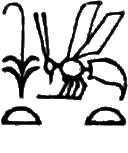 |
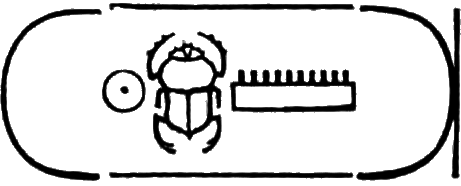 |
 |
 |
| suten-kaut? | Men-kheper-Râ | sa Râ | Deḥuti-meses-nefer-kheperu |
| The king of Upper and Lower Egypt, |
"The stable and creative Sun", |
the Sun's offspring, |
"The child of Thoth, of beautiful form." |
 |
 |
| suten-kaut? | Men-kheper-Râ |
| The king of Upper and Lower Egypt, |
"The stable and creative Sun", |
 |
 |
| sa Râ | Deḥuti-meses-nefer-kheperu |
| the Sun's offspring, |
"The child of Thoth, of beautiful form." |
Thothmes IV. [tótmees]. A king of the XVIIIth dynasty, the successor of Amenôphis II. He reigned for nine years only, and his Egyptian name is 6 9 19
 |
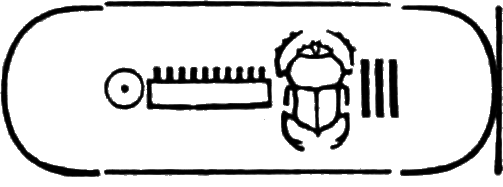 |
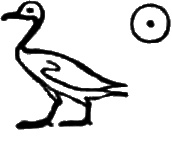 |
 |
| suten-kaut? | Men-kheperu-Râ | sa Râ | Deḥuti-meses-khâ-khâu |
| The king of Upper and Lower Egypt, |
"The Sun, stable in his forms", |
the Sun's offspring, |
"The child of Thoth, glorious in his diadems." |
 |
 |
| suten-kaut? | Men-kheperu-Râ |
| The king of Upper and Lower Egypt, |
"The Sun, stable in his forms", |
 |
 |
| sa Râ | Deḥuti-meses-khâ-khâu |
| the Sun's offspring, |
"The child of Thoth, glorious in his diadems." |
Troja. The name which the Greeks gave to the town near Memphis, the  Ru-âu·t (with the feminine article ta-Ru-âu·t) of the Egyptians. Here was situated
the quarry of Memphis. The similarity of the words gave rise to the name "Troja" (Troy), which
must not, however, be confounded with the famous Greek city of the same name in Asia Minor.
91
Ru-âu·t (with the feminine article ta-Ru-âu·t) of the Egyptians. Here was situated
the quarry of Memphis. The similarity of the words gave rise to the name "Troja" (Troy), which
must not, however, be confounded with the famous Greek city of the same name in Asia Minor.
91
Tum. The Egyptian god of the setting sun. He was especially worshiped in Heliopolis. In
painted inscriptions his color is generally red, like that of Râ, sometimes, however, also green.
His name in Egyptian is 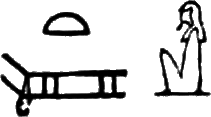 Tum. 22 27 28 29 46
51 53 56 57 58 67
Tum. 22 27 28 29 46
51 53 56 57 58 67
Tura. The quarry of Memphis from which the "white stone" was taken. The Greeks called it Troja, which see. 91
"Two Countries." A designation of Egypt, which was divided into two parts, Upper and
Lower Egypt. It {152}may, however, also signify "heaven
and earth" or "the universe". It is in Egyptian  taui, "the two
countries". (39 39) 47 48 49 50
51 52 53 54 55 62 63
64 65 66 67 68 69 70
taui, "the two
countries". (39 39) 47 48 49 50
51 52 53 54 55 62 63
64 65 66 67 68 69 70
Upper Egypt. The southern part of Egypt from the Fayoom to Assuân. 2 3 31 84 89
Upper and Lower Egypt. The two divisions of Egypt, which were at certain periods of
Egyptian history separate kingdoms. Some of the Egyptian designations are 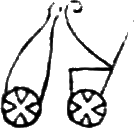 ḥez-desher, "the land of the white and red crowns" (cf. page 31),
ḥez-desher, "the land of the white and red crowns" (cf. page 31),  qebeḥui, "the land of the two sources
(of the Nile)" (cf. page 119),
qebeḥui, "the land of the two sources
(of the Nile)" (cf. page 119), 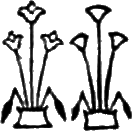 res-meḥ, "the
south and north land",
res-meḥ, "the
south and north land", 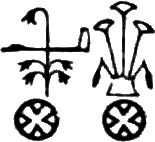 qemâ-meḥ, "the south and north land",
qemâ-meḥ, "the south and north land",
 ?-ûz, "the land of the lotus and the papyrus", &c. The usual title of the king
was
?-ûz, "the land of the lotus and the papyrus", &c. The usual title of the king
was 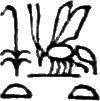 suten-kaut?, "the king of Upper and Lower Egypt". 30 48 52 53
54 56 57 58 59 60 61
62 63 64 65 66 67 68
69 70 72 84
suten-kaut?, "the king of Upper and Lower Egypt". 30 48 52 53
54 56 57 58 59 60 61
62 63 64 65 66 67 68
69 70 72 84
Uraeus Snake. The Cobra haje of Egypt, the most deadly reptile in that country,
whose figure was worn as the head-dress of kings and queens. It typifies Pharaoh's power over the
life and death of his subjects, and its Egyptian name is 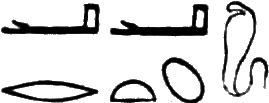 ârâ·t. The Greeks called it
"basilisk", from which they took their word for "king", βασιλεύς [basileus]. 56 57
ârâ·t. The Greeks called it
"basilisk", from which they took their word for "king", βασιλεύς [basileus]. 56 57
User-Mâ-Râ-sotep-en-Râ. The royal name of Ramses II., which see 37 62 63 64 65 66 67 68 69 70 71
Usertesen I. The second king of the XIIth dynasty, the son of Amenémhâ I., and the conqueror of the Ethiopians. His name in Egyptian is 5 9 11 36 91
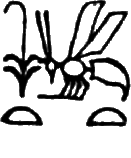 |
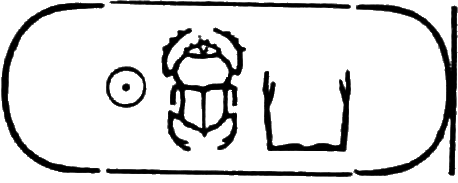 |
 |
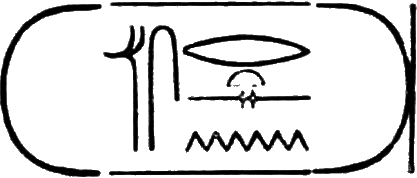 |
| suten-kaut? | Râ-kheper-ka | sa Râ | Usertesen |
| The king of Upper and Lower Egypt, |
"The Sun, producing works", |
the Sun's offspring, |
"Usertesen." |
 |
 |
| suten-kaut? | Râ-kheper-ka |
| The king of Upper and Lower Egypt, |
"The Sun, producing works", |
 |
 |
| sa Râ | Usertesen |
| the Sun's offspring, |
"Usertesen." |
Us Sceptre. The symbol of power carried in the hands of kings and gods, written  us, or else
us, or else  us, which is the "cucufa", also called the Zâm-sceptre. 46 87
us, which is the "cucufa", also called the Zâm-sceptre. 46 87
Us·t. The Egyptian name of Thebes, which see. 48 50 53 55 56 59 87
Vatican Obelisk. An obelisk without an inscription on the Piazza di San Pietro, in front of the Vatican, in Rome. Originally erected in Heliopolis, it was transported to Rome by the emperor Caligula (about 40 A.D.). It was the only one of all the obelisks not overthrown and broken during the times of anarchy, pillage, and destruction in that city. Sixtus V. had it removed and erected in its present position in 1586. 9
Victory Stelé. A stelé which was found in Karnak. It contains a martial hymn of Thothmes III. 31 48
Villa Mattei Obelisk. A small obelisk in the Villa Mattei or the Villa Celimontana in Rome, presented by a certain Cyriacus Matthæius to the Roman Senate. It was either erected by him in his gardens in 1582, or else by Sixtus V. in 1590. The lower portion of it is modern, but the upper half bears the cartouches of Ramses II. and Psametik II. 10
"Vocal Memnon." One of the colossal statues of Amenôphis III. west of Thebes in the desert. It was thrown down by an earthquake about 27 B. C., and cracked. On re-erection it was found to emit a musical sound at sunrise. This gave rise to the Greek legend of Memnon and Aurora (the dawn). Since its restoration the sound is no longer heard. The Arabs call the two colossal statues Shamy and Damy. (96 112)
Vulture Diadem. A diadem of Pharaoh, in Egyptian  neb mut or neb sheta
(doubtful!). The figure of the vulture was generally worn as the head-dress of {154}the queens. It is the symbol of protection, and
represents Pharaoh and his queen as the protectors and nourishers of their people. 56 57 66 70
neb mut or neb sheta
(doubtful!). The figure of the vulture was generally worn as the head-dress of {154}the queens. It is the symbol of protection, and
represents Pharaoh and his queen as the protectors and nourishers of their people. 56 57 66 70
Wanstead Obelisk. A fragment of an obelisk which existed at the time of Zoëga in Wanstead, a suburb of London. It was brought to England from Alexandria in 1712. Its present location is unknown. 11
Wilkinson, Sir John Gardner. An English Egyptologist (born in 1797, died in 1875). His famous work is The Manners and Customs of the Ancient Egyptians. 14
Yaﻋmer-ben-Shaddâd. A mythical person. 80
Zân·t. The Egyptian name of Tanis, which see. 92
Zoëga, George. A Danish archæologist interested in Egyptological subjects (born in 1755, died in 1809 in Rome). 11
OF HIEROGLYPHS OCCURRING IN THIS BOOK, TOGETHER WITH THEIR PRONUNCIATION AND DETERMINATIVE VALUE.
We divide the Egyptian hieroglyphs, after the manner of Lepsius, into twenty-five classes. In the following list the hieroglyphs are given together with what they were probably meant to represent. The more important pronunciations are added, which, however, can not be used indiscriminately, but are fixed by complements, that is, letters of the alphabet indicating the pronunciation and either prefixed or else suffixed to the hieroglyph. The pronunciation of the later, or Ptolemaic, times is marked *. Determinatives are silent hieroglyphs, determining, in words of the same pronunciation, into what category of objects or ideas these words belong.
Pron. stands for pronunciation. * stands for pronunciation of later times. Det. stands for determinative. The numerals refer to the pages of the book where the hieroglyph occurs.
I. Figures of Men.
Det. of person, youth. 62
Pron. qa, ḥââ.
Det. of height, joy, carrying, lifting. 61
Pron. ȧau, ten.
Det. of old age, weakness. 27
Pron. nekht.
Det. of violent action. 60
Pron. *ḥeq. 106 136 136 136 136
Pron. s, *n, *nen *sherȧ, *khen, *â, *kh.,
Det. of child, youth, renewal. 27 27 48
Det. of enemy, crime. 126
Pron. ȧ (as first person singular masculine personal pronoun).
Det. of man, person. 94 94 94 121
 "man with finger in his mouth."
"man with finger in his mouth."
Pron. ȧm.
Det. of speaking, eating, thinking. 137
Pron. ȧ (as first person singular masculine personal pronoun). 31 48
Det. of man, king, god, goddess. 27 27 27 27 27 65 92 105 128 128 138 139 142 143 144 144 144 144 146 146 150 151
Pron. ȧ (as first person singular masculine personal pronoun).
Pron. same as preceding.
 "king with white crown of Upper Egypt."
"king with white crown of Upper Egypt."
Pron. ȧ (as first person singular masculine personal pronoun).
 "king with the double crown of Egypt and the Zâm-sceptre."
"king with the double crown of Egypt and the Zâm-sceptre."
Pron. same as preceding.
Det. of king, god. 133
 "man sitting on a throne with the whip in his hands."
"man sitting on a throne with the whip in his hands."
Det. of high personage, ancestor, god. 56
II. Figures of Women.
Pron. ȧ (as first person singular feminine personal pronoun).
Det. of woman, goddess. 121 126 136
 "woman with a tiara and having the bud of a lotus in her lap."
"woman with a tiara and having the bud of a lotus in her lap."
Det. of queen, goddess, woman. 112 112
III. Figures of Deities.
 "deity with the Atef-crown and the Zâm-sceptre."
"deity with the Atef-crown and the Zâm-sceptre."
Det. of the god Osiris. 138
 "mummy holding the Zâm-sceptre."
"mummy holding the Zâm-sceptre."
Det. of the god Ptah.
 "mummy sitting with Zâm-sceptre."
"mummy sitting with Zâm-sceptre."
Pron. Ptaḥ. 106 (hieroglyph reading from right to left) 136
Det. of the god Ptah. 142
 "deity sitting with the Ten-crown and the whip."
"deity sitting with the Ten-crown and the whip."
Pron. ten.
 "deity with the fourfold plume of the god Shu and the Zâm-sceptre."
"deity with the fourfold plume of the god Shu and the Zâm-sceptre."
Det. of the sun-god Shu. 136 136 (where by a mistake of the scribe it stands for  ,
Amen).
,
Amen).
 "deity sitting with the Zâm-sceptre and the double plume."
"deity sitting with the Zâm-sceptre and the double plume."
Pron. Ȧmen. 37 62 63 64 64 65 65 66 66 67 67 68 68 69 69 70 70 71 71 94 142 144
Det. of the god Amen. 87 95 95 149
 "deity with the symbol of truth."
"deity with the symbol of truth."
Det. of the god Amen. 95
 "deity with the Khepesh-sword."
"deity with the Khepesh-sword."
Det. of the god Amen. 95
 "deity sitting on a throne and holding the Us-sceptre."
"deity sitting on a throne and holding the Us-sceptre."
Det. of the god Amen. 95
 "hawk-faced deity with the Us-sceptre and the symbol of truth, surmounted by the disk of the
sun."
"hawk-faced deity with the Us-sceptre and the symbol of truth, surmounted by the disk of the
sun."
Det. of the gods Râ or Horus. 125
 "hawk-faced deity with the Zâm-sceptre and the white crown."
"hawk-faced deity with the Zâm-sceptre and the white crown."
Det. of the god Horus. 125
 "hawk-faced deity surmounted by the disk of the sun and holding two curious wands."
"hawk-faced deity surmounted by the disk of the sun and holding two curious wands."
Det. of the gods Râ or Horus. 125
 "hawk-faced deity with the Zâm-sceptre."
"hawk-faced deity with the Zâm-sceptre."
Det. of the god Horus. 125
 "hawk-faced deity with the Zâm-sceptre, surmounted by the snake-encircled disk of the sun."
"hawk-faced deity with the Zâm-sceptre, surmounted by the snake-encircled disk of the sun."
Det. of the god Horus. 125
Det. of the gods Horus or Râ. 60 62 67 125
 "hawk-faced deity with the snake-encircled disk of the sun."
"hawk-faced deity with the snake-encircled disk of the sun."
Det. of the gods Horus or Râ. 31
 "hawk-faced deity with the double crown of Egypt."
"hawk-faced deity with the double crown of Egypt."
Det. of the god Horus. 125
 "hawk-headed deity with the symbol of life, surmounted by the disk of the sun."
"hawk-headed deity with the symbol of life, surmounted by the disk of the sun."
Pron. Râ. 58 60 62 63 64 66 67 68 70 Hieroglyph written from right to left. 37 62 63 64 64 65 65 66 66 67 67 68 68 69 69 70 70 71 71 94 136 142 144
Det. of the gods Râ or Horus. 31 125
 "hawk-faced deity with the disk of the sun."
"hawk-faced deity with the disk of the sun."
Pron. Râ.
Det. of the gods Râ or Horus. 27 125
 "hawk-faced deity with the Zâm-sceptre, surmounted by the snake-encircled disk of the sun and the
double plume."
"hawk-faced deity with the Zâm-sceptre, surmounted by the snake-encircled disk of the sun and the
double plume."
Det. of the god Menthu. 132
 "hawk-faced deity sitting on a throne with the Zâm-sceptre, surmounted by the disk of the
sun."
"hawk-faced deity sitting on a throne with the Zâm-sceptre, surmounted by the disk of the
sun."
Pron. Râ.
Det. of the gods Râ or Horus. 31 125
 "ass-headed deity with the crosier."
"ass-headed deity with the crosier."
Det. of the god Set, whom we identify with the devil.
 "jackal-headed deity with the symbol of life."
"jackal-headed deity with the symbol of life."
Pron. Ȧnpu.
Det. of the god Anubis, cf. 99
Pron. Deḥuti.
Det. of the god Thoth. 150
Pron. khnum.
Det. of the god Khnum. 87 128 128
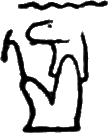 "ram-headed deity with the Zâm-sceptre."
"ram-headed deity with the Zâm-sceptre."
Det. of the god Khnum. 128
Det. of the god Khnum. 128
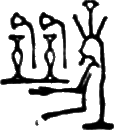 "deity carrying an offering of flowers, surmounted by the papyrus plant."
"deity carrying an offering of flowers, surmounted by the papyrus plant."
Det. of the god Hâp (the Nile). 137
 "female deity standing and holding a papyrus reed, surmounted by a throne."
"female deity standing and holding a papyrus reed, surmounted by a throne."
Det. of the goddess Isis. 126
 "female deity with the symbol of life, surmounted by a throne."
"female deity with the symbol of life, surmounted by a throne."
Det. of the goddess Isis. 126
 "female deity with a papyrus reed, surmounted by a pair of horns and a throne."
"female deity with a papyrus reed, surmounted by a pair of horns and a throne."
Det. of the goddess Isis. 126
 "female deity surmounted by the symbol of truth."
"female deity surmounted by the symbol of truth."
Pron. maâ. 144
Det. of the goddess Mâ.
 "female deity with the symbol of life, surmounted by the symbol of truth."
"female deity with the symbol of life, surmounted by the symbol of truth."
Pron. maâ. 37 62 62 64 64 65 65 65 66 66 67 67 68 68 68 69 69 70 70 87 96 122 130 130 144 147 Hieroglyph written from right to left. 71 71
Det. of the goddess Mâ.
 "lion-headed female deity with the snake-encircled disk of the sun."
"lion-headed female deity with the snake-encircled disk of the sun."
Det. of the goddess Sekhet or Bast. 92 146
IV. Parts of the Human Body.
Det. of face, front.
Pron. ȧr. 53 54 55 56 58 58 65 67 67 70 92 105 138 142 142 mer, *îri, *î, *men.
Pron. ȧn, nâ, ân.
 "left eye with eye-brows and a hoe(?) below."
"left eye with eye-brows and a hoe(?) below."
Pron. beq, 118 uza.
Det. of eye, sun, moon.
Pron. Letter r. 5 27 31 31 31 38 39 39 39 39 48 49 49 51 51 51 53 55 56 56 60 60 60 60 63 64 64 64 65 65 65 69 69 72 86 86 88 88 90 90 91 91 94 97 97 97 102 102 102 102 102 102 102 102 106 106 {159}107 111 111 111 111 111 112 112 114 114 114 115 116 116 116 117 117 117 117 117 119 119 122 122 122 123 124 128 129 129 131 131 133 136 137 138 139 142 143 144 145 151 152 152
Pron. qa, 122 135 135 135 150 152 ka, *q, *k.
Det. of negation, defense, secrecy.
Det. of rowing.
Pron. Letter â, 56 57 70 91 92 95 99 116 116 121 122 124 130 132 137 138 144 149 152 152 ded. 60 60 70 70
Pron. nekht, 48 48 50 53 55 56 58 59 60 60 62 63 64 65 66 67 68 68 68 70 136 *n.
Det. of any violent action. 31 64 66 70
Pron. Letter d. 27 31 31 31 39 62 70 87 91 94 102 102 102 102 106 111 111 112 115 116 118 122 124 127 131 136 150
Pron. îu, *i or u 86
Det. of progressive motion. 48 64 144
Pron. uâr, 92 102 ped, red, men.
Det. of foot, motion, measure.
Pron. Letter q. 39 39 39 39 60 61 61 70 86 86 94 94 97 102 102 102 106 106 111 111 112 112 112 114 115 116 118 119 124 144 Roman additions for symmetry (?) 122 122 (reading from right to left).
Pron. Letter b. 21 21 24 27 27 58 58 69 86 87 87 88 88 88 97 103 106 114 115 116 118 118 119 119 121 124 136 146
Pron. f, ȧuf.
Det. of flesh, part of the body. 56 56 56
V. Figures of Animals.
Pron. qa, 48 48 48 50 53 55 56 58 59 62 63 65 66 67 68 68 70 ka, *q, *k.
Det. of bull, quadruped. 100
Det. of ram, the god Khnum. 104
Pron. deḥuti, 150 ân, sa, *â, *zed, *ze.
Det. of monkey, the god Thoth.
Det. of monkey, the god Thoth.
Pron. Letter l or r, both being interchangeable, 39 94 94 102 102 106 106 112 112 116 117 117 117 117 124 136 {160}142 144 âr, ȧr, shenâ.
Pron. seshta.
Det. of the god Anubis. 99
Pron. un. 24 27 62 86 100 101 148
Pron. âb. 119
Det. of the god Set, wickedness, tempest.
VI. Parts of Animals.
Pron. shef. 65
Pron. ȧp, 99 *up.
Pron. âb, in the dual âbui. 48 48
Det. of horn, opposition, attack.
Det. of eating, speaking.
 "hind part and tail of an animal."
"hind part and tail of an animal."
Pron. peḥ. 60
Det. of position behind, power, succession.
Pron. khepesh, 60 âm, *â.
Pron. ââ, 142 ȧâ.
VII. Figures of Birds.
Pron. Letter a. 27 39 61 87 89 92 94 94 94 97 100 102 102 102 102 106 106 106 107 107 107 111 112 112 116 117 121 122 122 124 136 136 138 138 139 144 145 147
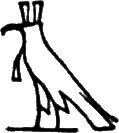 "eagle with a bunch of feathers on the breast."
"eagle with a bunch of feathers on the breast."
Pron. ḥer, 30 30 122 136 144 bȧk (name of the bird), 30 *nuter, *p.
Det. of hawk, the god Horus. 31 125
Pron. same as preceding.
Det. of the god Horus. 125
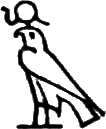 "hawk surmounted by the snake-encircled disk of the sun."
"hawk surmounted by the snake-encircled disk of the sun."
Pron. Ḥor-Râ or Râ-Ḥor. 30 30 49 49 55 55 58 60 144
Det. of the gods Râ or Horus. 125
 "hawk with the double crown of Egypt."
"hawk with the double crown of Egypt."
Pron. ḥer. 30 31 56 56 58 59 60 62 63 65 66 67 68 68 70
Det. of the god Horus. 125
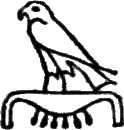 "hawk standing on the symbol of gold (nub)."
"hawk standing on the symbol of gold (nub)."
Det. of the god Horus. 125
Pron. ḥer-nub.
Det. of the god Horus. 125
Det. of the god Horus. 125
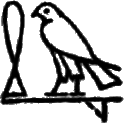 "hawk on a scaffold preceded by the sign ḥen."
"hawk on a scaffold preceded by the sign ḥen."
Det. of the god Horus. 125
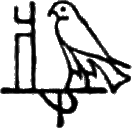 "hawk on a scaffold preceded by the sign thes."
"hawk on a scaffold preceded by the sign thes."
Det. of the god Horus. 125
 "hawk with the royal whip on a scaffold with the symbols of Upper and Lower Egypt beneath."
"hawk with the royal whip on a scaffold with the symbols of Upper and Lower Egypt beneath."
Det. of the god Horus. 125
Pron. mut, 56 66 70 97 117 153 mert, ner, m, *qed.
Pron. Letter m. 27 27 31 31 48 48 50 53 55 56 56 56 56 58 58 58 59 59 60 70 87 95 97 106 107 116 118 124 132 141
 "owl with an arm written across it."
"owl with an arm written across it."
Pron. mer, 143 m.
Pron. deḥuti. 36 49 49 56 58 60 61 150 150 151 151
Det. of the god Thoth.
Pron. deḥuti. 49
Det. of the god Thoth.
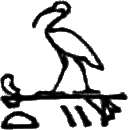 "ibis on a scaffold with the letters t and i beneath."
"ibis on a scaffold with the letters t and i beneath."
Pron. deḥuti. 150
Pron. zef. 69
Pron. sa, 31 36 37 38 48 48 50 53 55 56 58 59 61 62 62 64 64 65 65 66 66 67 67 68 68 69 69 70 70 72 89 92 94 95 96 96 96 97 99 106 106 107 107 111 122 136 136 138 140 141 142 143 144 144 145 147 147 150 150 151 151 152 men, ḥep, *s, *r, 117 117 (hieroglyph reading from right to left) *u.
Det. of bird, flying.
Pron. pa, 84 *p.
Det. of bird, flying.
Pron. Letter u. 24 27 27 27 48 60 60 64 65 68 89 99 106 115 115 116 117 124 128 128 128 133 147 148 150
 "chicken with an arm across it."
"chicken with an arm across it."
VIII. Parts of Birds.
Pron. meḥ.
Det. of wing, rising, flying. 31
Pron. maâ, 99 130 shu, qeb, *m, *sh.
Pron. sa, 39 63 66 68 70 102 117 122 *s.
Det. of egg, progeny, goddess, queen. 39 39 102 112 112 112 112 121 126 130 136 146 146 152
IX. Figures of Reptiles.
Pron. sebek, 103 seq, ad, *n.
Det. of crocodile, insolence, plundering, hiding.
Pron. sebek, ȧnp.
Det. of the god Sebek. 146
Pron. ârâ, 152 neb, *k, *r.
Det. of goddess, queen. 136 146
Pron. ârâ or meḥent. 56 66 70 117
Det. of snake, reptile.
Pron. Letter z. 39 47 48 50 52 54 57 58 60 61 69 92 102 106 116 124 142 149
Pron. Letter f. 27 27 31 31 48 49 51 53 55 55 56 56 56 57 58 58 58 58 58 59 60 60 60 60 62 64 65 65 65 66 67 67 67 69 69 69 70 70 70 97 97 99 112 112 113 116 124 127 128 139
X. Figures of Fishes.
XI. Figures of Insects.
Pron. âf, men, sekhet, kheb, kat or qet. Its pronunciation
when combined with the reed (suten) is unknown. We choose to transcribe  by
suten-kaut, which means the king of Upper and Lower Egypt. {163}36 37 38 52 53 54
56 58 59 60 62 63 65
66 67 68 68 70 72 84
94 95 96 96 96 97 99
106 106 107 107 111 122 127 128 132 135 136 138 140 141 142 144 144 147 150 150 151 151 152 152
by
suten-kaut, which means the king of Upper and Lower Egypt. {163}36 37 38 52 53 54
56 58 59 60 62 63 65
66 67 68 68 70 72 84
94 95 96 96 96 97 99
106 106 107 107 111 122 127 128 132 135 136 138 140 141 142 144 144 147 150 150 151 151 152 152
Pron. kheper, 36 38 47 48 49 49 50 50 52 53 54 55 56 58 58 59 60 60 61 63 64 72 82 96 96 97 100 128 128 128 138 140 150 150 151 151 151 152 khep, *ta 117 117 in dual *taui, 39 39 112 112 *t.
Det. of scorpion, wickedness.
XII. Figures of Trees and Plants.
Pron. ȧm, *m.
Det. of tree, shrub, plant. 118
Pron. renp, 64 68 rep, ter, *qed.
Det. of year, season, germination, renewal.
Pron. renp, 48 ter.
Pron. renp, rep, ter, merȧ. 90 115
Det. of year, season, renewal.
Pron. sput, 48 sbud.
Pron. nekheb, 87 119 136 n, 65 65 142 142 *n.
Pron. su, 37 60 62 63 64 64 64 65 65 66 66 67 67 68 68 69 69 69 70 70 71 71 126 144 146 suten 56 56 66 70 and in connection with a bee, 36 37 38 52 53 54 56 58 59 60 62 63 65 66 67 68 68 70 72 84 94 95 96 96 96 97 99 106 106 107 107 111 122 127 128 132 135 136 138 140 141 142 144 144 147 150 150 151 151 152 152 *s.
 "papyrus with the letter â drawn through it."
"papyrus with the letter â drawn through it."
Pron. qemâ. 152
Pron. res. 84
Pron. Letter ȧ. 27 28 38 49 51 59 62 62 63 65 66 69 72 87 88 89 90 94 95 95 96 96 96 97 97 97 97 97 98 98 98 99 101 102 102 106 111 111 115 116 122 124 128 132 132 136 137 138 144 149
Pron. Letter î. 39 56 57 58 60 62 65 86 89 90 91 91 97 102 106 106 106 111 116 116 117 117 120 121 122 122 122 122 124 129 131 140 142 147 147
Pron. îu or ȧî. 132
 "basin of water full of lotus."
"basin of water full of lotus."
Pron. Letter sh. 107 113 116 124 126
Det. of plant, flower.
Pron. meḥ, 90 152 152 ȧteḥ, kheb.
Det. of reed, water-plant. 139
Pron. ûz. 152
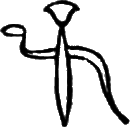 "lotus blossom with snake (z)."
"lotus blossom with snake (z)."
Pron. ûz. 131
Pron. unknown. 152 In the combination  the
pronunciation is *taui.
the
pronunciation is *taui.
Pron. kha, 113 *kh.
Pron. ut. 148
Pron. ḥez, 132 *ḥet.
Pron. ut. 60
Pron. mes. 31 36 37 49 49 49 49 56 56 58 59 60 61 62 62 63 64 64 64 65 65 66 66 67 67 67 68 68 69 69 69 69 70 70 71 71 106 115 144 144 150 150 151 151
Pron. nezem, 136 nem.
Det. of sweetness, pleasure.
XIII. Figures of Heaven, Earth, and Water.
 "heaven with the horizon on two sides."
"heaven with the horizon on two sides."
Pron. pet, 56 56 56 58 59 60 62 63 65 66 67 68 68 70 ḥer, khî, *p, *men.
Det. of heaven, covering, height, superiority.
Pron. râ, 27 27 31 36 36 37 37 37 38 38 38 46 47 48 48 48 49 50 50 50 52 53 53 54 55 55 56 56 57 58 58 59 59 60 60 61 62 62 62 62 62 62 62 64 64 64 64 64 64 64 64 65 65 65 65 65 65 66 66 66 66 66 66 66 66 67 67 67 67 67 67 67 68 68 68 68 68 68 68 69 69 69 69 69 69 69 69 70 70 70 70 70 70 70 71 71 71 71 72 72 72 82 87 94 95 95 96 96 96 96 96 96 97 97 97 97 98 99 99 106 106 106 107 107 111 122 122 127 135 136 136 138 138 138 140 140 141 141 142 143 143 144 144 144 144 144 144 147 147 150 150 150 150 150 151 151 151 151 152 152 *r.
Det. of sun, sun-god, light, time. 27 27 56 62 89 97 101
 "disk of the sun with the cobra around it."
"disk of the sun with the cobra around it."
Pron. khu, ȧm, *per, 142 *kh.
Det. of splendor, radiance. 62
 "disk of the sun with two cobras around it."
"disk of the sun with two cobras around it."
Pron. ḥud. 87
Pron. khâ, 39 48 50 53 55 56 59 64 102 117 117 117 122 122 122 127 136 150 150 151 151 *kh, *sh.
Pron. ȧb, *ȧ. 116
Det. of the moon in all its phases.
Pron. seb, dûa, 65 97 khabes, *s, *z.
Det. of star, constellation, god.
 "land with clods of earth beneath."
"land with clods of earth beneath."
Pron. ta, 39 47 48 49 49 50 52 54 57 58 60 60 61 65 90 102 106 117 142 142 in the dual taui, 39 39 47 47 48 48 50 50 51 51 52 52 53 53 54 54 55 55 62 62 62 62 64 64 65 65 65 65 66 66 67 67 67 67 68 68 69 69 70 70 98 98 102 102 136 136 152 152 *t. 102 102 102
 "land with a line and a piece of rock beneath."
"land with a line and a piece of rock beneath."
Pron. ta, 70 *t.
 same as preceding with three clods of earth added.
same as preceding with three clods of earth added.
Pron. ta, 84 88 88 90 90 115 116 116 117 *t.
 "earth with valleys and mountains."
"earth with valleys and mountains."
Pron. either men 60 66 70 or set (doubtful).
Det. of country, land, place, people. 28 86 89 90 97 97 97 97 100 103 119 119 127 128 133 137 145
 "earth with a stick to which prisoners were tied."
"earth with a stick to which prisoners were tied."
Det. of foreign country or nation. 132 137 138 144
Pron. du, 88 88 88 *men, *â, *ḥ.
Det. of mountain, mountainous region. 151
Pron. khu, 55 55 62 89 generally in the dual khuti. 30 122
Pron. ḥesp, 137 sep, *n.
Det. of province, field, vineyard.
Pron. ḥu, *ḥ.
Det. of land, earth. 84 90 117
Pron. Letter m. 30 62 64 65 67 70 89 103 116 117 119 122 124 142
Pron. ȧner, ȧn, *men.
Det. of earth, metal, sand, frankincense, flour. 58 58 58
Pron. mer, 37 38 39 62 63 64 64 65 65 66 66 67 67 68 68 69 69 70 70 72 94 102 106 136 138 142 144 144 ȧa, *m.
Det. of water, fluid, lake, river, ocean, irrigation, inundation. 131 137
 "basin of water with the symbol of water in it."
"basin of water with the symbol of water in it."
Pron. mer, 90 ȧa, *m.
Det. of water, fluid, lake, river, ocean, irrigation, inundation. 91 131 137
Pron. Letter sh. 60 65 90 116 116 124 127 137
Pron. khu, generally in the dual  khuti. 30 49 49 55
55 58 60 144 144
khuti. 30 49 49 55
55 58 60 144 144
Pron. ḥim, 112 bȧ, peḥ.
 "undulating surface of water."
"undulating surface of water."
Pron. Letter n, 21 21 21 24 27 27 27 28 31 37 38 38 38 48 48 48 48 53 56 56 56 56 56 56 56 57 58 58 58 58 58 58 58 59 60 60 62 62 62 62 64 64 64 64 64 65 65 66 66 66 67 67 67 68 68 68 69 69 69 70 70 71 71 72 72 72 86 86 87 87 87 88 88 88 88 89 89 89 89 90 92 94 94 94 95 95 95 96 96 96 96 97 97 97 97 97 97 97 98 98 99 99 100 101 101 103 115 116 116 116 116 119 119 120 120 120 122 122 122 122 124 128 129 132 132 132 133 133 136 136 136 136 137 138 138 138 138 138 139 142 142 144 144 145 147 148 149 149 150 150 152 *mu.
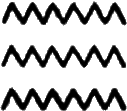 same as preceding, repeated three times.
same as preceding, repeated three times.
Pron. mu, 144 *m.
Det. of water, fluid, ablution, purification. 53 55 87 90 119 133 137 137
XIV. Figures of Buildings.
 "plan of a village with streets on a hill."
"plan of a village with streets on a hill."
Pron. nen, nu. 87
Det. of city, town, island, country. 24 24 31 36 51 51 52 53 56 58 61 66 69 69 70 84 86 86 86 86 86 86 87 87 87 87 87 87 88 88 88 88 88 88 89 89 89 90 90 90 90 90 91 91 92 92 92 92 92 92 97 101 102 103 105 105 114 114 115 115 116 116 116 117 117 117 118 118 118 118 118 118 118 119 119 120 120 120 120 123 128 129 132 132 133 136 139 144 145 147 148 149 149 149 149 149 150 151 152 152 152 152 152 152
Pron. per, 21 53 59 64 67 69 89 92 92 92 105 105 139 140 140 140 pu, 129 *p.
Det. of place. 51 53 55 55 62 89 92 102 115 123
Pron. Letter h. 48 60 65 116 124 133 144
Pron. mer. 118
Pron. ḥa or ḥa·t, 21 51 53 92 102 103 115 123 *ḥ, *kh.
 same as preceding with the sign â and the feminine ending t in it.
same as preceding with the sign â and the feminine ending t in it.
Pron. ḥa·t-â. 56
Det. of the goddess Hathor.
Pron. ȧnb. 132
Det. of wall, fortification.
Pron. neh, qen.
Det. of corner, protection. 119
 "tomb with four feathers, the symbols of truth."
"tomb with four feathers, the symbols of truth."
Pron. mer. 118
Pron. ȧbmer.
Det. of pyramid, tomb. 90 132 143
Pron. benben.
Det. of heap, pyramidion. 58
Det. of obelisk, monument. 5 21 21
Det. of stelé, monument. 148
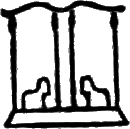 "room of a temple with images."
"room of a temple with images."
Pron. sed, 58 ȧfd.
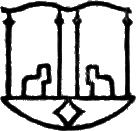 "room of temple with images on top of the sign ḥeb."
"room of temple with images on top of the sign ḥeb."
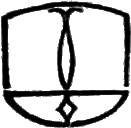 "room of a temple with a lotus blossom on top of the sign ḥeb."
"room of a temple with a lotus blossom on top of the sign ḥeb."
Pron. Letter s, 31 39 39 48 49 56 56 56 58 60 60 61 62 62 69 69 87 89 92 94 94 94 94 94 94 97 102 102 103 106 106 111 111 111 114 115 116 117 120 121 122 122 122 124 142 144 144 145 147 150 151 152 ses.
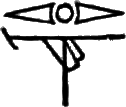 "temple ornament on a scaffold."
"temple ornament on a scaffold."
Det. of an Egyptian festival. 89
Pron. ȧn, 36 51 51 52 53 56 58 69 87 88 91 96 116 120 120 123 143 144 ȧ.
XV. Figures of Ships and their Parts.
Pron. shep, 64 khep.
Det. of boat, sacred barge of deities. 131 146
Pron. âḥâ, 58 *ḥ, âb.
XVI. Figures of House Furniture.
Pron. ȧs or us, 39 92 102 105 126 138 142 s, men, tem.
Pron. Letter s. 24 31 36 37 49 49 56 56 58 59 59 60 62 62 63 64 64 64 65 65 66 66 67 67 67 68 68 69 69 69 69 69 70 70 71 71 86 94 94 (reading from right to left) 101 106 106 106 114 114 114 115 116 117 122 122 124 136 137 141 142 144 146 146 148 151 152
 "top of a table with offerings."
"top of a table with offerings."
Pron. kher, 97 *kh.
Det. of coffin, cemetery, embalming.
Pron. qed, 127 sat.
Pron. maâ, 142 *m.
XVII. Figures of Temple Furniture.
 "flag in front of the temple."
"flag in front of the temple."
Pron. nuter, 31 31 31 47 49 50 51 52 53 54 57 57 62 62 62 65 65 67 67 67 71 71 96 96 97 98 142 reading from right to left. 71 71 142
Pron. ded, 53 57 92 137 psed, *d.
Pron. ȧb. 88
 "altar with the symbol of truth on top of it."
"altar with the symbol of truth on top of it."
Pron. men, ȧmen, 97 set.
XVIII. Figures of Crowns and Insignia.
 "royal head-dress with the cobra."
"royal head-dress with the cobra."
Pron. suten.
Det. of the royal hood. 46 117
Pron. kheperesh. 117
Pron. ḥez, 31 60 114 136 *nefer, *n.
Det. of crown. 64
 same as preceding with the sign for "country" below it.
same as preceding with the sign for "country" below it.
Pron. ḥez. 152
Pron. Letter n. 63 64 70 116 116 121 124 desher, 31 114 136 net.
 same as preceding with the sign for "country" below it.
same as preceding with the sign for "country" below it.
Pron. desher. 152
 "the white and red crowns of Egypt combined into one."
"the white and red crowns of Egypt combined into one."
Pron. sekhet, sekhent. 31 114 114
Pron. Letter u. 27 27 39 102 102 102 102 102 102 102 102 106 111 111 116 117 117 117 121 122 122 122 124 136 136 139 146 151
Pron. usekh. 61
 "two royal whips in a receptacle."
"two royal whips in a receptacle."
Pron. ânkh. 29 29 39 46 46 47 48 49 50 51 51 52 53 53 54 55 55 57 61 63 63 65 67 69 70 71 71 99 101 102 106 137 140 142 142
Pron. sekhem. 142
Pron. sekhem. 146
Pron. ḥeq. 39 49 51 51 52 60 60 60 96 96 96 106 112 112 144
Pron. us, 46 46 53 57 58 153 sem.
 same as preceding with the feather, the symbol of truth.
same as preceding with the feather, the symbol of truth.
Pron. us. 48 48 49 50 53 55 56 59 87 96 96 149
 "sceptre with the head of a jackal."
"sceptre with the head of a jackal."
Pron. us, user, 37 62 62 64 64 64 65 65 66 66 67 67 68 68 68 69 69 70 70 71 71 98 144 144 152 153 *ḥâ.
Around the fixed titles of the kings. 56 58 59 60 62 63 65 66 67 68 68 70 102
XIX. Figures of Implements of War.
 "post to which prisoners were tied."
"post to which prisoners were tied."
Pron. âm, zâ, ȧm, qem, neḥ, qa, ga, gem, *â.
Det. of foreigner, country, action. 56 89 120 126 150
Pron. tep. 58
Pron. âa or â, 49 51 53 53 57 64 68 96 99 140 140 149 150 150 *â.
XX. Figures of Tools and Utensils.
Pron. Letter *m, 106 khen.
Pron. sotep, 37 38 62 62 64 64 65 65 66 66 67 67 68 68 69 69 70 70 72 94 98 136 136 138 142 144 reading from right to left 71 71 ânp.
Pron. tum. 27 27 51 51 51 53 56 57 90 102 133 151
Pron. mer. 5 31 57 58 58 60 60 62 62 65 67 68 71 71 90 90 91 98 115 130 131 133 136 147 *ma, *m.
Pron. Letter th. 87 106 115 116 120 124 132
Pron. Letter z (really pronounced like our j). 113 116 124
Pron. [ȧb], 143 sekhmer.
Pron. nub.
Det. of gold, gold-metal. 58
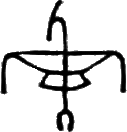 same as preceding with the sign us.
same as preceding with the sign us.
Pron. usem (some pronounce it only sem). 119
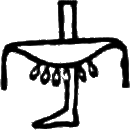 "the sign nub with a leg written through it."
"the sign nub with a leg written through it."
XXI. Figures of Cordage.
Pron. set, 97 ȧs, as.
 "cord with a cloth attached to it."
"cord with a cloth attached to it."
Pron. âu. 151
Pron. qeb, 88 114 qes, ser, shes, *q, *g, *s.
Pron. ârq, sekhî.
Det. of writing, reading, book, tying, closing. 116
Pron. net, 136 *n.
Pron. âd. 131
Pron. Letter û. 38 39 72 112 112 116 124 138 142
Pron. rud. 98
Pron. Letter ḥ. 27 39 56 56 56 60 62 65 69 90 97 97 100 102 113 115 116 119 124 129 137 142 142 142 142 142 147 150
Pron. sek. 146
 "twisted cord with a large loop on top."
"twisted cord with a large loop on top."
Pron. Letter th. 65 89 97 103 106 116 120 124 133 137 139 141 142 145 150
Pron. thet, 31 *t.
Pron. ut, 137 zet, ḥeseb, *â.
Det. of counting, covering, embalming, sickness, opposition. 119
XXII. Figures of Vessels.
Det. of oil, wax, incense.
Pron. khnum, 87 104 122 128 nem.
Pron. Letter n, 27 36 51 51 52 53 56 58 58 58 58 69 86 87 87 91 106 114 116 117 117 119 120 122 122 123 124 128 136 136 145 nu, nen, men, khen.
Pron. ȧn, 99 nen, *n.
Det. of heart, centre, valor. 60 122
Pron. ma or mȧ. 56 57 62 64 65 66 66 68 69 69 70 150
Pron. âu, âb, ḥen, usekh, *â, *u. 136
Det. of size, victuals, offering. 60
 "censer with a flame and grains of incense."
"censer with a flame and grains of incense."
Pron. *ba, *b. 111
Pron. Letter g. 31 31 94 102 102 102 106 116 117 124 136
Pron. neb, 31 39 39 39 47 48 49 49 49 50 51 51 51 51 51 52 53 53 53 54 54 55 55 56 57 58 60 61 62 64 64 65 65 66 67 68 69 69 69 70 70 70 92 96 98 102 102 112 112 117 117 121 121 122 122 136 136 in connection with the cobra and the vulture, 56 56 66 66 70 70 117 117 153 *n.
Pron. Letter k. 31 38 48 66 70 72 89 94 102 106 107 107 111 113 114 114 116 117 119 122 122 124 132 137 138 138 141 142 146 146
Pron. Letter p. 39 39 48 49 51 62 64 65 65 86 88 90 94 97 99 99 100 100 102 104 112 112 114 115 116 124 137 139 140 141 142 142 142 142 142 142 147
XXIII. Figures of Temple Offerings.
Pron. ta.
Det. of bread, nourishment, quantity. 69
Pron. pau·t. 57
Pron. sep. 58
Pron. Letter kh. 21 54 56 56 59 60 60 63 64 65 66 70 97 114 116 117 122 124 128 128 146 146
 "loaf of bread shaped like a pyramid."
"loaf of bread shaped like a pyramid."
Pron. du, 31 47 48 48 49 49 50 51 51 52 53 53 53 54 55 55 55 57 61 63 65 67 69 70 *d, 94 *th.
XXIV. Figures of Instruments for Writing, etc.
 "brush, inkstand, and pallet."
"brush, inkstand, and pallet."
Pron. ân, nâ, sekhî. 116
 "papyrus roll with a string tied around it."
"papyrus roll with a string tied around it."
Pron. âsh.
Det. of book, writing, plan, drawing, any abstract idea. 48 60 61 62 65 65 67 70
Pron. sekhem. 99
Pron. nefer. 47 49 50 52 53 54 56 58 60 61 71 71 71 71 90 96 97 98 132 141 150 151
Pron. men. 28 36 38 47 48 48 49 50 50 52 53 54 55 56 58 58 59 59 60 66 72 82 87 87 87 90 95 95 96 96 96 97 97 98 98 98 120 122 132 132 132 133 135 138 140 144 147 149 151 151
XXV. Figures of Lines, etc.
Pron. ȧ (as first person singular masculine or feminine personal pronoun).
Sign of the singular. 27 27 31 48 48 59 60 60 62 63 64 64 64 65 65 66 66 66 67 67 67 68 68 69 69 69 70 70 70 70 84 87 88 89 89 92 92 92 97 97 97 105 105 107 114 119 129 129 136 137 139 143 149 149 149 151
Sign of the dual.
Pron. u and sign of the plural. 39 49 57 58 60 60 60 61 64 64 64 65 65 66 68 68 70 88 96 97 102 150 151 151 151
Pron. u and sign of the plural. 31 48 60 60 69 97 137
Pron. u and sign of the plural. 69 96 121 122
Pron. u and sign of the plural. 106
Pron. u and sign of the plural. 56
Pron. Letter i. 87 88 89 102 106 115 116 119 120 120 121 122 124 136 139 150 150 150
 "two lines crossing each other."
"two lines crossing each other."
Pron. ûr, su, u, sesh.
Det. of crossing, mixing, increasing. 99
Pron. Letter t. 21 21 24 24 27 27 31 31 31 39 39 39 39 39 39 47 48 48 49 50 51 51 51 51 51 52 53 53 53 54 54 55 55 56 56 56 56 56 56 56 57 57 57 58 58 58 60 60 60 60 60 60 60 60 61 61 62 62 62 64 64 64 65 65 65 65 66 66 66 67 68 68 69 70 70 70 70 84 86 86 86 86 87 87 87 87 87 87 87 87 88 88 88 88 88 89 89 89 89 90 90 90 90 90 90 91 91 92 92 92 92 92 92 92 94 94 94 95 95 97 98 99 99 100 100 101 101 102 102 102 102 102 102 102 102 102 102 102 104 105 105 106 106 106 111 112 112 112 112 112 112 114 114 114 115 115 115 115 116 116 116 116 117 117 117 117 117 117 117 117 118 118 118 118 118 118 118 119 119 119 119 120 120 120 121 122 122 122 122 122 122 122 123 124 126 128 129 130 131 132 132 133 133 136 136 136 136 137 139 139 142 142 142 142 142 142 142 144 144 145 146 146 146 147 147 148 149 149 149 149 149 149 150 150 150 151 151 152 152
 pronounced ti (or possibly tet). 28 56 89 90 97
97 97 103 119 146 In the combination
pronounced ti (or possibly tet). 28 56 89 90 97
97 97 103 119 146 In the combination  suten-kaut (pronunciation doubtful!). 36 37 38 52 53 54
56 58 59 60 62 63 65
66 67 68 68 70 72 84
94 95 96 96 96 97 99
106 106 107 107 111 122 127 128 132 135 136 138 140 141 142 144 144 147 150 150 151 151 152 152
suten-kaut (pronunciation doubtful!). 36 37 38 52 53 54
56 58 59 60 62 63 65
66 67 68 68 70 72 84
94 95 96 96 96 97 99
106 106 107 107 111 122 127 128 132 135 136 138 140 141 142 144 144 147 150 150 151 151 152 152
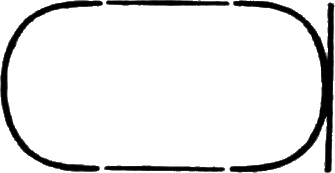 "cartouche or royal seal containing the name of a king or a queen."
"cartouche or royal seal containing the name of a king or a queen."
Around royal names. 36 36 37 37 38 38 39 39 39 47 48 49 49 49 49 49 50 50 52 53 54 55 56 56 58 58 59 60 60 61 62 62 62 63 64 64 64 64 65 65 65 65 66 66 66 66 67 67 67 67 68 68 68 68 69 69 69 69 70 70 70 70 71 71 71 71 72 72 82 87 94 94 95 95 96 96 96 96 96 96 97 97 98 98 99 99 102 102 106 106 106 106 107 107 107 107 111 111 112 112 117 117 121 122 122 122 122 127 128 132 132 135 136 136 136 136 138 138 140 140 141 141 142 142 144 144 144 144 147 147 150 150 150 150 151 151 151 151 152 152
Pron. ren. 107
Det. of name, circle, inkstand.
 "right angle with two quarter circles."
"right angle with two quarter circles."
Pron. ȧp. 88
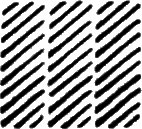 Sign of a lacuna or a gap in the text. 58 59 66 67 68
Sign of a lacuna or a gap in the text. 58 59 66 67 68
OF THE EGYPTIAN WORDS OCCURRING ON THE NEW YORK OBELISK.
The words in this Glossary are arranged according to the Hieroglyphic alphabet as follows:
As there was no fixed orthography among the ancient Egyptians the same word is frequently
spelled in many different ways. This will be noticed in the following pages.—The plural of
nouns or adjectives was formed by adding three lines ( ) to the word or by repeating the
Hieroglyphic sign of the word three times.—The dual was formed by adding two lines (
) to the word or by repeating the
Hieroglyphic sign of the word three times.—The dual was formed by adding two lines ( )
or by repeating the sign twice.—The dot before the t (·t) denotes that the t is the
feminine ending, which was pronounced by the ancient Egyptians only slightly or, probably, not at
all.
)
or by repeating the sign twice.—The dot before the t (·t) denotes that the t is the
feminine ending, which was pronounced by the ancient Egyptians only slightly or, probably, not at
all.
Abbreviations: E stands for East Face of the Obelisk; W for the West Face; N for the North Face; S for the South Face. Pyr. stands for Pyramidion. EAST, WEST, NORTH, SOUTH denote the vertical columns of the Obelisk on that particular side of its face. CENT. denotes the central column. The small numerals refer to the pages of the book.
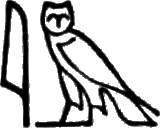 ȧm. Prep. "in." Adv. "there, where." W CENT. 59
ȧm. Prep. "in." Adv. "there, where." W CENT. 59
 Ȧmen-mer-Râ-meses-su. Second cartouche or the family name of Ramses II., "beloved
of Amen, the Sun, begetting himself". E NORTH 62 63 SOUTH 64 64 S EAST
65 65 WEST
66 66 W SOUTH 68 68 NORTH 67 67 N
WEST 70 70
EAST 69 69
Ȧmen-mer-Râ-meses-su. Second cartouche or the family name of Ramses II., "beloved
of Amen, the Sun, begetting himself". E NORTH 62 63 SOUTH 64 64 S EAST
65 65 WEST
66 66 W SOUTH 68 68 NORTH 67 67 N
WEST 70 70
EAST 69 69
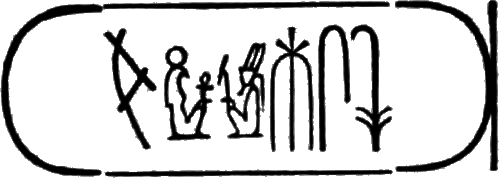 Ȧmen-mer-Râ-meses-su. Same as preceding. Base of E
71 71 S 71 71 W 71 71 N 71 71
Ȧmen-mer-Râ-meses-su. Same as preceding. Base of E
71 71 S 71 71 W 71 71 N 71 71
 Ȧmen-mer-Ûsarken. Second cartouche or the family name of Osarkon
I., "beloved of Amen, Osarkon". SMALL SIDE INSCRIPTIONS
E 72 72 S 72 72 W 72 72 N 72 72
Ȧmen-mer-Ûsarken. Second cartouche or the family name of Osarkon
I., "beloved of Amen, Osarkon". SMALL SIDE INSCRIPTIONS
E 72 72 S 72 72 W 72 72 N 72 72
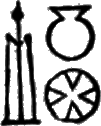 Ȧn. "Heliopolis." E CENT. 56 S CENT. 58 N EAST 69 Pyr. WEST 52 53 SOUTH 51
Ȧn. "Heliopolis." E CENT. 56 S CENT. 58 N EAST 69 Pyr. WEST 52 53 SOUTH 51
 ȧr. Verb: "to make, form, fashion; making, maker". E CENT. 56 W NORTH 67 67 S
CENT. 58 58
N WEST 70 Pyr. WEST 53 NORTH
54 55
ȧr. Verb: "to make, form, fashion; making, maker". E CENT. 56 W NORTH 67 67 S
CENT. 58 58
N WEST 70 Pyr. WEST 53 NORTH
54 55
 ȧrîtu. Noun, feminine, plural: "works". S EAST 65
ȧrîtu. Noun, feminine, plural: "works". S EAST 65
 ȧrp. Noun: "wine". Pyr. EAST 49 SOUTH 51
ȧrp. Noun: "wine". Pyr. EAST 49 SOUTH 51
 ȧten. Noun: one of the names of "the sun". E NORTH 62
ȧten. Noun: one of the names of "the sun". E NORTH 62
 âa or â. Adjective: "great, large". E CENT. 57 SOUTH 64 W SOUTH 68 Pyr. EAST 49 SOUTH
51 WEST 53 In combination with ḥa·t. E CENT. 56
âa or â. Adjective: "great, large". E CENT. 57 SOUTH 64 W SOUTH 68 Pyr. EAST 49 SOUTH
51 WEST 53 In combination with ḥa·t. E CENT. 56
 ânkh. Verb, &c.: "to live; living; life". E CENT. 57 NORTH 63 S EAST 65 W NORTH 67 N CENT. 61 EAST
69 WEST 70 Pyr. EAST 47 49 SOUTH 50 51 WEST 52 53 53 NORTH 54 55 55 Base of E 71
71 S 71 71 W 71 71
N 71 71
ânkh. Verb, &c.: "to live; living; life". E CENT. 57 NORTH 63 S EAST 65 W NORTH 67 N CENT. 61 EAST
69 WEST 70 Pyr. EAST 47 49 SOUTH 50 51 WEST 52 53 53 NORTH 54 55 55 Base of E 71
71 S 71 71 W 71 71
N 71 71
 uâ. Adj. and adv.: "one, sole, alone; only". E SOUTH 64
uâ. Adj. and adv.: "one, sole, alone; only". E SOUTH 64
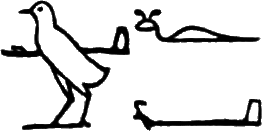 uâf. Verb, &c.: "to smite, ward off, vanquish; conqueror, victor". S
WEST 66
uâf. Verb, &c.: "to smite, ward off, vanquish; conqueror, victor". S
WEST 66
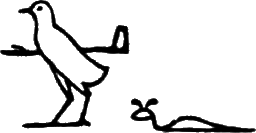 uâf. Same as preceding. N WEST 70
uâf. Same as preceding. N WEST 70
 us. Noun and adj.: "strength, power; strong". E CENT. 57 Pyr. WEST 53
us. Noun and adj.: "strength, power; strong". E CENT. 57 Pyr. WEST 53
 Us. "Thebes." E CENT. 56 W CENT. 59 Pyr. EAST 48 SOUTH 50
WEST 53 NORTH 55
Us. "Thebes." E CENT. 56 W CENT. 59 Pyr. EAST 48 SOUTH 50
WEST 53 NORTH 55
 usem. Noun: "gold-metal; electrum", S CENT.
58
usem. Noun: "gold-metal; electrum", S CENT.
58
 user. Adj.: "great, powerful, long". E SOUTH
64 W SOUTH 68
user. Adj.: "great, powerful, long". E SOUTH
64 W SOUTH 68
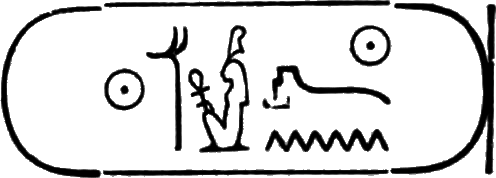 User-Mâ-Râ-sotep-en-Râ. The first cartouche or the royal name of Ramses II., "strong in
truth, the sun, chosen of the sun". E NORTH 62 62 SOUTH 64 64 S EAST
65 65 WEST
66 66 W NORTH 67 67 SOUTH 68 68 N
EAST 69 69
WEST 70 70
Base of (all reading from right to left) E 71 71 S 71 71 W 71 71
N 71 71
User-Mâ-Râ-sotep-en-Râ. The first cartouche or the royal name of Ramses II., "strong in
truth, the sun, chosen of the sun". E NORTH 62 62 SOUTH 64 64 S EAST
65 65 WEST
66 66 W NORTH 67 67 SOUTH 68 68 N
EAST 69 69
WEST 70 70
Base of (all reading from right to left) E 71 71 S 71 71 W 71 71
N 71 71
 utu. Verb, &c.: "to command, order; decree". N CENT. 60
utu. Verb, &c.: "to command, order; decree". N CENT. 60
 ûaḥ. Verb: "to place, put, establish". E CENT. 56 56
ûaḥ. Verb: "to place, put, establish". E CENT. 56 56
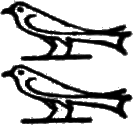 ûrui. Dual of the adjective ûr "large", hence: "the two
large" obelisks, referring to the New York and London Obelisks. S CENT. 58
ûrui. Dual of the adjective ûr "large", hence: "the two
large" obelisks, referring to the New York and London Obelisks. S CENT. 58
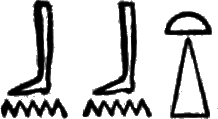 benben·t. Noun: "pyramidion". S CENT. 58
benben·t. Noun: "pyramidion". S CENT. 58
 pau·t. Noun: "circle, assembly, company". E CENT. 57
pau·t. Noun: "circle, assembly, company". E CENT. 57
 per. Noun: "house". W CENT. 59 NORTH 67
per. Noun: "house". W CENT. 59 NORTH 67
 peru. Plural of the preceding word with the determinative of "city": "temples,
sanctuaries". N EAST 69
peru. Plural of the preceding word with the determinative of "city": "temples,
sanctuaries". N EAST 69
 per. Verb: "to go out, proceed, issue". E SOUTH
64
per. Verb: "to go out, proceed, issue". E SOUTH
64
 peḥu. Plural of peḥ "back, behind": hence "farthest,
extreme". N CENT. 60
peḥu. Plural of peḥ "back, behind": hence "farthest,
extreme". N CENT. 60
 pesed. Verb: "to shine, illumine". E NORTH
62
pesed. Verb: "to shine, illumine". E NORTH
62
 pet. Noun and adj.: "heaven; heavenly". E NORTH 62 CENT. 56 56 SOUTH 63 S EAST 65 CENT.
58 WEST 66 W NORTH 67 CENT. 59
SOUTH 68 N EAST 68 CENT.
60 WEST 70
pet. Noun and adj.: "heaven; heavenly". E NORTH 62 CENT. 56 56 SOUTH 63 S EAST 65 CENT.
58 WEST 66 W NORTH 67 CENT. 59
SOUTH 68 N EAST 68 CENT.
60 WEST 70
 Ptaḥ-tathunen. Epithet of the god "Ptah" of Memphis. S EAST 65
Ptaḥ-tathunen. Epithet of the god "Ptah" of Memphis. S EAST 65
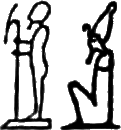 Ptaḥ-tathunen. A variant (different spelling) of the preceding
word. N EAST 69
Ptaḥ-tathunen. A variant (different spelling) of the preceding
word. N EAST 69
 f. Third person sing. masc. pers. and possessive pronoun: "he, him,
his; it, its". E NORTH 62
CENT. 56 56 56 57 SOUTH 64 S EAST 65 CENT. 58 58 58 58 W NORTH 67 67 CENT. 59 N EAST 69 CENT.
60 60 WEST
70 Pyr. EAST 49 SOUTH 51
WEST 53 NORTH 54 55
f. Third person sing. masc. pers. and possessive pronoun: "he, him,
his; it, its". E NORTH 62
CENT. 56 56 56 57 SOUTH 64 S EAST 65 CENT. 58 58 58 58 W NORTH 67 67 CENT. 59 N EAST 69 CENT.
60 60 WEST
70 Pyr. EAST 49 SOUTH 51
WEST 53 NORTH 54 55
 m. Prep.: "in, for; at; as; (made) of; with". E CENT. {179}56 56 56 56 S CENT. 58 58 58 W CENT. 59 N CENT. 60 WEST
70 Pyr. EAST 48 SOUTH 50
WEST 53 NORTH 55
m. Prep.: "in, for; at; as; (made) of; with". E CENT. {179}56 56 56 56 S CENT. 58 58 58 W CENT. 59 N CENT. 60 WEST
70 Pyr. EAST 48 SOUTH 50
WEST 53 NORTH 55
 m. Same as preceding: "in; at; from". E NORTH
62 SOUTH 64 S EAST 65 W NORTH 67
m. Same as preceding: "in; at; from". E NORTH
62 SOUTH 64 S EAST 65 W NORTH 67
 ma or mȧ. Adv.: "like, as". E CENT. 56 57 SOUTH 64 S WEST 60 W SOUTH 68 N EAST 69 WEST
70
ma or mȧ. Adv.: "like, as". E CENT. 56 57 SOUTH 64 S WEST 60 W SOUTH 68 N EAST 69 WEST
70
 mȧ. Same word as the preceding: "like, as". E NORTH 62 S EAST 65 WEST
66 N EAST 69
mȧ. Same word as the preceding: "like, as". E NORTH 62 S EAST 65 WEST
66 N EAST 69
 Mâ. The goddess of truth, "Mā". S EAST
65 N EAST 68
Mâ. The goddess of truth, "Mā". S EAST
65 N EAST 68
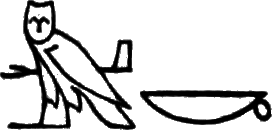 mâk. Verb, &c.: "to protect, ward off; protector". S WEST 66
mâk. Verb, &c.: "to protect, ward off; protector". S WEST 66
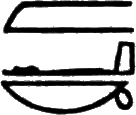 mâk. Same word as the preceding: "to protect; protector". N WEST 70
mâk. Same word as the preceding: "to protect; protector". N WEST 70
 mennu. Noun: "monument; monuments". S CENT.
58
mennu. Noun: "monument; monuments". S CENT.
58
 men·tu or setu. Noun, plural of men·t or set "country", hence:
"countries, foreign nations". N CENT. 60 S WEST 66 N WEST 70
men·tu or setu. Noun, plural of men·t or set "country", hence:
"countries, foreign nations". N CENT. 60 S WEST 66 N WEST 70
 Men-kheper-Râ. The first cartouche or the royal name of Thothmes III., "the stable and
creative sun". E CENT. 56
S CENT. 58 W CENT. 59 N CENT. 60 Pyr. EAST 47 48 SOUTH 50 50 WEST 52 53 NORTH 54 55
Men-kheper-Râ. The first cartouche or the royal name of Thothmes III., "the stable and
creative sun". E CENT. 56
S CENT. 58 W CENT. 59 N CENT. 60 Pyr. EAST 47 48 SOUTH 50 50 WEST 52 53 NORTH 54 55
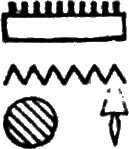 menkh. Verb and adjective: "to be beautiful; beautiful, kind". S WEST 66 Cf. also the causative form of the
same word s·menkh "to embellish". W CENT.
59
menkh. Verb and adjective: "to be beautiful; beautiful, kind". S WEST 66 Cf. also the causative form of the
same word s·menkh "to embellish". W CENT.
59
 mer. Verb, &c.: "to love; loving; beloved; love; lover". E NORTH 62 S EAST 65 CENT.
58 W NORTH 67 N EAST 68 CENT. 60
mer. Verb, &c.: "to love; loving; beloved; love; lover". E NORTH 62 S EAST 65 CENT.
58 W NORTH 67 N EAST 68 CENT. 60
 merî. Adj., derived from the preceding: "beloved". E CENT. 57 S CENT. 58 W CENT. 60
merî. Adj., derived from the preceding: "beloved". E CENT. 57 S CENT. 58 W CENT. 60
 merîti. Lengthened form of the preceding word: "beloved, lovely, beautiful".
E NORTH 62
merîti. Lengthened form of the preceding word: "beloved, lovely, beautiful".
E NORTH 62
 mes or meses. Verb, &c.: "to bring forth, beget; born of; birth; child".
E NORTH 62 CENT. 56 SOUTH 64 W NORTH 67 CENT. 59 N EAST 69
mes or meses. Verb, &c.: "to bring forth, beget; born of; birth; child".
E NORTH 62 CENT. 56 SOUTH 64 W NORTH 67 CENT. 59 N EAST 69
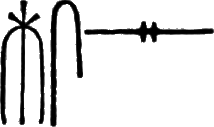 meses. Same word as the preceding: "to bring forth; birth; born of;
child". E CENT. 56
N EAST 69
meses. Same word as the preceding: "to bring forth; birth; born of;
child". E CENT. 56
N EAST 69
 n. Prep.: "by, for". E CENT. 56 SOUTH 64
S CENT. 58 58
58 58 N EAST
69 CENT. 60 Sign of the genitive case: "of, in". E CENT. 56 56 SOUTH 64 64 W
CENT. 59 SOUTH 68 Pyr. WEST 53 Sign of the accusative case.
E CENT. 56
n. Prep.: "by, for". E CENT. 56 SOUTH 64
S CENT. 58 58
58 58 N EAST
69 CENT. 60 Sign of the genitive case: "of, in". E CENT. 56 56 SOUTH 64 64 W
CENT. 59 SOUTH 68 Pyr. WEST 53 Sign of the accusative case.
E CENT. 56
 n. Same as the preceding. Sign of the genitive case: "of". E NORTH 63 SOUTH 64
n. Same as the preceding. Sign of the genitive case: "of". E NORTH 63 SOUTH 64
 neb. Noun: "lord, master". E NORTH 62 SOUTH 64 64 S EAST 65 65 CENT. 58 WEST 66
W NORTH 67 SOUTH 68 N EAST 69 69 WEST 70 Pyr. EAST 47 49 49 SOUTH 50 51 51 WEST 52 53 53 NORTH 54 54 55 Adj.: "all, every". E CENT.
57 N EAST 69 CENT. 60 61 WEST 70 70 Pyr. EAST 49 SOUTH 51
NORTH 55
neb. Noun: "lord, master". E NORTH 62 SOUTH 64 64 S EAST 65 65 CENT. 58 WEST 66
W NORTH 67 SOUTH 68 N EAST 69 69 WEST 70 Pyr. EAST 47 49 49 SOUTH 50 51 51 WEST 52 53 53 NORTH 54 54 55 Adj.: "all, every". E CENT.
57 N EAST 69 CENT. 60 61 WEST 70 70 Pyr. EAST 49 SOUTH 51
NORTH 55
 neb·t. Feminine of the preceding word: "mistress, {181}queen". E CENT. 56 where by mistake, perhaps, it stands for the preceding word and means
"lord".
neb·t. Feminine of the preceding word: "mistress, {181}queen". E CENT. 56 where by mistake, perhaps, it stands for the preceding word and means
"lord".
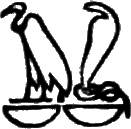 Pronunciation doubtful, either neb mut neb ârâ or neb sheta neb meḥen·t:
"the lord of the Vulture and Uræus diadems". The title of Pharaoh as the ruler of Upper and
Lower Egypt. E CENT. 56
S WEST 66 N WEST 70
Pronunciation doubtful, either neb mut neb ârâ or neb sheta neb meḥen·t:
"the lord of the Vulture and Uræus diadems". The title of Pharaoh as the ruler of Upper and
Lower Egypt. E CENT. 56
S WEST 66 N WEST 70
 nub. Noun: "gold". In the phrase Hor-nub "the golden hawk or
Horus". E SOUTH 64
W SOUTH 68 N CENT. 60
nub. Noun: "gold". In the phrase Hor-nub "the golden hawk or
Horus". E SOUTH 64
W SOUTH 68 N CENT. 60
 nefer. Adj.: "good, gracious, benevolent, beautiful". Pyr. EAST 47 SOUTH
50 WEST 52 53 NORTH 54 Base of E 71
71 71 71 S 71 71 71 71 W 71 71 71 71 N 71 71 71 71
nefer. Adj.: "good, gracious, benevolent, beautiful". Pyr. EAST 47 SOUTH
50 WEST 52 53 NORTH 54 Base of E 71
71 71 71 S 71 71 71 71 W 71 71 71 71 N 71 71 71 71
 neferu. Plural of the preceding word: "beauty". E CENT. 56
neferu. Plural of the preceding word: "beauty". E CENT. 56
 nen. Adv.: "not". S CENT. 58 W NORTH 67
nen. Adv.: "not". S CENT. 58 W NORTH 67
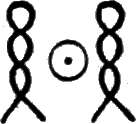 neḥeḥ or, possibly, only ḥeḥ. Noun, &c.:
"eternity; eternal; forever". E CENT. 56
neḥeḥ or, possibly, only ḥeḥ. Noun, &c.:
"eternity; eternal; forever". E CENT. 56
 nekht. Adj. and noun: "powerful, valiant, mighty; strength". E NORTH 62 CENT. 56 SOUTH 63 S EAST 65 CENT.
58 WEST 66 W NORTH 67 CENT. 59
SOUTH 68 N EAST 68 CENT.
60 WEST 70 Pyr. EAST 48 SOUTH 50
WEST 53 NORTH 55
nekht. Adj. and noun: "powerful, valiant, mighty; strength". E NORTH 62 CENT. 56 SOUTH 63 S EAST 65 CENT.
58 WEST 66 W NORTH 67 CENT. 59
SOUTH 68 N EAST 68 CENT.
60 WEST 70 Pyr. EAST 48 SOUTH 50
WEST 53 NORTH 55
 nekhtu. Plural of the preceding word: "victory". N CENT. 60
nekhtu. Plural of the preceding word: "victory". N CENT. 60
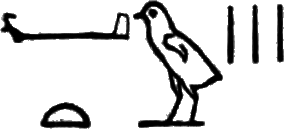 nekhtu. Same word as the preceding: "victory". E SOUTH 64 W SOUTH 68
nekhtu. Same word as the preceding: "victory". E SOUTH 64 W SOUTH 68
 ent. Lengthened form of the preposition n (cf. above). Sign of the genitive case:
"of". N CENT. 60
ent. Lengthened form of the preposition n (cf. above). Sign of the genitive case:
"of". N CENT. 60
 enti (others read entet). Relative pronoun: "who, which, what; whose; whom".
E CENT. 56
enti (others read entet). Relative pronoun: "who, which, what; whose; whom".
E CENT. 56
 nuter. Noun and adj.: "god; divine". E CENT.
57 Pyr. EAST 47 49 SOUTH 50 51 WEST 52 53 NORTH 54 Base of E 71
71 S 71 71 W 71 71
N 71 71 Reading from right to left.
Base of E 71 71 S 71 71
W 71 71 N 71 71
nuter. Noun and adj.: "god; divine". E CENT.
57 Pyr. EAST 47 49 SOUTH 50 51 WEST 52 53 NORTH 54 Base of E 71
71 S 71 71 W 71 71
N 71 71 Reading from right to left.
Base of E 71 71 S 71 71
W 71 71 N 71 71
 nuter. Same word as the preceding: "god". S EAST
65
nuter. Same word as the preceding: "god". S EAST
65
 nuteru. Plural of nuter: "gods". E CENT.
57
nuteru. Plural of nuter: "gods". E CENT.
57
 nuteru. Same word as the preceding: "gods". E NORTH 62 W NORTH 67
nuteru. Same word as the preceding: "gods". E NORTH 62 W NORTH 67
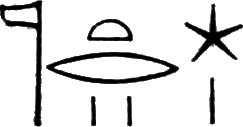 nuteri dûa. Noun: "morning-star". S EAST 65
nuteri dûa. Noun: "morning-star". S EAST 65
 r. Prep.: "out, over, for, as, in order to". E SOUTH 64 64 N
EAST 69 69
CENT. 60 60
Pyr. E 49 S 51 W 53 N 55
r. Prep.: "out, over, for, as, in order to". E SOUTH 64 64 N
EAST 69 69
CENT. 60 60
Pyr. E 49 S 51 W 53 N 55
 ru. Noun: "mouth, end". N CENT. 60
ru. Noun: "mouth, end". N CENT. 60
 Râ. "Rā, the sun." E NORTH 62 62 CENT. 56 57 SOUTH 64 64 S EAST
65 65 CENT.
58 WEST 66 66 W NORTH
67 67 CENT.
59 SOUTH 68 68 N EAST
69 69 CENT.
61 WEST 70 70 Pyr. EAST
48 SOUTH 50 WEST 53
NORTH 55 SMALL
SIDE INSCRIPTIONS E 72 72
S 72 72 W 72 72 N 72 72
Râ. "Rā, the sun." E NORTH 62 62 CENT. 56 57 SOUTH 64 64 S EAST
65 65 CENT.
58 WEST 66 66 W NORTH
67 67 CENT.
59 SOUTH 68 68 N EAST
69 69 CENT.
61 WEST 70 70 Pyr. EAST
48 SOUTH 50 WEST 53
NORTH 55 SMALL
SIDE INSCRIPTIONS E 72 72
S 72 72 W 72 72 N 72 72
 Râ. Same word as the preceding: "Rā, the sun". E SOUTH 64 64 S
WEST 66 66
W SOUTH 68 N EAST 69 69 WEST 70
Râ. Same word as the preceding: "Rā, the sun". E SOUTH 64 64 S
WEST 66 66
W SOUTH 68 N EAST 69 69 WEST 70
 Râ. Same word as the preceding: "Rā, the sun". N CENT. 60
Râ. Same word as the preceding: "Rā, the sun". N CENT. 60
 Râ. Same word as the preceding: "Rā, the sun". E NORTH 62 W NORTH 67
Râ. Same word as the preceding: "Rā, the sun". E NORTH 62 W NORTH 67
 Râ. Same word as the preceding: "Rā, the sun". E NORTH 62 63 SOUTH 64 S CENT. 58 WEST
66 W NORTH 67 SOUTH 68
N CENT. 60 WEST 70
Râ. Same word as the preceding: "Rā, the sun". E NORTH 62 63 SOUTH 64 S CENT. 58 WEST
66 W NORTH 67 SOUTH 68
N CENT. 60 WEST 70
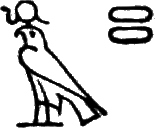 Râ-Hor-khuti. A name of the sun-god: "Rā, the hawk in the horizon". S
CENT. 58 W CENT. 60 Pyr. EAST 49 North
55
Râ-Hor-khuti. A name of the sun-god: "Rā, the hawk in the horizon". S
CENT. 58 W CENT. 60 Pyr. EAST 49 North
55
 renpe·tu. Noun, plural of renpe·t "year", hence: "years". E
SOUTH 61 W SOUTH 68
renpe·tu. Noun, plural of renpe·t "year", hence: "years". E
SOUTH 61 W SOUTH 68
 rekh. Verb: "to know, understand". E CENT.
56
rekh. Verb: "to know, understand". E CENT.
56
 Same word as the preceding: "to know, understand". S EAST 65
Same word as the preceding: "to know, understand". S EAST 65
 hapu. Noun, plural of hap "law, judgment", hence: "laws". S EAST 65
hapu. Noun, plural of hap "law, judgment", hence: "laws". S EAST 65
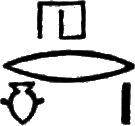 har. Adj.: "calm, satisfied, glad". N CENT. 60
har. Adj.: "calm, satisfied, glad". N CENT. 60
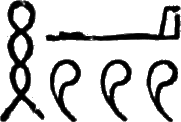 ḥâu. Noun, plural of ḥâ "limb", hence: "limbs". {184}E CENT. 56
ḥâu. Noun, plural of ḥâ "limb", hence: "limbs". {184}E CENT. 56
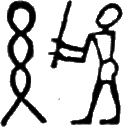 ḥu. Verb: "to smite, strike". N CENT.
60
ḥu. Verb: "to smite, strike". N CENT.
60
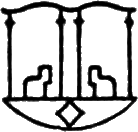 ḥeb. Noun: "festival, feast". S EAST
65
ḥeb. Noun: "festival, feast". S EAST
65
 ḥebu. Plural of the preceding word: "festivals". N EAST 69
ḥebu. Plural of the preceding word: "festivals". N EAST 69
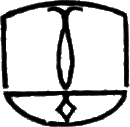 ḥeb. Noun: "festival". In the phrase sed-ḥeb "the
thirty-year period". S CENT. 58
ḥeb. Noun: "festival". In the phrase sed-ḥeb "the
thirty-year period". S CENT. 58
 ḥun. Noun: "child, boy, youth". E NORTH
62
ḥun. Noun: "child, boy, youth". E NORTH
62
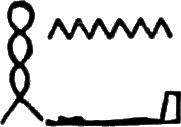 ḥenâ. Prep.: "with". E CENT. 57
ḥenâ. Prep.: "with". E CENT. 57
 ḥer. Noun: "face". N WEST 70
ḥer. Noun: "face". N WEST 70
 Ḥer. "Horus" with the double crown of Egypt. E NORTH 62 CENT. 56 SOUTH 63 S EAST 65 CENT.
58 WEST 66 W NORTH 67 CENT. 59
SOUTH 68 N EAST 68 CENT.
60 WEST 70
Ḥer. "Horus" with the double crown of Egypt. E NORTH 62 CENT. 56 SOUTH 63 S EAST 65 CENT.
58 WEST 66 W NORTH 67 CENT. 59
SOUTH 68 N EAST 68 CENT.
60 WEST 70
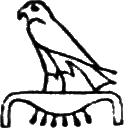 Ḥer-nub. "The golden Horus." E SOUTH
64 W SOUTH 68 N CENT. 60
Ḥer-nub. "The golden Horus." E SOUTH
64 W SOUTH 68 N CENT. 60
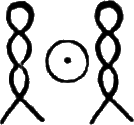 See under neḥeḥ. E CENT. 56
See under neḥeḥ. E CENT. 56
 ḥeq. Noun: "prince, chief". Pyr. SOUTH
51 WEST 52
ḥeq. Noun: "prince, chief". Pyr. SOUTH
51 WEST 52
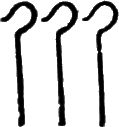 ḥequ. Plural of the preceding word: "princes, chiefs". N CENT. 60
ḥequ. Plural of the preceding word: "princes, chiefs". N CENT. 60
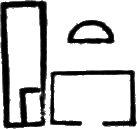 ḥa·t. Noun: "temple". Pyr. SOUTH 51 WEST 53
ḥa·t. Noun: "temple". Pyr. SOUTH 51 WEST 53
 ḥa·t-â. From the preceding word with the adjective â "great", hence:
"the great temple". E CENT. 56
ḥa·t-â. From the preceding word with the adjective â "great", hence:
"the great temple". E CENT. 56
 ḥez. Adj.: "white". Noun: "the white crown" of Upper
Egypt. N CENT. 60
ḥez. Adj.: "white". Noun: "the white crown" of Upper
Egypt. N CENT. 60
 khâ. Adj.: "glorious, crowned". E CENT. 56 W CENT. 59 Pyr. EAST 48 SOUTH 50
WEST 53 NORTH 55
khâ. Adj.: "glorious, crowned". E CENT. 56 W CENT. 59 Pyr. EAST 48 SOUTH 50
WEST 53 NORTH 55
 khâu. Noun, plural of khâ "crown", hence: "diadems, crowns". E
SOUTH 64
khâu. Noun, plural of khâ "crown", hence: "diadems, crowns". E
SOUTH 64
 khu. Verb, &c.: "to be glorious; resplendent; glory, splendor". E NORTH 63 SOUTH 64
khu. Verb, &c.: "to be glorious; resplendent; glory, splendor". E NORTH 63 SOUTH 64
 khu·t. Noun: "horizon". E NORTH 62
khu·t. Noun: "horizon". E NORTH 62
 khuti. Dual of the preceding word: "the two horizons". See under
Râ-Ḥor-khuti.
khuti. Dual of the preceding word: "the two horizons". See under
Râ-Ḥor-khuti.
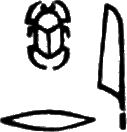 Kheperȧ. The god "Khepera", literally "the creator". E SOUTH 63
Kheperȧ. The god "Khepera", literally "the creator". E SOUTH 63
 khepesh. Noun: "strength, power, victory". N CENT. 60
khepesh. Noun: "strength, power, victory". N CENT. 60
 kher. Conj. and prep.: "for". E CENT. 56
kher. Conj. and prep.: "for". E CENT. 56
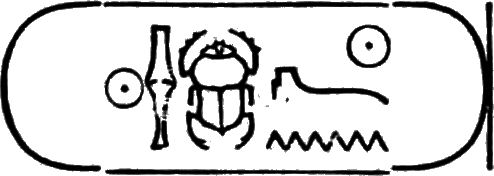 Kherp-kheper-Râ-sotep-en-Râ. The first cartouche or the royal name of Osarkon I., {186}"made governor by Rā, chosen of Rā".
SMALL SIDE INSCRIPTIONS E 72 72 S 72 72
W 72 72 N 72 72
Kherp-kheper-Râ-sotep-en-Râ. The first cartouche or the royal name of Osarkon I., {186}"made governor by Rā, chosen of Rā".
SMALL SIDE INSCRIPTIONS E 72 72 S 72 72
W 72 72 N 72 72
 kha·t. Noun: "belly, womb". E CENT. 56
kha·t. Noun: "belly, womb". E CENT. 56
 kha·t. Same word as the preceding: "belly, womb". E SOUTH 64
kha·t. Same word as the preceding: "belly, womb". E SOUTH 64
 khet. Noun: "thing; things". Pyr. NORTH 54
khet. Noun: "thing; things". Pyr. NORTH 54
 khatf. Prep. and conj.: "for, before; since, because". N
CENT. 60 WEST 70
khatf. Prep. and conj.: "for, before; since, because". N
CENT. 60 WEST 70
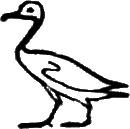 sa. Noun: "son, child, offspring". E NORTH
62 62 CENT.
56 SOUTH 64 64 S EAST
65 65 CENT.
58 WEST 66 66 W NORTH
67 67 CENT.
59 SOUTH 68 68 N EAST
69 69 CENT.
61 WEST 70 70 Pyr. EAST
48 SOUTH 50 WEST 53
NORTH 55 SMALL
SIDE INSCRIPTIONS E 72 72
S 72 72 W 72 72 N 72 72
sa. Noun: "son, child, offspring". E NORTH
62 62 CENT.
56 SOUTH 64 64 S EAST
65 65 CENT.
58 WEST 66 66 W NORTH
67 67 CENT.
59 SOUTH 68 68 N EAST
69 69 CENT.
61 WEST 70 70 Pyr. EAST
48 SOUTH 50 WEST 53
NORTH 55 SMALL
SIDE INSCRIPTIONS E 72 72
S 72 72 W 72 72 N 72 72
 sa. Same word as the preceding: "son, child, offspring". E SOUTH 63 S WEST 66 W SOUTH 68 N WEST 70
sa. Same word as the preceding: "son, child, offspring". E SOUTH 63 S WEST 66 W SOUTH 68 N WEST 70
 s·âḥâ. Verb, causative form of âḥâ "to raise", hence: "to
cause to be raised, erect". S CENT. 58
s·âḥâ. Verb, causative form of âḥâ "to raise", hence: "to
cause to be raised, erect". S CENT. 58
 su. Personal pronoun third person: "he, him; himself; she, her; herself; it; itself;
they, them; themselves". E SOUTH 64 N EAST 69
su. Personal pronoun third person: "he, him; himself; she, her; herself; it; itself;
they, them; themselves". E SOUTH 64 N EAST 69
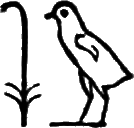 su. Same word as the preceding: "he; him; &c." N CENT. 60
su. Same word as the preceding: "he; him; &c." N CENT. 60
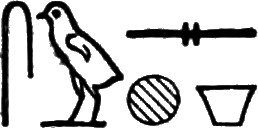 s·usekh. Verb, causative form of usekh "to extend", hence: "to cause to be
extended". N CENT. 60
s·usekh. Verb, causative form of usekh "to extend", hence: "to cause to be
extended". N CENT. 60
 sep. Noun: "time, times", after numerals. S CENT. 58
sep. Noun: "time, times", after numerals. S CENT. 58
 s·menkh. Verb, causative of menkh "to be beautiful", hence: "to render
beautiful, embellish". W CENT. 59
s·menkh. Verb, causative of menkh "to be beautiful", hence: "to render
beautiful, embellish". W CENT. 59
 sen. Personal pronoun third person plural masculine: "they; them; their". E
CENT. 56 56
sen. Personal pronoun third person plural masculine: "they; them; their". E
CENT. 56 56
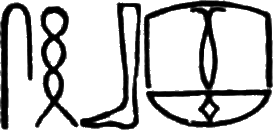 s·ḥeb. Verb, causative form of ḥeb "to be glad", hence: "to
cause to rejoice, gladden". N EAST 69
s·ḥeb. Verb, causative form of ḥeb "to be glad", hence: "to
cause to rejoice, gladden". N EAST 69
 suten. Noun: "king". E CENT. 56
suten. Noun: "king". E CENT. 56
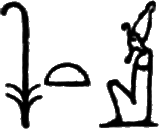 suten. Same word as the preceding: "king". S WEST 66 N WEST 70
suten. Same word as the preceding: "king". S WEST 66 N WEST 70
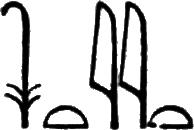 sutenî·t. Noun, derived from the preceding word: "kingdom". E CENT. 56
sutenî·t. Noun, derived from the preceding word: "kingdom". E CENT. 56
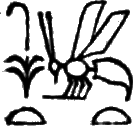 suten-kaut (doubtful!). Noun: "the king of Upper and Lower Egypt". E NORTH 62 CENT. 56 SOUTH 63 S EAST 65 CENT.
58 WEST 66 W NORTH 67 CENT. 59
SOUTH 68 N EAST 68 CENT.
60 WEST 70 Pyr. WEST 52 NORTH 54
SMALL SIDE INSCRIPTIONS E 72 72 S 72 72
W 72 72 N 72 72
suten-kaut (doubtful!). Noun: "the king of Upper and Lower Egypt". E NORTH 62 CENT. 56 SOUTH 63 S EAST 65 CENT.
58 WEST 66 W NORTH 67 CENT. 59
SOUTH 68 N EAST 68 CENT.
60 WEST 70 Pyr. WEST 52 NORTH 54
SMALL SIDE INSCRIPTIONS E 72 72 S 72 72
W 72 72 N 72 72
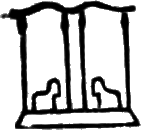 sed. In the phrase sed-ḥeb "the thirty year period festival". S
CENT. 58
sed. In the phrase sed-ḥeb "the thirty year period festival". S
CENT. 58
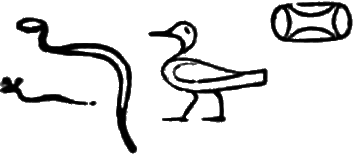 s·zef. Verb, causative form of zef "to be {188}full", hence: "to cause to be filled, provide with". N
EAST 69
s·zef. Verb, causative form of zef "to be {188}full", hence: "to cause to be filled, provide with". N
EAST 69
 shep. Verb: "to seize, obtain". E SOUTH 64
shep. Verb: "to seize, obtain". E SOUTH 64
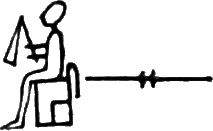 shepes. Adj.: "beautiful, glorious". E NORTH
62
shepes. Adj.: "beautiful, glorious". E NORTH
62
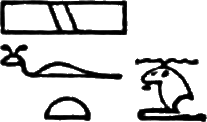 shef·t. Noun: "terror, awe". S EAST 65
shef·t. Noun: "terror, awe". S EAST 65
 qa. Verb, abbreviated form of
qa. Verb, abbreviated form of 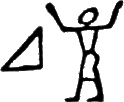 qa: "to raise".
N CENT. 60
qa: "to raise".
N CENT. 60
 qa. Noun: "bull". E NORTH 62 CENT. 56
SOUTH 63 S EAST 65 CENT.
58 WEST 66 W NORTH 67 CENT. 59
SOUTH 68 N EAST 68 WEST
70 Pyr. EAST 48 SOUTH 50
WEST 53 NORTH 55
qa. Noun: "bull". E NORTH 62 CENT. 56
SOUTH 63 S EAST 65 CENT.
58 WEST 66 W NORTH 67 CENT. 59
SOUTH 68 N EAST 68 WEST
70 Pyr. EAST 48 SOUTH 50
WEST 53 NORTH 55
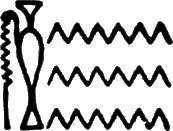 qebeḥ. Noun: "libation". Pyr. WEST
53 NORTH 55
qebeḥ. Noun: "libation". Pyr. WEST
53 NORTH 55
 Qem·t. "Egypt". S WEST 66 N CENT. 61 WEST 70
Qem·t. "Egypt". S WEST 66 N CENT. 61 WEST 70
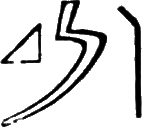 qema. Verb: "to create". E CENT. 56
qema. Verb: "to create". E CENT. 56
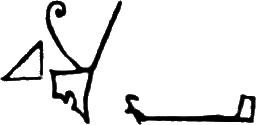 qen. Noun: "force, triumph, victory". N WEST 70
qen. Noun: "force, triumph, victory". N WEST 70
 ger. Verb: "to seize, possess". E NORTH 62 W NORTH 67
ger. Verb: "to seize, possess". E NORTH 62 W NORTH 67
 ta. Noun: "land, earth". N CENT. 60
ta. Noun: "land, earth". N CENT. 60
 ta. Same word as the preceding: "land, earth". N WEST 70
ta. Same word as the preceding: "land, earth". N WEST 70
 taui. Dual of the two preceding words: "the two countries", Egypt. E NORTH 62 62 SOUTH 64 S EAST 65 65 WEST 66 W NORTH 67 67 SOUTH 68 N EAST 69 WEST
70 Pyr. EAST 47 SOUTH 50 51 WEST 52
NORTH 54 55
Written separately. Pyr. EAST 49
taui. Dual of the two preceding words: "the two countries", Egypt. E NORTH 62 62 SOUTH 64 S EAST 65 65 WEST 66 W NORTH 67 67 SOUTH 68 N EAST 69 WEST
70 Pyr. EAST 47 SOUTH 50 51 WEST 52
NORTH 54 55
Written separately. Pyr. EAST 49
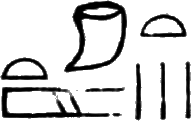 tash·tu. Noun, plural of tash·t "boundary", hence: "boundaries".
N CENT. 60
tash·tu. Noun, plural of tash·t "boundary", hence: "boundaries".
N CENT. 60
 tep. Adj.: "first". S CENT. 58
tep. Adj.: "first". S CENT. 58
 tef. Noun, contracted form of
tef. Noun, contracted form of 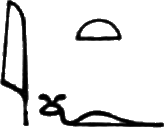 ȧtef: "father". S CENT. 58 N CENT. 60
ȧtef: "father". S CENT. 58 N CENT. 60
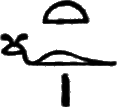 tef. Same word as the preceding: "father". S EAST 65 W NORTH 67 N EAST 69
tef. Same word as the preceding: "father". S EAST 65 W NORTH 67 N EAST 69
 Tum. The god "Tum". E CENT. 57 Pyr. SOUTH 51 WEST 53
Tum. The god "Tum". E CENT. 57 Pyr. SOUTH 51 WEST 53
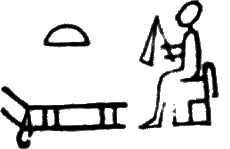 Tum. Same word as the preceding: the god "Tum". E CENT. 56
Tum. Same word as the preceding: the god "Tum". E CENT. 56
 tekhenui. Noun, dual of tekhen "obelisk", hence: "two
obelisks". S CENT. 58
tekhenui. Noun, dual of tekhen "obelisk", hence: "two
obelisks". S CENT. 58
 du. Verb, &c.: "to give; giving; gift". E NORTH 63 CENT. 57 S EAST 65 W NORTH 67 N EAST 69 CENT.
61 WEST 70 Pyr. EAST 47 49 SOUTH 50 51 WEST 52 53 53 NORTH 54 55 55
du. Verb, &c.: "to give; giving; gift". E NORTH 63 CENT. 57 S EAST 65 W NORTH 67 N EAST 69 CENT.
61 WEST 70 Pyr. EAST 47 49 SOUTH 50 51 WEST 52 53 53 NORTH 54 55 55
 du·t. Noun, from the preceding word: "gift, present". Pyr. EAST 49 SOUTH
51 WEST 53 NORTH 55
du·t. Noun, from the preceding word: "gift, present". Pyr. EAST 49 SOUTH
51 WEST 53 NORTH 55
 dûa. Noun: "star". In the phrase nuterti dûa "the morning-star".
S EAST 65
dûa. Noun: "star". In the phrase nuterti dûa "the morning-star".
S EAST 65
 dem. Adj.: "all, complete". N WEST 70
dem. Adj.: "all, complete". N WEST 70
 dem·t. Noun, from the preceding word: "completeness, totality". N CENT. 60
dem·t. Noun, from the preceding word: "completeness, totality". N CENT. 60
 Deḥuti. The god "Thoth". E CENT. 56
Deḥuti. The god "Thoth". E CENT. 56
 Deḥuti-meses-nefer-kheperu. The second cartouche or the family name of Thothmes
III., "the child of Thoth, beautiful in his transformations (or of beautiful form)".
S CENT. 58 W CENT. 60 N CENT. 61
Deḥuti-meses-nefer-kheperu. The second cartouche or the family name of Thothmes
III., "the child of Thoth, beautiful in his transformations (or of beautiful form)".
S CENT. 58 W CENT. 60 N CENT. 61
 ded. Noun: "stability". E CENT. 57 Pyr. WEST 53
ded. Noun: "stability". E CENT. 57 Pyr. WEST 53
 dedui. Noun, dual of ded "hand", hence: "the two hands". N
CENT. 60
dedui. Noun, dual of ded "hand", hence: "the two hands". N
CENT. 60
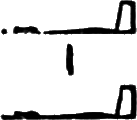 dedui. Same word as the preceding: "two hands". N WEST 70
dedui. Same word as the preceding: "two hands". N WEST 70
 zeta. Noun, &c.: "eternity; eternal; forever". E CENT. 57 S CENT. 58 W CENT. 60 N CENT. 61 Pyr. EAST 47 SOUTH
50 WEST 52 NORTH 54
zeta. Noun, &c.: "eternity; eternal; forever". E CENT. 57 S CENT. 58 W CENT. 60 N CENT. 61 Pyr. EAST 47 SOUTH
50 WEST 52 NORTH 54
Transcriptions from the Egyptian are given in heavy type, those from the Greek in Italics.
Ȧaḥmes I., 18. dyn. 102 110 126 150
Ȧaḥmesnefertȧri, queen 18. dyn. 110
Abd-el-Latîf, Arabic physician. 123
Abd-el-Qurnah. [Thebes] 96
Aboccis. [Abusimbel] 93
Abuncis. [Abusimbel] 93
Âbu·t. [Elephantine] 24 93 119
Achæans, Greek tribe. 121
Ad, Arabic tribe. 93
Africanus. 94
Akaüsha (Ȧqaûasha). [Achæans] 121
Aleksȧndres I. and II. [Alexander III. and IV.] 94 111
Alexander I., 32. dyn., or Alexander III., the Great, of Macedon. 32 91 94 111 142 144
Alexander II., 32. dyn., or Alexander IV., of Macedon. 111
Alexander VII., Pope. 140
Alexandria. viii 8 35 39 40 41 42 43 44 72 73 79 81 82 91 94 95 101 102 105 129 131 141 144 154
Alexandrian Obelisk, in London. 8 10 41 95 130
Alnwick. Alnwick Castle, in England. 95
Alnwick Castle Obelisk. 10 95 147
Alsace. 118
Ȧmen, god. 35 37 38 62 63 64 65 66 67 68 69 70 71 72 87 88 94 95 96 97 98 122 129 136 138 144 149 150 156 157 175
Ȧmenemḥât I., 12. dyn. 109 152
Ȧmenemḥât III., 12. dyn. 90 95 109 119 129 134
Ȧmenḥotep I., II., III., and IV., 18. dyn. 110
Ȧmenî Inscription. 127
Amenophis II., 18. dyn. 6 10 95 96 110 133 137 151
Amenophis III., 18. dyn. 16 88 96 110 112 130 153
Amenophis IV., 18. dyn. 29 30 89 96 101 (110) 149
Ȧmen-Râ, god. 29 37 88 95 97 100 119 128 133 136 142
Ȧmenrud [Amyrtæus], 28. dyn. 98 110
Ammenemes I., II., III., and IV., 12. dyn. 109
{192}Ammon, god. 95
Amru, Arabic general. 94
Ȧmseth, one of the genii. 97
Amyrteos I. [Amyrtæus], 28. dyn. 110
Ȧn. [Heliopolis] 36 51 52 53 56 58 69 91 96 98 111 123 144 175
Ȧnbu-ḥez·t. [Memphis] 132
Ȧndînes. [Antinoüs] 122
Ȧnît. [Esneh] 120
Ȧn-menth. [Hermonthis] 87 99 120
Ȧnpu [Anubis], god. 99
Ȧntarîush (Ȧnthalîûsh) [Darius I.], 27. dyn. 110
Ȧntef I., II., III., IV., and V., 11. dyn. 109
Ȧntef the Great, 11. dyn. 9 11 99 109
Ȧntefâ [Antef the Great], 11. dyn. 99
Ȧnthrîsh [Darius II.], 27. dyn. 110
Antioch, in Syria. 117
Antoninus Pius, Roman emperor. 111
Anubis, god. 89 97 98 99 100 147 160
Apeium. 100
Aphrodite [Venus], goddess. 123
Apollo, god. 118
Apollinopolis. 118
Arabia. Arabic. 19 79 88 93 94 100 106 114 120 122 123 126 127 133 140 142 149 153
Arabia Felix. 147
Aram. [Syria] 133
Aram-naharayim. [Mesopotamia] 133
Ares [Mars], god. 131
Arles, in France. 10 22 100 101
Artakhshashs [Artaxerxes], 27. dyn. 110
Artaxerxes I., 27. dyn. 98 110
Artaxerxes II., Persian king. 135
Ȧrunuth. [Orontes] 137
Asia. Asiatic. 86 96 101 125 128 137 138 146 147 149
Assuân. [Syene] 13 23 24 86 101 119 123 148 152
Ȧs·t [Isis], goddess. 39 102 105 106 126 136 158
Aswân. [Assuân] 149
Ȧten, god. 62 63 75 89 96 97 101 149 176
Athene [Minerva], goddess. 136
Atrînes [Hadrian], Roman emperor. 122
Augustus, Roman emperor. 8 25 32 39 72 73 74 82 102 105 107 111 112 121 141
Augustus, title of Roman emperors. 117 122
Aurelian, Roman emperor. 111
Aurelius, Roman emperor. 111
Aurora, goddess. 153
Autocrator, title of Roman emperors. 39 102 106 111 117 122 136
Avaris. [Pelusium] 92 102 123 139
Balîkh, river in Syria. 117
{193}Barbarus, Roman prefect. 39 73 74 82 103
Barberini [Pope Urban VIII.]. 103
Barberini Obelisk. 9 103 121 134 144
Bashmuric dialect [Coptic]. 113
Bast, goddess. 92 98 103 105 146 158
Bedouins [Arabs]. 126
Bejij [Crocodilopolis]. 5 103 114
Benemthesti [Benevento]. 103
Benevento, in Italy. 8 10 103 104
Beq·t [Egypt]. 118
Berenice III., Ptolemaic queen. 111
Berlin, in Germany. 10 105 130
Bêth Shêmesh [Heliopolis]. 2
Boboli Gardens Obelisk. 10 104
Böckh, historian. 108
Bolbitine. 145
Bonomi, Egyptologist. 11 104 147
Book of the Dead. 33 34 98 99 104 118 134 136
Borgian Obelisk. 10 94 104 135
Bosphorus. 105
Boussard, French engineer. 92 105
British Museum. 10 98 135 139 145
Brugsch, H., Egyptologist. 26 105 108 118 119
Bubastis. 92 102 105 110 139 149
Bunsen, historian. 108
Buto, goddess. 98
Byzantium [Constantinople]. 8 105 113
Cæsar, Julius, Roman dictator. 112
Cæsar, emperor Augustus. 32 39 73 74 82 102 105
Cæsar, title of Roman emperors. 39 105 106 111 117 122
Cairo. 1 5 11 36 38 90 91 105 106 123 131 137
Caligula, Roman emperor. 8 102 106 111 153
Cambyses, 27. dyn. viii 1 106 110
Campensis Obelisk. 9 106 134 141
Campus Martius, in Rome. 107
Canaan [Palestine]. 138
Caracalla, Roman emperor. 102 111
Carkhemish, on the Euphrates. 36 107
Cataracts of the Nile. 108
Champollion, Egyptologist. 112 114
Circus Maximus, in Rome. 121
Claudius, Roman emperor. 8 102 104 111 134 148
Clement XI., Pope. 131
Cleopatra II., Ptolemaic queen. 7 111 112 114 140 142
Cleopatra III., Ptolemaic queen. 111 142
Cleopatra VI., Ptolemaic queen. 39 40 111 112
Cleopatra's Needle, in New York. 8 10 41 42 81 112 136
Columbia College, in New York. 72
Commodus, Roman emperor. 111
Constantine the Great, emperor. 8 10 22 100 101 111 113 129
Constantinople. 8 9 101 102 105 113 141
Constantius II., emperor. 8 111 113 129
Coptic language. 90 105 113 116 145 149
Corfe Castle, in England. 114
Corfe Castle Obelisk. 10 114 140
Crocodilopolis. 5 11 90 103 114 120
Cyriacus Matthæius, Roman senator. 153
Dakkeh, in Nubia. 114
Dammêsek [Damascus]. 114
Dareios Hystaspes, 27. dyn. 110
Decius, Roman emperor. 111
Deḥuti [Thoth], god. 49 56 58 60 61 115 150 151 158 159 161 190
Della Passeggiata Obelisk. 103
Delta. 84 90 93 98 102 115 130
Demotic language. 114 115 116 124 145
Denmark. Danish. 154
Denys of Telmahre, Syrian patriarch. 19 117
Dêr-el-Baheri [Thebes]. 88 117
Diana, goddess. 146
Dimashku [Damascus]. 114
Diodorus, Greek geographer. 132
Dionysius Tell-Mahrâyâ. 117
Domitian, Roman emperor. 5 7 8 9 10 22 94 103 104 111 117 139
Dorsetshire, in England. 114
Drah-abul-Neggah [Thebes]. 88 117
Drah-abul-Neggah Obelisks. 9 11 118
Dûamutf, one of the genii. 97
Du en bekhen [Hammamât]. 88
Dümichen, Egyptologist. 61 100 118 133
Dumyât [Damietta]. 115
Ebers, Egyptologist. 118
Ebjij [Crocodilopolis]. 103
Edfu. 31 87 115 118 125 126 138
Edrisi, Arabic geographer. 126
Eileithyia, goddess. 119
Eileithyia, district. 136
El-Assasîf [Thebes]. 99
Elephantine. 4 24 29 86 93 109 119 128 137
El·Fatan-ibn-Jârûd, Arabic name. 80
El-Kab [Eileithyiapolis]. 87 119
El-Kâhira [Cairo]. 106
El-Khargeh, oasis. 89 119 127 130
El·Thabût-ben-Marrat, Arabic name. 80 119
England. English. 8 10 11 40 74 81 93 95 104 114 123 147 154
Epiphanes, Ptolemaic title. 111 142 145
Erment [Hermonthis]. 87 120 123
Esdraëlon, in Palestine. 131
Ethiopia. 110 120 130 137 140 141 152
Etruscans, ancient Italian tribe. 121
Evarts, U. S. Secretary of State. 83
Fayoom. 4 5 89 95 103 114 119 120 129 130 134 146 152
First Cataract. 24 86 101 108 118
Fort St. Julien. 105
Fostât. 106
France. French. 8 10 22 92 100 105 130
Galba, Roman emperor. 111
Gallienus, emperor. 111
Germany. German. 10 94 129 135
Geta, Roman emperor. 111
Gizeh. 4 91 103 121 122 127 128 130 132
Glyptothek, in Munich, Germany. 94
Gorringe, U. S. Navy. 40 41 43 46 83
Graywacke Knoll, in Central Park, New York. 43 44
Greece. Greek. 12 21 51 72 73 74 84 87 89 90 91 96 97 98 100 103 105 111 112 113 114 118 119 120 121 122 123 125 126 127 128 129 131 132 135 136 137 139 144 145 146 148 149 151 152 153
Hadrian, Roman emperor. 5 7 9 22 103 111 121 122
Harmâ·t [Rome]. 144
Ḥa-Sebek [Crocodilopolis]. 103 114
{195}Ḥashepes (Ḥâ·t-shepes), queen 18. dyn. 122
Hatasu, queen 18. dyn. 6 9 11 19 23 35 117 122 127 131 133 150
Hatasu Obelisks. 122
Ḥa·t-Ḥer [Hathor], goddess. 123 166
Hathor, goddess. 88 98 117 123 166
Ḥa·t-nebes·t [Damietta]. 115
Ḥa·t-ûar·t [Avaris]. 92 102 123
Ḥauinebu [Greeks]. 121
Hayes, U. S. President. 83
Hegira, flight of Mohammed. 126
Heliopolis. 1 2 4 9 10 19 21 36 38 51 52 53 56 57 58 69 75 76 77 78 82 91 96 98 101 102 104 107 111 121 123 125 131 133 134 141 143 144 151 153 175
Heliupolis [Heliopolis]. 111
Ḥep [Apis]. 100
Ḥepî, one of the genii. 97
Ḥeqet (Ḥeq·t), goddess. 98
Heracleopolis. 109
Hermapion, Egyptian priest. 121
Herodotus, Greek historian. 132
Hieratic writing. 34 115 116 124 140
Hittites, nation. 36 37 101 107 125 127 128 139 144 147
Homer, Greek poet. 2 37 125 126 139
Ḥor (Ḥer) [Horus], god. 29 56 58 59 60 62 63 64 65 66 67 68 70 136 160 161 166 181 184
Ḥor-ḥud·t [Horus of Edfu], god. 31 125
Horus, god. 28 30 31 47 56 57 58 59 60 61 62 63 64 65 66 67 68 69 70 75 76 77 78 87 97 98 118 122 123 125 126 138 146 157 160 161 181 184
Howara Pyramid. 129
Hyksos. 92 101 102 109 110 126 147 149
Ibn-el-Vardi, Arabic geographer. 79 126
India. 13
Innocent X., Pope. 139
Ipsambul [Abusimbel], in Nubia. 93
Ishmaël, Khedive. 40 111 126 137
Isis, goddess. 86 98 102 106 114 123 125 126 136 138 140 158
Isle of Purbeck, in England. 114
Istambûl [Constantinople]. 113
Jacobites, sect. 117
Jebel Barkal, in Nubia. 137
Jebel Selseleh [Silsilis]. 86 126 128
Jerablûs, in Syria. 107
Joseph, biblical patriarch. 2 127
Josiah, king of Judah. 131
Judah, kingdom in Palestine. 132
Jupiter, god. 95
Kaîseres [Cæsar], title. 106
Kambyses [Cambyses], 27. dyn. 110
Kanâna [Canaan]. 138
Karnak [Thebes]. 2 3 6 88 112 121 122 127 149 153
Karnak Obelisks. 9 10 11 19 127
Karukamsha [Carkhemish]. 107
Kembȧthet [Cambyses], 27. dyn. 106 110
Kenemti [El-Khargeh]. 89 119 127
Kharu, Syrian tribe. 36 101 127 131
Khefren or Khephren, 4. dyn. 91 109 127
Kheops, 4. dyn. 91 109 122 128
Kheperȧ, god. 63 64 75 128 185
Kheper-Râ, god. 98
Kher-nuter [Elysium]. 97
Kheta [Hittites], nation. 36 37 101 125 128
Khittîm [Hittites], nation. 128
Khnum, god. 86 87 98 120 128 158 159
Khnum-ḥotep Tomb. 104
Khnumu, god. 128
Khshîarush [Xerxes I.], 27. dyn. 110
Khu-en-Ȧten [Amenôphis IV.], 18. dyn. 97
Khu-en-Ȧten [Tel-el-Amarna]. 89
Khufu, 4. dyn. 5 109 128 133 143 148
Kircher, mathematician. 79 129
Kîsers [Cæsar], title. 111 117 122
Kossêr, on the Red Sea. 23 88 122 129
Kush [Ethiopia. Nubia]. 137
Lateran Obelisk. 9 20 23 25 129
Latopolis [Esneh]. 120
Lauth, Egyptologist. 108
Lenormant, Orientalist. 128
Lepsius, Egyptologist. 4 5 36 37 99 104 105 108 119 129 130 155
Lesseps, engineer. 148
Leukos-Limen [Kossêr]. 129
London. 8 10 36 39 41 81 91 95 102 154
London Obelisk. 8 25 40 59 72 73 130 177
Louis XIV., king of France. 101
Louis Philippe, king of France. 130
Lower Egypt. 1 16 30 31 48 51 52 53 54 56 57 58 59 60 61 62 63 64 65 66 67 68 69 70 72 75 76 77 78 84 90 94 95 96 97 99 105 106 107 111 113 114 115 117 121 122 123 127 128 130 132 135 136 137 138 140 141 142 144 145 147 149 150 151 152 161 162 168 181 187
Lucilius Lupus. 104
Luku (Leka) [Lycians], Greek tribe of Asia Minor. 121
Luxor [Thebes]. 2 4 9 88 112 130 150
Luxor Obelisk, in Paris. 8 10 23 41 130
Luxor Obelisk, in Thebes. 9 130
Lycians, Greek tribe of Asia Minor. 121
Mâ (Maâ), goddess. 37 62 63 64 65 66 67 68 69 70 71 76 78 87 95 96 98 99 122 130 131 144 147 152 158 177 179
Mâkarâ [Hatasu], queen 18. dyn. 6 35 100 110 122 131
Mâkethȧ [Megiddo], in Syria. 132
Manetho, Egyptian priest. 108 111 126
Maqdâm-ibn-el·ﻋAmr-ben-abî-Reﻋâl, an Arabic name. 80 131
Mariette, Egyptologist. 105 108
Mark Antony, Roman triumvir. 112
Matarîyeh [Heliopolis]. 1 5 36 91 123 131
Mecca, in Arabia. 126
Medîna, in Arabia. 126
Medînet-Habu [Thebes]. 88 113 131
Mêdûn [Meydoom]. 133
Meḥ·t [Lower Egypt]. 90
Memphi [Memphis]. 90
Memphis. 4 10 19 65 76 90 91 93 100 106 109 113 115 121 127 132 133 142 143 145 151 178
Memphitic dialect [Coptic]. 113
Menephthah I., 19. dyn. 121 134
{197}Menephthes Siphthas, 19. dyn. 110
Menes, 1. dyn. 89 108 109 132 150
Menthu [Mars], god. 87 120 131 132 133 157
Menthuḥotep I., II., III., and IV., 11. dyn. 109
Mephre [Hatasu], queen 18. dyn. 110
Merenptaḥ I. and II., 19. dyn. 110
Merî·t [Mareotis Lake]. 91 131 133
Merriam, classical philologist. 72 103
Mer·t [Egypt]. 118
Mer ûr [Mœris Lake]. 90
Mesphres [Thothmes III.]. 36 133
Metropolitan Museum of Art, in New York. 43 72 82
Meydoom or Meydoon. 90 120 130 133
Minerva, goddess. 136
Mîtrahîneh [Memphis]. 91 113 132 133
Môf [Memphis]. 132
Mohammedans. viii 79 94 106 118
Monte Cavallo Obelisk. 9 134 148
Monte Citorio Obelisk. 22 25 106 134
Monte Pincio Obelisk. 22 103 134
Mu-qed·t [Red Sea]. 144
Mut, goddess. 99
Nahar [Syria]. 133
Napata, in Nubia. 137
Naples, in Italy. 10 94 103 104 135
Naples Obelisk. 135
Napoleon I. 105
Napoleon III. 101
Narȧni [Nero]. 136
Naville, Egyptologist. 104
Nectanebo I., 30. dyn. 9 111 135
Neferkarâânnu, 7.-10. dyn. 109
Neferkarâkhendu, 7.-10. dyn. 109
Neferkarânebî, 7.-10. dyn. 109
Neferkarâpepîseneb, 7.-10. dyn. 109
Neferkarâtererel, 7.-10. dyn. 109
Nekheb or Nekheb·t, goddess. 87 119 136
Nekheb·t [Eileithyiapolis]. 87 119 136
Nephthys, goddess. 136
{198}Nero, Roman emperor. 11 102 111 136
Nerva, Roman emperor. 111
Net [Neith], goddess. 136
New York. 8 36 40 41 42 43 44 82 91 102
New York Obelisk. 8 20 23 25 39 46 49 72 73 79 81 91 112 136 151 177
Nile. 2 4 16 27 84 86 88 90 91 92 93 102 103 105 106 108 115 117 118 119 127 130 137 140 143 145 148 152 158
Nineveh, capital of Assyria. 36 96 137
Nô [Thebes]. 149
Nôf [Memphis]. 132
Northumberland, in England. 95 147
Nu·t [Thebes]. 149
Nu·t-â·t [Thebes]. 149
Octavianus [emperor Augustus]. 102
Octavius [emperor Augustus]. 112
Omar, caliph. 94
Omboo [Ombos]. 129
On [Heliopolis]. 123
Orontes, river in Syria. 36 137 147
Osarkon I., 22. dyn. 38 71 72 75 76 77 78 96 110 128 138 175 185
Osiris, god. 61 87 88 92 94 97 98 100 105 125 126 138 146 150 156
Osorkhon I. and II., 22. dyn. 110
Osymandyas [Ramses II.]. 132
Otho, Roman emperor. 111
Padan-aram [Mesopotamia]. 133
Painezem I., II., and III., 21. dyn. 110
Palestine. 35 115 131 138 144 147
Pamphili [Pope Innocent X.]. 139
Pan, god. 139
Pantheon, in Rome. 131
Parakhistæ, embalmers. 134
Paris, in France. 8 10 23 41 130
Pasebkhânu I. and II., 21. dyn. 110
Pasht [Bast], goddess. 92 103 139 146
Pa ta res [Upper Egypt]. 84
Per-ba-neb-ded·t [Mendes]. 92 139
Per-Bas·t [Bubastis]. 92 105 139
Per-khem·t [Panopolis]. 89 139
Persia. Persians. 94 98 106 110 111 127 135
Per-Usȧr·t [Busiris]. 92 105 139
Peserk·t [Pselcis], in Nubia. 114
Pharos of Alexandria. 94
Philæ. 4 7 9 10 22 84 86 93 108 112 114 140
Philip II., king of Macedon. 94
Philippus Aridæus, 32. dyn. 111
Phiops I. and II., 6. dyn. 109
Piânkhî I., 24. dyn. 21 110 140
Piazza della Minerva Obelisk. 10 140
Piazza del Popolo Obelisk. 141 145
Piazza di San Pietro, in Rome. 153
Piazza Navona Obelisk. 22 139 141
Pî-Bêseth [Bubastis]. 105
Pireq [Philæ]. 86
Pius VII., Pope. 103
Place de Concorde, in Paris. 130
Pliny, Roman author. 36 133 141
Pompeius, Roman prefect. 141
Pompey's Pillar, in Alexandria. 91 94 141
{199}Pontius, architect. 39 73 74 82 141
Poole, R. S., archæologist. 108
Porta del Popolo, in Rome. 11 120 141
Probus, emperor. 111
Psametik I., 26. dyn. 110 115 141
Psametik II., 26. dyn. 7 9 10 22 107 110 140 141 153
Psametik III., 26. dyn. 106 110
Psametikhos I., II., and III., 26. dyn. 110
Pselcis, in Nubia. 114
Ptaḥ, god. 39 65 69 76 78 90 98 100 102 105 106 132 136 142 146 147 156 178
Ptaḥ-Seker-Usȧr, god. 142
Ptah-Sokar-Osiris, god. 29 142 145
Ptaḥ-tathunen, god. 65 142 149 178
Ptolemies, the 33. dyn. 9 21 22 81 94 111 114 124 142
Ptolemy I. Sotêr I., 33. dyn. 111 142
Ptolemy II. Philadelphus, 33. dyn. 111
Ptolemy III. Euergetes I., 33. dyn. 111
Ptolemy IV. Philopator I., 33. dyn. 111
Ptolemy V. Epiphanes, 33. dyn. 111 145
Ptolemy VI. Eupator, 33. dyn. 111
Ptolemy VII. Philometor, 33. dyn. 111
Ptolemy VIII. Philopator II., 33. dyn. 111
Ptolemy IX. Euergetes II., 33. dyn. 7 10 111 112 114 140 142
Ptolemy X. Sotêr II., 33. dyn. 111
Ptolemy XI. Alexander I., 33. dyn. 111
Ptolemy XII. Alexander II., 33. dyn. 111
Ptolemy XIII. Neos Dionysius, 33. dyn. 111
Ptolemy XVI. Cæsarion, 33. dyn. 111 112
Ptûlmîs [Ptolemy], 33. dyn. 142
Publius Rubrius Barbarus, Roman prefect. 39 73 74 82 103
Pusiri [Busiris]. 105
Qebeḥsenef, one of the genii. 97
Qedesh [Kadesh], in Syria. 127
Qem·t [Egypt]. 61 66 70 84 118 143 188
Qerti, cataracts of Elephantine. 119
Qertus Dabȧrsa [Claudius Tiberius]. 111
Qîsers [Cæsar]. 102
Qlûpedra·t [Cleopatra II.]. 112
Qlûpeter [Cleopatra VI.]. 39 112
Quirinal, in Rome. 134
Râ, god. 21 22 27 30 31 36 37 38 39 46 47 48 49 50 52 53 54 55 56 57 58 59 60 61 62 63 64 65 66 67 68 69 70 71 72 75 76 77 78 87 91 94 95 96 97 98 99 101 102 106 107 111 117 122 123 127 128 130 131 132 133 135 136 138 140 141 142 143 146 147 150 151 152 157 160 164 175 177 179 182 183 185 186
Râ-Ḥor, god. 160
Râ-Ḥor-khuti, god. 28 29 30 46 47 49 55 58 59 60 75 76 77 78 144 183 184 185
Rameseum, temple. 132
Ramesses III., IV., V., VI., VII., VIII., IX., X., XI., XII., XIII., and XIV., 20. dyn. 110
Ramesses Miammun [Ramses II.], 19. dyn. 110
Ramses II., 19. dyn. viii 4 7 8 9 10 11 16 36 37 62 63 64 65 66 67 68 69 70 71 75 76 77 78 88 91 93 96 104 110 112 113 117 121 127 128 130 131 132 134 139 140 143 144 145 146 147 148 152 153 175 177
Ramses III., 20. dyn. 110 112 117 131 144
Ramses IV., V., VI., VII., VIII., IX., X., XI., XII., and XIII., 20. dyn. 110
Red Sea. 86 88 122 129 144 148
Rehoboam, king of Judah. 132
Rethennu, Syrian tribe. 145
Rhakotis [Alexandria]. 91 94 144
Rhoda, island in the Nile. 137
Romans. viii 4 5 7 10 11 20 22 24 25 48 51 61 81 82 93 94 95 102 103 105 106 108 111 113 116 117 118 119 120 121 123 131 132 136 139 140 141 143 145 153
Rome. 5 7 8 9 11 20 22 23 25 93 103 104 107 111 120 121 129 131 134 139 140 141 144 145 148 153 154
Rosetta Stone. 105 116 121 145
Rotennu, Syrian tribe. 36 101 145
Ru-âu·t [Troy in Egypt]. 151
Ru-ḥun·t [El-Lahoon]. 119
Rupu ruḥun [Labyrinth]. 129
Ruseti [Hades]. 97
Sabina, queen. 121
Sâbîna·t [Sabina]. 121
Saccarah [Memphis]. 91 132 145
Sahidic dialect [Coptic]. 113
Saï [Saïs]. 145
St. Anthony's Cross. 99
St. Ephraim Syrus, Syrian patriarch. 19 148
San Giovanni in Laterano, church in Rome. 129
Santa Maria Maggiore, church in Rome. 148
Santa Maria Maggiore Obelisk. 9 134 148
Santa Trinita dei Monte, church in Rome. 145
Sâqanekhtkheperurâ, 18. dyn. 110
Sardinians, tribe. 121
Sarbut-el-Khedem, in the Sinaitic Peninsula. 9 146
Sebek, god. 90 98 103 120 129 146 162
Sebekḥotep I., II., III., IV., V., VI., VII., and VIII., 14. dyn. 109
Sebennytus. 111
Sekhet, goddess. 98 103 139 146 158
Sekti or Sektet Boat, of Tum. 22 131 146
Seqenenrâ I., II., and III., 17. dyn. 110
Serapeum, temple. 100
Serapis, god. 94
Sesonkhis I., II., III., and IV., 22. dyn. 110
Sesortasis I., II., and III., 12. dyn. 109
Sesostris [Seti I.]. 147
Set, god. 87 125 126 138 146 147 157 160
Sethos I. and II., 19. dyn. 110
Setî I., 19. dyn. 6 9 86 87 88 110 117 121 127 128 131 133 137 143 144 145 147 148
Sevênêh [Syêne]. 149
Severus, Roman emperor. 111
Sextus, Roman name. 94
Shakalusha [Sicilians], tribe. 121
Shamy and Damy, colossi of Thebes. 153
Sharutana (Sharudana) [Sardinians], tribe. 121
Shekh-abd-el-Qurnah [Thebes]. 132
Shepherd Kings [Hyksos]. 92 146 147
Sheshenq I., II., III., and IV., 22. dyn. 110
Shu, god. 156
Sinai, Mount. 146
Sinaitic Peninsula. 1 4 9 11 135 146 147
Sixtus V., Pope. 121 129 148 153
Somali Coast, in Africa. 122
Sphinx, the Great. 121 122 148
Staten Island, N. Y. 44
Strabo, Greek geographer. 120 129
Strassburg, in Germany. 118
Stuart, Villiers, traveler. 2 148
Sûan [Syene]. 149
Sun·t [Syene]. 24 86 101 148 149
Syene. 5 13 16 23 24 36 82 86 101 108 139 141 148 149
Syria. Syrians. 36 114 117 126 127 131 133 137 144 145 147 148 149
Tacitus, Roman name. 94
Ta-en-ta-rer·t [Denderah]. 88 116 149
Takelot I. and II., 22. dyn. 110
Takelothis I. and II., 22. dyn. 110
Ta meḥî·t [Lower Egypt]. 90
Tanis. 4 11 45 92 110 145 146 149 154
Tarakheutæ, embalmers. 134
Ta-rer·t [Denderah]. 117
Tarîm, mountain. 80
Ta-Ru-âu·t [Troy in Egypt]. 151
Ta-sheti [Fayoom]. 90
Tathunen, name of Ptah. 149
Taûr·t, goddess. 98
Tel-Basta [Bubastis]. 92 105 149
Tell-Mahrê, in Syria. 117
Tentyra [Denderah]. 117
Terînus [Trajan]. 122
Thebes. 2 3 4 9 10 11 16 23 29 48 49 50 53 55 56 57 59 60 75 76 77 78 87 88 89 95 96 97 99 100 109 110 112 117 118 119 127 129 130 131 132 133 143 149 153 176
Themesqu [Damascus]. 115
Theodosius the Great, emperor. 102 111
This [Thinis]. 150
Thoth, god. 49 56 57 75 97 98 115 150 151 158 159 161 190
Thothmes I., 18. dyn. 5 9 10 110 127 150 151
Thothmes II., 18. dyn. 6 110 131 150
Thothmes III., 18. dyn. viii 6 7 9 10 19 31 35 36 37 38 46 47 48 49 50 52 53 54 55 56 57 58 59 60 61 62 75 76 77 78 82 96 101 110 115 117 122 127 129 131 132 133 137 138 150 153 179 190
{202}Thothmes IV., 18. dyn. 6 9 19 96 110 129 151
Tiberius, Roman emperor. 102 111
Titus, Roman emperor. 111. Name. 104
Trajan, Roman emperor. 102 111
Troja, in Asia Minor. 151
Tum, god. 22 27 28 29 46 51 53 56 57 58 67 75 76 77 90 98 102 123 131 133 146 147 151 189
Tumtînes [Domitian]. 117
Turin, in Italy. 104
Tursha [Etruscans], tribe. 121
Tuthmosis I., II., III., and IV., 18. dyn. 110
Ûaz-ûr [Mediterranean Sea]. 131
Unger, historian. 108
Upper Egypt. 2 3 30 31 48 52 53 54 56 57 58 59 60 61 62 63 64 65 66 67 68 69 70 72 75 76 77 78 84 89 93 94 95 96 97 99 103 104 106 107 111 113 114 116 117 118 119 120 122 127 128 129 132 133 135 136 137 138 139 140 141 142 144 147 148 149 150 151 152 161 162 168 181 185 187
Urban VIII., Pope. 103
Usȧr [Osiris], god. 138
Ûrsarken [Osarkon I.]. 38 72 96 138 175
Userenrâ or Rânuser, 5. dyn. 93 109
Usertesen I., 12. dyn. 5 9 11 36 91 103 109 123 152
Usertesen II., 12. dyn. 109 119
Us or Us·t [Thebes]. 48 49 50 53 55 56 59 87 96 149 153 176
Vanderbilt, W. H. 40 41 44 45 83
Vatican, in Rome. 153
Veranian Obelisk. 103
Verus, Roman emperor. 111
Vespasian, Roman emperor. 111
Villa Albani, near Rome. 93
Villa Celimontana, in Rome. 153
Villa Mattei, in Rome. 153
Wâdi Nasb, in the Sinaitic Peninsula. 135
Wanstead, near London, England. 154
Washington, D. C. 18
Wilkinson, Egyptologist. 14 108 154
Wilson, Erasmus, professor. 95
Xois, city in the Delta. 109
Yaﻋmer-ben-Shaddâd, Arabic name. 80 154
Zahi, Asiatic tribe. 101
For a full account of the removal of the obelisk and everything connected with it, the reader is referred to the admirable book of the late Commander Gorringe, entitled: Egyptian Obelisks. New York, 1882.
This is the so-called "shield-name", the heraldic motto or device of the Pharaoh, occurring in many variations on the obelisk.
The two diadems referred to are 1) the crown surmounted by an Uræus snake or cobra, symbolizing the king's power over life and death, and 2) the crown with the vulture—usually worn by goddesses and queens—to proclaim him the "nourisher" or "protector" of his people.
This is the longest of any Egyptian cartouche, and is written in two vertical columns. It stands for the second cartouche given on page 36.
The last hieroglyphs of the two columns of the cartouche form the regal name: Thoth-mes.
The custom of erecting obelisks in pairs in front of the gates of temples has already been alluded to on page 20 (cf. the picture).
The gold-metal mentioned here may have been only an alloy of copper and gold. Some think that it was the electrum of the ancients, which was an alloy of silver and gold.
This passage is supplied from the London Obelisk.
This was a festival celebrated every thirty years, also called the festival of the trentenary cycle. The real meaning of these highly important festivals is not yet fully understood.
This passage is totally destroyed and indecipherable.
 is an abbreviated form for
is an abbreviated form for  qa "to lift up,
raise"; therefore literally: "who has raised the crown".
qa "to lift up,
raise"; therefore literally: "who has raised the crown".
The white crown was that of Upper Egypt, which was then the most important part of the empire and the seat of government (cf. page 31).
This term may also be translated according to Dümichen "Horus of the golden necklace". This
necklace  was the usual mark of distinction for valor in battle, and it was the king's
prerogative to bestow it on his chiefs. Horus, the avenger of his father Osiris, is the Mars of
Roman mythology. The whole expression, therefore, means "the valiant hero".
was the usual mark of distinction for valor in battle, and it was the king's
prerogative to bestow it on his chiefs. Horus, the avenger of his father Osiris, is the Mars of
Roman mythology. The whole expression, therefore, means "the valiant hero".
User-Mâ-Râ-sotep-en-Râ is the royal or divine name of the "Pharaoh of the Oppression", which signifies: the Sun, mighty in Truth, chosen of the Sun.
Ȧmen-mer-Râ-meses-su is the family name of the same Pharaoh, or his name as prince before he ascended the throne, and signifies: the beloved of Amen, the Sun, who begets himself.
Ȧten is another name of the sun-god Râ. This deity was represented as the sun
giving forth rays, each of which terminated in a hand holding the sign  (ânkh) "life"). The picture on page 30 will make this
plain.
(ânkh) "life"). The picture on page 30 will make this
plain.
Kheperȧ, literally "the Creator", is another name of the sun-god and
represents the invisible sun of night. The beetle ( ) or scarab was sacred to this
deity, whose picture is given on page 28.
) or scarab was sacred to this
deity, whose picture is given on page 28.
Mâ is the Egyptian goddess of Truth.
Ptaḥ-tathunen is a name of Ptah as the chief deity of Memphis in Lower Egypt. Cf. the Glossary.
End of Project Gutenberg's The New York Obelisk, by Charles E. Moldenke
*** END OF THIS PROJECT GUTENBERG EBOOK THE NEW YORK OBELISK ***
***** This file should be named 47273-h.htm or 47273-h.zip *****
This and all associated files of various formats will be found in:
http://www.gutenberg.org/4/7/2/7/47273/
Produced by Keith Edkins and the Online Distributed
Proofreading Team at http://www.pgdp.net (This file was
produced from images generously made available by The
Internet Archive)
Updated editions will replace the previous one--the old editions
will be renamed.
Creating the works from public domain print editions means that no
one owns a United States copyright in these works, so the Foundation
(and you!) can copy and distribute it in the United States without
permission and without paying copyright royalties. Special rules,
set forth in the General Terms of Use part of this license, apply to
copying and distributing Project Gutenberg-tm electronic works to
protect the PROJECT GUTENBERG-tm concept and trademark. Project
Gutenberg is a registered trademark, and may not be used if you
charge for the eBooks, unless you receive specific permission. If you
do not charge anything for copies of this eBook, complying with the
rules is very easy. You may use this eBook for nearly any purpose
such as creation of derivative works, reports, performances and
research. They may be modified and printed and given away--you may do
practically ANYTHING with public domain eBooks. Redistribution is
subject to the trademark license, especially commercial
redistribution.
*** START: FULL LICENSE ***
THE FULL PROJECT GUTENBERG LICENSE
PLEASE READ THIS BEFORE YOU DISTRIBUTE OR USE THIS WORK
To protect the Project Gutenberg-tm mission of promoting the free
distribution of electronic works, by using or distributing this work
(or any other work associated in any way with the phrase "Project
Gutenberg"), you agree to comply with all the terms of the Full Project
Gutenberg-tm License available with this file or online at
www.gutenberg.org/license.
Section 1. General Terms of Use and Redistributing Project Gutenberg-tm
electronic works
1.A. By reading or using any part of this Project Gutenberg-tm
electronic work, you indicate that you have read, understand, agree to
and accept all the terms of this license and intellectual property
(trademark/copyright) agreement. If you do not agree to abide by all
the terms of this agreement, you must cease using and return or destroy
all copies of Project Gutenberg-tm electronic works in your possession.
If you paid a fee for obtaining a copy of or access to a Project
Gutenberg-tm electronic work and you do not agree to be bound by the
terms of this agreement, you may obtain a refund from the person or
entity to whom you paid the fee as set forth in paragraph 1.E.8.
1.B. "Project Gutenberg" is a registered trademark. It may only be
used on or associated in any way with an electronic work by people who
agree to be bound by the terms of this agreement. There are a few
things that you can do with most Project Gutenberg-tm electronic works
even without complying with the full terms of this agreement. See
paragraph 1.C below. There are a lot of things you can do with Project
Gutenberg-tm electronic works if you follow the terms of this agreement
and help preserve free future access to Project Gutenberg-tm electronic
works. See paragraph 1.E below.
1.C. The Project Gutenberg Literary Archive Foundation ("the Foundation"
or PGLAF), owns a compilation copyright in the collection of Project
Gutenberg-tm electronic works. Nearly all the individual works in the
collection are in the public domain in the United States. If an
individual work is in the public domain in the United States and you are
located in the United States, we do not claim a right to prevent you from
copying, distributing, performing, displaying or creating derivative
works based on the work as long as all references to Project Gutenberg
are removed. Of course, we hope that you will support the Project
Gutenberg-tm mission of promoting free access to electronic works by
freely sharing Project Gutenberg-tm works in compliance with the terms of
this agreement for keeping the Project Gutenberg-tm name associated with
the work. You can easily comply with the terms of this agreement by
keeping this work in the same format with its attached full Project
Gutenberg-tm License when you share it without charge with others.
1.D. The copyright laws of the place where you are located also govern
what you can do with this work. Copyright laws in most countries are in
a constant state of change. If you are outside the United States, check
the laws of your country in addition to the terms of this agreement
before downloading, copying, displaying, performing, distributing or
creating derivative works based on this work or any other Project
Gutenberg-tm work. The Foundation makes no representations concerning
the copyright status of any work in any country outside the United
States.
1.E. Unless you have removed all references to Project Gutenberg:
1.E.1. The following sentence, with active links to, or other immediate
access to, the full Project Gutenberg-tm License must appear prominently
whenever any copy of a Project Gutenberg-tm work (any work on which the
phrase "Project Gutenberg" appears, or with which the phrase "Project
Gutenberg" is associated) is accessed, displayed, performed, viewed,
copied or distributed:
This eBook is for the use of anyone anywhere at no cost and with
almost no restrictions whatsoever. You may copy it, give it away or
re-use it under the terms of the Project Gutenberg License included
with this eBook or online at www.gutenberg.org
1.E.2. If an individual Project Gutenberg-tm electronic work is derived
from the public domain (does not contain a notice indicating that it is
posted with permission of the copyright holder), the work can be copied
and distributed to anyone in the United States without paying any fees
or charges. If you are redistributing or providing access to a work
with the phrase "Project Gutenberg" associated with or appearing on the
work, you must comply either with the requirements of paragraphs 1.E.1
through 1.E.7 or obtain permission for the use of the work and the
Project Gutenberg-tm trademark as set forth in paragraphs 1.E.8 or
1.E.9.
1.E.3. If an individual Project Gutenberg-tm electronic work is posted
with the permission of the copyright holder, your use and distribution
must comply with both paragraphs 1.E.1 through 1.E.7 and any additional
terms imposed by the copyright holder. Additional terms will be linked
to the Project Gutenberg-tm License for all works posted with the
permission of the copyright holder found at the beginning of this work.
1.E.4. Do not unlink or detach or remove the full Project Gutenberg-tm
License terms from this work, or any files containing a part of this
work or any other work associated with Project Gutenberg-tm.
1.E.5. Do not copy, display, perform, distribute or redistribute this
electronic work, or any part of this electronic work, without
prominently displaying the sentence set forth in paragraph 1.E.1 with
active links or immediate access to the full terms of the Project
Gutenberg-tm License.
1.E.6. You may convert to and distribute this work in any binary,
compressed, marked up, nonproprietary or proprietary form, including any
word processing or hypertext form. However, if you provide access to or
distribute copies of a Project Gutenberg-tm work in a format other than
"Plain Vanilla ASCII" or other format used in the official version
posted on the official Project Gutenberg-tm web site (www.gutenberg.org),
you must, at no additional cost, fee or expense to the user, provide a
copy, a means of exporting a copy, or a means of obtaining a copy upon
request, of the work in its original "Plain Vanilla ASCII" or other
form. Any alternate format must include the full Project Gutenberg-tm
License as specified in paragraph 1.E.1.
1.E.7. Do not charge a fee for access to, viewing, displaying,
performing, copying or distributing any Project Gutenberg-tm works
unless you comply with paragraph 1.E.8 or 1.E.9.
1.E.8. You may charge a reasonable fee for copies of or providing
access to or distributing Project Gutenberg-tm electronic works provided
that
- You pay a royalty fee of 20% of the gross profits you derive from
the use of Project Gutenberg-tm works calculated using the method
you already use to calculate your applicable taxes. The fee is
owed to the owner of the Project Gutenberg-tm trademark, but he
has agreed to donate royalties under this paragraph to the
Project Gutenberg Literary Archive Foundation. Royalty payments
must be paid within 60 days following each date on which you
prepare (or are legally required to prepare) your periodic tax
returns. Royalty payments should be clearly marked as such and
sent to the Project Gutenberg Literary Archive Foundation at the
address specified in Section 4, "Information about donations to
the Project Gutenberg Literary Archive Foundation."
- You provide a full refund of any money paid by a user who notifies
you in writing (or by e-mail) within 30 days of receipt that s/he
does not agree to the terms of the full Project Gutenberg-tm
License. You must require such a user to return or
destroy all copies of the works possessed in a physical medium
and discontinue all use of and all access to other copies of
Project Gutenberg-tm works.
- You provide, in accordance with paragraph 1.F.3, a full refund of any
money paid for a work or a replacement copy, if a defect in the
electronic work is discovered and reported to you within 90 days
of receipt of the work.
- You comply with all other terms of this agreement for free
distribution of Project Gutenberg-tm works.
1.E.9. If you wish to charge a fee or distribute a Project Gutenberg-tm
electronic work or group of works on different terms than are set
forth in this agreement, you must obtain permission in writing from
both the Project Gutenberg Literary Archive Foundation and Michael
Hart, the owner of the Project Gutenberg-tm trademark. Contact the
Foundation as set forth in Section 3 below.
1.F.
1.F.1. Project Gutenberg volunteers and employees expend considerable
effort to identify, do copyright research on, transcribe and proofread
public domain works in creating the Project Gutenberg-tm
collection. Despite these efforts, Project Gutenberg-tm electronic
works, and the medium on which they may be stored, may contain
"Defects," such as, but not limited to, incomplete, inaccurate or
corrupt data, transcription errors, a copyright or other intellectual
property infringement, a defective or damaged disk or other medium, a
computer virus, or computer codes that damage or cannot be read by
your equipment.
1.F.2. LIMITED WARRANTY, DISCLAIMER OF DAMAGES - Except for the "Right
of Replacement or Refund" described in paragraph 1.F.3, the Project
Gutenberg Literary Archive Foundation, the owner of the Project
Gutenberg-tm trademark, and any other party distributing a Project
Gutenberg-tm electronic work under this agreement, disclaim all
liability to you for damages, costs and expenses, including legal
fees. YOU AGREE THAT YOU HAVE NO REMEDIES FOR NEGLIGENCE, STRICT
LIABILITY, BREACH OF WARRANTY OR BREACH OF CONTRACT EXCEPT THOSE
PROVIDED IN PARAGRAPH 1.F.3. YOU AGREE THAT THE FOUNDATION, THE
TRADEMARK OWNER, AND ANY DISTRIBUTOR UNDER THIS AGREEMENT WILL NOT BE
LIABLE TO YOU FOR ACTUAL, DIRECT, INDIRECT, CONSEQUENTIAL, PUNITIVE OR
INCIDENTAL DAMAGES EVEN IF YOU GIVE NOTICE OF THE POSSIBILITY OF SUCH
DAMAGE.
1.F.3. LIMITED RIGHT OF REPLACEMENT OR REFUND - If you discover a
defect in this electronic work within 90 days of receiving it, you can
receive a refund of the money (if any) you paid for it by sending a
written explanation to the person you received the work from. If you
received the work on a physical medium, you must return the medium with
your written explanation. The person or entity that provided you with
the defective work may elect to provide a replacement copy in lieu of a
refund. If you received the work electronically, the person or entity
providing it to you may choose to give you a second opportunity to
receive the work electronically in lieu of a refund. If the second copy
is also defective, you may demand a refund in writing without further
opportunities to fix the problem.
1.F.4. Except for the limited right of replacement or refund set forth
in paragraph 1.F.3, this work is provided to you 'AS-IS', WITH NO OTHER
WARRANTIES OF ANY KIND, EXPRESS OR IMPLIED, INCLUDING BUT NOT LIMITED TO
WARRANTIES OF MERCHANTABILITY OR FITNESS FOR ANY PURPOSE.
1.F.5. Some states do not allow disclaimers of certain implied
warranties or the exclusion or limitation of certain types of damages.
If any disclaimer or limitation set forth in this agreement violates the
law of the state applicable to this agreement, the agreement shall be
interpreted to make the maximum disclaimer or limitation permitted by
the applicable state law. The invalidity or unenforceability of any
provision of this agreement shall not void the remaining provisions.
1.F.6. INDEMNITY - You agree to indemnify and hold the Foundation, the
trademark owner, any agent or employee of the Foundation, anyone
providing copies of Project Gutenberg-tm electronic works in accordance
with this agreement, and any volunteers associated with the production,
promotion and distribution of Project Gutenberg-tm electronic works,
harmless from all liability, costs and expenses, including legal fees,
that arise directly or indirectly from any of the following which you do
or cause to occur: (a) distribution of this or any Project Gutenberg-tm
work, (b) alteration, modification, or additions or deletions to any
Project Gutenberg-tm work, and (c) any Defect you cause.
Section 2. Information about the Mission of Project Gutenberg-tm
Project Gutenberg-tm is synonymous with the free distribution of
electronic works in formats readable by the widest variety of computers
including obsolete, old, middle-aged and new computers. It exists
because of the efforts of hundreds of volunteers and donations from
people in all walks of life.
Volunteers and financial support to provide volunteers with the
assistance they need are critical to reaching Project Gutenberg-tm's
goals and ensuring that the Project Gutenberg-tm collection will
remain freely available for generations to come. In 2001, the Project
Gutenberg Literary Archive Foundation was created to provide a secure
and permanent future for Project Gutenberg-tm and future generations.
To learn more about the Project Gutenberg Literary Archive Foundation
and how your efforts and donations can help, see Sections 3 and 4
and the Foundation information page at www.gutenberg.org
Section 3. Information about the Project Gutenberg Literary Archive
Foundation
The Project Gutenberg Literary Archive Foundation is a non profit
501(c)(3) educational corporation organized under the laws of the
state of Mississippi and granted tax exempt status by the Internal
Revenue Service. The Foundation's EIN or federal tax identification
number is 64-6221541. Contributions to the Project Gutenberg
Literary Archive Foundation are tax deductible to the full extent
permitted by U.S. federal laws and your state's laws.
The Foundation's principal office is located at 4557 Melan Dr. S.
Fairbanks, AK, 99712., but its volunteers and employees are scattered
throughout numerous locations. Its business office is located at 809
North 1500 West, Salt Lake City, UT 84116, (801) 596-1887. Email
contact links and up to date contact information can be found at the
Foundation's web site and official page at www.gutenberg.org/contact
For additional contact information:
Dr. Gregory B. Newby
Chief Executive and Director
gbnewby@pglaf.org
Section 4. Information about Donations to the Project Gutenberg
Literary Archive Foundation
Project Gutenberg-tm depends upon and cannot survive without wide
spread public support and donations to carry out its mission of
increasing the number of public domain and licensed works that can be
freely distributed in machine readable form accessible by the widest
array of equipment including outdated equipment. Many small donations
($1 to $5,000) are particularly important to maintaining tax exempt
status with the IRS.
The Foundation is committed to complying with the laws regulating
charities and charitable donations in all 50 states of the United
States. Compliance requirements are not uniform and it takes a
considerable effort, much paperwork and many fees to meet and keep up
with these requirements. We do not solicit donations in locations
where we have not received written confirmation of compliance. To
SEND DONATIONS or determine the status of compliance for any
particular state visit www.gutenberg.org/donate
While we cannot and do not solicit contributions from states where we
have not met the solicitation requirements, we know of no prohibition
against accepting unsolicited donations from donors in such states who
approach us with offers to donate.
International donations are gratefully accepted, but we cannot make
any statements concerning tax treatment of donations received from
outside the United States. U.S. laws alone swamp our small staff.
Please check the Project Gutenberg Web pages for current donation
methods and addresses. Donations are accepted in a number of other
ways including checks, online payments and credit card donations.
To donate, please visit: www.gutenberg.org/donate
Section 5. General Information About Project Gutenberg-tm electronic
works.
Professor Michael S. Hart was the originator of the Project Gutenberg-tm
concept of a library of electronic works that could be freely shared
with anyone. For forty years, he produced and distributed Project
Gutenberg-tm eBooks with only a loose network of volunteer support.
Project Gutenberg-tm eBooks are often created from several printed
editions, all of which are confirmed as Public Domain in the U.S.
unless a copyright notice is included. Thus, we do not necessarily
keep eBooks in compliance with any particular paper edition.
Most people start at our Web site which has the main PG search facility:
www.gutenberg.org
This Web site includes information about Project Gutenberg-tm,
including how to make donations to the Project Gutenberg Literary
Archive Foundation, how to help produce our new eBooks, and how to
subscribe to our email newsletter to hear about new eBooks.